

Road tripping through Europe with a campervan in 2024 (Itinerary)
With another eventful year behind us, where our trips were less wild and our adventures less spontaneous than they used to be. A year where we were constantly inspired by the beautiful pictures and crazy videos that our social media algorithms presented us.
Since we knew the roads would be calmer in November so we decided to follow our ‘Saved Instagram pictures’ and enjoy a wonderful autumn trip through Europe.
Our bucket list took us from the outskirts of Brussels to gorgeous medieval German castles, from the astonishing Dolomites to the picturesque Venice, and finally from fashionable Milan to the peaceful Strasbourg – How is that for an adventure?
In this itinerary, we’ve listed all the info you’ll need for a road trip through Europe with a campervan; what items to pack, how to rent a campervan, itinerary ideas, and finally: some tips for a fantastic adventure on the road.
Page Contents
Our road trip summarized in numbers.
- 1x stuck in the Italian snow
- Crossed 7 country borders
- 0 Speeding tickets
- … a thousand new adventures and stories to tell about
The roadtrip
After an earlier adventure in which we discovered the Dolomites with a campervan , we immediately knew that we wanted to travel the same way; through Europe with a campervan!
As we see it, this is the easiest solution to travel through various countries while still complying with all the COVID measurements and having a minimal risk for infection; we’d stay in our own bubble while still having all the comfort we needed: large beds, a small kitchen, and even a shower!
Our goal would be to drive from Brussels to Venice and back while discovering the most fabulous places we could find; after all, we had an immense amount of inspiration and a huge bucket list of places to visit.
Essentials for a road trip in a campervan
Are you planning to go on a campervan road trip, but want to make sure you have the essentials with you? We briefly listed the essentials that made sure our trip was a success.
Ecoflow River Pro Powerstation
As content creators, we’re always haunted by our fear of not having enough power, from the fear of being stranded in the middle of nowhere without a GPS to the fear of having a dying camera battery just when you’re about to shoot your favorite location.
Either way: We’ve all been there, so we all know these are valid worries! No wonder why one of Google’s top road trip-related searches is about finding or generating power. While there are various solutions, we found one that put our minds at ease before starting our road trip; The Ecoflow River Pro Powerstation !
In essence, the Ecoflow River Pro is a massive power bank with 2 AC power outlets and a few USB connections, generating enough power to charge our Macbook M1 Pro laptop 13 times, our smartphone 58 times, and our Sony A7III camera over 30 times. Due to its dimensions, the River Pro can usually last 8 hours, being a massive help for every road trip.
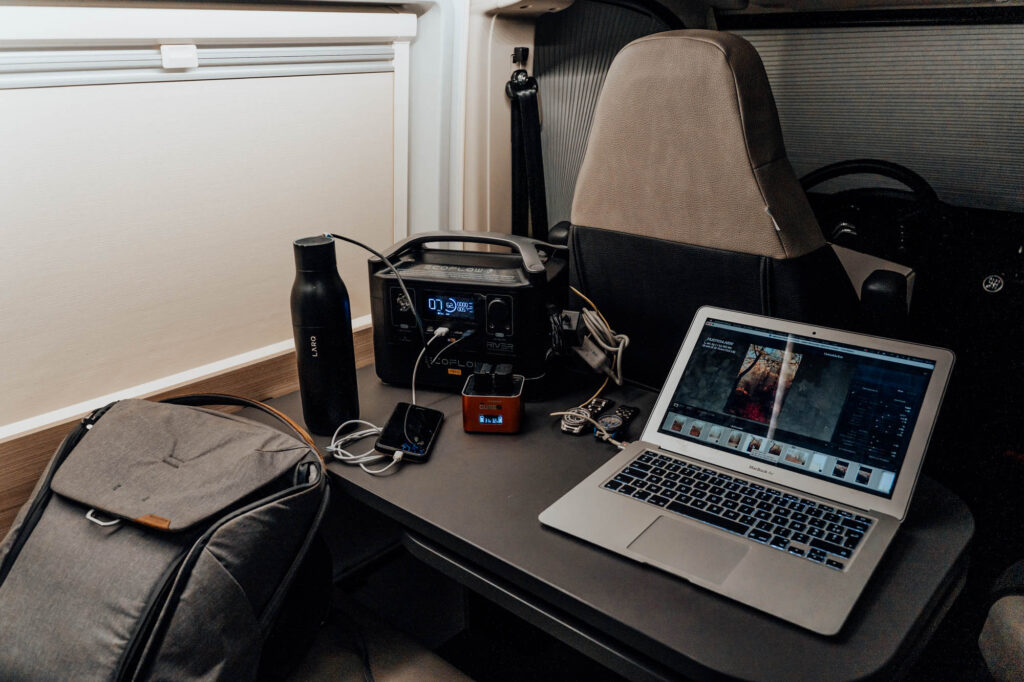
When you’re planning to cross various borders or wander around mountain passes, you’ll have to switch radio stations regularly, or you’ll end up with noise. Our trick? Make sure everyone has made their own Spotify playlist in advance! That way, you won’t be bothered by the noise and leave room for spontaneous singalong moments to occur.
Data Roaming
If you are located in Europe and are traveling through various countries, you’ll need to ensure that your data roaming is enabled on your phone to keep having an internet connection.
You shouldn’t worry about the amount of roaming you use, thanks to the European Union’s roaming regulations which say data providers can’t charge for roaming in the European Union. However, keep in mind: Switzerland is not included in this regulation! So don’t forget to turn off your Data Roaming when entering Switzerland.
What have we learned about road tripping through Europe with a campervan?
Our campervan trip through Europe confirmed something we already knew: that it’s very easy to travel between European countries. A 100 kilometers drive can bring you to a different cultural and diverse community.
Next to this, we had a few other learnings as well.
The ease of a camping site with decent facilities
While traveling in a sustainable campervan, you’ve got different options in terms of camping:
- You could visit an official campsite which has loads of facilities.
- You could park overnight at Highway stops.
- You could wild camp and stay at a new place every night.
Most European countries have different rules and regulations about camping, but generally, they (Switzerland, Italy,…) aren’t allowing wild camping … which makes it technically illegal. However, in most cases, overnight parking where you don’t set up camp or leave in less than 24 hours is allowed.
Our tip? Make sure you can drive off at any moment so that nobody can complain about it.
The thing is: If you’re on the road for over a week, you’ll need to clean your campervan and want a more luxury shower. Don’t hesitate to stop wild camping and pause at a camping site with decent facilities.
The ease of planning
Being prepared for your campervan trip ensures that you can switch gears faster and need to spend less time worrying. The things that helped us a lot were:
- Backup locations. Since we used our itinerary as a guideline, we had the flexibility to skip specific locations because of bad weather. Having backup locations made it less of a hassle to find hidden gems.
- Ecoflow River Pro . We knew we would probably wild-camp a lot, which meant not having the power to charge our electronic devices (laptop, camera,…). Luckily our friends at Dutchtravelshop.nl hooked us up with this mobile power station, which we didn’t have to recharge one single time during our 8-day trip.
The costs Tolls and Vignettes
Something we have underestimated is the fact that most European countries have toll roads, which can make your trip very expensive very fast. Luckily, there are exceptions, such as Germany, Netherlands, and Belgium.
Some countries such as Austria and Switzerland are working with a vignette, which is a prepaid motorway toll in the form of a sticker you typically purchase from petrol stations before you cross the border and which you stick on your windscreen.
Alternatively, you can always avoid tolls by picking alternative routes on Google Maps or Waze, but these will guide you through the smaller roads, resulting in a slower and longer route.
Our tip? If you have the time, save your money and go for the slower, more scenic route. If you’re in a hurry or have a tight schedule: go via the tollways.
Our road trip Itinerary
Since the lockdown started, we’ve been saving Instagram pictures of destinations that inspired us and deserved a place on our bucket list. We’ve added them all to a Google Maps collection and started planning the regions we wanted to visit.
From there on, we casually decided that we wanted to visit the Dolomites, Venice, and Milan. Because the beauty of a road trip in a campervan is that you can make up your itinerary along the way: when you’re experiencing bad weather, you can just start a few 100 km’s and adjust your itinerary as you go.
Additionally, once your start to post Instagram stories or timeline pictures of your trip, people will automatically start to recommend locations that weren’t on your bucket list to start with!
Remember that our style is to have a flexible road trip itinerary and adjust our planning accordingly. As a result, we’ll need an internet connection during our trip, which can’t always be found when traveling to rural destinations like the dolomites.
DAY 1 – Getting started
Our first day was mainly focused on picking up our campervan, unpacking the bags, and learning how to drive the campervan properly. Ultimately we already wanted to drive to our first location so that we could start our hike early!
Pickup Campervan in Brussels
We started our trip by picking up the campervan in Brussels in the afternoon, where we finally met the owners of the campervan face-to-face, received an extensive explanation of how the campervan functions, and finally managed the paperwork (for example; noting down the milage of the car, check for damages, etc).
After unpacking our bags and filling the drawers, we started driving towards our adventure! We left Brussels around 3 pm and drove straight to our first stop in Rheinland-Pfalz. Just when we crossed the steep hills of Malmedy, darkness fell over the highway, and fog started to appear.
Since the darkness prevented us from sightseeing opportunities, we quickly arrived at our first stopover and sleeping place – the “Wanderparkplatz” in Nothweiler on the German-French border . This parking is located in the middle of the woods, which explains why we came across some wild boars on our way to the parking spot.
Wegelnburg – Wanderparkplatz Nothweiler
After (wild) parking at Wanderparkplatz Nothweiler, we looked up at the sky and noticed how beautiful the stars were in the sky. We decided to unpack our Nanlite Pavotube II’s light tubes and used them to illuminate the (unlit) hiking trail, looking for the perfect spot to stargaze.
We decided to follow the winding hiking trail that crosses the German-French border until we found an open spot, which we used to capture the stars.
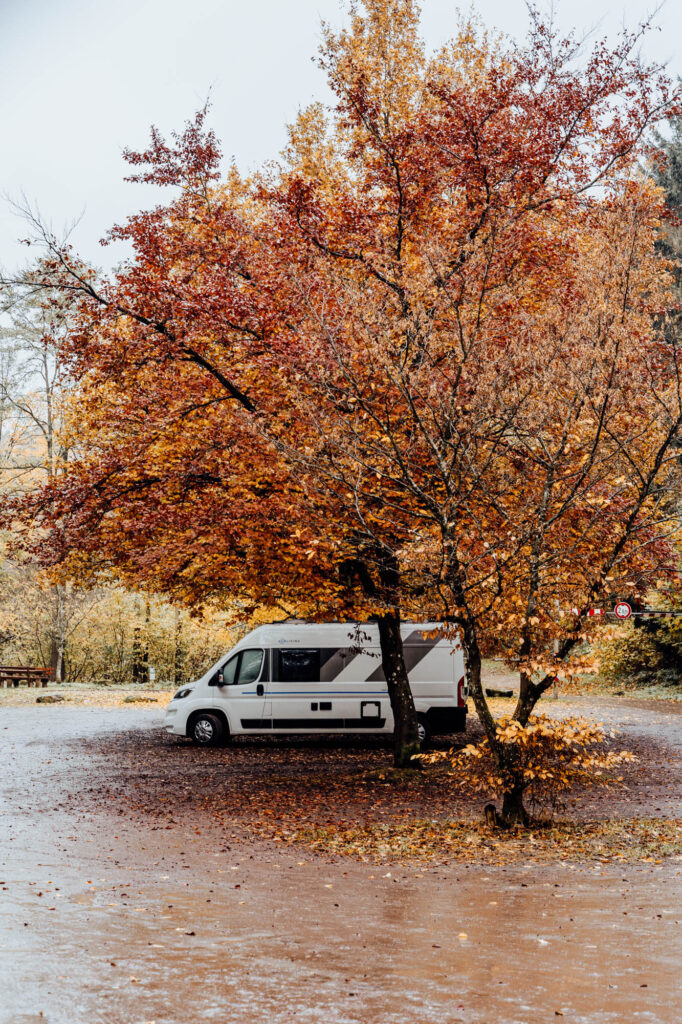
Day 2 – Chasing castles
We knew in advance that during our road trip to Venice, we had to pass through the German provinces of Rhineland-Palatinate and Baden-Württemberg. Both regions are known for their medieval castles, of which most have a panoramic view.
Our goal was to visit the most impressive castles on our route to Venice.
Wegelnburg, Germany
Wegelnburg , a ruined castle located in a forest on the French-German border, is best known for its panoramic view and incredible sunrise.
We wanted to witness that specific 7 am sunrise, so to observe this, we had to start our hike at 6 am, where we followed the zigzagging hiking trail to the Wegelnburg. This took us 5 kilometers, regularly crosses the German-France border, and passes by several other ruins on its way. The hike was covered in darkness since the sun was still about to set, making it an authentic experience. However: seeing the sunbeams roll over the mountains with such a fantastic panoramic view was just … unreal.
Be aware tho: the entrance of Wegelnburg is surrounded by fencing, so at first, we thought it was closed to visitors, but nothing could be further from the truth!
We found a shorter hiking trail on our way back, which brought us directly to the village, only 200 meters walk to the Wanderparkplatz Nothweiler.
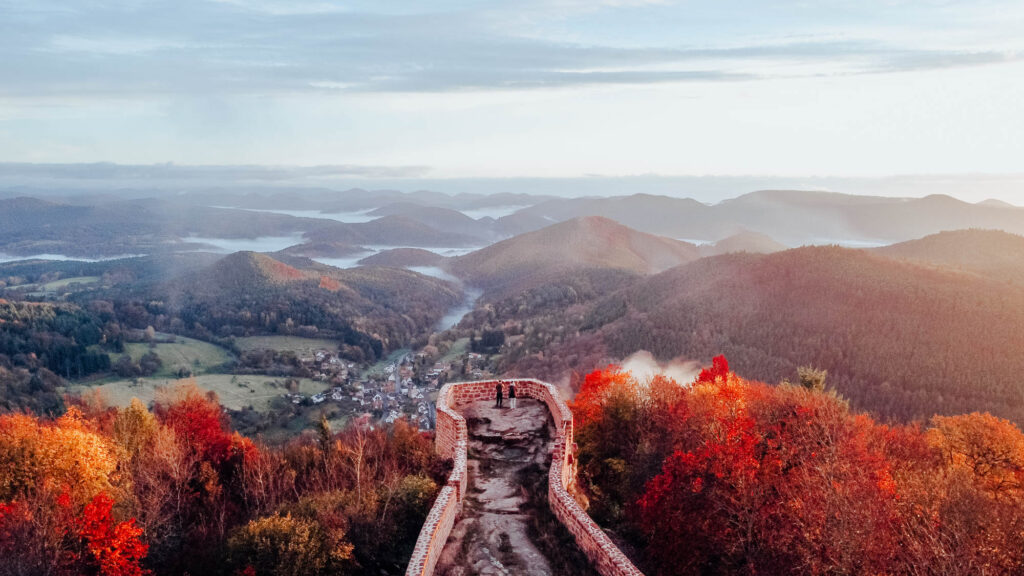
Schloss Lichtenstein, Germany
To make our route to Venice even more interesting, we aimed to visit interesting stopovers every 2 to 3 hours (+- 200 to 300 km). In this instance, we drove towards Schloss Lichtenstein : a 12th-century fortress built on top of an 800-meter high cliff.
We noticed that the castle was managed from a commercial point of view, where everything involved a cost: parking, entering the courtyard, etc.
Nevertheless, the panoramic view over the valley and the fantastic color palette of the surrounding trees, hills, and valley made it worthwhile. It also struck us how beautifully everything had been restored and how detailed they had for their sculptures.
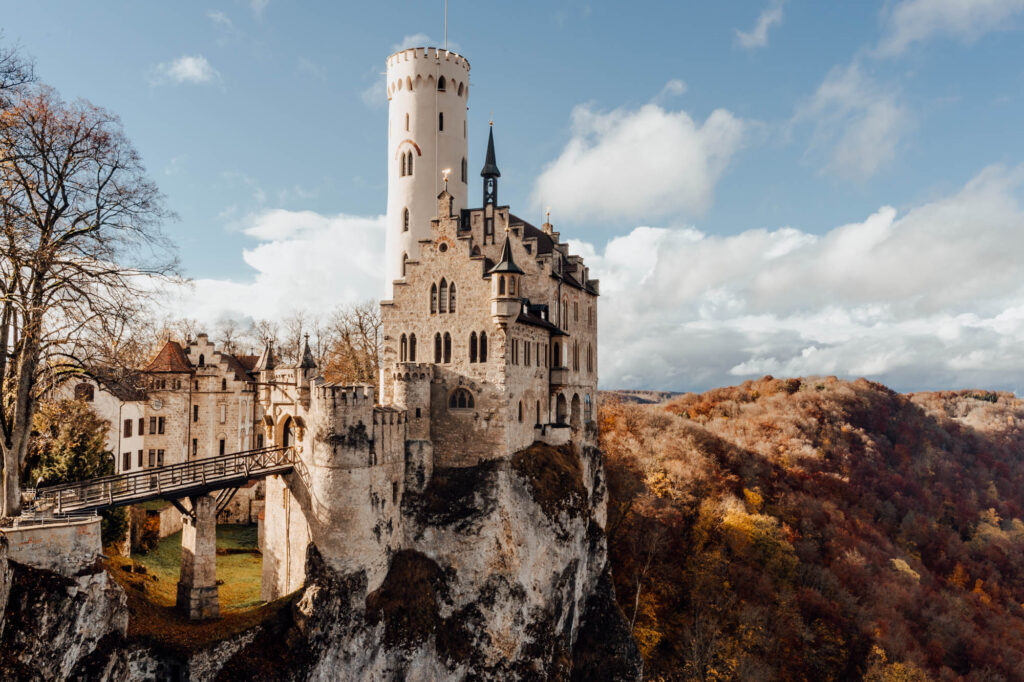
Hohenzollern Castle, Germany
Located less than 40 kilometers from Schloss Lichtenstein, you can find Germany’s most visited castle: Hohenzollern Castle! The castle has been known as “The Crown of all Castles” ever since 1267. Reason enough for us to visit it and admire it with our own eyes!
Our tight itinerary wouldn’t allow us to stop by the Hohenzollern Castle for an extended visit, so we decided to admire the castle from Zeller Horn’s legendary viewpoint ; It’s the mountain range located about 1.5 kilometers away, at the same height as the fortress. As a result, you have the best view of the castle and the surrounding area.
We have to be honest tho: it took us a while to find the exact location of the Zeller Horn viewpoint, but once we found it … we loved it! You can judge for yourself …

Plansee, Austria
While we had already discovered some of the most amazing places, we decided to push our luck: our goal was to visit Plansee lake, located just beyond the Austrian border, and search for its very instagrammable viewpoint that looks down over the lake.
Unfortunately, a combination of traffic jams and mandatory stops (buying our Highway Vignette to enter Austria) caused us to arrive just after sunset. We learned during our road trip through the mountains that as soon as the sun has set, it’ll be pitch dark in a matter of minutes. The same goes for our visit to the Plansee lake: as soon as we crossed the bridge, we couldn’t move without using our Nanlite lights.
After our short stop at the lake, we decided to continue our journey to a place to sleep for the night: the legendary Innsbruck city.
Innsbruck city
We’ve visited Innsbruck city numerous times, and we may even say that it’s our favorite city in Austria. This is because of its beautiful mountain background, architectural gems, alternative culture, and Innsbruck’s importance on the winter sports community.
Once we arrived, we decided to head downtown to reminisce memories from the past and see how the historic buildings (such as the Liberation Monument on Landhausplatz and the building with the golden roof) are lit up at night.
We decided to end our evening at the Hard Rock cafe to explore the same downtown area the next day after dawn before the shops opened.
Day 3 – Arriving in the Dolomites
During our previous road trip, we visited the Dolomites and missed out on a few of our bucket-list locations. Since the Dolomites were only a slight detour from our route to Venice, we decided to give some of these places a second chance … but not before we wandered around Innsbruck first!
Innsbruck, Austria
Imagine the feeling of waking up, opening the doors of your campervan, and looking out across the streets of Innsbruck with their impressive mountains as a backdrop. Well, that’s precisely how we woke up!
After a quick shower in our campervan, we decided to wander around the city again and rediscover the same historic buildings, but this time using daylight.
Another reason why we stayed in Innsbruck is that we’ve been following Holzkern Watches on Instagram for ages and noticed we could visit their shop in Innsbruck. We made an appointment, and were welcomed by their store manager Stefan who explained to us more about Holzkern’s philosophy and lifestyle, showed us how an automatic watch works and how to replace the chains of a wristband.
During our visit to the store, we fell for the charms of the La Concorde watch and the Intergalactic watch , which we took home as a reminder of our road trip.
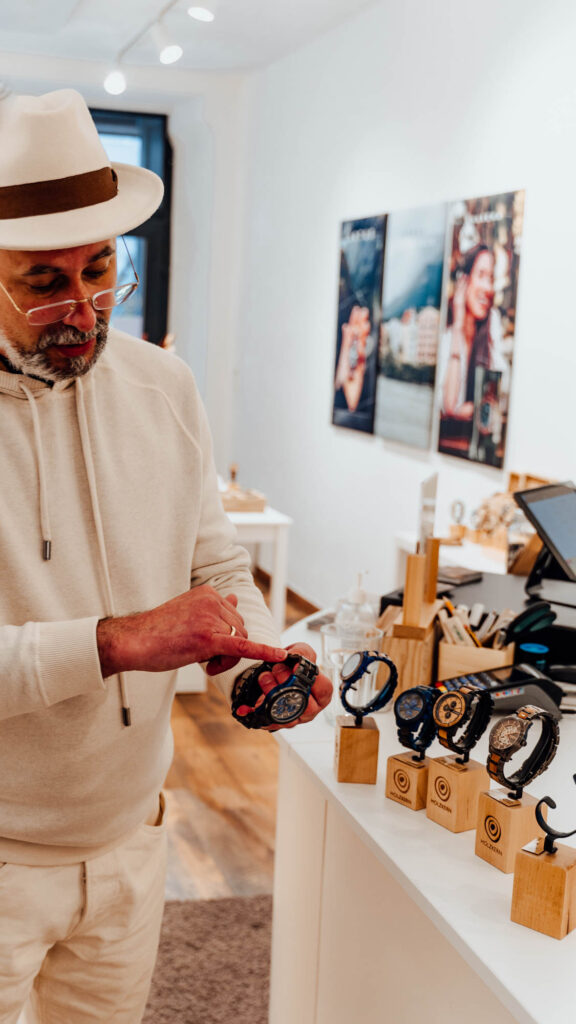
MMM Corones
Since we visited the Dolomites last year, the MMM Corones (being designed by Zaha Hadid) have been on the top of our bucket list. When we entered the region around the Dolomites, we noticed that the lakes weren’t frozen and the roads were not covered with snow … so our first reaction was to visit MMM Corones.
Unfortunately: the ski lifts were closed because the season hadn’t started yet, and the roads were now permanently closed and accompanied by prohibition signs. So one thing is sure: MMM Corones can only be visited in a dignified manner when the ski lifts are open.
With pain in our hearts, we had to make a cross over our visit from MMM Corones, but luckily there are plenty of other places to visit in the region … so we decided to drive to the legendary Lago di Braies .
Lago di Braies
Lago Di Braies – also known as Pragser Wildsee – is the biggest lake in the Dolomites and is known as the most beautiful lake of the Alps because it’s surrounded by beautiful pine forests, towering limestone peaks, and included a unique boathouse. As a result, most people know it as (“Lago di Instagram”).
The last time when we visited the lake, it was totally frozen and covered in snow. This setting certainly had its charm, but we also wanted to visit Lago di Braies before the snow fell. Unfortunately, there was so much fog that we still couldn’t admire the lake in its best condition. Next time!
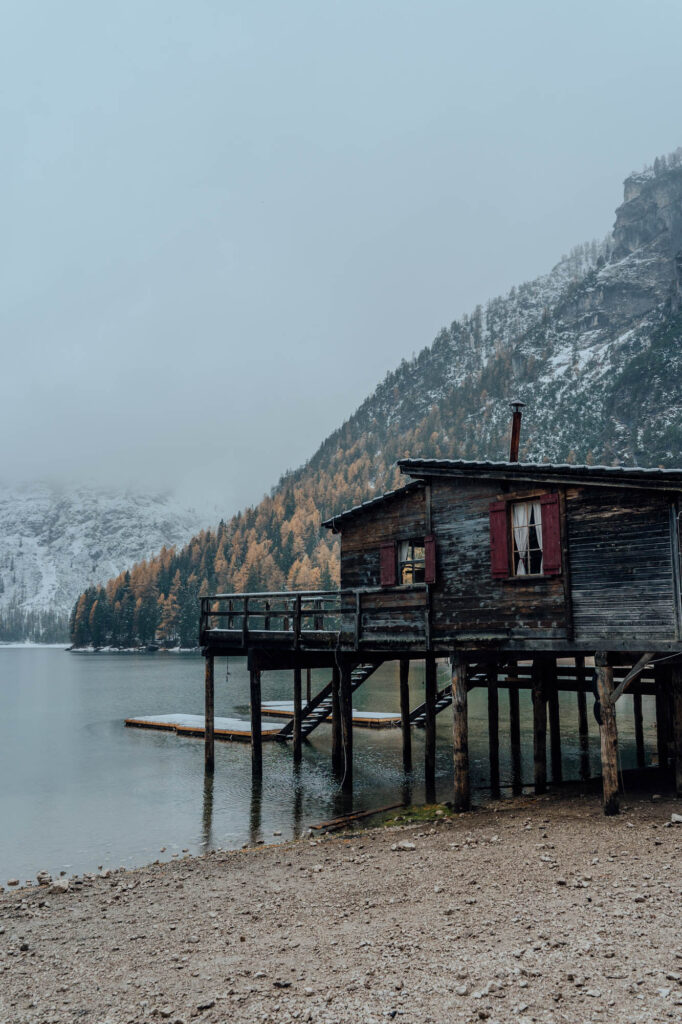
St. Johann church in Villnostal
Noticing that the sunset was approaching fast, we decided to revisit one of the most legendary sites in the Dolomites: St. Johann in Ranui Church in Val di Funes, Villnostal.
While driving over the winding roads, we noticed that the weather conditions would be utterly different from our previous visit: there wouldn’t be any snow, but the church and its surroundings were covered in fog.
Unfortunately, we didn’t notice too much of the sunset since the fog blocked all the sunbeams. By the time we left the church, it was already pitch dark.
Alpe di Siusi & Earth Pyramids Renon
We decided to drive up to Compatsch to experience the sunrise at Alpe di Siusi to save some time. Last time, we missed this view since it’s located in a nature resort and has a curfew for cars: no-one can drive by between 9 am and 5 pm.
This time, we could access the road to Compatsch, but while we were driving up the mountain, it started to snow, almost to the level of a snowstorm. When we arrived in Compatsch, our van got stuck, and a local farmer had to pull us out of the snow.
According to the local weather forecast, it would snow for the entire night, and we would miss the sunrise anyway since it would be covered in fog. In fear of getting stuck, we decided to go back down the mountain and skip our visits to both Alpe di Siusi and the Earth Pyramids of Renon.
We ended up spending the night at a truck stop next to the road.
Day 4 – The road to Venice
We knew it wouldn’t be the shortest route to Venice, but we decided to drive via Santuario Madonna Della Corona and Lake Garda since it captured our imagination.
Santuario Madonna Della Corona
What’s more astonishing than an ancient place of worship, located 800 meters into the side of a cliff? We wanted to experience it, so we drove towards Santuario Madonna Della Corona, only a 15 minutes drive from Lake Garda (the Italian part)!
We parked at Localita Santuario 1 in Spiazzi, on a parking lot that usually wouldn’t allow campervans and mobile homes, but we decided to risk it since it was empty. The reason for this might be the thick fog that stood over the mountain, on the fact that it’s not the most touristic period to visit Santuario Madonna Della Corona.
Although we could not fully admire the Santuario Madonna Della Corona due to the thick fog, the location continued to impress us. We also had the opportunity to check our fitness by climbing the steep stairs to access the sanctuary.
After arriving, we learned that this sanctuary is a place of pilgrimage that already existed before the year 1000! We’ve listed our findings in this specific destination article about Santuario Madonna Della Corona .
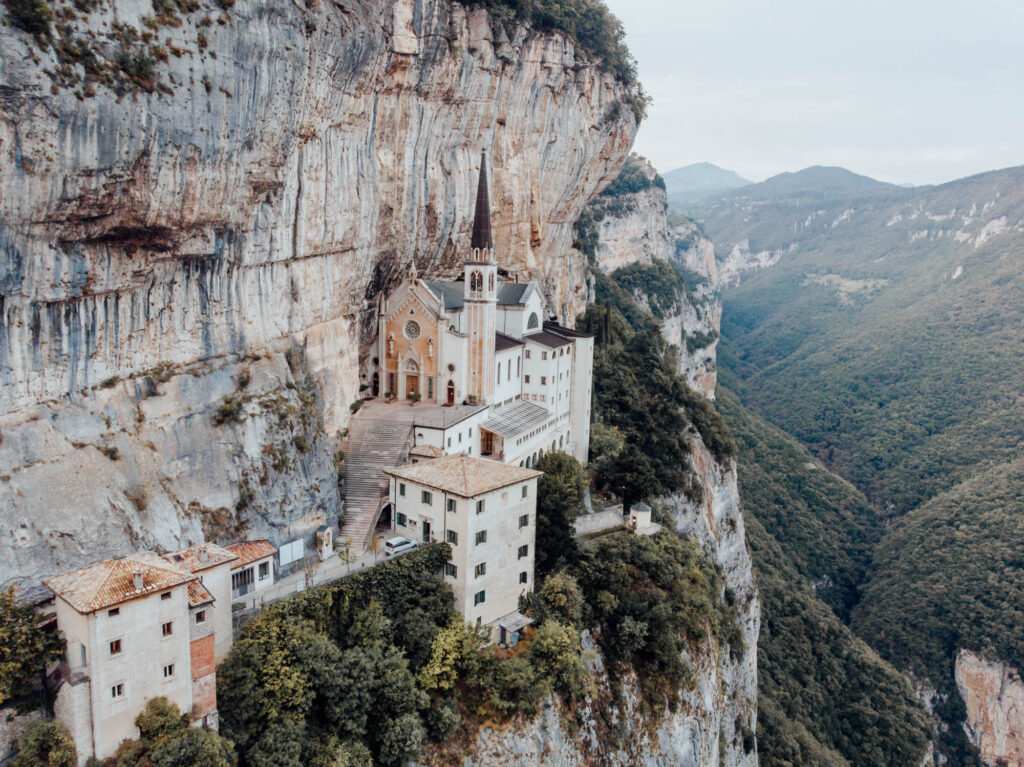
Lagi di Garda
In less than 24 hours, we went from a small snowstorm in the Dolomites to a 20-degree summer breeze at Lake Garda.
The small town was quite dead, considering the tourist season was already over here, so we just briefly wandered through the city. Our goal was to catch the sunset in Venice before 5 pm anyway, so we quickly left the lake.
Venice City
Where we spent the past few days in quiet or remote regions, with endless possibilities to park and wild camping … Venice would be a bit more crowded and strict. That’s why we decided to spend the night at the campsite of Venezia village, which had some fantastic facilities: decent showers, an elegant restaurant, and a clean swimming pool.
An additional advantage was that there is a bus stop in front of the campsite, with busses that go directly to Venice. The ride to the city takes no longer than fifteen minutes and drops you off at Piazzale Roma.
By 4 pm we arrived at the tourist center, where we were overwhelmed by history and architecture! Strolling with our camera in hand, we followed the small corridors of the city, arriving at a (relatively empty) San Marco square just after sunset.
Unfortunately, The darkness brought in some shady types, from aggressive salespeople who punched us on the shoulder to get our attention to pickpockets popping up from sketchy streets and following us until we noticed them. As a result, we decided to skip the rest of the city and return the following day.
Pro-tip; Gelateria il Doge’s ice creams are known as the best in the old town.
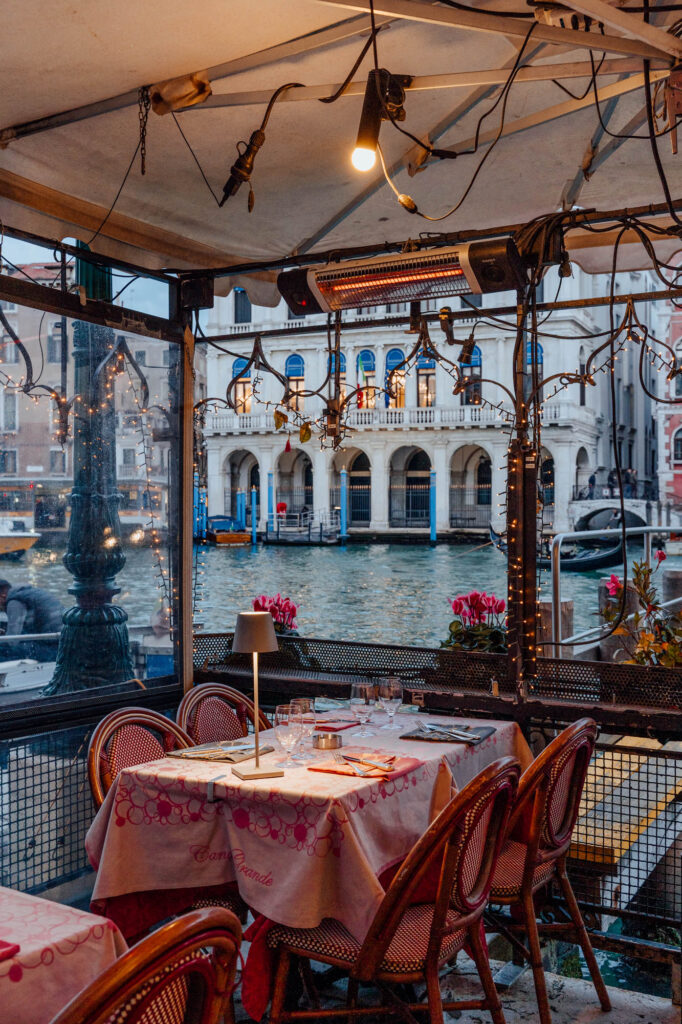
Day 5 – From Venice to Milan
By now, our road trip was already halfway through, so after enjoying Venice’s charms in the morning, we had to start on our way back. This time we chose to spend the night in the city of Milan since we wanted to discover some of their ancient buildings as well.
Be aware: Something we didn’t realize before going on this trip is how many toll stops you can find in Italy, especially between Venice and Milan.
Venice, the city of canals
Since we ended our wanderings around Venice early the night before, we decided to sleep in first… and then head back into the city!
This time we parked our campervan in Venezia Tronchetto Parking because we were only planning to stay in the city for a few hours. Ultimately, we stayed for 4 hours and realized that we had paid more for this parking spot (without any facilities except) than staying an extra night in the camping Venezia Village. Yikes!
Unlike the previous evening, where we walked to San Marco square via Basilica S.Maria Gloriosa dei Frari, we now had the time to take a different route: via Basilica di Santa Maria della Salute.
Milan and its impressive Duomo di Milano
Since we took our time to wander around Venice, we arrived in Milan during rush hour and had to endure several traffic jams before arriving in “Camping Village city of Milan.”
The campsite’s reception was already closed, but luckily google maps had a function that allowed us to know perfectly see what public transport connections would lead us to the Duomo di Milano. Our trip was a bit more delicate since we needed to transfer from the bus to the metro, in a place we had never visited before. Luckily we had google maps to fall back on.
Since this route to the center of Milan took almost an hour commute, we only found the time to discover the illuminated cathedral and the neighboring streets. To make it easy for us, we also made a quick McDonalds stop here.
Day 6 – From Milan to Strasbourg
We had less than two days to cover 1000 kilometers and go from Milan to Brussels. This gave us enough time to visit the center of Milan and then leave for Strasbourg in the afternoon.
Milan, Italy
Since Milan is such a beautiful city accompanied by ancient architecture, a sense of fashion, and art … we made a small “bucket list” of locations that we had to see during our visit to the city center.
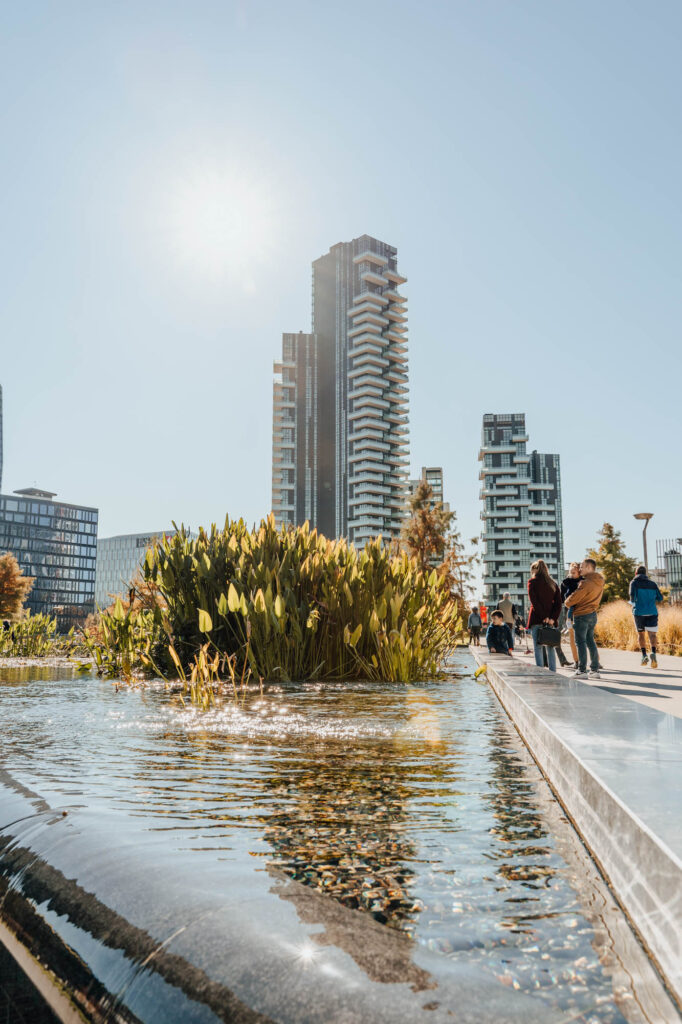
Castello Sforzesco
Castello Sforzesco – also known as Sforza Castle – is a fortress that was built during the 14th century.
Over the centuries, the fortification was destroyed in various wars, by the troops of Napoleon and during World War II. It was extensively rebuilt in 2005 and currently houses several of the city’s museums and art collections. That’s why it’s currently one of the most famous landmarks in Milan.
Arco della Pace
Arco della Pace is a huge triumphal arc located where the ancient Romans built their city gate. The gate is called “The Porta Sempione” and refers to the district it was located in.
While the origin of the arc can be found in 1807 when Napoleon was in command of the city, the construction of the “Arch of Peace” was paused when the city of Milan fell under the control of the Austrian Empire. The construction of the Arch was resumed in 1826 and was finally completed in 1838.
Bosco Verticale
The Bosco Verticale – or Vertical Forest – are two residential towers built in 2014 and are already known as the most iconic and most recognizable buildings of the last decade in Milan.
Pictures of the building often surface on Instagram and Pinterest, as it is iconic for its pioneering incorporation of a vertical forest.
Duomo di Milano
The Milan Cathedral, known as Duomo di Milano, is without any doubt the most known building in Milan.
It is logical too since they started the constructions in 1386 and only finished working on it more than six centuries later: in 1965! What’s even more impressive is the fact that the cathedral contains over 3400 different statues.
Strasbourg, France
As mentioned: Milan is still a 1000km drive from Brussels, so we had to keep going if we wanted to back on time! We decided to pass via Switzerland, which meant buying a new vignette when crossing the border and disabling our roaming data.
Once we arrived at Strasbourg, we parked at Parkplatz Friedhof since it was close to the city center, and parking on a Sunday would be free of any charge.
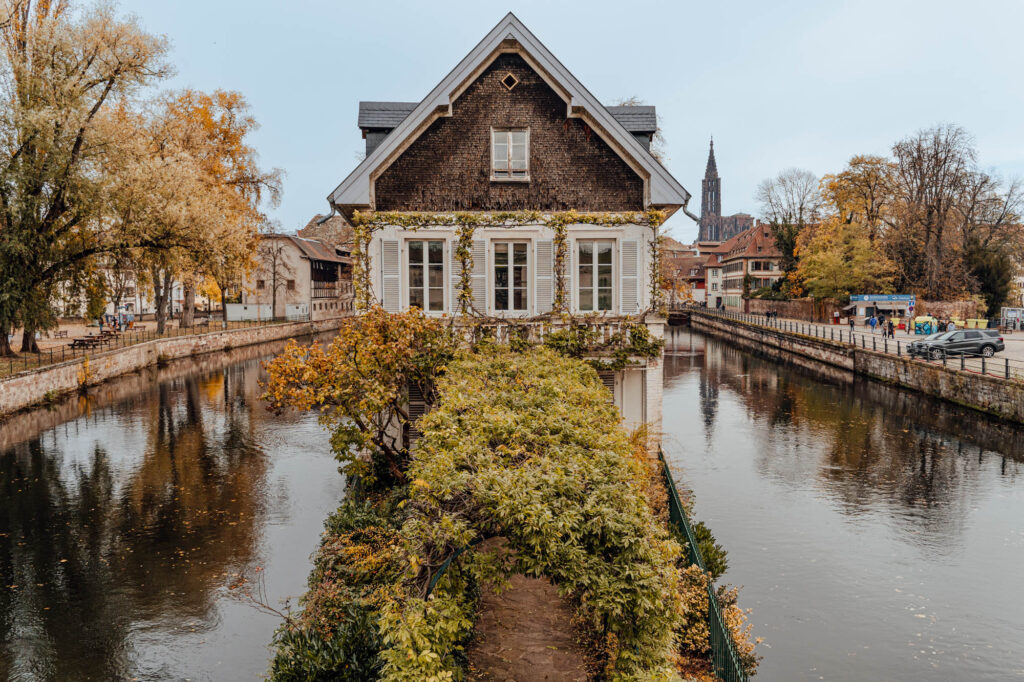
Day 7 – Back to Belgium
Every fairy tale comes to an end, and unfortunately, ours too. It was the last day where we were actually on the road; we wanted to enjoy it until the end. That is why we chose to discover Strasbourg in the morning and pass quickly via Veves Castle in the afternoon.
Being a university city on the border of France and Germany, Strassbourg is a very characteristic and cultural city, with enormous history. Proof of this is the street art that can be found all around the city or the ancient buildings scattered around the city (such as their cathedral).
We had some help from some locals; we were advised to discover the part of the city known as “Le Petit Paris.”
Vives Castle
What’s a better way to end our trip than to visit a 12th-century castle? We arrived rather last-minute: 10 minutes before the castle closed, so we didn’t have the chance get to explore it from the inside … but the sunset made up for it!
If you don’t know about Veves Castle yet, make sure to read the extensive guide we wrote, it contains the history of the castle, the legends around the castle and how to reach it.
A fascinating part about the castle is that the same family has owned it for the last 800 years, and that is classified as an exceptional heritage by the region of Wallonia. As a result, the castle is referred to as Sleeping Beauty’s castle.
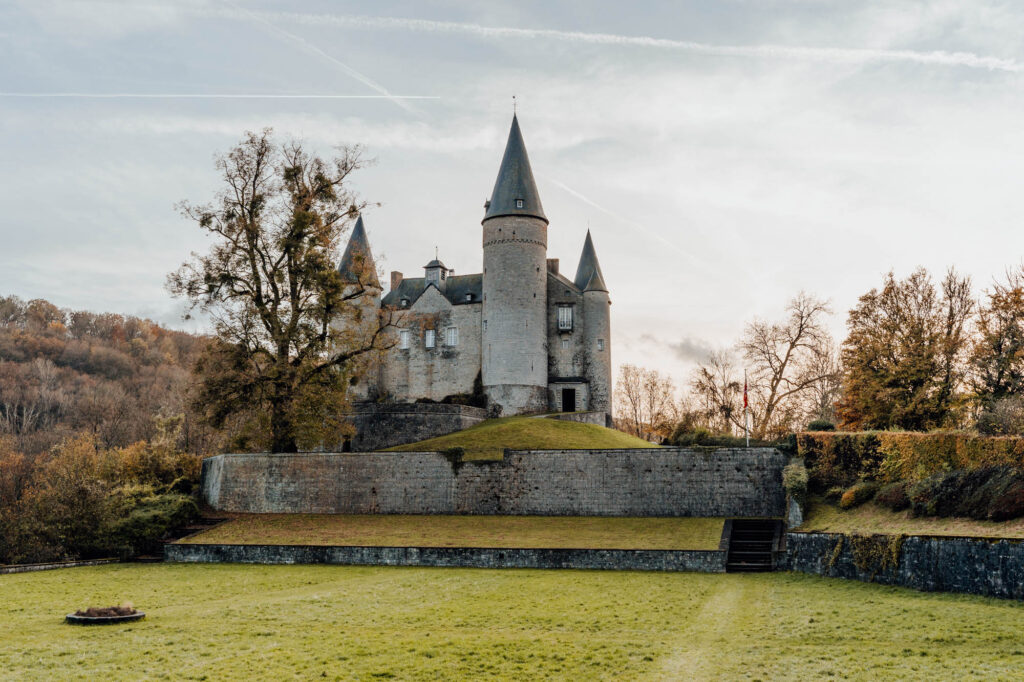
Day 8 – returning the campervan
Our last day was mainly focused on bringing back the campervan, where we had to pack our bags, clean the campervan in a self carwash, and ultimately fill in the paperwork again ( check for damages, note the number of kilometers we’ve driven,…).
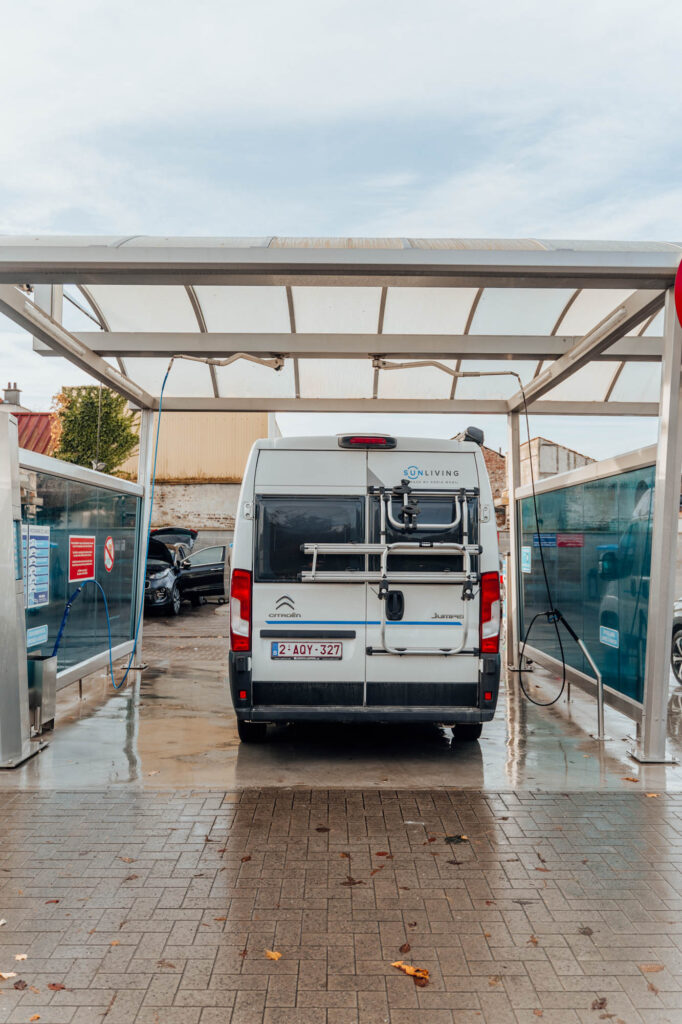
Save to Pinterest
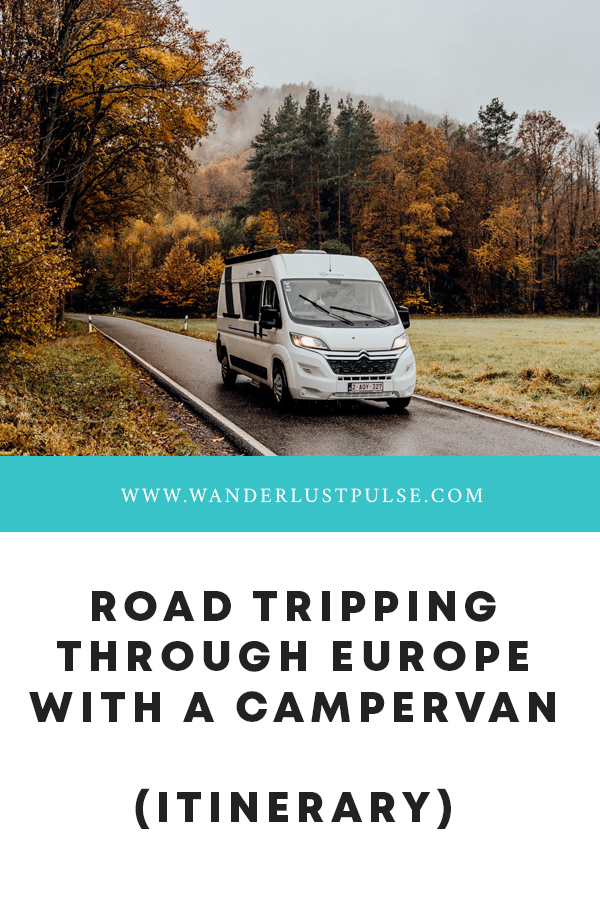
Share this:
Hey there! I'm Elliot Clennam, a passionate photographer based in Brussels, Belgium. My love for capturing the essence of my surroundings has led me on countless adventures, from exciting road trips to bustling city escapes.
Similar Posts
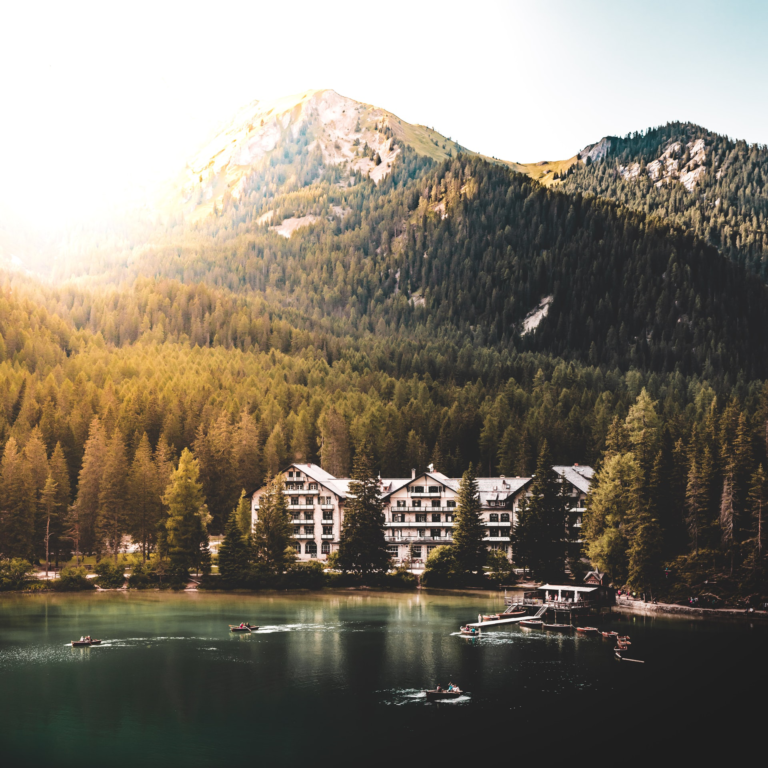
Lago Di Braies: a mysterious lake in the Dolomites
Lago Di Braies is a legendary lake located in the Dolomites, which still contains many mysteries. We visited the…
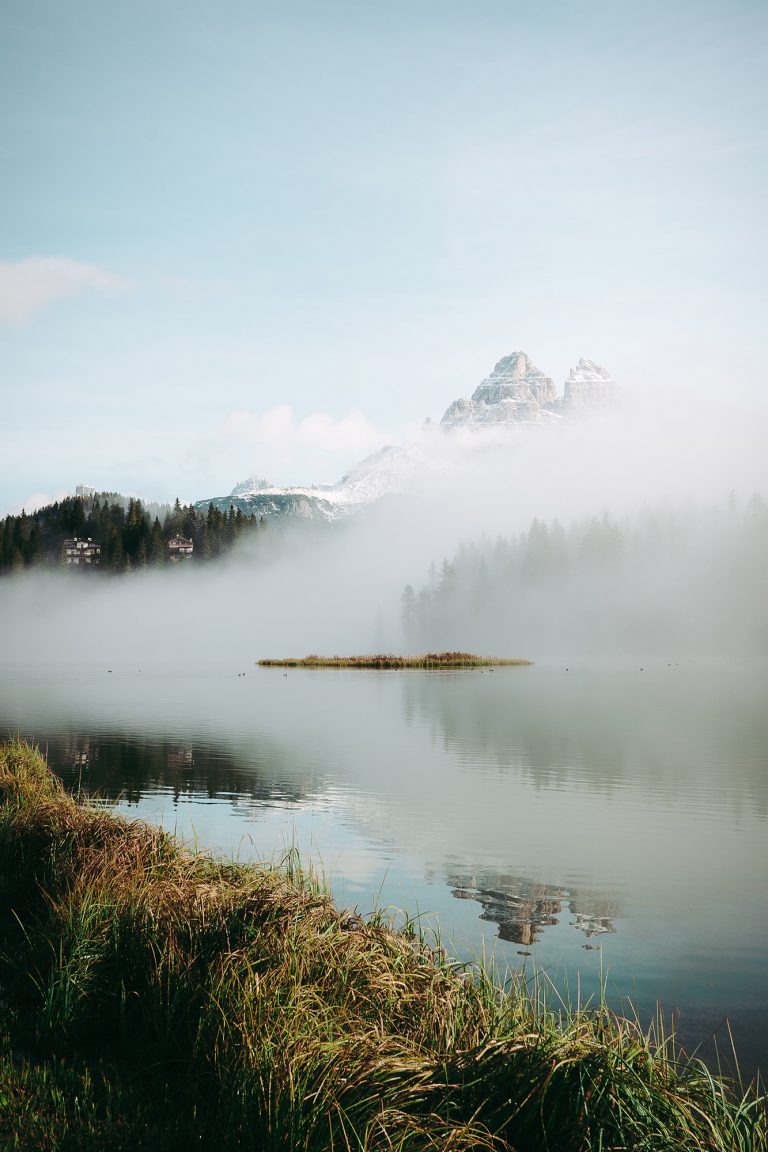
Lake Misurina, possessing the purest air in the world
Lake Misurina – known for its special microclimate – is an amazing place to hike around. Here is everything…

The ultimate guide to traveling to the Faroe Islands
Never heard of the Faroe Islands before? You’re not alone; most Europeans don’t even realize it exists! While a…
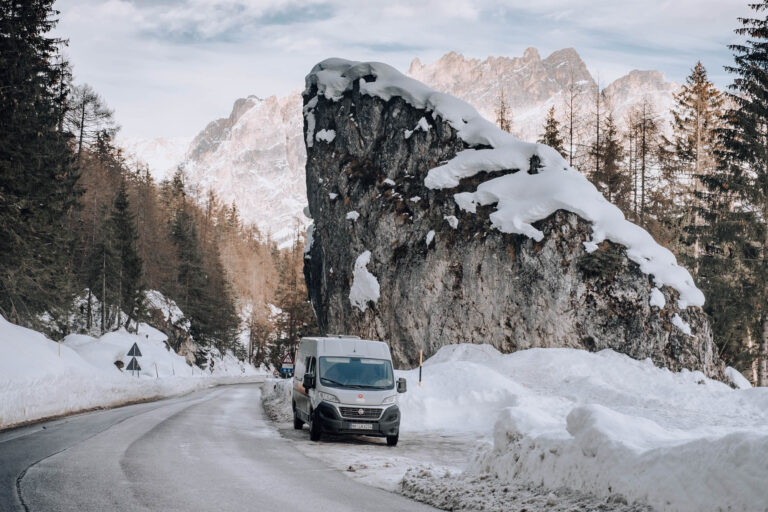
Visiting the Dolomites with a Campervan in 2024 (Itinerary)
The Italian Dolomites are known to every landscape photographer as one of the most spectacular places on earth, covered…
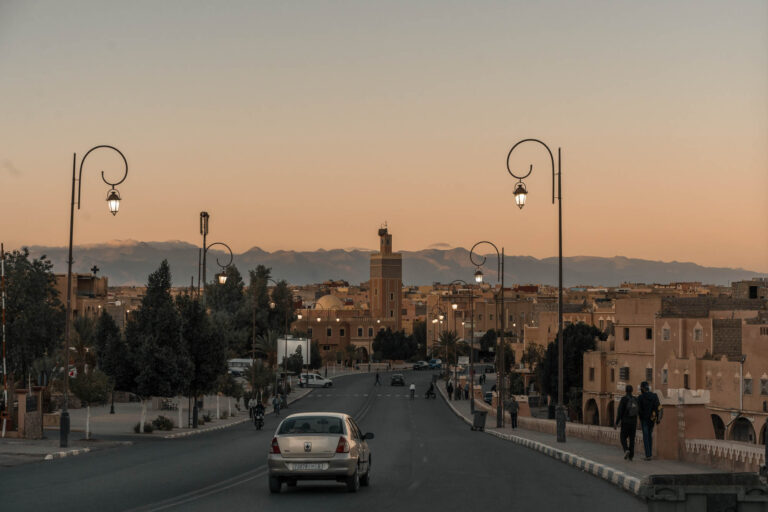
Escape the Cold: A November Road Trip Through Morocco
Ever wonder what it’s like to trade the chilly European November winds for something a bit warmer and way…
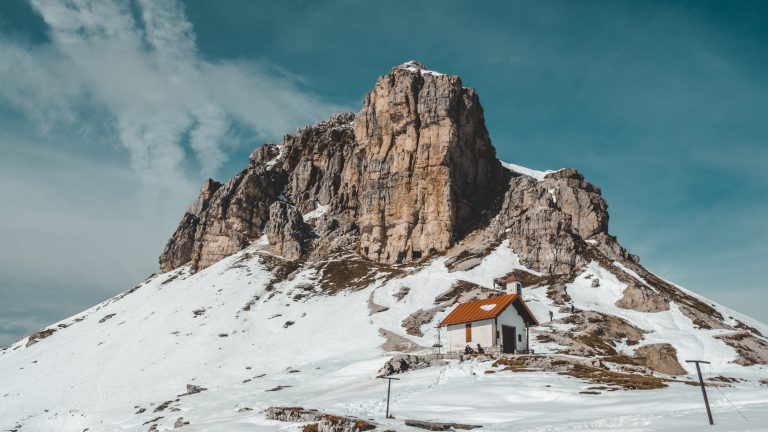
Top 5 best hikes in the Dolomites, Italy
Le Corbusier, a famous French architect, once said “The Dolomites are the most beautiful natural architecture of the world”…

The Definitive Guide to Europe by Campervan

Imagine the feeling waking up each day, grabbing your morning coffee and looking out across the lake/mountain/beach you parked next to the night before.
You take a look at the map, plot a course and make your way to the next destination. In your own time, on your own schedule, in your own home on wheels. This is life when traveling Europe by campervan.
It is a steep learning curve once you decide to campervan in Europe for the first time, particularly if you are not from Europe.

We are here to fast track you past the initial planning stages and help you plan your trip by campervan around Europe. In this Guide to Europe by Campervan we have listed all of our best campervan travel tips.
There is A LOT of information here so don’t forget to save or share the article to refer to later.
- 1 How To Plan Your Europe By Campervan Itinerary
- 2 To Buy Or Rent a Campervan In Europe?
- 3 The Best Campervan Layouts
- 4 Get To Know Your Campervan
- 5 LPG Gas Bottles
- 6 Best Campervan Gadgets
- 7 Essentials Apps for Campervan Life
- 8 Connectivity Tips
- 9 Navigation Tips for Campervanning in Europe
- 10 Toll Roads
- 11 Using Ferries in Europe
- 12 Campervan Camping In Europe Guide
- 13 Campervan Security
- 14 Campervan Meals
- 15 Tracking your Europe Road Trip Costs
- 16 Important Documents to Carry
- 17 Ready To Plan Your Trip?
- 18 Final Travel Europe By Campervan Advice
How To Plan Your Europe By Campervan Itinerary
We explored Europe by campervan for 5 months on a family gap year and it was an incredible experience. The region is well set up for touring by campervan.
The ease of travel between countries and the cultural and natural diversity of Europe make it the perfect road trip destination.
The natural thing to do first when planning to campervan around Europe is plan the itinerary.
There are millions of different campervan routes in Europe and it can be hard to whittle it down to a manageable list.
We suggest you start with this list of questions to help you narrow your planning efforts:
- How much time do I have
- Where will we start and end the road trip
- How much driving am I prepared to do each week
- What time of year will I be in Europe (the weather is an important consideration)
- Do I want to travel slow or do I want to tick off as many places as I can.
Next we suggest you pull out your Europe bucket list, a spreadsheet, a map of Europe, Google Maps and your Weather App and start planning.
Expert Tip: When looking at distances on Google maps, add half the time again to get a realistic idea of the time it will take to drive in a campervan. Travel by campervan is slower than by car and you will most likely stop a number of times on the way. In our experience a 3 hour trip on Google Maps typically becomes a 4-5 hour driving day.
We love using Lonely Planet Guide Books when we first start planning a new trip.
They give a good overview of a country or region, the key sights, and best time to go. They are a helpful way to come up with your Europe bucket list in order to start planning.
Click here for the latest prices for Lonely Planet Europe .

As you start to form your high level itinerary, my best piece of advice is don’t lock it all in!
The beauty of travelling Europe in a campervan is that you can also make it up as you go along. Prioritise the countries and sights you want to see and adjust your Europe itinerary as you go.
Europe Itinerary Planner
If you would like more guidance to plan your Europe itinerary, we recommend this Europe Motorhoming Travel Toolkit by motorhome experts, Wandering Bird.
The toolkit includes a Europe travel ebook, printables, video tutorials and guides to route planning, camping, motorhome security and much, much more.
It is an invaluable resource full of tips and ideas and so helpful for first time motorhome Europe travellers.
>> Click here to check the price and find out more
To Buy Or Rent a Campervan In Europe?
Buy or rent? This is one of the most difficult decisions and unfortunately there is no right answer to this question. It really depends on your situation.
So to help you choose here we guide you through a couple of key questions to help you make this important decision.
In short, renting is the simplest and easiest option and the best choice for short trips (less than 8 weeks).
There are many European motorhome rental agencies, but we recommend Motorhome Republic . They have a huge network of vans across Europe and offer discounts for longer bookings.
Click here for a no obligation quote from Motorhome Republic.
Renting an RV in Europe makes sense for short trips, but will cost more if you are travelling around Europe for a longer period.
Considerations for renting or buying a motorhome in Europe
Here are some things to consider when weighing up whether to buy or rent an RV in Europe.
Length of trip in the campervan
The longer your trip the more sensible it is buy. On our calculations it was worth buying a camper van if the trip was longer than 2.5 months.
Less time than that and it was probably easier to hire a campervan in Europe.
The time of year
Off season rentals are typically much cheaper as loads of campervans are returned at the end of summer.
If you are brave enough to start your trip in winter and are prepared to negotiate, you should be able to get a much better price on a Europe RV rental for the off season.
Van repairs
Are you prepared to take responsibility for fixing the van, should things go wrong? When renting a campervan in Europe, if anything goes wrong, the rental company will resolve the issue.
If you buy the van you are going to have to work it out yourself.
We met a couple in Montenegro who had been holed up in the campsite for a month waiting for a part for their van to be shipped from the UK.
Thankfully we had no major issues with our van over the 5 months.
But it is a big consideration. For this reason, before purchasing a van we strongly recommend you have it checked out by a mechanically minded person.
Your country of origin makes a difference
As a non-European it is a little more complicated to purchase and insure a van in Europe.
It makes a private sale with an individual buyer very complicated unless you have friends or relatives in Europe who are prepared to purchase insurance on your behalf.
But the good news is that it is possible to purchase a campervan as a non-resident through a number of smaller European campervan companies.
If you are interested in buying a European camper van, contact us and we can put you in contact with our preferred company, a small family run business.
Expert Tip: If you need to transfer funds when purchasing a van in Europe we use and recommend Wise. Much better rates than most banks and quick and easy to set up. We saved hundreds of dollars transferring funds for our van purchase using Wise. Click here to find out more.
Look at campervan buy back schemes
If you don’t want the hassle of selling the campervan privately at the end of your trip, there are companies who will offer a guaranteed buy back. This will cost you more than purchasing and selling privately, but it is cheaper than renting.
You are assured of selling the van and it simplifies the process at the end of your trip. It is a good compromise between renting and buying privately. We opted for this option and we very happy with our decision.
If you would like to get a quote for buying a camper van in Europe through a buy back scheme, contact us and we can put you in contact with our preferred supplier.
So in summary, buying a van requires a large financial outlay but will most likely save you more over the long term.
But if you don’t want the hassle, motorhome hire for European travel is easy and worry free.
Get a campervan rental quote today and start planning your road trip!

The Best Campervan Layouts
Before you choose to purchase or rent a van, you should spend some time thinking about the best campervan layout to suit your needs.
There are literally thousands of different van configurations. It is hard to know what will work if you haven’t been RVing in Europe before.
Questions to help you find the best van layout
To simplify your van search, use these questions to prioritise what is important before you start looking.
How new do you want the van to be? What modern features does it need to have?
Are you prepared to accept an older van with older furnishings, no air conditioning, fewer mod cons. Older vans are generally much cheaper to buy or rent.
Or are these things important to you? For example, if you are considering Europe campervan routes in the south through Summer, air conditioning will make your trip much more comfortable.
Van size is a big consideration and will depend on how many people are traveling, but also the style of trip you want to take.
Do you want to go offroad on your camper van Europe trip? Do you want to free camp in out of the way places? Do you want to be able to drive the van into major cities? A smaller van is better for these types of European road trips.
Do you have kids? Do you want them to have a separate sleeping area and/or their own beds?
What size van are you comfortable driving? There are pros and cons to both. A small van is easier to drive and park and is easier to take to out of the way places.
But a larger van usually has a toilet and kitchen onboard, provides more comfort inside when traveling to colder countries and allows you to take more stuff.
It is worth noting that European camper vans on average tend to be smaller than what you find in Northern America, but are perfectly suited to RV through Europe.
Right or Left Hand Drive
Do you want a right or left hand drive? If you are going to spend most of your time on the continent, it makes more sense to buy a left hand drive vehicle.
Many vans for sale in the UK are right hand drive, so always check when enquiring if it is a left hand or right hand drive.
Bed Configuration
Are you prepared to convert a table into a bed each night or do you want permanently set up beds when you RV Europe?
If you are on a long term road trip, converting a bed each day can become pretty tiresome, but it means you can take a smaller van.
We took this compromise on our US month long road trip , but didn’t want to for a longer Europe tour.
If you have kids and they are still in car seats or booster seats this needs to be factored in to your decision.
Expert Tips: If you are traveling with kids, we talk more about bed configuration when traveling Europe by campervan with kids here .
Do you want to carry bikes or other large sporting equipment like kayaks or paddle boards that will need to be stored in or on the van?
Kitchen Appliances
Can you cook everything in your campervan kitchen on a gas cook top? Can you live without an oven and grill in the van?

Camper Van Amenities
Do you want to be able to free camp for days at a time off the grid with sufficient power and amenities to do so?
A van with a fridge that runs on gas, lights that run on a dual battery and a toilet onboard will help you achieve this.
Heating and Cooling
Will you be traveling through hot climates on your campervan Europe trip?
If you don’t have air conditioning you will need a van with plenty of opening windows (preferably with insect screens).
Will you be travelling Europe in the winter? If so you will need a campervan heater.
Related: The best campervan accessories for van life
Get To Know Your Campervan
Once you have chosen your van, it is really important to familiarise yourself with the vehicle before you set off campervanning around Europe.
We cannot stress the importance of this enough: get to know your new home before you go too far from where you rent or buy it.
Travelling Van Pre-Travel Checklist
- Check the campervan is mechanically okay. Ask when was it last serviced. Check the tyres.
- Do all the windows and blinds open and close correctly?
- Do all doors open, close and lock properly?
- If there is an alarm, does it work and how does it function?
- Confirm the appliances (fridge, heater, 12V outlets, AC outlets, air con if you are so lucky) are working and you know how to use them.
- Have the company/seller show you how to fill the LPG tank. Have they provided the necessary attachments for the countries you are visiting?
- Check you know how to open and close the campervan awnings.
- Check if the awning comes with tie down ropes. If it doesn’t we recommend you buy them to secure the awning. Click here to see the tie downs we recommend .
Know the van dimensions
It is also really important to know the height, length and width of your van!
Unlike rving in the US , there were MANY occasions heading down a country road or under a small bridge we would notice a road sign indicating the maximum width or height.
We would have to stop and find another way around because we wouldn’t fit in our large motorhome. It is VERY important to know this!

Campervan Parking
Navigating into campsites and getting out of carparks is often tricky and we saw a few other drivers hitting light posts and fence posts in their attempts to reverse their RVs!
Our van didn’t have parking sensors or a reversing camera and it was impossible to see what was behind you.
We suggest that if you are traveling with other people, one of you always get out and direct the driver into or out of the spot as you campervan through Europe.
Agree on a method for helping the driver with reverse parking. We found that hand signals worked better than voice commands.
Supermarket carparks are a good place to find large spots to park when in visiting towns in Europe.
They had more space and we could take up a few spots. Much less stressful than trying to park on a busy street!
Managing Waste Water
Larger campervans come equipped with grey water tanks. This collects all the used water – from the kitchen and bathroom sinks.
The older the van, the more likely it is this tank is going to have a unique and not so great odour.
If you rent or buy an older van our recommendation is to empty the grey water tank before setting off on long driving days.
When we didn’t empty the grey water tank we would be driving along with our sleeves held over our noses! The smell of grey water wafting through the van is terrible and was much worse in hotter weather.
We tried everything to improve the situation. From special tank cleaner to dishwashing liquid to putting ice cubes into the tank. Nothing got rid of the smell. The best solution was to have an empty grey water tank whilst driving.
If your van has a toilet we suggest you use toilet chemicals. Carry spare bottles of toilet chemicals as they were not always easy to find in smaller towns.
Thetford Aqua-Kem is a popular holding tank chemical and the one we used on our trip around Europe. Click here to check the latest prices .
LPG Gas Bottles
If your campervan has a refillable LPG bottle, monitor the gas level and don’t let it get too low. In some countries such as Portugal and Austria it was difficult to find LPG so we tried to keep it above half full.
Having said that, we used the gas for cooking, heating and cooling the fridge when off the grid and it really didn’t use much gas at all. We probably could have only filled it once or twice in 5 months.
Note also that there are four of different types of LPG gas bottle fittings used across Europe. Our campervan came with all of them and we could screw on the one we needed when we refilled.
The website mylpg.eu/adapters explains which fitting type is used in each country and also has a listing of LPG filling stations.
Also, if you were like us and had no idea how to use an LPG pump, have a look on YouTube for some guidance!
Best Campervan Gadgets
There is additional equipment and motorhome accessories you will use all the time and we recommend you purchase for travelling in Europe by campervan.
1. 12V USB Port Adaptor
You will need to buy a 12V USB port adaptor to charge your phones and tablets. Make sure you get a good quality one with a high current output to enable fast charging of your phone.
It will need to be dual USB like this one so you can power the GPS at the same time as charging a phone.
2. Voltage Inverter
If you have electronic devices such as a laptop or camera battery charger that are powered by AC voltage then see if you can find a 12V charger for them.
Alternatively, we recommend buying a voltage inverter which allows you to run an AC device from a 12V port.
When choosing an inverter you need to check that the inverter output is the correct AC voltage and is rated at a significantly higher power than the device you are powering.
For example, I needed to run my laptop power supply which was 220V at 180W so I bought a 500W Car Power Inverter. Click to check the latest prices on the Inverter.
If you are coming from the US you need a 12v to 110v inverter for US voltage electronics like this one .

We also recommend you purchase bicycles when touring Europe in a campervan.
Campsites are often located a little out of town and the bikes give you more flexibility to get out and explore the local area without having to drive the van everywhere.
You can easily purchase them secondhand on ebay like we did, or look for a good deal on a new bike that you can sell at the end of your trip.
The large supermarket chains like Carrefour and Aldi often had new bikes for sale and Decathlon is a cheap sportstore found in Europe with affordable bikes.
Many campervans have a bike rack on the rear to carry bikes. If not, ask your rental agency or seller if one can be added.
An adaptor, inverter and bikes are our top three campervan products for motorhome travel to Europe.
For more of our favorite travel accessories see our list of 14 Travel Essentials here .
Read next: Best gifts for Motorhome owners
Essentials Apps for Campervan Life
It is easy to stay connected on a campervan trip around Europe. We travel with a laptop, a tablet, 2 kindles and 4 mobile phones.
The kids have a mobile device and headphones each because it was the cheapest way for them to have access to music and audio books.
We talk more about this in our article on road trip activities for kids. Click here to read it .
To satisfy everyone’s need for music, we purchased a Spotify family membership for access to music online.
Spotify is a great app. Everyone had their own playlists and could access unlimited new music throughout the trip.
It is also possible to save playlists to listen to when offline.
Download Spotify for free. Click for: Apple Store free download (iOS) Google Store free download (Android)
Another option for access to tunes is Amazon Music . They also offer a family membership plan and have the option to play music when offline, similar to Spotify.
Click here for a 30 day free unlimited trial of Amazon Music.
2. Borrowbox
We also signed up with our local public library to borrow ebooks and audio books for free. This was one of the best decisions we made for RV travel in Europe.
It has saved us hundreds of dollars and also helped entertain the kids on long drives.
Check with your local public library whether they are set up. Our library used the Borrowbox app.
The kids would listen to audiobooks on their phones as we were driving and we could download ebooks to the tablet.
Download BorrowBox for free. Click for Apple Store free download (iOS) Google Store free download (Android)
The only limitation with the Borrowbox app is that often new releases were not available, and popular books were constantly on loan.
So the other option is to sign up for an Audible account . Audible gives you access to a huge range of new release audiobooks, podcasts and originals as part of a monthly membership. Click here to sign up for a free trial on Audible.
A podcast app is another way to download content for both kids an adults. We use Castbox.
Book exchanges seem to be a thing of the past and we very rarely found somewhere to exchange English books, especially kids books, so the kindles were essential.
We traveled with two kindles which were shared between all 4 of us.
Our family bought us an Amazon voucher as a farewell gift. We made very good use of this during the year when we couldn’t find books to borrow from the library.
Click here to see the latest Kindle and price
If you plan to work or homeschool while travelling Europe by motorhome, a laptop is essential.
We love our Microsoft Surface Pro as it is lightweight, a fully functioning laptop that can also be converted to a tablet for use by the kids.
It was well used not only for work but also for watching movies, planning our Europe trip along the way and for the kids to do login to online learning sites for homeschooling.
Click here to see the latest prices for the Surface Pro

Connectivity Tips
Wifi vs mobile data.
One of our top campervan tips is not to rely on camp ground WiFi when you travel Europe in a campervan.
I was very surprised in Europe to find WiFi connectivity generally pretty poor. We found camp grounds almost always promised WiFi but in reality it was slow and unreliable and sometimes expensive.
Like most people these days, internet connections are an important part of travel.
Plus as we didn’t book any of our trip in advance we were planning most nights once the kids were in bed.
To reduce frustration levels with WiFi we recommend you purchase local prepaid data plans.
In 2017 the EU introduced a new law forcing mobile data roaming costs to be the same across Europe as in the country where you purchased the SIM.
This means you can get a SIM in your first country and know it will work practically everywhere at the same rate.
While there are still huge variations in the plans on offer, it is much easier than before when it often made sense to get a new prepaid SIM in each country.
The Prepaid Data SIM Card Wiki is an amazing source of information that we used to determine the best deal.
Read Next: Best Road Trip Gifts for Travel Lovers
If you are using free WiFi it is important to protect your data by using a VPN when travelling Europe in a van.
A VPN (virtual private network) allows you to use public and open WiFi connections without the risk of your data being compromised.
We use NordVPN all around the world when we travel. Just switch it on when you connect to WiFi and know your information is safe.
Click here to see the latest deals with NordVPN.
Navigation Tips for Campervanning in Europe
We highly recommend that you have a number of different navigation tools on hand to help plan your journeys.
There was never one tool that met all of our needs and we used all of these methods most days.
1. Road Atlas
For high-level planning, our first point of call was our Philip's Big Road Atlas Europe .
This may seem a little old school, but we regularly referred to this map to give us a good overview of distances for itinerary planning.
Our son also loved highlighting our Europe road trip in the atlas to track our journey and it is a great memento of the trip.
>> Click here to check the price for the Philip's Europe Road Atlas .
Traveling with kids? Read our tips for road trip activities for kids here
A dedicated GPS/Sat Nav with up-to-date maps is essential for a few reasons:
- It doesn’t rely on mobile connectivity
- It keeps your mobile free for other purposes when driving
- The GPS shows you the speed limit when you are driving and just how sharp that upcoming bend is.
There are many different types of GPS, but you are best to look at sat navs for motorhomes with European road maps included.
We had an entry level TomTom GPS and found it simple and reliable to use plus we liked the Australian voice option who would tell us “mate, if those back seat drivers don’t keep it down, ditch them at the next servo”.
However it didn’t have settings specifically for large vehicles which would have been helpful considering the number of small roads and villages we navigated.
>> Click here to check the price for TomTom GPS for motorhomes

3. Google Maps
The only problem with a GPS is that sometimes it might suggest tiny roads or routes through village centres that our 7m/3.5 tonne van could not pass through.
Unfortunately there was no option to filter out roads not suitable for oversized campervans.
So we would also use the Google Maps app on our phone to see what route it suggested because it tended to be better at avoiding small roads.
We strongly recommend when you have WiFi you download Google Maps for use in offline mode to avoid being reliant on mobile data.
The other great thing we used Google Maps for (if you have an internet connection) is to use satellite view or street view to check just how wide a road is.
If you can see lines in the middle of the road you are good to go. If not, you may need to think twice in a large van.
4. Other Tools
We also occasionally used an app (or website) called Via Michelin which was able to give estimates for toll costs and more realistic travel times compared to Google maps.
Also ensure you research different country rules in relation to things such as driving laws, low emission zones, how tolls are charged and child restraint requirements.
The rules differ a lot between countries. We had to change our plans in and around London due to restrictions on older vehicles entering greater London.
Our Philip’s Big Road Atlas Europe had an excellent country section in the front that summarised the basic rules and regulations for each country.
Toll roads are common in Europe (except Germany and the Netherlands) and they can be very expensive to travel on in a motorhome.
We recommend you do your research on the cost of toll roads in each country, how much time they will save you on the journey and how they have to be paid. It differs country by country.
The Via Michelin site was useful for estimating tolls on different routes.
France was super expensive because our campervan was over 3m tall and classified as a bus.
We spent 30 Euros ($35 USD) on one 5 hour drive down the west coast of France. Italy and Spain were much more reasonably priced and had fewer tolls.
How to pay Tolls in Europe
In most cases you can pay the toll using cash or a credit card at a toll booth.
One exception is Portugal which has no toll booths, just toll points with cameras that scan your number plate.
In Portugal you must register a credit card against your number plate at the Welcome Points just over the border on their main motorways.
Then your card is automatically charged when you pass a toll point. More information on the process can be found here.
Another variation is the vignette. This is a prepaid motorway toll in the form of a sticker which you typically purchase from petrol stations near the border and display on your windscreen.
Vignettes are required in Switzerland, Austria & Slovenia and some other Eastern European countries. They come with varying length validity. Being caught out will result in a hefty fine.
If you want to avoid tolls, you can set your GPS/Sat Nav and Google Maps to do this.
As a rule of thumb, if we weren’t in a hurry we would avoid toll roads. If we were traveling a long distance we generally took the toll roads to maintain the sanity of both parents and kids.
Using Ferries in Europe
It is possible to move between countries by ferry in your campervan instead of by road.
There are a number of transport ferries that operate between Spain, Italy, France, Montenegro, Greece and even Africa.
This is worth considering if you want to get to South Eastern Europe quickly to save time or if you want to extend your trip touring Europe in a motorhome into Africa.
We share our experience taking two transport ferries to get from Spain to Montenegro here .
Campervan Camping In Europe Guide
When camping through Europe you have three main options for camp sites:
- Paid campgrounds
- Cheap Aires
- Free or wild camping

Paid Camping across Europe
If you plan to use camp grounds in Europe my best recommendation is to purchase an ACSI camping card .
ACSI is a non-peak season discount program containing over 3000 campsites around Europe.
We saved hundreds of dollars camping through Europe in the low and shoulder seasons over the 5 months with our ACSI card.
You need to order this before you arrive in Europe (unless you have a friend who is local) and make sure you allow plenty of time to receive the membership card and guides.
We bought them directly from ACSI and had them sent to a UK address. They took about 6 weeks to arrive.
It was worth paying a little extra for access to their mobile app as it was a good way to search for campsites in the general direction we were heading in.
We also suggest you don’t rely too much on camp site reviews. Also, don’t believe bigger is always better.
Often in the larger campgrounds the actual sites were small and expensive. Look for smaller, locally run campsites, or look for free campsites.
Cheap Camping in Europe
One of the best ways to save money when touring in Europe by campervan is to stay at Aires. Aires are simple sites set up specifically for people travelling Europe in a motorhome.
Three great resources to find these sites are:
- searchforsites.co.uk
- campercontact.com
- park4night.com
Europe has an extensive network of Aires and they are perfect for RV camping in Europe.
They cannot be booked in advance and typically have a waste dump point, fresh water and toilets. Sometimes they have electricity hookups and showers.
The sites fill up quickly in summer so make sure you arrive by early afternoon to have a chance at a spot.
We occasionally used these but found them not to be ideal for stops of more than one night with the kids.
We also strongly recommend checking out memberships such as France Passion .
They offer free overnight camping in wineries and farms for members. A similar system was operating in Portugal too.

Free Camping in Europe
We found the park4night app to be an excellent resource for finding free or wild camping sites in Europe.
Download park4night. Click for Apple Store download (iOS) Google Store download (Android)
This app lists free (and fee based) camping sites all over Europe.
The sites and ratings are all user-generated. The sites range from supermarket car parks to gorgeous spots along the coastline.
It is available offline if you pay the small monthly fee and we recommend paying for this option.
TBH we thought we would free camp way more than we did. It is a great money saver and was much easier in some countries and places than others.
I wish we had found this guide to wild camping before our trip, as it gives a great overview of what you can and can’t do, plus recommends hundreds of good stops based on personal experience.
But in reality we had a 7 metre, 3.5 tonne, 2 wheel drive van that couldn’t sneak down little dirt tracks.
We found we stressed more when stopping in a carpark with the kids as they couldn’t go off and explore.
If I am honest, sometimes the effort to search for a free camp was beyond me at the end of a long day driving with the kids.
But, there are many people who travel all over Europe and rarely pay for a campsite. It is definitely worth doing.
Note that free camping is illegal in some countries (such as Croatia) and in others they make it hard to find a place to stop (such as Italy).
Some countries allow it in the off season but not through summer. Take a look, give it a go and see what works for you.
If you want to know more about wild camping in Europe, this wild camping guide is a fantastic resource.
It outlines how to stay legal, how to choose the best places to camp and much, much more. Click here to find out more.

Booking Camp sites
Our best tip when you are planning your road trip by campervan in Europe is not to book too much. Resist the temptation to book anything in advance!
We had a very high level view of the countries we wanted to visit and in what order, but did not book anything before we started. We decided every couple of days where we would go next.
This approach gives you so much freedom to be flexible, to stay longer at places you like, to take up recommendations you receive along the way, or choose a place based on how everyone is feeling at the time.
We found that if we arrived at a campground by mid-afternoon we always found a site.
However, the summer school holiday periods do require a little planning.
Camp sites get very busy over the school breaks, especially those on the coast or on lakes.
While most campsites have a percentage of their sites that cannot be booked, in order to claim one you will need to arrive very early during the summer.
We dealt with this challenge by heading inland to the mountains during summer where we had no trouble finding accommodation.
So look at visiting less popular places away from the coast during these busy times or be prepared to arrive very early at your destination and cross your fingers.

Campervan Security
It is important to plan how to keep your campervan and valuables secure.
Thankfully we were never broken into during our trip but it is worth taking measures to have peace of mind that your stuff is going to stay with you.
Our van was pretty old so we figured it was unlikely to be stolen (there were much better ones around!), but we were more worried about a break in.
Being an older van there was no alarm, no deadlocks and windows that were pretty easy to pull open.
Related: Best Anti Theft Backpacks for Travel
In cities we always stayed either in camp sites or in secure parking stations. We always pulled the blinds down when leaving the van in a car park or on the street.
Often one of us would stay with the campervan when doing grocery shopping if the area didn’t have a good vibe.
We didn’t come across many other travellers who had experienced a break in so there is no need to be overly concerned.
I just really didn’t want the hassle of losing our most important things, so were happy to take precautions.
Pacsafe Portable Safe
One of the things that gave us the most peace of mind was our Pacsafe Portable Safe.
It is a theft proof bag that can be used to store valuables in your van. We used the Pacsafe Travelsafe Portable Safe to lock our passports, documents and devices in when we weren’t in the campervan.
The bag was secured under one of the seats to lock it to the van. If we were free camping we would also secure it at night.
This bag has been one of our best travel purchases. We take it on every trip and use it everywhere we stay.
>> Click here to check the price and size options for the Pacsafe Portable safe .
Campervan Meals
In a past life eating out and experiencing the local food was a key part of any trip.
However, when you are feeding 4 people every day for 5 months in Europe, eating out quickly becomes a huge expense!
So if you are keen to save money, plan to cook most meals in the van.
To try and stay on budget we rarely ate out, but we still found ways to experience the local food.
Browsing the aisles at the supermarket for local treats and buying smaller snacks/treats when we were out sightseeing became our cheaper way of experiencing the local food.
Expert Tip: Make sure you have enough food on hand to get through Sundays! Supermarkets are usually closed on Sunday, even in large towns
We recommend purchasing a camping recipe cookbook.
In the book we purchased every recipe could be cooked on a gas top. This ultimate RV cookbook was a great resource and we used it every day during our trip.
>> Click here to check the price for the camp cookbook .
Other essential kitchen items were:
- A stove top coffee maker for great coffee every day. We love our little Bialetti Moka Pot and it comes with us whenever we travel by camper van. Click here to check the price.
- A gas stove toast maker.
- Unbreakable wine glasses. Tumblers work just fine too, but these just add a little extra!

Read more: The best campervan accessories
Grocery Shopping
It is a good idea to do your grocery shop on route between destinations.
Campgrounds are often not close to the shops and it is annoying to pack the van up to go to the supermarket once you arrive and set up camp.
Look for large supermarket chains to spend less, buy in bulk and shop less frequently.

Discount Supermarkets
Lidl and Aldi were by far the cheapest supermarkets in Europe.
We would look them up in Google maps while driving and make a detour to shop there on the way to our next camp site.
They may not have the best range of products but they saved us HUGE amounts of money.
We can highly recommend that you buy beer, wine and spirits at the discount supermarkets.
We found many drinkable wines in the 2-4 euro price bracket and even found a decent bottle of gin at Aldi for 7 euros.
Admittedly our standards are lower when on a campervan road trip, but we still want to enjoy a glass of wine or beer at the end of the day!
Tracking your Europe Road Trip Costs
We recommend you set a budget and track your spending. I know if sounds boring, but it is not much fun if you plan to travel for 6 months and run out of cash in 3.
Costs can easily get out of hand, especially if you are doing a lot of activities, staying at camp sites and eating out.
We researched costs a lot before starting our trip. It is pretty difficult to find this information for a family of 4 and we just had to go with our gut a bit.
Expert Tip: If you have the space, stock up on long life pantry items in cheaper countries to save money.
We set a budget by country, tracked it each day and reviewed it on a monthly basis.
Having a budget helped us make adjustments to our trip when we needed to in order to stay on track.

Budgeting Apps
There are a number of mobile apps out there to track your travel spending once you are on the road.
The one we love and use is Trabee Pocket . It allows you to easily track all your spending by country and category in the local and home currency on the go.
Download Trabee Pocket. Click for Apple Store download (iOS) Google Store download (Android)
You can also export your costs to other applications such as excel where you can track your overall travel budget. We highly recommend this app.
Transferring Money
If you decide to purchase a van in Europe and need to transfer funds internationally, we use and recommend Wise.
Wise offer competitive exchange rates without the huge fees charged by the banks and make international money transfers so simple.
Set up is quick and money can be transferred quickly and easily. Click here find out more about Wise.
Important Documents to Carry
Ensure you have a printed copy of the insurance papers and rental agreement/proof of ownership handy. Old school I know, but trust me, it is required!
We made the mistake of only having a soft copy of our camper insurance papers available on our mobile phone.
On crossing the border from Montenegro to Bosnia, we had to deal with a very irate Bosnian border officer who insisted that only a paper copy would do.
We were in the middle of nowhere and were forced to purchase additional van insurance at the border. Let’s just say it wasn’t a good day.
Also take originals of everyone’s birth certificates and marriage certificate.
You never know if and when you may need them and it is almost impossible to get them once you are touring Europe and moving regularly.
Ready To Plan Your Trip?
We have shared a bunch of information here for you to get started.
But if you are ready to get into the detail of trip planning, we highly recommend you take a look at the Europe Motorhoming Travel Toolkit by motorhome experts, Wandering Bird.
They have been exploring Europe fulltime for the best part of 3 years and share all their best tips and experience with you in one handy toolkit that offers outstanding value.
So what’s inside? The toolkit includes:
- Detailed Europe motorhome travel ebook
- Printable checklists
- Video tutorials
- In depth guide to off-grid camping in Europe
- Motorhome security guide, log book and MORE!
If you have started planning your first motorhome trip to Europe, this toolkit is hands down the best purchase you can make for stress free trip planning.
Final Travel Europe By Campervan Advice
Last but not least try and get off the beaten path on your tour of Europe.
While Western Europe offers many beautiful destinations, some of our favourite places were small towns in Eastern Europe. These countries are also significantly cheaper to travel in.
The beauty of traveling Europe in a motorhome is that you aren’t constrained by train or bus lines or hotels. You can travel anywhere!
This style of travel presents you with a great deal of freedom that you can’t achieve when traveling any other way.
Our Europe campervan trip was one of the highlights of our family gap year .
We heartily recommend it as a family friendly way to travel and cannot wait to plan another trip.
If you are planning to RV through Europe and you have questions, please let us know in the comments below or contact us – we are happy to help.
Disclaimer: As an Amazon Associate I earn from qualifying purchases.
Have we missed anything in our Motorhome in Europe guide? Leave your best tips for touring Europe in a campervan!
Read more about travel to Europe
- Europe by campervan with kids
- The best campervan accessories to buy
- Family Cycling Trip along the Danube River
- How to travel the world with kids
- Montenegro in pictures
- Triglav National Park, Slovenia
Pin and share to Pinterest

Rachel Rodda
Related Posts

The stats: Our 12 months around the world with kids

Top 5 hiking trails on our Family Gap Year

31 Best Campervan Accessories That Make Van Life Easier
19 thoughts on “the definitive guide to europe by campervan”.
Thanks for this detailed guide. We won’t be setting out for a couple of years when we retire. I am curious why you recommend bringing marriage license? Did you need to present it? Same question for birth certificate. Is a passport not enough? Thanks
Hi Cheryl, we took them as a backup precaution for two reasons – one was if we lost our passports. With copies of our birth certificates (and marriage certificate as I had changed my name), it would help fast track the process of getting new passports. When you are on the road it is quite slow to get things posted to you from your home country (and hard if you have packed everything away in storage at home). The second reason was to prove we were the parents of our children. In some countries (especially in Africa) they wanted to sight the kids birth certificates on land borders to prove we were their parents. It was also helpful if only one of us was traveling with the kids. I believe it is done to help prevent child trafficking. I hope this helps!
Rachel: THANK YOU so much for the comprehensive info! This one post answered 99% of my What About questions.
Hi Jodi, That’s great – there is a lot to learn when planning a Europe campervan trip. I’m glad we could help you out.
Hi I loved reading up on your advice . I am planning a 6 to 12 month trip around Europe. Just my wife and myself. Age 55 to 60 . We are pretty seasonal van travelers around Aus . Seeing your comments about the road access in off road camps answered my question regarding the size of van . I will be taking 2 x bikes . Is it worth getting an electric bike for my wife ? She hates hills . Also is there opportunities to tour across country a little by bikes . Maybe stay is B and Bs . One more thing did you see many travelers who carried a small boat and motor? I fond this a terrific part of my trips around Aus. Hope you can put a bit of light on these subjects. Cheers Jim Central coast NSW
Thanks for your message. We saw plenty of people with electric bikes in Europe – they are popular, so worth considering. There are plenty of opportunities to tour by bike in France, Germany and Austria. You can read about our bike tour along the Danube in this article https://www.adventureandsunshine.com/4-day-family-cycling-trip-danube-austria/ We didn’t see many campervans towing boats – but I am sure it is possible. It really depends where you want to travel. The challenge with Europe compared to Australia and the US is the size of many roads is small and narrow, which makes it especially challenging with long or wide vans, particularly in towns and mountain areas. Good luck planning your trip!
Hi Rachel Just want to say thank you for your answer. Much appreciated. We already made a budget (was around 200AUD$ per day) which then seems realistic since we are traveling without kids. Kind regards Christian
Hi Rachel, thanks for a great guide. We are looking at Rving in europe for 3 months (maybe longer) from Dec 20/21 winter with 2 kids who will be 8. We want to do some skiing in Austria and Italy and also want to take advantage of school holidays and low work commitments during those months in AUS. Hence the time of year. When i was a kid my parents took us on a 12 month trip through europe in an RV, mainly free camping with no heating when off grid and we survived, but that was the 70’s and we spent the winter mainly in southern europe. Im interested in what months you travelled and whether you think winter in and around the alps in a heated RV is a good idea. We could go a bit later and still ski through to easter, but im thinking that even if we do push the trip ending out to April, we may as well still go in Dec or Jan because work is slow and kids are on holdiays. Your thoughts?
Hi Tony, we traveled over the summer months from May through September, so I can’t give specific advice for RVing in winter. However, our van had a great heater and we were always warm when inside the van. My biggest concerns would be where to put all the ski gear (and where to dry it) and the fact you may need to spend a lot of time inside the van together. If you were skiing for just a short period that would probably be fine if you could find a campsite open where you could hang and dry your gear. Heading to southern europe over Dec/Jan is a great idea – it will still be cool, so not beach weather, but will be much quieter. Note however that many smaller areas all but close down over winter so consider where you want to go and check how much will be open over that time.
Hi Rachel Sounds like a really good trip. My girlfriend and i are thinking about taking a campervan Europe tour for +6 months…so we are ofcause interested in your trip. Is your budget to find here on this site? If not, can you share it? if yes, some level of details would be nice so that we can adjust it to our needs.
really nice site you have here. Thanks 🙂 Kind regards Christian and are spec
Hi Christian, we haven’t shared our costs on the blog, yet. Costs will vary enormously from person to person dependent on a lot of factors. Number of people, countries you visit, the size of van, whether you free camp or pay for campgrounds and how many paid activities you do. We traveled for 20 weeks with 2 adults and 2 school aged children. We mostly paid for campgrounds. Our average cost per day was $250 AUD. That includes the van, petrol and gas, laundry, campsites, food, sightseeing and activities, visas, public transport, equipment we bought for the van etc. Hopefully that is helpful! It is possible to travel much cheaper than that for 2 people who free camp more often and are able to buy and sell the van independently.
I know that Full time traveling is really hard for those who never tried any dare in normal life but peoples like you are real-life heroes. who never step back from any problem and fight with this. and your adventure always gives you great memories…. I like to read it and would like to read more n more about your van life…. Keep it up…. love all of you…
Great guide. We are at the beginning of considering a camping trip in Europe so glad to find your guide. Thanks for sharing
What great tips. We plan to travel Europe by camper van in summer next year and are just going through the shall we buy or rent scenarios. Previously rented for a month in NZ #FarawayFiles
It is a tough decision and depends on a lot of factors, with time being the biggest one. It is a fab place to visit by camper though! We would love to explore NZ by camper – one day!
What great tips Rachel. I think my favourites are – use a physical map and know the dimensions of your vehicle. We learned about those (again!) the hard way in Sicily and we only had a medium sized car. Google maps is certainly not your friend in some situations. Thanks for joining #FarawayFiles
Agreed, Katy. In a world full of online content, the physical map was still well used. I can’t recall how many times we cursed our Sat Nav or google maps! In a camper you definitely need to do a little research before you set off.
Great info here! I hope to one day go on a RV trip closer to home (across Canada, at least for my first taste of RV travel!), and even though that isn’t Europe, I think the pointers you’ve shared here are relevant! I had no clue that guaranteed buy-back ‘programs’ existed!
Thanks Bryna. The buy back schemes are a great compromise between buying and renting. Not sure of any companies in Canada who offer it. Let me know if you find one – we would love to do an RV trip across Canada!
Leave a Comment Cancel reply
This site uses Akismet to reduce spam. Learn how your comment data is processed .
We are Rachel and Matt and we're here to help you adventure more as a family. Read more about us.

Looking For Something?

Popular Posts

40+ Best Road Trip Gifts For Travel Lovers [2024]

The Best Anti Theft Backpacks For Travel [2024]

Family Gap Year: Our Around the World Itinerary

The Perfect Itinerary for a 2 week Northern Territory Road Trip


happy when abroad
your compass to happy adventures
10 European Campervan Routes – Inspiration for your next Road Trip
No doubt traveling around in a campervan emits a feeling of freedom and awakes everyone’s adventurous soul. And Europe has numerous options for campervan routes to take! It is the perfect continent to explore different countries, cultures, and sights within one single trip and have a once-in-a-lifetime road trip experience. As for me, living in Germany and therefore quite in the middle of Europe, I love to explore all the neighboring countries and cities. Therefore, I have compiled 10 different European campervan routes , from which you can pull inspiration for your next road trip adventure. All suggested routes are usually recommended for around 2-3 weeks , but of course, you can easily adapt them to your travel plans.
Have fun planning one of these European campervan routes and see you on the road!
Disclaimer: This article may contain affiliate links. Without costing you anything extra, the small commission will help me produce more free content for you. For more information, please refer to my privacy policy .
Table of Contents
1. Slovenia and Croatia
Route: Lake Bled – Ljubljana – Piran – Pula – Zadar – Split
Suggested duration : 2 weeks
Overall length: 826 km (9 hours of driving)
Going on a Balkan road trip through Slovenia and Croatia is the ideal way to see many amazing places in a short time without breaking the bank. The suggested route offers the perfect combination of adventurous nature activities, relaxing beach days, and city sightseeing. Starting at Lake Bled , a magical place in the middle of Slovenia, you will have the chance to experience the country’s beauty in many ways. For more inspiration regarding this place, make sure to check out my list of the best things to do at Lake Bled . After some fun activities at the lake, you will continue your route to Ljubljana , the charming capital of Slovenia.
The small and colorful town of Piran will be the next stop on your Slovenia road trip itinerary . This place will amaze you with its picturesque old town, narrow alleys, and sunset views from the town wall. Even though the town is very small, there are quite a few interesting things to do in Piran .
The campervan route leads you over the Croatian border and into the historic city of Pula . Must-see activities in Pula include visits to the Roman Amphitheater, the Augustus Temple as well as the vibrant markets. After doing some sightseeing, it is time to move on along the Croatian coast to Zadar . The city is well-known for its historic ruins, churches, and a photogenic old town. The last stop on this road trip is Split . You definitely cannot miss the Diocletian’s Palace as well as the Peristil Square in the middle of the city when spending one day in Split . I recommend spending some relaxing last days on Split’s beautiful beaches.
2. North Germany, Denmark & Norway
Route: Hamburg – Hirtshals – Kristiansand – Stavanger – Bergen – Oslo
Suggested duration: 3 weeks
Overall length: 1,500 km (23 hours of driving)
Budget : €€€€€
This is one of the European campervan routes that are perfectly suited for adventure-seeking couples or friends, who want to see and experience a lot and have a sufficient budget available for the trip. Starting in Hamburg , one of the most beautiful cities in Germany, you will head north to the very top of Denmark . Of course, if you have enough time, other stops in Denmark, like Copenhagen or Aarhus, are possible.
In Hirtshals , you will take the ferry to Kristiansand in south Norway . From here, you are open to experiencing the variety of fjords, mountains, national parks, and other beautiful places that southern Norway has to offer, at your own pace and within your itinerary. Make sure to visit the charming towns of Stavanger and Bergen during your trip. After many days of hiking and other nature-based activities, you will arrive in Oslo , the capital of Norway. Must-see activities in this city are visiting the Viking Ship Museum , strolling around Frogner Park, and taking a tour of the Akershus Fortress. For more inspiration, make sure to read my ultimate Southern Norway road trip itinerary .
3. Switzerland and North Italy
Route: Zürich – Lucerne – Bern – Turin – Milan – Bologna – Venice
Suggested duration: 2 weeks
Overall length: 1,000 km (12 hours of driving)
Budget: €€€€
From the mountains to the sea – this could be the motto of this beautiful European campervan route. Starting in Zürich , the biggest city in Switzerland, you will admire the old buildings in the city center, eat the most delicious cheese fondue, and stroll around the lake. Besides its picturesque mountains and lakes, Switzerland offers beautiful cities as well. On this road trip, you will also explore Lucerne and Bern , the country’s capital.
From Bern, you will head south and enjoy some Italian travel experiences . Turin , which lies in the region of Piemont, is well known for its outstanding architecture and cuisine. Besides many other things to do in Turin , the city is the ideal place to slow down in an Italian café and take photos of the aesthetic baroque buildings. Milan , the international center of fashion and design, as well as Bologna , the vivid and historic town, are other stops on your way through Italy. After spending several days strolling through pretty alleys and eating pizza, you will end your road trip to Venice , one of the most popular places to visit in Northern Italy . Even though the city is considered to be rather expensive, there are quite a few tips for visiting Venice on a budget and enjoying your trip to the fullest!
4. Austria and Budapest
Route: Innsbruck – Zell am See – Hallstatt – Graz – Vienna – Budapest
Suggested duration: 2-3 weeks
Overall length: 900 km (11 hours of driving)
Budget: €€€
This Europe campervan route takes you across Austria to the Hungarian capital Budapest. On your way through the mountains, you will experience a city break in Innsbruck , explore the ski region Zell am See, and visit the picturesque town of Hallstatt. On your way to Hallstatt, you can also make a stop in Salzburg, the city which is famous for the great musician Mozart. In both Graz and Vienna, you will find numerous beautiful Renaissance and Baroque-style buildings. Vienna, the vivid capital of Austria, will welcome you with many bars and restaurants as well as a beautiful castle (Schönbrunn Palace). From Vienna, it is only a 2.5-hour drive to the next capital – Budapest. Must-do experiences in Budapest include bathing in the famous thermal pools (Széchenyi Baths), going on a typical Danube river cruise, and walking across the Chain Bridge.
5. French Rivera and Catalonia
Route: Nice – Saint-Tropez – Marseille – Montpellier – Lloret de Mar – Barcelona – Tarragona
During this trip, you will travel alongside the sea the whole time and get plenty of vitamin D. Starting in Nice or Saint-Tropez at the Côte d’Azur, you will begin your Southern France road trip in one of the sunniest and wealthiest corners of France. I recommend you continue your trip alongside the French Rivera by exploring the cities of Marseille and Montpellier. Once arrive in Spain, you can enjoy the party life in Lloret de Mar before heading to Barcelona, where you have the chance to visit the world-famous Sagrada Familia, try all the Spanish food, relax at the beach, or go shopping in the city center. You will see, there are countless things to do in Barcelona! From here, a trip to Tarragona is worthwhile as well. The city in southern Catalonia offers the perfect combination of ancient culture, lovely beaches, and adventurous amusement parks.
6. Andalusia and Portugal
Route: Málaga – Marbella – Gibraltar – Seville – Faro – Lagos – Lisbon – Porto
Overall length: 1,200 km (13 hours of driving)
This campervan route is perfect for all sun-seeking travelers and city-hoppers out there. The more time you can allow for this itinerary, the better! There are numerous cute places along the route which are all worth a stop. Malaga , the starting point of this itinerary, is one of my favorite European cities and the perfect vacation spot in Andalusia. The next stops are the picturesque city of Marbella as well as the British overseas territory Gibraltar . Make sure to plan enough time to visit all the beautiful historic buildings in Seville.
From Seville in Spain , you will drive across the Portuguese border and straight to the beautiful Algarve , the most southern region of Portugal. Both Faro and Lagos are THE destinations for having an incredible time at the Algarve and there are numerous beautiful beaches in Lagos and Faros. If you are eager to see more of the country, you should continue your trip to Lisbon , the charming capital of Portugal. For good reasons, the city on the Atlantic coast is regularly rated as one of the most beautiful cities worldwide. The last stop of this beautiful route is Porto .
7. Switzerland and France
Route: Bern – Lausanne – Geneva – Lyon – Clemon-Ferrand – Bordeaux – La Rochelle – Nantes – Paris
Overall length: 1,500 km (17 hours of driving)
This route is perfect for travelers who want to explore the different regions of France and seek a good mixture of cities and nature. Starting in Bern , the capital of Switzerland, you will explore the Western region of the country with its glittering lakes, mountain peaks, and picturesque cities of Lausanne and Geneva. From Lyon, you will drive through France’s breathtaking landscape to the Atlantic coast. In Bordeaux, the center of the famous wine-growing region, you will be immersed in French cuisine and culture. Heading further north, the beautiful cities of La Rochelle and Nantes are already waiting for you. Paris , the city of love, marks the end of this stunning route. The metropolis is one of the most visited cities around the world for good reason. As for me, I simply cannot get enough of all the Paris bucket list activities .
8. Germany and The Netherlands
Route: Munich – Nuremberg – Rothenburg ob der Tauber – Frankfurt – Mainz – Cologne – Rotterdam – The Hague – Amsterdam
Overall length: 1000 km (12 hours of driving)
Located in the middle of Europe, Germany , and the Netherlands are perfect starting points for European campervan routes in any direction. However, they also offer great routes themselves. Especially southern Germany with its beautiful cities Munich, Nuremberg, and Rothenburg ob der Tauber is very attractive to international travelers. The vibrant cities of Frankfurt and Mainz should also be on your Germany Bucket List .
Continuing your trip along the Rhine River, you will not only drive through the country’s main wine regions but also discover historic castles. After you have discovered all the things to do in Cologne, the city with the iconic cathedral, you will cross the border to the harbor city Rotterdam in the Netherlands. In The Hague, you will finally reach the sea. Ending your trip to Amsterdam , the country’s lively capital, you will be amazed by the variety of colorful markets, lovely canals, narrow houses, and art museums.
9. Paris and South England
Route: Paris – Rouen – Brussels – Antwerp – London – Brighton – Bournemouth – Stonehenge – Bristol
Overall length: 1300 km (17 hours of driving, including ferry)
The last one of all European campervan routes promises lively metropolises, sightseeing tours, and the spectacular coast of southern England. Not only will you cover three amazing capitals (Paris, Brussels , and London) and three countries (France, Belgium , and England) during one single vacation, but also have a ferry trip included. If you are willing to explore lively cities such as London on a budget , discover beautiful coastal towns, eat the best English food, and visit a world heritage site ( Stonehenge ) all at once, this campervan route in Europe is perfect for you!
10. Italy Roundtrip
Route: Milan – Genoa – Cinque Terre – Pisa – Florence – Siena – Rome – Naples – Amalfi
Overall length: 1000 km (14 hours of driving)
Italy is one of the best destinations to enjoy the European summer and one of my favorite European campervan routes. During this marvelous Italy road trip , you will get to know the different regions of Italy, explore the picturesque place Cinque Terre , and enjoy all the things to do in Naples . You will learn about history in Rome , go shopping in Milan , drink wine in the Toscana , and take photos at the Leaning Tower of Pisa . On top, you will swim in the sea in Amalfi , marvel at ancient art masterpieces in Florence , and stroll around the harbor front in Genoa . I promise, this road trip, no matter if it’s with your friends or a solo trip to Italy , will not only be a lot of fun but also recharge your batteries completely!
You have finally decided on a route but you don’t know what to pack for the trip? Maybe my ultimate campervan packing list can help you out! Need more road trip inspiration? What about an epic Eastern Canada road trip ?
Which of the European campervan routes do you like most? What are your suggestions for the best campervan routes around Europe? Let me know in the comments down below!
Useful Travel Resources
- 🏨 Find and book accommodation on Booking.com
- 🎡 Fill your journey with unforgettable experiences with tours on GetYourGuide
- 🚘 Need a car for your trip? Hire it with Rentalcars
- ✈️ Buy cheap flight tickets with WayAway
- 🔰 Insure your trip with Insubuy
Don’t forget to save these European campervan routes for your next trip!
Sharing is caring:.
- Click to share on Pinterest (Opens in new window)
- Click to share on Twitter (Opens in new window)
- Click to share on Facebook (Opens in new window)
- Click to share on WhatsApp (Opens in new window)
- Click to share on LinkedIn (Opens in new window)
- Click to share on Telegram (Opens in new window)
Discover more from happy when abroad
Subscribe to get the latest posts sent to your email.
Type your email…
We have often thought that a camper van trip around Europe would be a lot of fun. So great to see such a great variety of routes to choose from. We have travelled a few of these routes by car and train. But was really interested in the routes that included Germany or Croatia. Saved this post for when we start real planning!
You’ve done a lot of driving through Europe; I’m so impressed! This is super legit. I’ve heard that road trips through Europe were the way to go but I have been skeptical. This post makes me reconsider driving through Europe. These guides are really helpful; otherwise, I wouldn’t even think about it… but since you’ve done the work for me, maybe we can give it a go after all! 🙂
Slovenia looks like such a wonderful place to visit! You’ve captured the vibe of the place very well – and the maps are perfect!!
Thank you Amy! You should definitely add Slovenia to your Bucket List! 🙂
I really loved this post. I’ve been thinking about doing a campervan trip somewhere, so this came in at the perfect time. I liked that you noted how pricey the trip could be it always helps to plan your budget accordingly.
Thanks a lot. I feel like right now is the best time for a campervan trip! 🙂
Leave A Comment Cancel reply
Your email address will not be published. Required fields are marked *
Notify me of follow-up comments by email.
Notify me of new posts by email.
This site uses Akismet to reduce spam. Learn how your comment data is processed .
Is Caye Caulker Worth Visiting? A Detailed Travel Report
3 weeks in mexico and belize: your ultimate itinerary, two days in oslo – list of the 20 best things to do in norway’s capital, how to spend 3 days in merida: the perfect itinerary.
16 Best Campervan Journeys In Europe

Your changes have been saved
Email is sent
Email has already been sent
Please verify your email address.
You’ve reached your account maximum for followed topics.
This Beautiful Hawaiian Town Is Surprisingly Dangerous To Visit
7 state parks better than yellowstone national park, skip glacier national park for these underrated spots in montana, read update.
Best Routes For A European Campervan Journey
- Campervan journeys in Europe offer a low-cost way to explore scenic destinations and beautiful landscapes, away from the city streets.
- Routes like Slovenia & Croatia, Transfăgărășan Highway in Romania, and the Wild Atlantic Way in Ireland are worth adding to your European itinerary.
- From the French Riviera to the North Coast 500 in Scotland, there are plenty of options for campervan road trips that provide flexibility, affordability, and unforgettable experiences.
While the “Vanlife” craze is taking off in North America, campervan journeys around Europe have been a popular way to see the continent at a low cost for years. Spend 1-2 weeks or a couple of months roaming Europe in a cozy campervan while taking in the beautiful landscapes travelers often miss when sticking to the city streets.
UPDATE: 2023/08/22 12:29 EST BY NICHOLAS MAYAMBA
Europe is home to numerous scenic destinations worth checking out, and campervan journeys present an exciting option to explore them without breaking the bank. In this updated list, find out more road trips worth adding to an adventurer's to-do list during a European itinerary.
Related: Road Trip Enthusiasts: Here Are The 10 Countries With The Best Road Trips In The World
16 Slovenia & Croatia
Slovenia is overlooked by many travelers in Europe in favor of nearby Croatia or Austria. However, Slovenia and Croatia together are the perfect route for a European road trip with beautiful historic cities and beaches on the Adriatic Sea. For a 10-14 campervan journey, pick up a vehicle in Dubrovnik and spend three days on the coast , appreciating the scenery and exploring filming locations for Game of Thrones . Then, drive north to Split and Zadar before continuing to the scenic Plitvice Lakes National Park.
Cross the border into Slovenia and explore the Julian Alps and scenic Lake Bled. Rent a canoe in the early morning and paddle out to the center of the lake for the best views. Finally, explore the capital of Slovenia, Ljubljana.
15 Transfăgărășan Highway, Romania
Romania doesn’t get much attention from international travelers, but it should. This vast Eastern European country has a beautiful capital city but also expansive, lush green landscapes and highways that are easy to travel to. Rent a campervan for pickup at the Bucharest airport before embarking on the epic Transfăgărășan highway drive. This road takes travelers through the Carpathian Mountains. The road is nearly 100 km long and is one of the most iconic in Europe, twisting and turning through the rolling terrain of Romania. Plan to make stops at Balea Lake, Capra Tunnel, Vidraru Dam, and Poenari Citadel along the way.
14 Wild Atlantic Way, Ireland
The Wild Atlantic Way is Ireland’s most famous driving route and can easily be driven in 5 days to 1 week, starting from Dublin. However, for travelers who want to take their time and spend more than one night at a destination along the way, turning this into a 2-week adventure is a more relaxing choice. The route is 2500 km from County Donegal to County Cork and takes travelers along the best sights of Ireland’s West Coast, including the Cliffs of Moher, Kylemore Abbey, and Slea Head.
Related: 10 Places You Should See In Ireland During A 7-Day Trip
13 The Fairy Tale Road, Germany
Germany is one of the largest countries by area in Western Europe, so exploring it in a campervan is a great way to see the natural beauty usually missed when sticking to cities like Berlin or Munich. Rent a campervan and drive the Fairy Tale Road in Germany, which starts in Frankfurt. The quiet road runs through the countryside and charming German towns like Steinau, Marburg, Kassel, Gottingen, Hamelin, and Bremen. From Bremen, travelers can easily continue onto Hamburg and venture north to Denmark.
12 The Ring Road, Iceland
Iceland’s Ring Road is the best drive in the country, taking travelers around the island’s perimeter in just 7-10 days. While it’s possible to do this trip in a rental car and book Airbnbs or hotels, choosing to do the journey in a campervan offers the flexibility to stop at any campsite and stay immersed in the otherworldly landscapes of the Land of Fire and Ice. Top sights to see along the way include Skogafoss, Jökulsárlón Lagoon , and Diamond Beach.
Related: The 10 Most Beautiful Stops Along Iceland's Ring Road
11 The French Riviera, France
Get away from the busyness of Paris and embark on a romantic campervan journey through the South of France on the French Riviera. In just one week, travelers can easily stop at beautiful cities like Nice, Eze, Cannes, Cote d'Azur, Monaco, and Antibes while spending the night in their campervans to save money on accommodation. This is a fantastic way to see the South of France on a budget and with the freedom to wake up in a new spot every morning.
10 The North Coast 500, Scotland
The North Coast 500 is named for the 516-mile route around the Northern coast of Scotland. It’s possible to drive this route in just five days but lengthening the trip permits travelers to make more stops and appreciate the scenery in various parts of the country. Some top spots to pause along the way are Falls of Shin, Coldbackie Sands, Smoo Cave, and Handa Island. The route is so popular it has attracted more than 29,000 visitors since its inception, but there’s still plenty of room for everyone on the road.
9 Algarve Coast, Portugal
Travelers looking for a budget-friendly campervan trip in Western Europe can skip Italy’s coast and head to the South of Portugal instead. Most international travelers will arrive in Lisbon, where it’s easy to pick up a rental van from the airport. Then, drive south on the E1 to Lagos, which takes between 2.5 and 3 hours . From Lagos, travelers can choose to spend time camping and swimming along the Algarve Coast for a few days before continuing the drive to Faro. If time permits, cross into Spain and spend a few days in Seville before returning to the campervan and heading home.
8 La Route Des Grande Alpes, Switzerland
This route takes travelers through the French Alps between the French Riviera and Lake Geneva. Visitors will drive their campervan through the Alps from North to South or South to North, depending on which side they start the route from. The road has 16 passes, some of the highest in the Alps and spans 684 km from Thonon-Les-Bains to Menton. The journey takes at least 2-3 days by car, but travelers can spend much longer exploring the historical monuments and Alpine villages along the way.
7 Whitehaven To Silloth, The Lake District, United Kingdom
There are plenty of scenic road trip routes through The Lake District in the UK, but travelers who want to drive their campervan along the coast will love the journey from Whitehaven to Silloth. The drive is 26.7 miles long and follows the A595 and A596 along the Solway Coast from Whitehaven. Travelers will pass through the quaint town of Maryport and can stop off at the picturesque Allonby's Beach before arriving in Silloth.
6 Finland Up To Nordkapp
One of Europe's most scenic caravan journeys is arguably traveling up through Finland to Norway. This route takes one through the boreal forests of Northern Europe and even through Santa's North Pole Village in Lapland . Along the way, visitors see sprawling forests where the roadsides are populated by reindeer as one penetrates north into Lapland. Mountains don't appear until one approaches the northern border with Norway, and from there, one can keep on going to Nordkapp - the northernmost point of Europe .
5 Travel Down The Coast Of Norway
Norway is arguably the most stunning road trip possible in Europe. Travel down Norway's pristine and stunning coastline and explore many of the world's most picturesque and dramatic fjords. Keep in mind that Norway is expensive, but it is also legal to camp almost wherever one likes (if one would like to save on camping fees). Be sure to detour to see Troll's Tongue while traveling in Norway .
4 Andorra & The Pyrenees
The Pyrenees are one of the great mountain ranges of Europe, and they form the border between Spain and France. One of the fun things to discover while exploring the Pyrenees is the tiny alpine country of Andorra (it is basically a country that is a collection of ski resorts). The Pyrenees are not as dramatic as the Alps of Switzerland, France, Italy, and Austria, but they are stunning and should be on anyone's bucket list.
Turkey is sometimes counted in Europe, and it is a top destination to go for a campervan journey. The country is just bursting with attractions to see and explore (think about endless Roman ruins, ancient Greek ruins, Pamukkale, crusader castles, some of the Mediterranean's best beaches, and some of the oldest manmade settlements known. Turkey has a great highway network and is a very rewarding place to explore.
2 Switzerland & Northern Italy
Starting in the mountains and ending at sea, this lovely European campervan journey takes travelers through exciting destinations. From Switzerland's biggest city, Zurich, drive through the country to the towns of Lucerne and later Bern before crossing to the Italian city of Turin. Admire the impressive architecture in the city and sample its eclectic cuisine, then continue with the journey to the fashion capital of Milan . Find something cute to buy and drive off to Bologna's historic town before wrapping up the trip in Venice, where so many attractions await .
Related: 10 London To Rome Road Trip Stops That Reveal Ancient History And Breathtaking Scenery
1 Italy Roundtrip
Italy's is among Europe's top destinations, and going around the country explores campers to beautiful cities with a rich history, unique culture, and exotic destinations. Starting in Milan, this exciting road trip will last 2 to 3 weeks, depending on how much there is to see and do along the way. Drive the van to Genoa, check out the beautiful harbors, then head to Pisa through Cinque Terre. Continue towards Florence to admire its majestic art pieces, continuing to Siena and Rome. Afterward, he's to Naples and cap off the Italian itinerary on the Almafi Coast.

Travel | Explore | Inspire

The Ultimate Guide to Travelling Europe in a Campervan

Disclaimer: Some of the links in this post are affiliate links, meaning that if you click through & make a purchase, I will receive a small commission at no extra cost to you.
Has it been a dream of yours to travel Europe in a Campervan? Then look no further – this comprehensive blog post is FILLED with tips and advice on how to have the best van adventure ever.
We spent 8 months living in our beautiful Ford Transit campervan conversion exploring Europe, and now you can too with the help of this guide. We get asked a lot about how we did it and what it costs so we are sharing our experiences, the good and bad with you!
So if you are curious about what it takes, already have a camper van or want to add a road trip through Europe to your bucket list – dive right in. We are not leaving any details out, it’s stuff like this we wish we had known before we left on our trip.
Why Travel Europe in a Campervan?
How much does it cost.
- What to Consider Before Buying a Campervan?
Converting Your Van
Our route through europe, where to camp in europe, the best campervan resources, our van essentials – must have items, departure checklist.
- Petrol, Tolls and How to Avoid Them
Mobile Data
- Our Favourite Free Camping spots with GPS Co-ordinates
Location Highlights
Our whole route in detail.
- Freedom! Whether you buy a used motorhome or decide to build your own, we think the freedom that this gives you when travelling is the best feeling in the world!
- Being able to sleep wherever you want- next to amazing beaches, mountain views and lakes. You name it – having a van allows you to park and sleep in places that you never could do on a normal trip.
- Choose how long you want to stay and where, while having your own home to sleep and cook in also saves money.
- You can take everything you need with you for your favourite activities – we took surfboards, bikes, skateboards and snorkelling kits. Always be prepared for an adventure!
- Outdoor living and camping life with all the home comforts! We loved how homey and comfortable our van was.
- Travel for longer, spending less money.
Our daily budget was approximately £25 per day. This meant for 8 months we had a budget of £6000 for food, gas, petrol, tolls, parking/camping and sightseeing between the two of us. This budget for us, was super easy to stick to. We were in it for the long haul and once you are on the road you realise how little you actually need to spend in order to have an incredible time.
Our camper van cost us about £6500 to purchase and convert. This might seem like a big investment including the daily budget, but once you sell your van you get that money back. Think how much money you would be spending on transport and hotels, the hours wasted on public transport and not being able to stay in some of the most insanely beautiful locations in Europe.
What to Consider Before Buying a Campervan
- Can you stand up in it?
Phil is 6ft 6 so this was a tricky one but most High Top/Roof vans have exactly that amount of headroom. This will make your time in your van much more comfortable. Medium Roof vans also work for some people. If you plan on spending a long time travelling in your van you will 100% want to be able to stand up.
- Reliability !
We spent hours researching the pros and cons of various types of vans and which models might suit our needs. Try and get something with a good service history and ask a garage to give it a once over. Is it easy to get replacement parts abroad, how many miles on the clock etc.
- A good night’s rest
A comfy night’s sleep was high on our list as we were planning to be in the van every day for 8 months. Luckily building our own van allowed us to plan our bed layout and what mattress we wanted. We loved our double memory foam bed so it was worth the effort researching!
- How self-sufficient do you need to be?
We wanted to be able to go fully off-grid for a few days at a time without having to fill up on water, empty our toilet and get supplies. So we had a fridge, large water storage, solar energy and running tap to keep us sustained.
- Do you want to live off-grid?
How much electricity will you use or need – will you go solar and be a true off grid explorer? Getting a leisure battery that runs separately from your van’s battery will give you so much extra power, you get even more time to be off-grid by having solar panels.

It took us about 2 months working 6 days a week to do our Ford Transit campervan conversion! There are so many resources out there about how to plan and do the conversion. We loved using Pinterest for inspiration on designs, watching YouTube videos for how-to guides and reading blog posts. Anyone who can use a few tools can get started from home once you have your van or motorhome. I had never used many of the tools before and built an entire kitchen from scratch.

We started off by catching a ferry from Poole in the UK to Cherbourg in France and decided on a clockwise route of Western Europe. Our plan was to drive a maximum of 1-3 hours a day between locations. This worked out pretty perfectly for the length of our trip. We stayed in some places for just one night and the ones we liked we stayed more. For example, we stayed in Paris for 3 nights and Rome for 5 nights but stops in between may only be for one night. To determine our route we would get out our resources ( Camperstop book, Park4Night app and Google) and see where looked good, had good camping spots and was within driving distance.
Looking for inspiration – discover the Ultimate Southern France Road Trip Itinerary here!

When you travel Europe you can park in places called Aires, also known as Motorhome stops. These are dedicated campervan parking spaces with varying facilities. Run by the town municipalities or privately owned they are often free or cost a couple of Euros per night. Some of the privately owned ones can have more facilities and will charge more (Up to £20 depending on where they are located.)
If you are looking at camping somewhere that has a lot of facilities then a Campsite will suit you. Things like showers, toilets, washing machines, swimming pools, scenic camping spots etc.
- Free Camping
Europe is very well suited to free camping. This is where you park somewhere that is not a designated Aire or campsite. You are parking your van in a space that allows overnight parking and has to be self-sufficient. These could be side roads, beach car parks etc. You will have no facilities and can generally park for free for a night or two. The rules change from country to country and you must respect the local authorities. Most importantly, in order for free camping to remain allowed in Europe you must always leave no trace , never leave rubbish behind and be respectful of noise.

Camperstop Europe Motorhome Guide
This was such a great resource for us when we were on the road. Camperstop is a book you can purchase that has over 8000 of the Aires in Europe listed with GPS coordinates. You will find that certain countries have more aires than others so you may have to mix up the types of places that you stop.
If you are going to buy one resource- let it be this o ne .
Campercontact
Campercontact is a website and app that is run by volunteers. You can search for Aires all over Europe just by searching by location. There are photos, reviews and GPS coordinates.
When we were in Germany, about 3-4 weeks into our trip we met someone at an Aire who happened to mention the app Park4Night. From that moment on it became one of the best resources we had for our trip in finding free camping. The information on the app is user-generated, with people stating GPS coordinates of where they managed to stay for free! People can then rate these locations for future users. These locations range from side roads with free parking to cliff sides overlooking incredible beaches. It saved us an incredible amount of money and allowed us to stay in some of the most insanely beautiful locations that you would not normally be able to stay.
Ensure that you get a good GPS device with up-to-date maps for all of the countries that you are going to visit. As most of the information for where to stay is given in GPS coordinates this makes it a lot easier navigating than using maps on your mobile phone. You will also be able to see where there are toll roads (and there are a lot) and how to avoid them. It will also inform you of the local speed limits for each country.
Big Road Atlas – Europe
We also found it incredibly useful to have a paper map. As our route was not set in stone, we would only plan where we wanted to visit a few days to a week in advance. You can plot your route on the paper map, which is also a lot of fun. It also becomes handy if for some reason your GPS device stops working and you need to go old school.
Get your Big Road Atlas he re .
A great place to start to get your design ideas is Pinterest – there are thousands upon thousands of boards where you can get ideas. We had a particular style in mind as we needed space for our bikes and surfboards inside the van. It served as a great resource for us and helped in the planning process greatly. Every van design is so unique to each owner and it’s incredibly inspiring to see everyone’s camper van hacks.
Fellow Travellers
Ask other people who have done this before for their advice. If you don’t know anyone personally there are plenty of blogs, forums, and Instagram pages all dedicated to #vanlife. Like this one for example. Don’t forget to pin this to Pinterest for reading later.
Where to Shop for Food
Without a doubt the best place to shop for food in Europe is Lidl. This supermarket is in practically every country, has large car parks and cheap and delicious food.
Portable Toilet for Campervan
We debated this essential a fair bit before we decided to get one. Phil didn’t think we needed one and I did. In the end, we realised it was a must-have and enabled us to have a lot of off-grid camping experiences. It is easy to build into the framework of the van so it stays hidden. It is super easy to empty and clean. We would never do this trip again without one.
Get the Portable Toilet we used he re .
Portable Electric Camping Shower
There are many different ways that you can have a shower in a van these days, no matter the size. Our shower was an outdoor one we plugged into the back of our van using the power generated from our leisure battery. When the back doors to our van opened we simply placed a curtain rod with a shower curtain between the doors for privacy.
Get the Portable Electric Camping Shower we used her e .
Campervan Fridge
Something we also debated whether to get because they cost quite a bit of money, was a fridge. Deciding whether to get one depends on how long you are going to be travelling for. As we were going for 8 months we deemed it necessary, we especially appreciated it in the summer heat wave enjoying our cold beers. There are several things that you have to take into account when getting a fridge. Does it need a flat surface, will its temperature remain low enough for the country you are visiting, we recommend doing a lot of research.
We absolutely loved our campervan fridge – this is the model that we got he re .
Solar Panels for Campervan
We fitted 2 of these to the roof of our van and it kept our leisure battery charged long enough for us to be able to camp off-grid for quite a few days. If you want to reach some off-the-beaten locations and not rely on plugging your van into electricity at campsites then we highly recommend fitting these. We did not need to plug in our van to external electricity sources our entire trip.
Your Vans Security
Van theft in Europe is quite common in certain areas and something you should definitely be aware of. Especially if you are keeping all your worldly belongings inside.
We fitted a sliding bolt lock to the inside of our back doors as an extra precaution. You will also want to consider where you park your van and always carry your important belongings with you (passport etc).
We unfortunately had our van broken into when we were in Portugal. They broke open our side door window and climbed in taking the closest belongings they could find. This unfortunately happened to be my empty leather bag I treasured which had my wedding ring inside, my backpack with our DSLR camera, our hard drive with 6+ years of travel photos and our wash bags. These just happened to be left inside on this day when we visited the beach for just 1 hour. When we visited the local police station they were not surprised this had happened as it was very common in that area.
All we could have done was park somewhere more populated and not have left our belongings inside. We parked in a beach car park but right at the back because we wanted to camp there in the evening. Luckily for us, there was a campervan shop close by so we could fix our window easily. But always be sensible, park in busy places when leaving your van and look after anything important.
A Good Mattress
One of the best purchases we made was getting a proper memory foam mattress. As Phil is quite tall we wanted to sleep lengthways and you can purchase shortened memory foam mattresses designed for boats which fit perfectly in a camper. When you don’t have a huge amount of living room this makes your time in the van so much more comfortable.
Mosquito Net
Having a mosquito net is definitely worth investing in. If you plan to travel when it is warm outside then you will more than likely want to have your windows open or even your doors. We had a mosquito net built into our window but would have loved one for our doors.
At dusk the mosquitos love to invade your van if you have the doors open – imagine your van being 40-50 degrees inside and you want to cool it down. Once you settle down to sleep, that is when you will spend all night irritated by buzzing noises flying past your ears every few minutes. Take heed of this advice, many nights were ruined by mosquitos invading our van.
Ventilation
Temperatures during summer in your van can get particularly high. The hottest our van reached was over 50 degrees inside during the peak of summer. We had a roof window installed which helped but what made a huge difference was having a fan that we attached to the wall. We didn’t manage to get the fan until halfway through the trip, a huge mistake not having it before we started.
Get a fan like the one we used her e .
Collapsible Table and Chairs
Grab a couple of collapsible camping chairs and a table to complete your alfresco dining situation. The chairs can be used for multiple purposes and just extend your living space. A collapsible table also means you don’t need a permanent fixture inside and creates more space.
Get the table and chairs like we used here. For the table click here and for the chairs click h ere .
Power Source
So, you can go down two routes when designing your van. The simple DIY route is where you just use battery-powered lights and will charge your devices when you are driving using the cigarette lighter socket. The more advanced route is to have a leisure battery that supplies electricity to your lights, fridge, shower and electrical sockets so that you can charge devices when the engine isn’t on. Combine this with solar panels and you won’t need to charge the battery by driving much.
Gas for Cooking
We debated about what type of gas supply to get for our cooker for quite some time. For you, it will depend on how long you are travelling.
If you are planning on going on a short road trip, anywhere up to 1-2 months then I would say that you can buy a normal camping gas cooker and canisters.
If however, you are planning on a longer journey, as we did, then you might want to consider purchasing a refillable LPG canister. Many of the European petrol stations have LPG pumps designed for filling up cars and you can buy the appropriate canister adapters for each country. It is a lot cheaper and lasts a long time, we only had to fill up twice in 8 months. Be warned though, if you convert a camper van, filling these LPG canisters can be tricky if they are located inside your van. This is because some petrol stations deem it dangerous to do so.
Van Insurance
Ensure that you have comprehensive campervan insurance before you depart. If you plan to travel for an extended period of time outside of your home country then you will most likely need to purchase a specialised insurance policy.
It gets quite tricky determining if you need a campervan insurance policy or a normal van insurance policy if you have converted your camper. The way that this is determined is dependent on what permanent fixtures your van has in place and then the DVLA classify your vehicle. If you have an accident and your van is not insured correctly this can cause problems when it comes to claiming. So you have to ensure that your policy covers you.
We used Adrian Flux as they were the only company that would cover us for the length of time that we needed in Europe. They were also the only company that offered us a policy for a campervan IN conversion (i.e. not completed).
This may be different if you are from the UK now due to Brexit so it is worth shopping around and getting quotes on who will cover you. People often will get a camper van insurance policy over a normal one because it is a little cheaper. Obviously, if you have a standard RV then it will be a much simpler process than insuring a self-built camper.
You can find details for classifying your vehicle type with the DVLA here .
Breakdown Cover
We cannot rate this product highly enough. For a couple of hundred pounds for an 8-month journey, this cover paid for itself. Let me tell you why…
Unfortunately for us, just 3 weeks before we were due to return to the UK our van broke down in Northern Spain. Yes, we managed to travel for over 7 months across the whole of Western Europe without a problem and then on the home stretch, it went kaput!
Luckily we had European Breakdown Cover and it honestly saved the rest of our trip. They provided a week’s worth of accommodation for free, and a hire car for the entire duration that our van was at the mechanics, which was several weeks! They also provided flights home AND picked our van up from the mechanics and shipped it back to our home address.
Unfortunately, the van could not be fixed in Spain, not only were they quoting an insanely overpriced bill, they didn’t get around to inspecting the van for 2 weeks. It was on the advice of our breakdown cover rep that we get it fixed in the UK to save money. Needless to say, we think this is worth investing in. You just never know what is going to happen and it can cost thousands to either fix your van and/or ship it home.
Travel Insurance
As with any trip, it’s super important to get a travel insurance policy for the duration of your trip. As someone who has had to claim on travel insurance policies in the past, I can attest to their worth and importance.
European Driving Kit
Most countries in Europe will require that you have a driving kit in your car at all times. These will include things like First Aid Kits, Visibility Vests, and Warning Triangles. You may also need to apply headlamp stickers when driving in certain countries. Check what you need for each country you are planning on visiting and then buy the kit that has everything you need.
Get your European Driving Kit her e .
Petrol and Tolls
Petrol in europe.
This will be one of the biggest outgoings on your budget. Since you will most likely be travelling long distances, the cost of petrol does add up and takes a huge chunk out of your daily spending. Prices vary from country to country with the cheapest we found to be in the tiny country of Andorra (it is tax-free there).
These are temporary tax discs that you need to purchase before you enter certain countries. You can purchase them from lots of petrol stations before you cross the border and they are valid for varying amounts of time depending on how long you plan on being in each country. We had to purchase Vignettes for Slovenia and Austria on our route (see below for a full list of countries we visited).
2024 Update: Popular places in France (such as Paris) now have low-emission zones and if you plan to drive within these you will need to purchase in advance a Crit-Air sticker. These cost just 4.61 Euros and need to be posted to you before you travel abroad. The type of sticker you get depends on your particular car – read more about the stickers here .
Toll Roads and How to Avoid Them
Lots of the roads in Europe have tolls to pay and it is worth doing a bit of research before you embark on your route to see if you can avoid them. They can often make a journey far quicker but it is worth weighing up the prices versus time spent saved. Prices can be anywhere up to 50 euros depending on how long the route is.
For example, if you plan on using the Mont Blanc tunnel to Chamonix it costs almost 50 euros, just to travel through the tunnel! The alternative route over the mountains is not even worth considering.
However, if you take these tolls into account on your route it can help with your budget before you depart. Your GPS device will be able to tell which routes have toll roads and you can find out the costs online. You can then use your map to check if the alternative non-toll roads are much slower. Often they can be much more scenic and only a little slower.
Currently, you can use a UK sim card in Europe as if you were at home, but most mobile providers will have a cap on the data you can use. If you plan on travelling for a long time or your data runs out, then we 100% recommend using Air alo .
Airal o allows you to purchase an eSIM (digital SIM card) for over 200 countries/regions and gives you instant access to data without excessive roaming charges. We have used them in France, Canada, the United States and Mexico and it is so convenient and affordable. As the sim cards offer just data, we use Facebook/Whatsapp etc to message/call friends and family.
Get your Airalo eSIM here !
Before Airalo existed, we purchased local SIM cards in some countries as they were pretty cheap. If you encounter problems with your SIM cards it can be difficult to rectify if you cannot speak the local language. Local SIM cards are the simplest and cheapest route to take – that’s why we recommend Airalo.
There are portable wifi devices that you can purchase that allow multiple devices to access the wifi. You pay a monthly fee but these are very expensive. It ultimately depends on how much time will be spent on the internet – will it be light use researching your destination or heavy use working on the road?
Our Favourite Free Camping Spots
Iconic locations.
Italy: Bellagio, Lake Como lat.45.976601 long.9.25433, 51 Via Alessandro Volta
A car park located on a hill overlooking Lake Como in Bellagio. A short walk to town where you can catch the passenger ferry to Menaggio and Varenna. Free fresh water is available with little passing traffic. We stayed 2 nights.
Italy: Rome – Villa Borghese, Viale dl Giardino Zoologico
Imagine staying in the centre of Rome for 5 days for free! We found this spot on a blog post and it was perfect. Down a quiet street, next to the Zoo. Walking distance to Villa Borghese Park and central Rome. A diamond find for free camping.

The Mountains
France: Chamonix, Mont Blanc lat. 45.93312 long.6.884868
Great shaded wooded area, suited to smaller and larger vans than motorhomes. Nice picnic area and is close to the main road into Chamonix with biking trails accessible.
France: Les Gets, lat.46.149799 long.6.6582, 310-328 Route des Pesses
We stayed here for 4 nights for free. It’s a car park at the base of the town with access to toilets and water. It is an easy walk to town and quiet at night.
Northeast Spain: Montserrat GPS Unknown
On our way to Barcelona, we stopped for a night here. There are plenty of places to stop along the way with the most incredible views of the mountains. I recommend using the Park4Night app to find a space to park.
The Most Scenic Viewpoints
Southern France: Views of Monaco, lat. 43.734501 long. 7.40159, 1094 – 1158 Route de la Tete de Chien
If you want insane views of Monaco/ Monte Carlo park here for the night. Hike up the Tete de Chien at night and morning for incredible city views. Picnic benches are available.

Southern France: Valensole lat. 43.822179 long. 6.017428
Quite a rural spot not far from the road, shaded under trees with great views of the lavender fields. Waking up to the smell of lavender and possible farmer. Accessed via private road, very private and beautiful.

Northern Spain: Llastres lat 43.51675 long. -5.269843
Great spot with ocean views. Good BBQ area and an easy walk downhill into the beautiful fishing village of Llastres.

The Best Beach Camping Spots
Northern Spain: Ferrol lat 43.556571 long. -8.298003
Absolutely stunning beach car park location. Overlooking the ocean with direct beach access. Bins and toilets are available in season.

Belgium – Belgian Beers in Rochefort and Waffles in Brugge .
Netherlands – Lisse for Tulip Season and Amsterdam during Kings Day.
Germany – Heidelberg for history and castles. Triberg for the original Black Forest Gateaux and home of the Cuckoo Clock. Lindau in Lake Constance – just wow!
Austria – Salzburg – pretend you are in the Sound of Music!
Slovenia – Lake Bled , is such a beautiful town and a stunning lake. We would love to come back to Slovenia and explore more.
Croatia – Rovinj , a cute and colourful fishing village with incredible sunsets and seafood. Kamenjak National Park for endless nature and ocean vistas. Plitvice Lakes – the most insane set of lakes and waterfalls we have ever seen.
Italy – Alberobello , home of the unique Trulli houses. Matera – a cave town situated on a gorge, Wonder Woman was filmed here! Positano is an iconic place to visit in Italy. Pompei – visit this ancient town’s ruins for free on the first Sunday of every month. Rome and Florence for the history and architecture, Tuscany for the rolling hills and Venice for the winding lanes and Burano. A dream come true visiting Lake Como and Lake Garda. Basically, we loved all of Italy!
Southern France – Valensole for the lavender, Verdon Gorge for the most insane turquoise blue water and Tete de Chien for views overlooking Monaco. Cascade du Sautadet and Vallon Pont D’arc for water sports heaven in the Ardeche.
Southern Spain – Barcelona for Gaudi art and Tapas, Valencia for the Art Science Park and Nerja for dreamy town beach vibes. Puerto Banus for high fashion and luxury, Tarifa for kite surfing heaven and Seville for flamenco!
Portugal – Benagil caves , a huge cave with a hole in the roof and a beach inside and Ponta da Piedade for incredible coastal views. Lisbon for city chic and Pastel de Natas (Portuguese egg custard tarts) and Sintra to visit Pena Palace. Porto is a coastal city, you must see the Livraria Lello, marvel at the stunning tiles and cross the Dom Luis bridge.
Northern Spain – We adored Northern Spain for the Pico de Europas , San Juan Gaztelugatxe and San Sebastian . Incredible hiking and Pintxo’s – like tapas.
France: Cherbourg – Cambremer – Paris – Epernay (Known for Champagne)
Belgium: Rochefort – Dinant – Namur – Brugge
Netherlands: Lisse – Amsterdam
Germany: Heidelberg – Baden Baden – Schiltach – Triberg – Freiburg im Breisgau – Lindau – Garmisch Partenkirchen
Austria: Salzburg – Hallstatt – Gmund
Slovenia: Bled
Croatia: Rovinj – Premantura – Plitvice Lakes – Zadar – Split – Dubrovnik – Split (Ferry to Ancona in Italy)
Italy: Ancona – Assisi – San Benedetto Del Tronto – Amatrice – Lake Compotosto – Mattinata – Alberobello – Locorotondo – Matera – Sorrento, Day trip to Positano – Pompei – Rome – Siena – Tuscany Hills – Florence – Verona – train to Venice – Lake Garda (Sirmione – Moderno – Torbole) – Molveno – Andalo (Dolomites) -Lake Como (Menaggio, Varenna, Bellagio) – Aosta
France: Chamonix – Les Get – Tigne
Italy: La Thuile – Finala Ligure
France: Menton – Monaco – Nice – Canne – St Tropez – Verdon Gorge – Moustiers St Marie – Valensole (lavender) – Cascade Du Sautadet – Vallon Pont D’arc- Villefranche de conflet
Spain: – Montserrat – Barcelona (Gaudi) – Cambril – Valencia – Nerja – Puerto Banus/ Marbella (fancy rich place) – Tarifa – Seville (flamenco)
Portugal: -Albufeira – Benagil (caves) – Lagos (Ponta da Piedade) – Sagres – Lisbon – Cascais – Sintra (pena palace) – Ericeira -Peniche – Porto
Spain: Oia – Santiago De Compostela – Ferrol – Cudillero – Llastres – Covadonga – Picos De Europa – Llanes – San Juan De Gaztelugatxe – Bermeo/Bakio – Mundaka – San Sebastian
France: Saint Jean De Luz – Biarritz – Hossegor/Seignosse
Don’t forget to save for later – Pin to Pinterest

Share this:
- Click to share on Pinterest (Opens in new window)
- Click to share on Facebook (Opens in new window)
- Click to share on LinkedIn (Opens in new window)
- Click to share on Threads (Opens in new window)
- Click to share on X (Opens in new window)
Rachel Hughes
Hey there! I'm Rachel Hughes aka Ever The Wanderer. I am a Digital Media Creator and long term travel expert. I help people realise their worth and what they can achieve.

How to design your dream life?

The 5 Tips you Need to Pitch Brand Collaborations
You may also like.

The Ultimate Germany Itinerary

The Ultimate 2 Day Bath Itinerary

The Ultimate Tropical Day Trip in the UK! The Isles of Scilly
24 comments.
So interesting! My husband and I rented a campervan in Iceland and loved it. We never thought about traveling main land Europe in a campervan. Thanks for sharing!
Oh I’d love to visit Iceland by campervan! That must have been amazing! I highly recommend mainland Europe it’s honestly one of the best things we have ever done
Loved reading about your trip! I have so many dreams about doing a trip like this. Well, I guess I’ll start by doing something in California and the Western US. I didn’t know about portable toilets and showers. Good to know about those. Question, how do you factored for seasonality? Seems like you avoid traveling during winter (is that true?). Also, reading about the incident in Portugal made me wonder if a portable safe or another security mechanism exists. I have never thought about it but going to do some research.
Ah thank you! It was such an incredible journey for us! We can’t wait to do it again! We have done a few road trips in the US but never by campervan so that’s definitely on our list too. We planned to travel in the summer but a lot of people to go in winter as there are places with very mild temperatures like Portugal. A lot of vanlifers head there in winter, or pop in a wood burning stove and head to the mountains in the snow. Although I’m not sure we would do that, might be too cold haha. A portable safe is a great idea, unfortunately campervan windows are all built the same and have tiny plastic latches which can easily be broken. You just have to not leaves valuables inside I think or have a very secure safe. Some people had glass windows broken, if a thief wants something bad enough they don’t care. Next time we will definitely be more prepared.
Oh wow what an adventure it could have been! I would love to do something similar next year and reading your post just made me wanna do it even more. Can’t wait to hit the road again! :)
Wow this is an epic guide! And kudos to you for buying and converting your van for such little money. I’m struggling to buy one at the moment; the van market in the UK is not normal – dammit COVID.
Ah thank you! Yeah there weren’t too many vans around at the price point we wanted but we got lucky. I’ve not looked lately to see what it’s like but I think it’s a great investment because we got it all back plus extra when we sold it!
This is the kind of trip that I’d dream about forever (it’s literally my dream trip) but never actually do because I’d think it was unachievable. This post has changed that completely, and where you’ve included things to consider when planning a campervan trip has given me the confidence that I could do this! Really great post, thanks so much for sharing.
Ah I’m so glad I could motivate you to do it! That’s always my goal to show people how achievable dreams can be!
This is exactly the kind of guide that I need now! I’m in the process of swapping my car for a van to travel full time, so it was the perfect timing to come over your post. You really aswered a lot of the doubts I’ve had, especially considering extra battery/solar panel, toilet/shower etc. Saving this for when I get my van:)
Oh awesomeness best decision ever! Yeah we really thought about what to include in the post given the experience we had to make it easier for others! Solar panels were an awesome idea, so much off grid camping. And 100% a toilet and shower 😊
A great trip with so much information shared! Would love to tour around Europe.
Kariss Ainsworth
Doing this is a total dream of mine, van live looks amazing
It must be so cool to discover Europe with a camper van! I appreciate all the tips and info you gave, I am sure this will be super useful for the day I want to try this kind of adventure!
What an incredible adventure this must have been! Love all these tips and it’s interesting to see which places you chose to stop off at.
Michelle du Toit
Thank you for compiling this insanely useful guide to campervanning! Hubby and I are only at the stage where it’s a dream for us and your blog has covered a whole lot of tips that haven’t even crossed my mind yet.
It is a dream worth investing in for sure. Honestly the most free we have ever felt
What a beautiful itinerary. How long did it all take you? Living in Europe, it is hard to find time to do a full-blown road trip, I always end up just going to one place and back. Pinning it for when I finally find the time for this :)
Thank you! The Itinerary took us 8 months. The van build took two. Yeah you definitely need to make the time and it is so worth it!!
I have been thinking about doing a campervan road trip, but doing it in Europe seems pretty amazing!
Love this article! I am absolutely impressed by how many places you managed to visit on your road trip around Europe. Your photos are so beautiful as well.
Vanessa Shields
This sounds like the most amazing 8 months getting to see so many places by campervan! I would love to do this one day as long as the mattress was comfy. Lol. That would make or break it for me. I’d probably buy a van already updated like yours to make it easier. So cool how you can visit so many locations at your leisure this way!
This is incredible and super helpful. It’s honestly always been a dream of mine to backpack through Europe – though a camper van sounds even better! Especially since I’m not as young as I once was 😉
Ankita Sharma
well-written post! A friend of mine likes to travel and I was going on a trip with him. There was home setup in his car. Apart from this, I also watch vlogs of some couples, their setup is also similar. I liked the whole setup.
Leave a Reply Cancel reply
Your email address will not be published. Required fields are marked *
Save my name, email, and website in this browser for the next time I comment.
- You are now viewing the UK site, for Quirky Campers NZ click here
Campervan hire for this weekend – SAVE 10%
- Cream of the Quirk
- Just for Two
- Pet Friendly
- Festival Friendly
- All-Electric
- Offices on Wheels
- Last Minute Discounts
- Long Term Discounts
- Booking Conditions
- Buy a Campervan
- Sell Your Campervan
- Quirky Converters
- Register Your Services
- Rent out your campervan
- Gift Vouchers
- Conversion Guide
- Ooni Pizza Ovens
- Virtual Workshops
- Accessories
The Ultimate Guide to taking a Campervan to Europe
27th June 2024 Laura Hammond -->
Quirky Campers Guide to Campervan EU Travel
You can take a campervan or motorhome to the EU – all you need is the right paperwork, information and gear. Taking a campervan road-trip through Europe is the holiday bucket list dreams are made of, but it can seem daunting at first. This comprehensive and easy to use guide will tell you exactly how to travel to Europe in a campervan. Quirky Campers have been running for over ten years, and in that time we’ve amassed expert knowledge on all things campervan. We want to share that knowledge and experience with our customers so that you can enjoy the freedom and excitement of campervan travel in Europe.
Why Travel to Europe in a Campervan?
Taking a road trip in a campervan offers freedom, fun, and a stress-free holiday. You can bring your pets, the whole family, and even the kitchen sink along with you. Packing is a breeze when you can travel with everything you need. As you drive through Europe, you can enjoy French patisserie in the morning and Italian pizza in the evening. Explore the mountains and lakes of Switzerland, and the deep forests and castles of Germany—all at your own pace, without the rush of check-in and check-out times, or the chaos of summer in airports. Experience all of Europe at your fingertips with the freedom of the open road.
Where in Europe can I travel in a Campervan?
Europe and the European Union are distinct entities. It is important to check your insurance and plan ahead to ensure you only travel in countries where your insurance and breakdown coverage are valid. If you’re renting a campervan from Quirky Campers – discuss your travel plans with the van owner ahead of your trip to be sure you’re covered the whole time. The countries in the European Union include:
- Austria
- Republic of Cyprus
- Czech Republic
- Finland
- Ireland
- Netherlands
Plan ahead and do your research for a smooth and stress free road-trip. Ferries are usually best booked in advance, as is Le Shuttle (Euro Tunnel), plan for delays and arrive early for any border crossings especially in summer and high seasons.
How much does it cost to travel Europe by campervan?
Travel costs can vary widely based on factors such as the length of your stay, the distance you plan to travel, where you plan to spend the night in your van, and whether you cook in the van or dine out. However, you can plan a trip to suit any budget. Your main expenses will include:
- Insurance
- Breakdown Cover
- Ferries/Le Shuttle
- EU Travel Pack
- Travel insurance
You can keep costs low by:
- Buying food at local supermarkets
- Booking transport such as ferries in advance
- Prioritising slow travel
- Staying at Aires or free parking
If you plan on hiring out a campervan from Quirky Campers, your insurance and breakdown cover is included in the cost – all you need to pay for is the EU Travel Pack (£30.00) plus fuel, travel insurance and the cost of the ferry/train over to Europe.
Which Campervan should I Choose?
When choosing a campervan for a trip to Europe, it’s essential to consider your specific needs, whether you’re travelling with companions, and the destinations you plan to visit. Here are some key factors to keep in mind:
Purpose of the Trip
- Adventure and Outdoor Activities : If you’re an active holiday-type and plan to get outdoors with activities like hiking, surfing, or biking, ensure the campervan has ample storage for your equipment, for example Quirky Campers has a whole section of Campervans with Bike Racks.
- Relaxation and Comfort : If your trip is more about relaxation, consider a campervan with extra amenities like a TV, bathroom, outdoor furniture or an awning.
Number of Travelers
- Family Travel : For families , a larger campervan with enough beds, seatbelts, and storage space is essential. Look for models with family-friendly features like Isofix, games, hammocks and a spacious dining area.
- Couples or Solo Travel : Smaller campervans can be more economical and easier to drive. Consider a compact campervan that still offers all the necessary amenities but gives you more freedom.
Travel Destinations
- Urban vs. Rural : If you plan to visit cities, a smaller campervan will be easier to manoeuvre and park. For rural adventures, a larger van with off-road capabilities might be more your style. If travelling in cities you may need to pay emission zone fees – so include this in your budget.
- Climate : Depending on the climate of your destination and the season you’re travelling in, you might need a campervan with good insulation, heating, a fan or air conditioning.
- Off-grid or Hook-Up : Research the availability of campsites along your route and what amenities they have to offer. Some areas might have well-equipped campsites, while others may require more self-sufficiency. Consider Whether you’re planning to stay at campsites all the time and want a campervan with an electric hook-up or if you’re planning to go off-grid you’ll need to consider how much power you’ll be using and need a van with solar panels for example.
Amenities and Features
- Sleeping Arrangements : Make sure the campervan has enough comfortable beds for all travellers.
- Kitchen Facilities : All Quirk Campers come with a well equipped kitchen so you won’t need to worry about taking kitchen goods with you. But if you’re a chef extraordinaire you may prefer a campervan with an oven rather than just a hob, or even outdoor cooking facilities.
- Bathroom Facilities : Depending on your comfort level, you might want a campervan with an onboard toilet and shower.
- Storage Space : You’ll want a campervan with enough storage for all your belongings, especially if you’re travelling with sports equipment or kids. If you’re a minimalist packer you may be able to get away with a more compact campervan.
Driving and Handling
- Size and Maneuverability : Consider how comfortable you are and how experience you have with driving large vehicles. A more compact campervan can be easier to handle and park. You can also choose vans on the Quirky website that have extra features such as reverse sensors or parking cameras.
- Fuel Efficiency : Long trips can be costly for fuel, so consider how far you need to travel – remember larger and older campervans aren’t going to go as far as fast as a car.
- Insurance and Breakdown Cover : Always double check that your insurance and breakdown cover are valid in all the countries you plan to visit.
- Rental Costs : Campervan rental prices can vary significantly. Compare different models and companies to find the best deal for your budget.
- Additional Costs : Consider costs for fuel, campsite fees, tolls, and parking.
- Seasonal Pricing : Prices can fluctuate based on the season, with peak travel times typically being more expensive.
By carefully considering these factors, you can choose a campervan that perfectly suits your travel plans and ensures a smooth and enjoyable journey through Europe.
Requirements for taking a hired campervan to the EU*
- Vehicle on Hire Form (VOH)
- EU Travel Pack
EU Breakdown Cover and Insurance
- Travel Insurance
- Passport
- Visa (Only required for UK Passports if you are spending more than 90 days in the EU
- If travelling with pets – Pet Passport and Health Documents (AHC- animal health certificate)
*Check the website of local authorities for country/state/city specific requirements before you travel, these are subject to change.
Requirements for Taking your own Campervan to the EU*
- V5C Log Book
- EU Travel Kit
Paperwork for taking a campervan to Europe
To take a campervan into the EU on hire you need an VOH certificate, EU Travel Pack and EU breakdown cover and insurance.
Vehicle on Hire Certificate (VOH)
If you rent a campervan from Quirky Campers you will need a vehicle on hire certificate, this is a form that is created and filled in by the van owner and tells the authorities that you are hiring out this campervan with their permission. This should be done ahead of your booking start date and will be purchased by the owner of the van. However, it’s your responsibility to tell the van owner that you are going to Europe so they can organise this ahead of time. Most EU Friendly vans on our website have an ‘EU TRAVEL PACK’ you can choose as an add on – this includes the cost of the VOH certificate and the EU Travel Pack.
EU Travel Pack or European Driving Kit
To drive in most European Countries you are legally required to have an EU Travel Pack in the vehicle. This pack provides you with safety equipment you need in case of breakdowns on the road. They must contain the following:
- Headlight beam benders
- First aid kit
- Warning triangle
- Hi-vis vest
We also recommend:
- Breathalyser/alcohol test (recommended but not mandatory)
- Spare bulbs (recommended but not mandatory)
- Snow chains (if visiting in the winter in some areas)
Any campervans or motorhomes travelling in Europe need EU breakdown cover and insurance that covers travel in Europe. If you hire a campervan from Quirky Campers this will be organised for you by the van owner – as long as you tell them ahead of time you are planning to travel to Europe. If you are taking your own vehicle you may need to keep proof of these in the van with you along with your MOT paperwork.
V5C Vehicle Log Book
The V5C is your vehicle log book – this proves you own the vehicle and must be with you in the van when you travel into Europe.
Driving in Europe Tips and Tricks
- Before you begin your journey be sure to check the driving laws of any country you are going to.
- Most countries in Europe drive on the right hand side – check ahead for each country you are visiting.
- Road signs will also be different in every country you go through – take a look before hand to familiarise yourself with important road signage.
- In Portugal it is illegal to use a dash cam, and in France it is illegal to drive while using headphones or earphones – make sure to check any local driving laws when choosing your route.
- Some countries will have Emission Zone Charges for driving through cities or towns – either avoid these or check online to pay the charges and avoid fines. In France to drive through certain areas you need a CritAir or ‘clean air’ sticker – which tells local authorities what the vans emission level is and what the charges will be.
- Toll roads can make long journeys much quicker in Europe – however you will normally need to pay the charges within 24 hours of using the tolls to avoid fines.
- Be aware of the speed limit – most countries in Europe us KM/H.
- Know your van height (including any solar panels/fans on top) – many car parks will have a height restriction, know your van height and you won’t be scraping your solar panels off on a barrier!
Where can I Camp?
Campsites .
Europe has endless campsites that you can stay in, from large holiday parks with facilities like pools, restaurants and play areas for children to minimal back to basics campsites immersed in nature. Many campsites offer Electric Hook-ups for use if you’re staying in one place for a long time, or laundry and waste disposal facilities. Not all campsites accept campervans, and many popular campsites get booked up in peak seasons so check ahead to make sure you’re booking the right ones.
Aires De Service
Aries are overnight parking stays that motorhomes and campervans can make use of. Most are free or have a small surcharge and have basic facilities. These are mostly found in France but can also be found in Switzerland and Italy.
Wild/Free Camping
The benefit of travelling in campervans and motorhomes is the freedom to park up where you can and still have your bed with you. Many people wild or free camp parking up in areas and sleeping for the night. The rules around wild camping vary depending on where you are, always check local signage, laws and rules before staying over. Apps like Park4Night or Search For Sites can be very useful in finding park ups. But most importantly leave no mess behind and park responsibly!
EU Travel Friendly Campervans For Hire
Are you ready for the road-trip of a lifetime? Our collection of EU friendly ready to hire campervans all come with insurance, breakdown cover and of course the absolute freedom of travel on the open road. Go ahead, make your dream holiday come true and book in today!
Daffy – Hire From London
Are you ready to take this little slice of sunshine for a spin? Daffy is a one of a kind, heavenly crafted campervan, located in London. Daffy expertly intertwines several styles to create a stylish and bright atmosphere. From a wooden panelled ceiling to geometric soft furnishings, Daffy really will stand out on any instagram feed. A snug L shape sofa transforms into a cosy double bed by night, the perfect set up for a romantic getaway.
Air Conditioner | Audio Inputs | Extra Storage | Festival Friendly | Inverter | Kitchen | Sink | Outside Shower | Pet Friendly | Radio | Refrigerator | Stove | EU Travel Allowed
Gigi – Hire from Longhope
Get ready to be blown away by Gigi, the lightest and brightest van for all the family. Fitted with a remarkable 6 belted seats and enough space for 2 adults and 4 children, what more could you possibly need for your best holiday yet? Waking up every morning to Gigi’s spacious and airy interior will have everyone starting their day with a skip in their step. Crack some coffee on the hob, get the kids around the table for a fully cooked breakfast and prepare for a day of new discoveries.
Audio Inputs | Dining Table | Festival Friendly | Heater | Kitchen Sink | Levelling Jacks | Radio | Refrigerator | Solar | Stove | Fixed Bed | Parking Space | Sat Nav | Reverse Sensors | Reverse Camera | EU Travel Allowed
Eartha – Hire From Hailsham
There’s no better way to explore this Earth than in Eartha. Nestled in the South Downs National Park, Eartha is only 11 miles from the sunny seaside town of Eastbourne, where you can enjoy breathtaking views of dramatic Beachy Head white cliffs. Her earthy tones provide a warm and inviting atmosphere for couples on a romantic escape. Her L shaped seating area transforms into a cosy double bed where you can enjoy breakfast in bed.
Audio Inputs | Heater | Inverter | Kitchen Sink | Outside Shower | Radio | Refrigerator | Solar | Toilet | Reverse Camera | CD Player | EU Travel Allowed
Vanessa – Hire From Rowlands Castle
Vanessa is a beautiful campervan perfect for those who want to combine comfort and luxury. Her whitewash interior and dark wood panelling provide a cosy and homely atmosphere in which two adults can make memories and explore the world.
Air Conditioner | Audio Inputs | Ceiling Fan | Dining Table | Heater | Inverter | Kitchen | Sink | Outside Shower | Radio | Refrigerator | Solar | Toilet | 6ft+ Bed | Fixed Bed | Parking Space | Sat Nav | Reverse Sensors | Reverse Camera | CD Player | EU Travel Allowed
Are you ready to take a European road-trip in the campervan of your dreams? Check out our handcrafted selection of campervans for hire today and book in for a bucket list holiday!
Related posts.

2nd August 2024 Laura Hammond -->
Quirky Camper’s Guide to the Best Campsites in Yorkshire 2024 About Yorkshire Beautiful, scenic Yorkshire is the largest historic county in England, renowned for …
- campervan owner
- collections
- conversion tips
- holiday tips
- photography
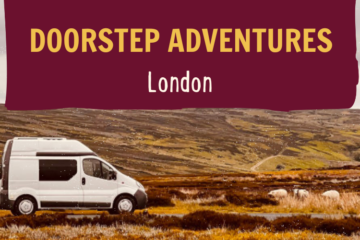
1st August 2024 Laura Hammond -->
Stay local and uncover the wonders of your area with doorstep adventure itineraries from Quirky Campers. What better place to find adventure than right …
- door step adventure
- local travel
- travel tips
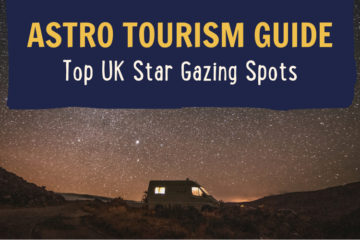
31st July 2024 Laura Hammond -->
A Beginners Guide to Astro Tourism and the Best Spots in the UK for Stargazing 2024 is set to be an extraordinary year for …
Search Quirky Campers
Search campervans for hire.

Europe by Motorhome: The Best & Only Touring Guide You Need!
This post may contain affiliate links, from which we earn an income. Click here to read our affiliate policy.
Campervan & Motorhome in Touring Europe
Do you want to explore Europe in your motorhome or campervan? The best thing about Europe is the culture, cuisine, rich history, nature and diversity, enough to last a lifetime of exploring. Taking a motorhome across Europe seems like an awesome idea, especially with our ultimate guide to help you work it all out!
We’re Phil and Izzy and we’ve been full-time touring and travelling in a motorhome in Europe for over five years. In this post, we share everything we’ve learned on the road in Europe.
Find out how you can travel Europe in a motorhome with practical motorhome advice, Europe motorhoming itineraries, travel tips and hints about living in a motorhome full time and loads of other useful stuff!
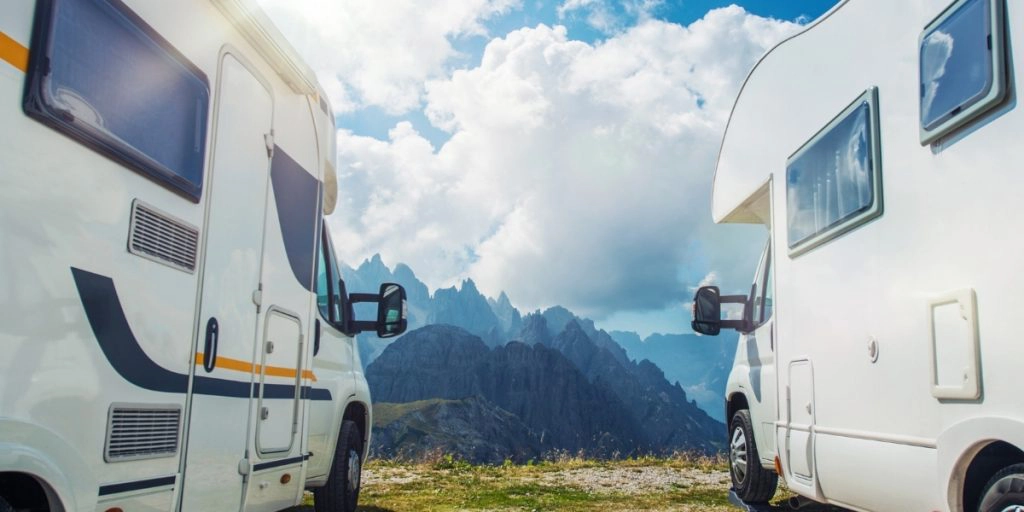
Basic Requirements for Europe Motorhome Travel
This section has been updated to reflect the post-Brexit agreement between the UK and EU on 24th December 2020. It’s boring, but spend just one day doing the research before you head off, and you’ll have one less thing to think about. If you do get stopped during your European tour you’ll have all the correct equipment and documentation to show. Our advice and travel tips cover the basics:
- You must have at least three months remaining on your passport (issued in the past ten years) at your intended date of departure from Europe. If you’re travelling in a motorhome in Ireland , your passport only needs to be valid for your stay (UK citizens do not need a passport to travel to Ireland which is in the Common Travel Area).
- A UK driving licence is needed for touring in a camper van in Europe. Your UK licence allows you to drive in all EU countries. If you only have a paper driving licence or a licence issued in Gibraltar, Guernsey, Jersey or the Isle of Man then you will need an International Driving Permit .
- You must have at least third party motorhome insurance for your vehicle. You are not required to have a green card to prove you have vehicle insurance coverage when travelling in the EU. Make sure to check if visiting non-EU countries like Montenegro, Serbia and Albania that you are covered – you’ll need a green card for these countries too.
- You must display a UK sticker on the rear of your vehicle, instead of a GB sticker, unless you have a UK number plate which displays the Union Jack flag. If you’re travelling in Spain you will need a UK sticker even if you have the new style UK number plates.
- Headlights must be adapted for driving on the right.
- You may need evidence of a return ticket and that you have enough funds to cover your stay – there is no fixed amount that a customs official might ask for, but you need to be able to show that you can maintain your motorhome lifestyle. Having said that, in the two years since Brexit, we don’t know anyone who has been asked to produce either a ticket of evidence of their financial position.
- Brits should get a GHIC or EHIC (Global or European Health Insurance Card) – not a legal requirement, but free so why not?
- We would also recommend your own travel insurance and Europe motorhome or campervan breakdown cover, but these are not legal requirements. We like True Traveller backpacking insurance if you need cover for more than three months.
- An Animal Health Certificate , if you’re taking pets with you.
- Any country-specific requirements for your vehicle – our country-by-country motorhome touring guides contain up-to-date information about what you need to carry in Europe.
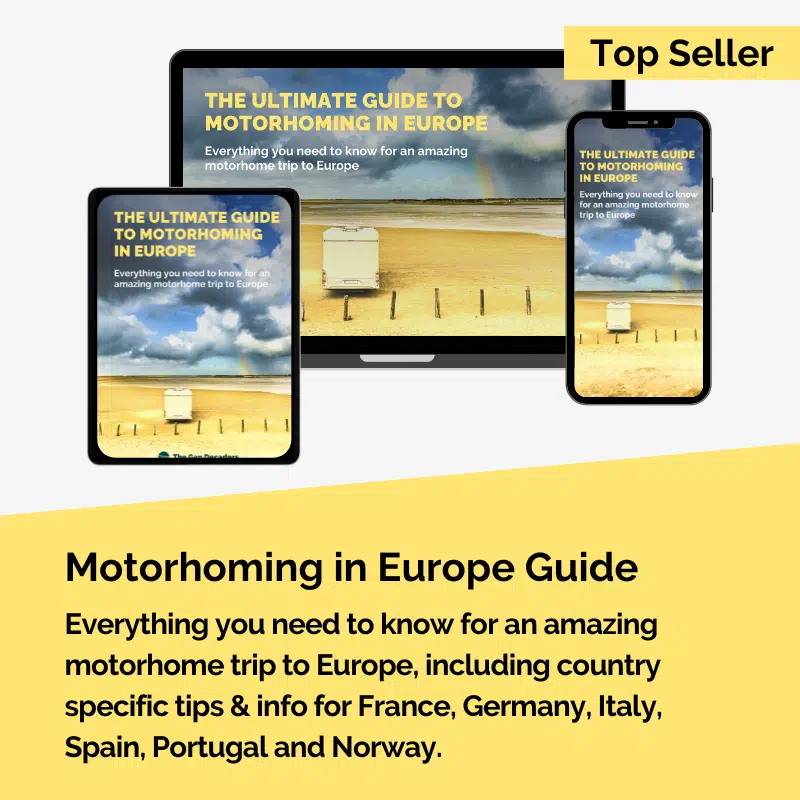
The Ultimate Guide to Motorhoming in Europe
If you’re planning a motorhome trip to Europe for the first time, our guide has top tips, advice and info to help you plan your tour.
Don’t struggle to plan your European trip, find out everything you need to know before you go + loads of motorhoming tips for when you arrive.
Motorhome Europe After Brexit
Although the UK left the EU at the beginning of 2020, because the pandemic came swiftly on its heels, many of us are still realising the repercussions and getting used to how it affects travelling in a motorhome.
You can find out all the details you need in our guide to motorhoming in Europe after Brexit , and in our guide to motorhoming in Ireland , which due to being in the common travel area (CTA) has some different rules.
In the meantime, here are a few frequently asked questions and answers about what happens when you cross the English Channel:
Do I need a visa for Europe?
Nothing changes with your passport, but from 2025, the EU will introduce the ETIAS (European Travel Information and Authorisation System), which will be an additional entry requirement for visa-exempt travellers and will involve the traveller registering their details online before travelling, mainly for security purposes.
How long can I stay in Europe?
UK citizens can only stay in the Schengen Area (a zone in Europe where countries have no internal borders and allow the free and unrestricted movement of people) for 90 days in every 180 days in the Schengen Area.
The 90 in 180 day rule works on a rolling basis and it can be difficult to work out whether you are within the rules or not, especially if you have visited the Schengen area on several occasions in the preceding 180 days.
Long-term travelling by motorhome in Europe is still possible, you just need to be organised and have a plan to ensure you don’t overstay. This comprehensive post about campervan travel in Europe post-Brexit explains all the details and offers advice and insight into how long-term motorhome touring in Europe is still possible.
What food can I take in my motorhome to Europe?
The European Commission says the following:
- Travellers are not allowed to bring in meat , milk or their products .
- There is an exemption for powdered infant milk, infant food, and special foods or special pet feed required for medical reasons if weighing less than 2kg and provided that: such products do not require refrigeration before opening, that they are packaged proprietary brand products for direct sale to the final consumer, and the packaging is unbroken unless in current use.
- For fishery products (including fish and certain shellfish such as prawns, lobsters, dead mussels and dead oysters), travellers are allowed to bring in up to 20kg or the weight of one fish if this is higher.
- For other animal products , such as honey, live oysters, live mussels and snails, travellers are allowed to bring in up to 2kg.
Can I use my mobile data in Europe?
Internet access in Europe very much depends on who your mobile phone contract is with and when you started the contract. All UK providers now limit data usage in the EU in some way or another, and it’s a good idea to check with your provider to make sure you don’t run up a big bill. You can find lots of information in our guide to the best SIM cards in Europe , especially if you’re planning to be away for more than a few weeks.
We have been using and recommend ConnectPlus for cloud SIM connectivity in the UK and Europe. You can choose from unlimited data packs to just single days, depending on your needs. The device is no larger than a slimline smartphone, connects with up to ten devices, is charged easily with a USB and can be delivered within a few days of ordering. Use the code ‘thegapdecaders’ at checkout to get 50% off in the first month!
Can I take a pet to Europe in my motorhome?
The good news is that you can take dogs, cats and ferrets to Europe. You’ll need to book a pet-friendly cabin or kennels on the ferry or travel via the tunnel from the UK. Your pet will need a microchip, a valid rabies vaccination and an animal health certificate (AHC).
When pets are travelling to Norway from countries in the EU/EEA (such as Germany or Denmark ) the animal and necessary documentation must be presented to Norwegian Customs for checking. Walk or drive through the red zone in the Customs area to present your paperwork and pet.
When travelling to Norway from Sweden, the animal and documentation need not be shown to the Norwegian Customs if the animal has been kept legally in Sweden and meets all requirements for entry.
It can take some time to get all the documents together and the vaccines organised, so make sure you start the process well in advance and find out more about travelling in Europe with a dog before you set off with your fur baby!
Europe Campervan Hire or Taking Your Own?
Taking your own motorhome to Europe is relatively simple. There’s no need to temporarily import your vehicle, even if you’re touring and you don’t need to have a left hand drive van. Just make sure you have the right documentation and required safety equipment, and you’re good to go.
If you’re new to motorhoming, or campervanning on the continent for the first time, then a two week holiday in Western Europe is a great way to start, especially if you rent a motorhome .
Your rental company will ensure your campervan hire for Europe will come equipped with everything you need to enjoy a few weeks across the channel in July or August, and you’ll enjoy a great taste of European motorhome life .
Our recommended European campervan and motorhome hire company is Motorhome Republic , which has hundreds of pick-up locations across Europe, all perfect starting points to see all the best bits as you road trip Europe .
An aggregate motorhome and campervan booking site, Motorhome Republic pull together all the best deals from many different rental companies, to offer you a wide choice of options alongside an excellent English-speaking expert motorhome Concierge Team.
If you’re coming from North America and are used to traveling in a recreational vehicle, motorhomes in Europe are a little different from RVs in the States. Styled differently and significantly smaller (even if it feels large to us Brits!), we generally don’t have slide-outs, full-sized appliances or beds in our motorhomes.
Most European motorhomes use cassette toilets, rather than having a black or black and grey waste tank, but you’ll be pleased to know that European motorhomes are usually left-hand drive, so just like travelling in an RV at home 🙂
RELATED POST: Everything You Need to Know About Motorhome Hire
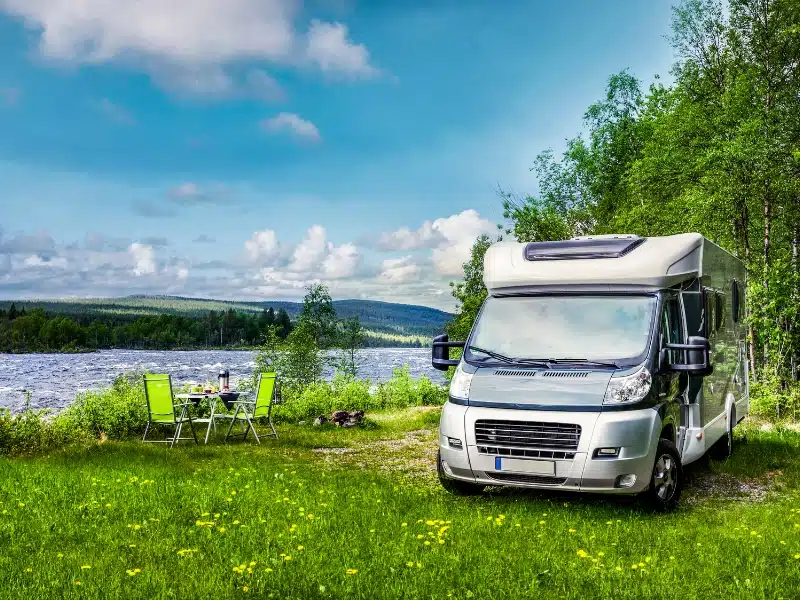
Preparing Your Van for Europe
When planning and taking a motorhome or campervan road trip across Europe you’ll need to consider whether you have the right accessories in and on your motorhome for touring.
If you’re heading off on a short two week campervan trip in Europe, then you may already be well set up for this type of holiday and won’t need any special preparations to have a fantastic trip.
New motorhome owners or those planning a longer tour may want to make some changes or additions. What you change or add will depend on how much you want to spend and how you want to travel Europe in a motorhome.
- Which countries will you visit?
- Will you wild camp or stay on sites? How off-the-beaten track do you want to be?
- Will you be travelling Europe in a campervan across seasons, or sticking to summer or winter?
- Are you intending to leave Europe and/or the Schengen area for different regions of the continent?
- What’s your budget?
For us, we have found the additions below to be worth the extra cost when spending more than a month or so on the continent. If you intend to travel long-term or regularly in Europe, then these extras will pay for themselves.
RELATED POST: Motorhome Accessories, Equipment & Options
If you’re planning on spending winter in mainland Europe then you may need heating in your motorhome. Some areas in countries like Spain and Portugal are warm enough year-round for you to not need heating, but if you head into the mountains, then you could well be facing freezing temperatures.
RELATED POST: Winter in a Motorhome – Tips, Tricks & Essentials
Gas and LPG
You can’t take a UK gas bottle to Europe and exchange it. This means if you run out of gas, you’ll have to carry your empty bottle and buy a bottle in whichever country you are, as well as a suitable regulator. This is not difficult, but it is a hassle and an added expense.
Disposing of your empty bottle is illegal, and it’s also illegal to re-fill Calor gas-type bottles at the pump, so there really is no easy way to get gas if you’re not prepared.
If you’re touring for more than a month or so, we would highly recommend a refillable Gaslow or Gasit system which can be filled in any EU country (including the United Kingdom) at the pump using a set of special adaptors.
You’ll save money every time you fill, LPG (called GPL in Europe) from the pump is around 70% cheaper than buying it in a bottle.
The downside with a refillable system is that in the UK lots of garages have stopped selling LPG at the pump as the take-up of LPG vehicles has been surpassed by electric technology. A good compromise is to have one bottle on a refillable system and one UK bottle, and we hear about more and more people doing this.
If you’re planning to visit Morocco in your motorhome , gas at the pump isn’t available (nor in Finland) so this does need careful planning.
RELATED POST: An Easy Guide to Motorhome Gas & LPG in Europe
If you are planning on free camping in aires or wild camping in Europe (if you’re a wild camping newbie, it’s the ideal place to start) then you will need equipment to ensure you have electricity when you’re overnight parking off grid .
This might include a solar panel and you may want to upgrade your leisure batteries. You could also consider a solar generator , which is portable and will provide you with enough power to wild camp as much as you like, as long as the sun is shining!
RELATED POST: An Easy Guide to Motorhome Electrics
Air Conditioning
With summer temperatures regularly getting into the early 40s in Europe, air conditioning can be a lifesaver. One summer in France, despite being dyed in the wool wild campers, we spent every night in a campsite or aire, just so we could plug in and have air con!
If a roof-mounted a/c unit is too expensive, take a look at portable air conditioning solutions – the technology has advanced in recent years, and some of them are pretty good. Make sure to check the size though, as they can be large!
If you’re travelling in summer, then an awning of some description is an absolute must. Having one fitted retrospectively can be expensive, but a drive-away awning, a simple gazebo or even a collapsible umbrella can do the trick.
Water Filter
If you’re planning on visiting countries where the quality of potable water is questionable, or you don’t want to drink de-salinated water (common in southern Spain), then a water filter is a great option.
We have a Nature Pure filter fitted, a job a competent DIY’er could manage. We love not having to buy bottled water and then having to cart the empty bottles around until we find a recycling point.
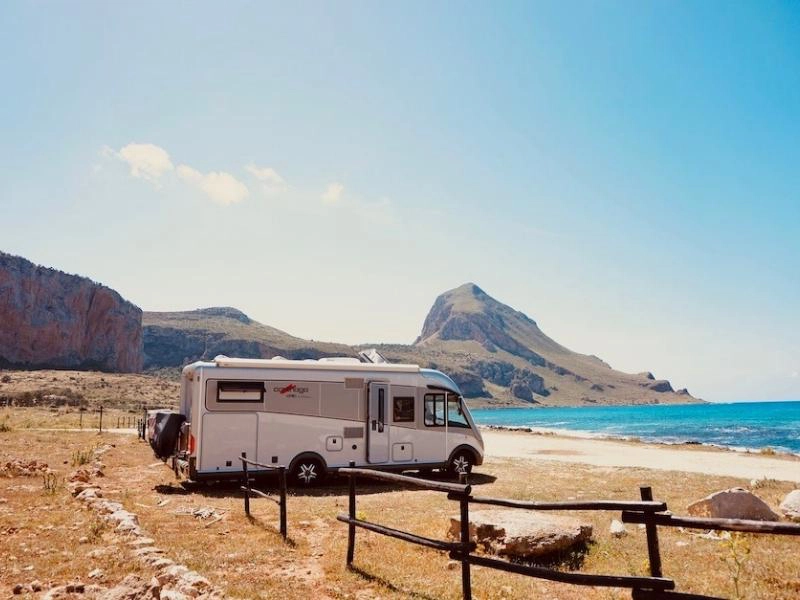
What Kit Do You Need In Your Motorhome?
Are you taking a 2 week campervan trip in Europe or longer? Will you be travelling Europe in a camper van across seasons and into different regions of the continent?
Packing List
Have a look at our essential motorhome kit list for an idea of what kit and gear we think is important when taking a motorhome to Europe. You’ll also find links to a free motorhome packing list covering kitchen, garage, gadgets , safety equipment and personal essentials.
RELATED POST: 101+ Motorhome Essentials You Need + Packing Checklist
Motorhome Internet & Wifi
Connectivity is important if you want to stay in touch with loved ones, post on social media and keep up with what’s happening in the world.
We know that information regarding European roaming on a UK contract changes frequently so we keep our post about motorhome internet and wifi up to date, so you can check the best equipment and European sim card options for your needs.
RELATED POST: An Easy Guide to Motorhome Wifi & Internet
Motorhome TV
We all like a bit of TV, and being in Europe doesn’t change that. There are lots of ways of getting TV in a motorhome, and when you’re abroad there are a few things to be aware of if you want to watch UK television.
RELATED POST: Motorhome TV – Five Ways to Watch in Your Van
You also need to consider how you’ll get out and about, especially if you intend to remain static on a site or an aire for more than a few days.
If you’re in an urban area, local buses, trams and metros may work, and public transport is the best choice for city visits . If you’re more remote you’ll want to be able to get to the nearest village or head out for a day.
Make sure you research thoroughly if you want to tow a car – the law regarding A-frames in Europe is often misquoted and not always clear. You may find some helpful information on various Facebook forums for motorhome owners, and on the UK Government website .
RELATED POST: The Best Motorhome Bike Racks & Bikes
Gross Vehicle Weight
What and how much you pack will also depend on the gross vehicle weight (GVW) of your motorhome and how much storage space you have.
As a general observation, if you fill your storage space you are likely to be overweight – just because you have loads of cupboards doesn’t mean you should fill them all!
Read our guide to understand how motorhome weights work and don’t forget to include your toys like bikes, kayaks , gadgets and so on when thinking about weight.
RELATED POST: An Easy Motorhome Weight Guide
Driving a Motorhome in Europe
Each country differs, but on the whole, driving in Europe is very safe – the continent has by far the lowest RTA fatalities in the world. Sweden and Denmark have the best safety records, with Bulgaria and Romania lagging, and everywhere else somewhere in between.
As long as you practice caution, take it slowly and follow road signage, you’ll soon settle into it.
We’ve had both right and left hand drive motorhomes, and although LHD is a little easier, especially on narrow roads. Right hand drive is not a problem if you have a willing passenger!
Be aware that the Republic of Ireland , Malta and Cyprus all drive on the right, just like the UK.
Satellite Navigation
There are hundreds, if not thousands, of motorhome routes through Europe. Make sure you have a motorhome sat nav that has European mapping, or use a satellite navigation app such as Google Maps, CoPilot and Maps.me
Yes, it’s possible to use a paper map but ideally, you want up-to-date information and be able to set your dimensions in the sat nav if you’re in a larger van. This helps to avoid routes with weight or height constraints, like low bridges and allows you to set your route to miss toll roads if you prefer to take the more scenic route.
RELATED POST: Motorhome Sat Navs: Best Models & Options for 2024
We would also recommend installing a dash cam, which is a five minute job if you buy a plug-and-play model.
A common scam, especially in Eastern Europe, is for a driver to pull in front of you at speed and then brake hard causing you to hit them. Unless you can evidence their actions, you will be held liable and will have to pay any excess on your insurance, and maybe lose your no claims bonus.
Be aware that dashcams are illegal in Portugal and Austria due to their privacy law surrounding filming people in public.
Speed Limits for Motorhomes in Europe
Speed limits for motorhomes vary across Europe, and can also vary depending on your weight. When you enter a new country, there is usually a roadside sign advising you of these limits.
If you use a sat nav, it will inform you of speed limits, as well as update you with traffic news, and let you know when you’ve crossed a border on your campervan journey.
Speed cameras are common in Europe, and may be fixed or mobile. Both types of speed cameras can be visible or hidden, and it’s easy to be caught, even if you’re over the limit by just a few kilometres an hour.
Your sat nav may be programmed to alert you to speed cameras, however, this is not legal in all European countries, so check with our country-specific information below – or maybe just stick to the speed limit 🙂
Don’t think that because you’re from another country you can avoid speeding fines. If your motorhome is registered in the United Kingdom or anywhere in Europe, there is a data-sharing protocol in place which means you’ll be tracked down in your home country.
Toll Roads in Europe
Tolls on motorways are common across Europe , and if you’re looking to get somewhere quickly and easily, taking the toll road is often the most cost-effective option.
With pay-as-you-go tolls, you can pay with cash or by card at the toll booth. We think the best choice is an electronic tag like an Emovis Tag , which is linked to your credit card and works in France, Spain and Portugal, or a Telepass device which works in France, Spain, Portugal and Italy.
Where a vignette (physical sticker) is required, you must order this in advance or stop at the first fuel station on the motorway as soon as you enter the country and buy one there.
Vignettes are required in Switzerland, Austria, Slovenia, Montenegro, Romania, Czech Republic, Bulgaria, Slovakia, Hungary, Moldova and Belarus, and you can buy some of these online at Digitale Vignette .
If your motorhome is over 3,500kg, arrangements will be different and you may need a physical onboard unit, which has to be collected and pre-loaded at the border.
In our experience, Norway and Portugal have the most complex toll systems, with different toll road operators requiring different processes. Check out each country in our motorhome touring guides.
RELATED POST: Tolls for Heavy Motorhomes >3.5T in Europe: Country by Country Guide
Fuel in Europe
Fuel costs in Europe vary wildly from country to country. Generally, the further east and south you go, the cheaper the fuel.
Greece is the exception to the rule and although the furthest south and east you can go in Europe, it has some of the most expensive fuel on the continent!
Use the excellent Mappr tool to see at a glance what you’ll pay per litre.
In some countries, like Italy , there are two prices for fuel – one for self-service and one for attendant service and the latter can be up to €0.15 per litre (or 57¢ per gallon) more expensive! Beware Italian garage attendants who usher unsuspecting road trippers to the more expensive pumps…
In Europe, gasoline is generally called benzine or sans plomb and in the UK it’s called unleaded petrol – the pump handle is almost always green .
Diesel is usually called diesel or gasoil , and the pump handle is always black . But, these names can change slightly by country, so if you’re unsure use a translate app to work it out.
Low Emission Zones in Europe
Low Emission Zones (LEZs) are areas, usually in towns and cities, where the most polluting vehicles are regulated and either cannot enter the area or have to pay to enter the low-emission zone. Most EU countries have LEZ in place.
Vehicle emissions are classified in Europe by Euro Standards, which determine and categorise a vehicle’s emissions to determine its pollutant levels.
Before you travel into a low emission zone (mainly cities) you first need to find out if your vehicle is affected – this will depend on the vehicle type, age and fuel.
Each county has different regulations like Crit’Air in France and umweltplakette in Germany. Some require you to pay to enter online, some ask you to buy a physical vignette or sticker, some don’t allow you to enter during specific times of the week and some only allow Euro 6 (the least polluting) vehicles to enter. It’s complicated!
If you are planning on visiting cities along your campervan route, this is an area to look at early on as it can take weeks for the physical sticker to arrive. Find out more about each country in our motorhome touring guides.
Common EU Driving Rules
- Under EU law, seat belts must be used in all vehicles. Children over 1.35m can use an adult seat belt. Those under 1.35m must use equipment appropriate to their size and weight when travelling in a car, like a car seat or booster cushion.
- It is illegal to use your phone at the wheel in all EU and European countries. In France and Spain, you may not even use a phone as a satellite navigation device or with hands-free equipment.
- All EU countries have different alcohol limits set in their drink driving legislation which may be different or lower to your home country. It’s best not to drink any alcohol if you’re planning on driving anywhere afterwards.
- All European countries with mountains have rules about snow tyres and snow chains. Make sure you check these rules if you’re taking a road trip of Europe in colder weather.
- Member states of the European Union have a standardised set of road signs, very similar to the UK.
- In many European countries, certain discourteous behaviors, such as rude gestures in Germany and honking the horn without cause in residential areas in Spain and Italy are offences for which you can be fined! Make sure you’re aware of the specific European driving laws for each of the different countries that you intend to visit.
Road Conditions
Some European countries have less money to invest in their roads, and generally, the further east you go, the longer the roads have to wait for repair.
Large potholes, badly laid tarmac, lack of road marking, and poor quality of repairs can make driving challenging on country roads, and even on motorways in some countries.
Go at your own pace until you’ve got the measure of your surroundings, and leave enough room between your car and the vehicle in front, so you can see ahead and avoid the worst bits!
Driving Standards
Driving standards across Europe vary, from the considerate and patient Norwegians to the fast but competent Germans, and the feisty and loud Italians!
Each country has it’s own distinct bad habits and the best way to learn is to watch the locals and take it slowly until you’re comfrotable with what to expect.
In Greece , the Balkans and Italy , overtaking on bends, at the brow of a hill and generally where visibility is poor, is very common. Other drivers tend to slow down to ensure there is room for all the vehicles on the road, but it can be very disconcerting the first few times it happens.
In France , drivers will sit very close to your bumper waiting for the opportunity to overtake. They will also have their indicator flashing, to let you know they want to get past, and they do seem to have a particular dislike of motorhomes!
In Italy , the drivers are incredibly impatient and will honk their horns at the drop of a hat. They don’t give an inch if you’re trying to enter the traffic flow, so you have to do as they do, and just go when even the smallest opportunity presents itself.
Even though speed is not limited on 70% of the German autobahn network , the roads are often so busy that a de facto speed limit is established. But if you do get an empty stretch, observe any signage before you put your foot down!
Regardless of the driving laws in each country, you’ll always see locals breaking them. Using phones at the wheel, not wearing helmets on motorbikes and blatantly ignoring the speed limits are common.
Don’t get sucked into thinking this is OK – local police seem to have a lot less tolerance for tourists breaking the rules!
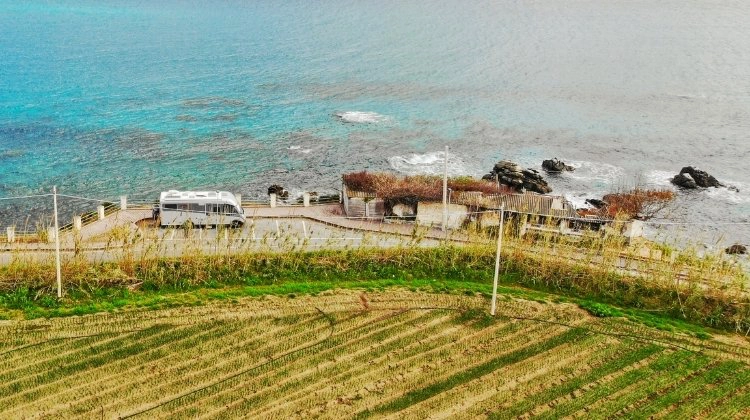
Europe Motorhome Destinations
How on earth do you choose where to go when touring Europe by campervan ? There are so many different places to see, how do you fit it all in?
You could spend literally years in a camper in Europe and not see it all. If you don’t have much time or only want to take short trips, you’ll need to decide what to prioritise when route planning.
Is this a break from work to chase the sun and chill? Are you a culture vulture looking for Roman ruins and ancient worlds? Do you love hiking in the amazing national parks of Europe? Or, like most of us, looking for a bit of both?
If you’re looking for inspiration or don’t know where to start planning, our ready made and downloadable motorhome road trips for France, Germany and Italy and three months in Europe include detailed interactive maps, travel times and distances, day by day ideas for destinations, hikes and activities plus recommendations for campsites and aires at every destination.
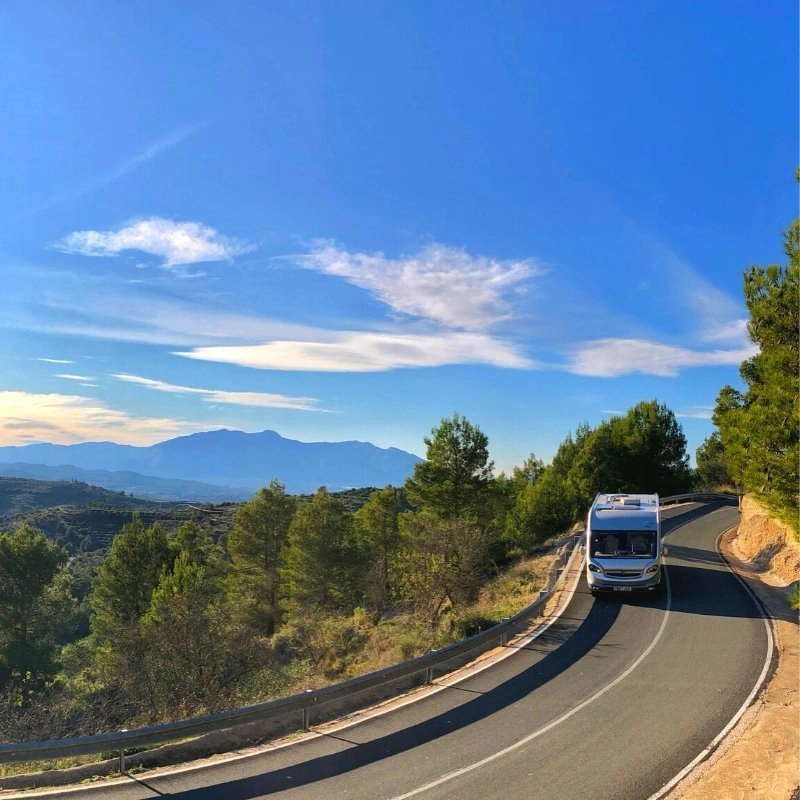
Motorhome Touring Guides
Check out our motorhome touring guides for the most popular European countries, where you’ll find information about driving, motorhome services, camp sites, wild camping spots, suggested routes and top destinations. Be inspired by stunning landscapes, mountains and coasts and incredible road trips .
Motorhome Germany – A Complete Touring Guide
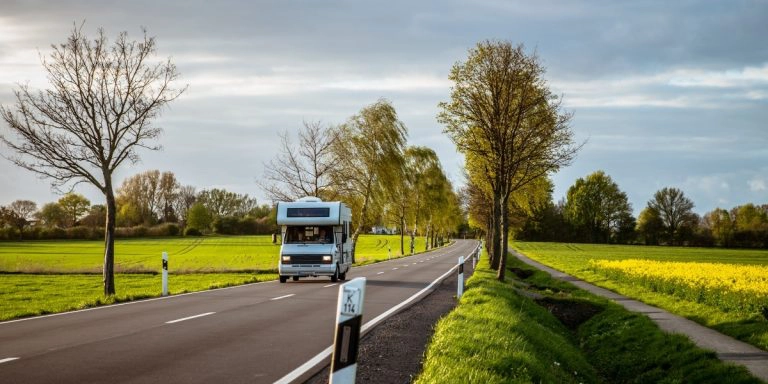
The Complete Guide to Motorhome Touring in France
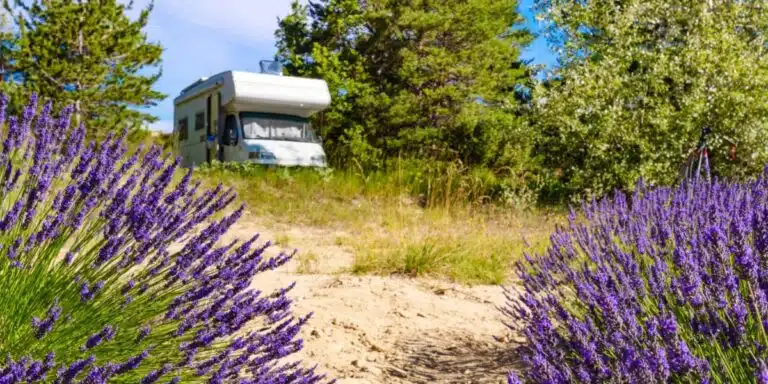
How to Tour Spain in a Motorhome – A Complete Guide
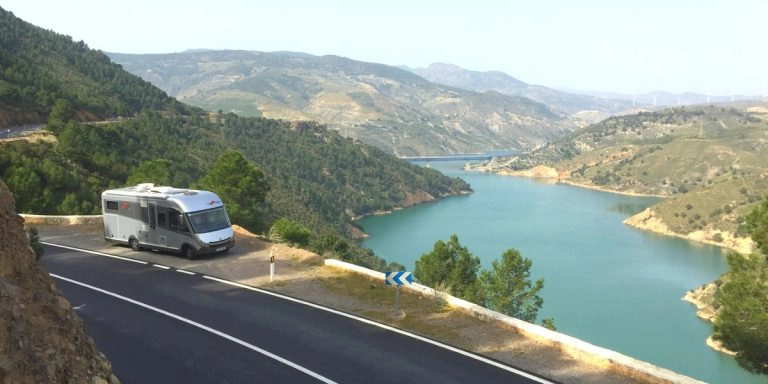
Top Tips for Touring Portugal in a Campervan & Motorhome
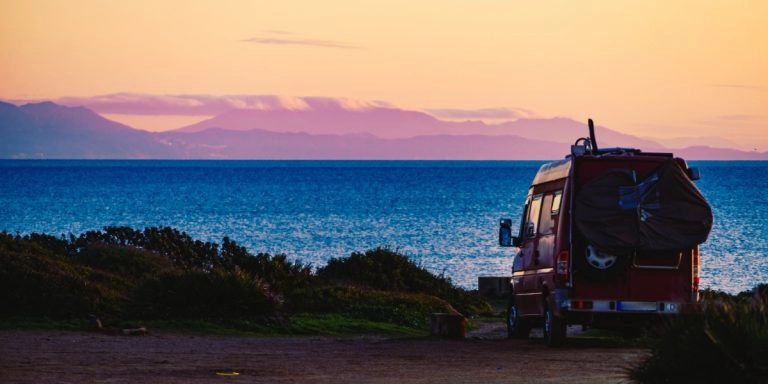
How to Tour Norway by Campervan
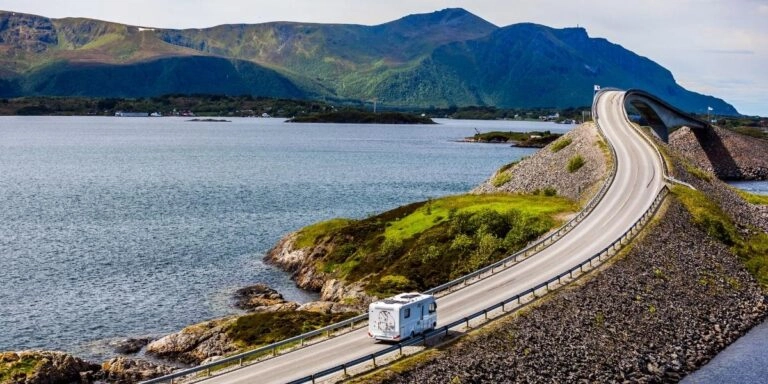
The Complete Guide to Touring Italy by Motorhome
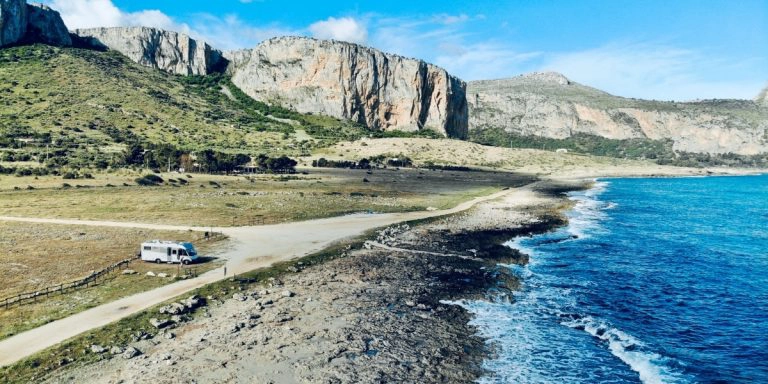
Motorhome & Campervan Greece – Complete Guide
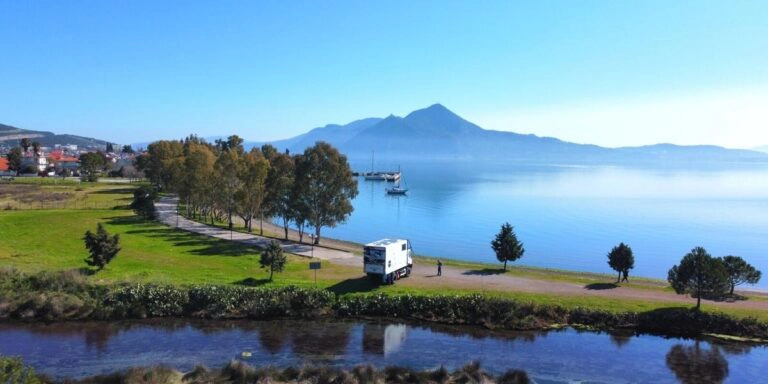
Planning Your Morocco Motorhome Adventure
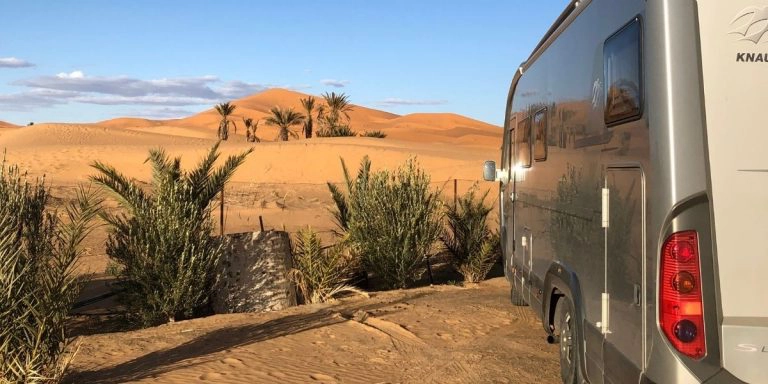
Motorhome Stopovers & Travel in Belgium
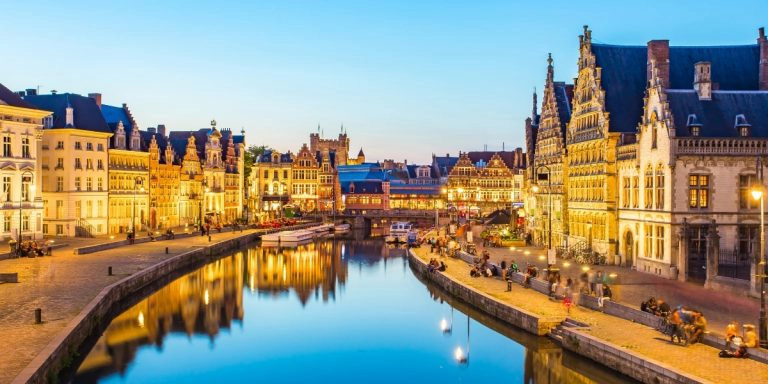
Motorhoming in Ireland – A Complete Guide
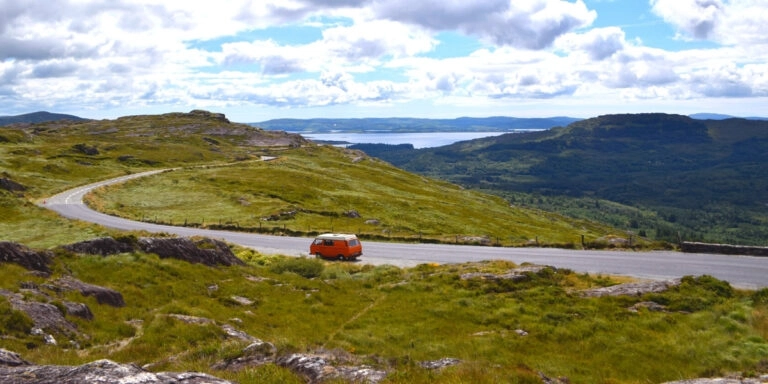
The Best Motorhome Holidays in Europe
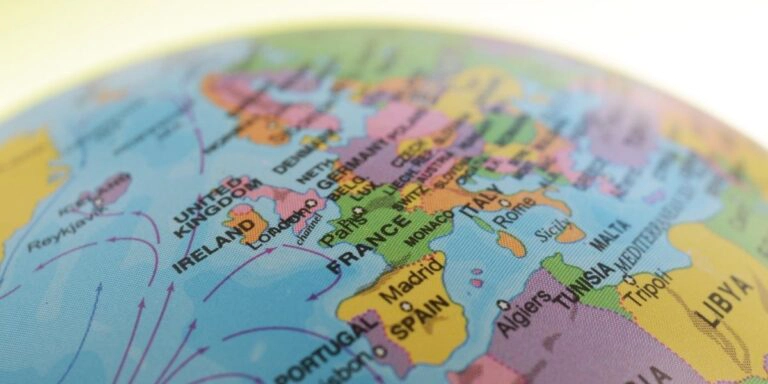
Motorhome Route Planner Europe
Ok, so now you’ve got some ideas about where to go on your motorhome trip of Europe, you need to plan your Europe travel route.
Planning a route for touring Europe in a campervan can be as complex or as simple as you want. Some people like a clear plan and a short amount of driving time per day with overnight stops booked or planned in advance, others like to just go with the flow and see what happens.
It’s why we fall out every time we look at a map or start any road trip planning!
RELATED POST: How to Plan a Europe Road Trip – The Complete Guide
Do you want access to our FREE resource library packed with travel resources & motorhome checklists?
Overnight Stops for Motorhomes in Europe
When it comes to where to stay overnight in a motorhome or campervan, Europe has lots of great options;
Motorhome Campsites
Campsites are a great option if you have a family or you like to stay out for more than a few days at a time. They also make great overnight stays if you’ve been on the road for a while and facilitate things like clothes washing and cleaning your van.
We love a good campsite after a month off-grid or a long trip. Suddenly, everything seems effortless – no worries about whether there will be enough sun to top up the leisure batteries and no issues about how long it takes to rinse the conditioner from my hair in the shower! If there’s also a bar, we look forward to meeting fellow motorhomers for a good chinwag!
One way to save money on your trip is to get an ACSI card. This discount card is invaluable if you’re planning to use European campgrounds, with the scheme giving you up to 60% off per night prices out of high season. This can mean a site for as low as €13 a night.
It’s worth getting this sorted before your camping trip to Europe as ACSI need a couple of weeks to post the card and books to you.
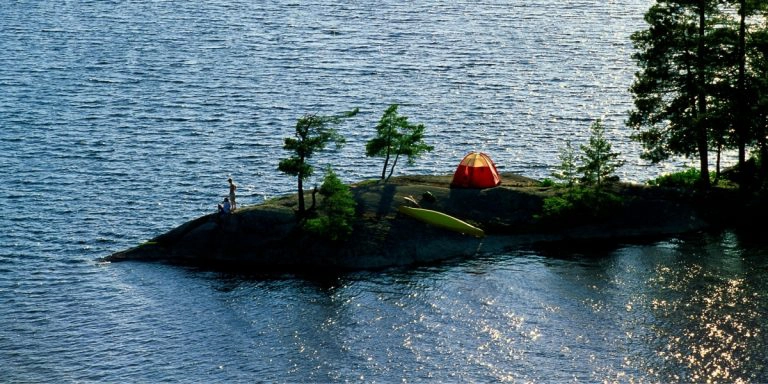
The Best Campsites in Europe – For Campers, By Campers
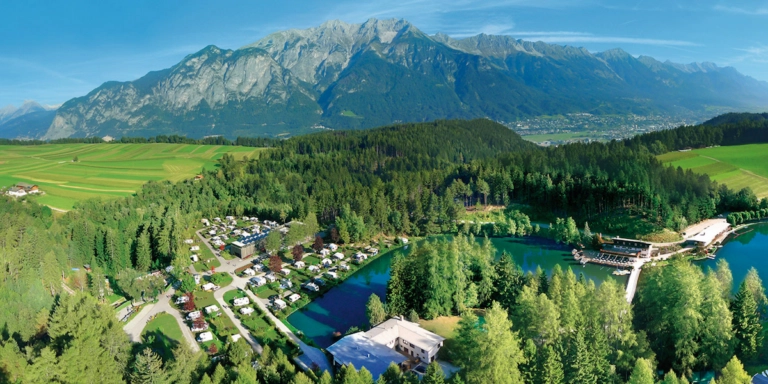
ACSI Camping Card – 2024 Review & Step-by-Step Guide
Motorhome aires.
Motorhome aires are a great way to stay overnight for very little money, and can often be found in popular small towns and villages in the countryside of Europe from the north coast of France and the French Riv to the beaches of the Peloponnese.
French aires have paved the way for other countries to set up similar schemes, where the aire is funded by the local municipality to encourage motorhome visitors into the area.
There are now more than 10,000 aires across Europe, and many of them are like free campsites, with services often provided at no extra cost.
The costs and arrangements at each aire differ, so make sure to read the rules when you arrive. Aires cannot be booked and work on a first come, first served basis.
Aires in popular destinations fill up quickly, so make sure you have a back-up plan just in case, especially after a long drive when all you want to do is relax.
Park4Night is a great app for finding aires, or use All The Aires books to identify where you want to stay.
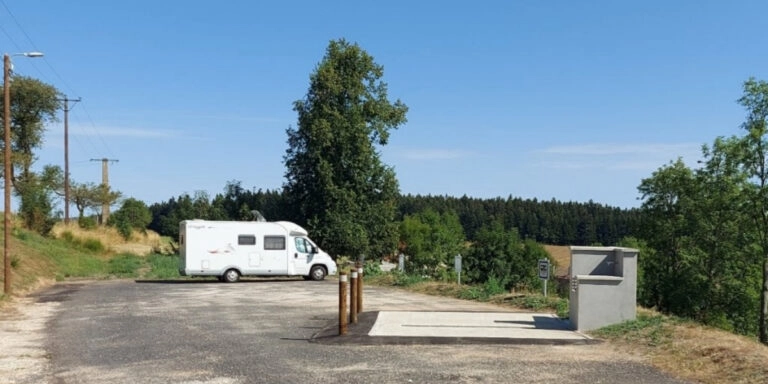
Motorhome Aires in France – All You Need to Know
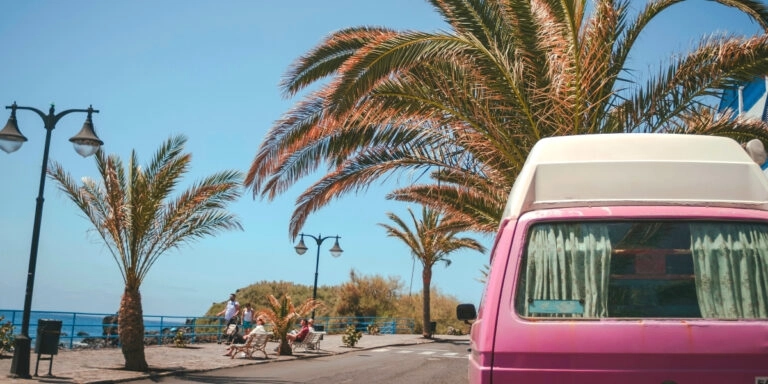
Motorhome Aires in Spain – All You Need to Know
Wild camping.
Another popular option, motorhome wild camping is widely accepted across Europe (except Portugal, which has really cracked down on this).
If you’ve only ever motorhomed in the UK, you might be surprised at the ease with which you can wild camp your way across the continent, without raising eyebrows or upsetting the locals. Much of Europe is much less densely populated than the UK and there are vast areas of land which are not populated at all that make good places for an overnight parking spot.
There are some rules (and a few unwritten ones too) which will help you find the right spot and stay safe when wild camping. Enjoy the freedom and hopefully a stunning view!
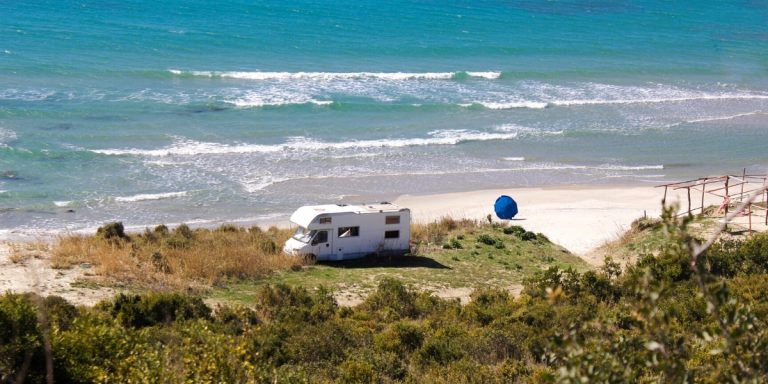
Motorhome Wild Camping – Your Complete Guide
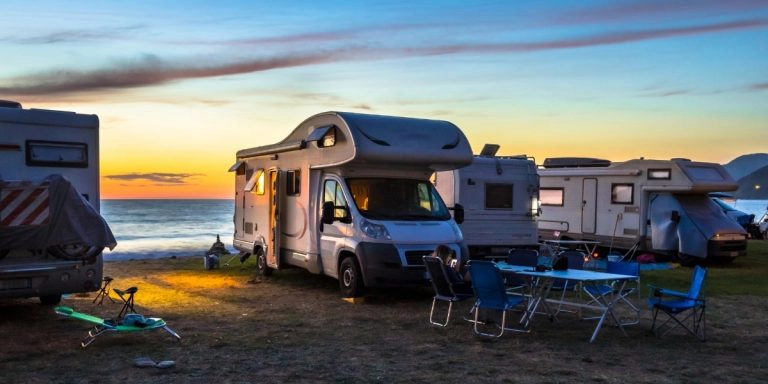
How to Find Free Overnight Motorhome Parking UK & Europe
Alternatives to wild camping.
If you’re not a wild camper at heart but don’t always want to stay on a site, there are lots of schemes to help motorhomers stay overnight in interesting places and are easy to build into your road trip itinerary if you want to get off the beaten path.
From France Passion to Portugal Easycamp , In Camper Con Gusto in Italy and Espana Discovery , all these schemes offer a place to stay overnight in a motorhome.
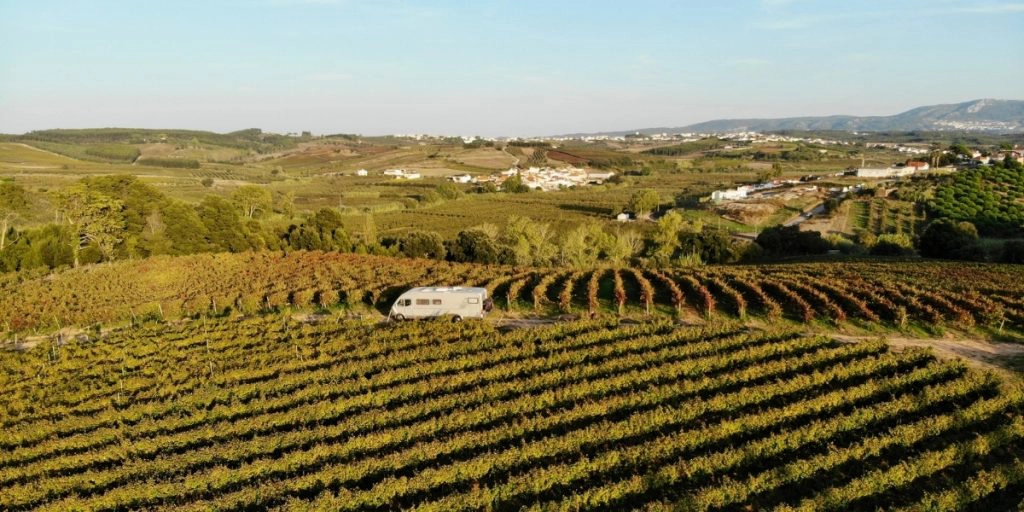
Motorhome Services in Europe
Another surprise to UK motorhomers is just how easy it is to find services in Europe, one of the great things about motorhoming on the continent. Right across western Europe you’ll find services on a regular basis, almost in every town.
Many are free, some have to be paid for, but it’s usually no more than a few euros to empty your toilet cassette and grey waste, and fill up with fresh water. This makes the idea of camping off-grid so much easier.
Services can be found in aires, fuel stations, motorway services, supermarkets and on the outskirts of towns and villages. Use Park4Night to find services near you.
RELATED POST: Living in a Motorhome in Europe – Your Complete Guide
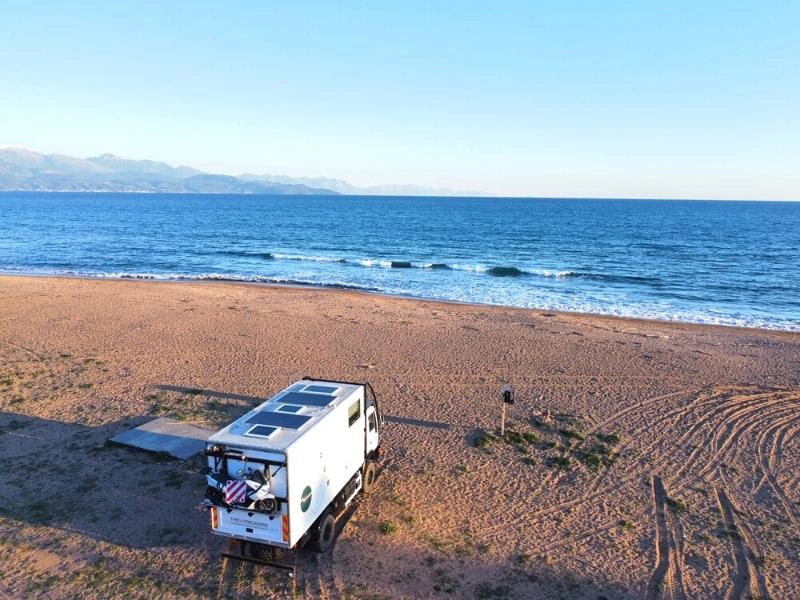
Van Life Europe
You’ve done it… you’re on the road and starting your European motorhome tour, although adventure is probably a better word!
Frequently Asked Questions
Whilst we all have views about van life in Europe, some topics crop up time and time again. See our post about the questions we always get asked – if your burning question is not there then feel free to email us . We’re always happy to give an honest answer if we can and we love questions.
What do you do if something goes wrong?
Things can, and do, go wrong. At the time, it can be very anxiety provoking, especially if you don’t speak the language, or the problem is taking a lot of time to resolve and detracting from your holiday.
We drove around France for three weeks (it was August and EVERYWHERE was closed) with our over-cab bed held up with acro props and it was really stressful.
A good first place to ask for help is our Facebook group – remember to share the make and model of your vehicle when asking for help. Try researching your problem on the internet, there is so much information available, you may just find the answer.
Search in Google for a motorhome workshop near you. Most of these places are run by motorhomers themselves and they will help if they possibly can.
You will also find a list of top 20 motorhoming FAQs here – from why your fridge isn’t cooling to why your tap doesn’t work.
How much does it really cost to tour Europe in a motorhome?
Lots of people ask us how much it costs to live in a motorhome in Europe. Our answer is always the same – it depends on how you want to live.
Make sure you have emergency funds accessible to you, whether that’s cash stashed in a secret place (not our recommendation) or an emergency credit card. Read more about general safety in our motorhome security guide.
RELATED POST: What Is the True Cost of Touring Europe in a Motorhome? A breakdown of weekly, monthly and annual costs + tips to help save money on the road

How do you make sure your relationship survives?
Being with your other half 24/7 in a small space may not be quite as romantic as you imagine! Motorhome life may come as a shock if you’re both used to rushing in from work at 6pm, collapsing in front of the TV before bed and then repeating for five days a week.
RELATED POST: Ten Truths of Travelling Together
How do you manage preventative maintenance on the road?
Prevention is always better than cure as far as motorhomes are concerned. In our experience, water and condensation are the two areas where people have the most problems.
Often it’s a simple issue, but the first time something goes wrong can be challenging and if you don’t know, you don’t know.

Preventing Condensation in Your Campervan: Top Tips & Tricks
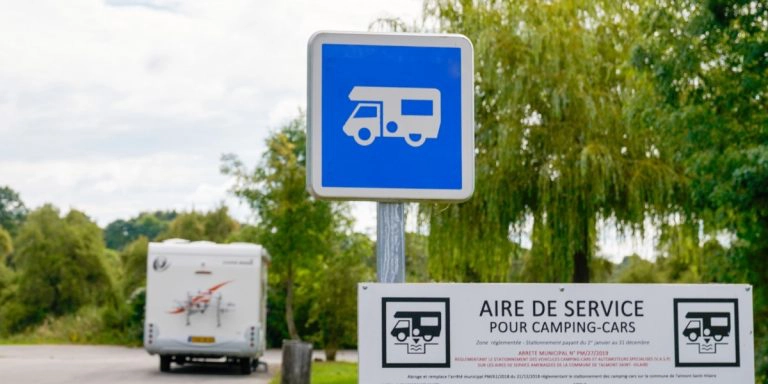
An Easy Guide to Motorhome Water Systems
Are you looking for more useful motorhome advice check out these top posts….
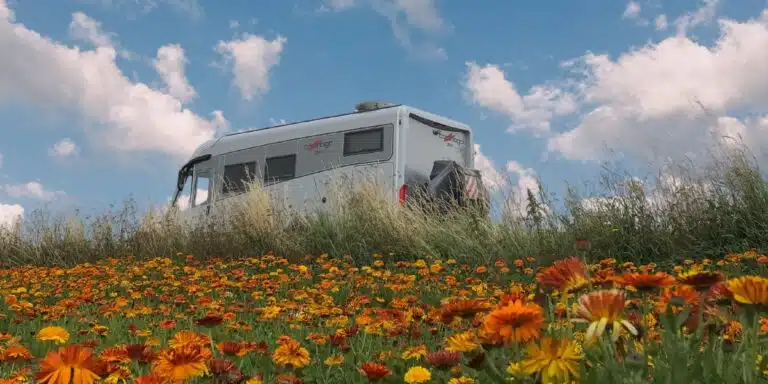
Motorhoming Tips for Beginners: Essential Know How for Motorhome Life
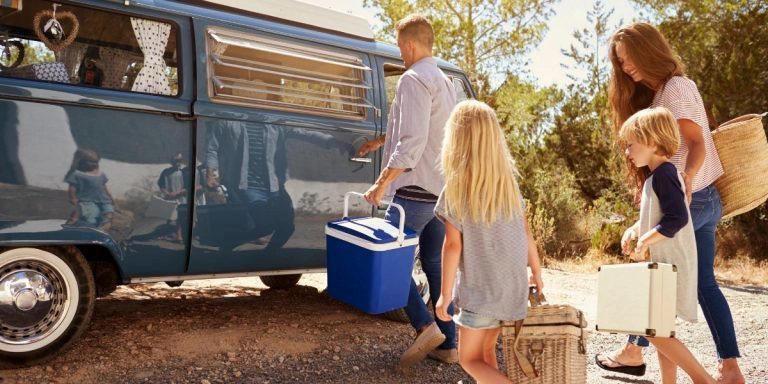
20 Amazingly Simple Camper Hacks
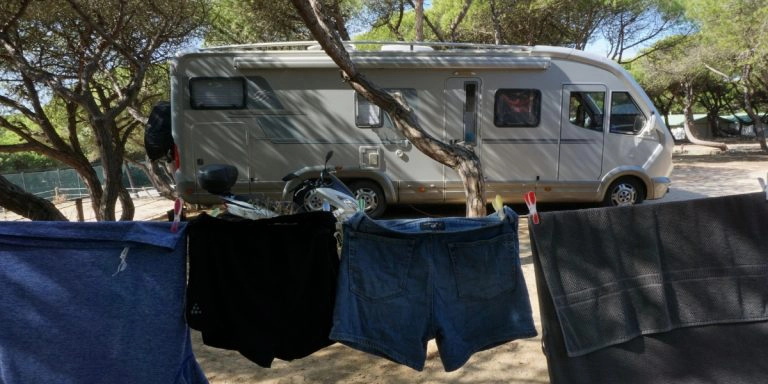
Motorhome Washing Machines – Which Is Best for You?
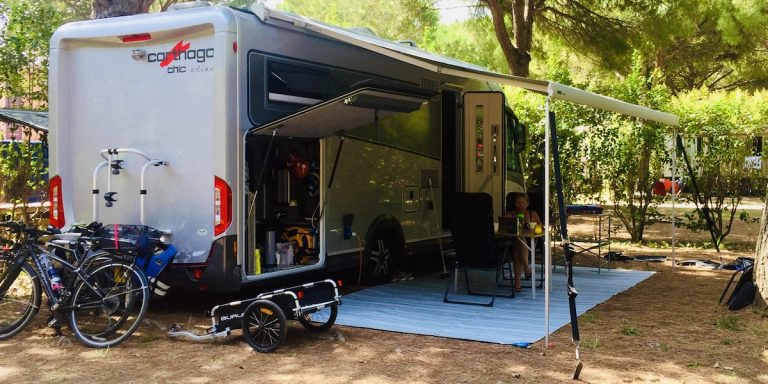
How to Take Your First Motorhome Trip (& have an amazing time!)
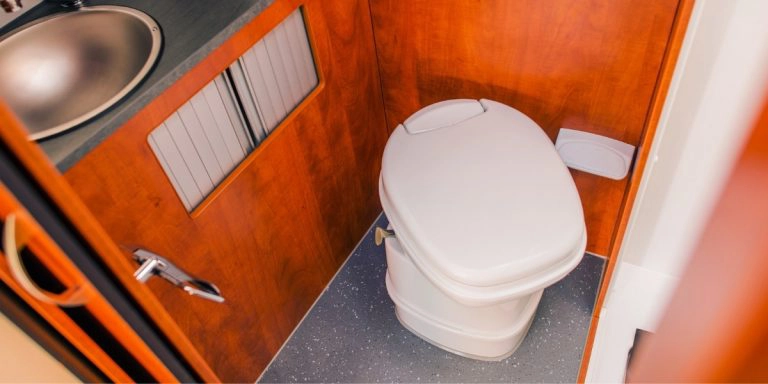
On-the-Go Convenience: An Easy Motorhome Toilets Guide
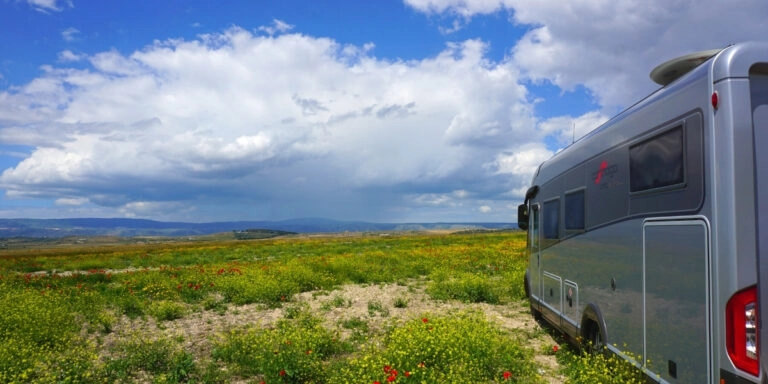
Motorhoming Made Easy – Your Top 20 Questions Answered
Love it pin it.
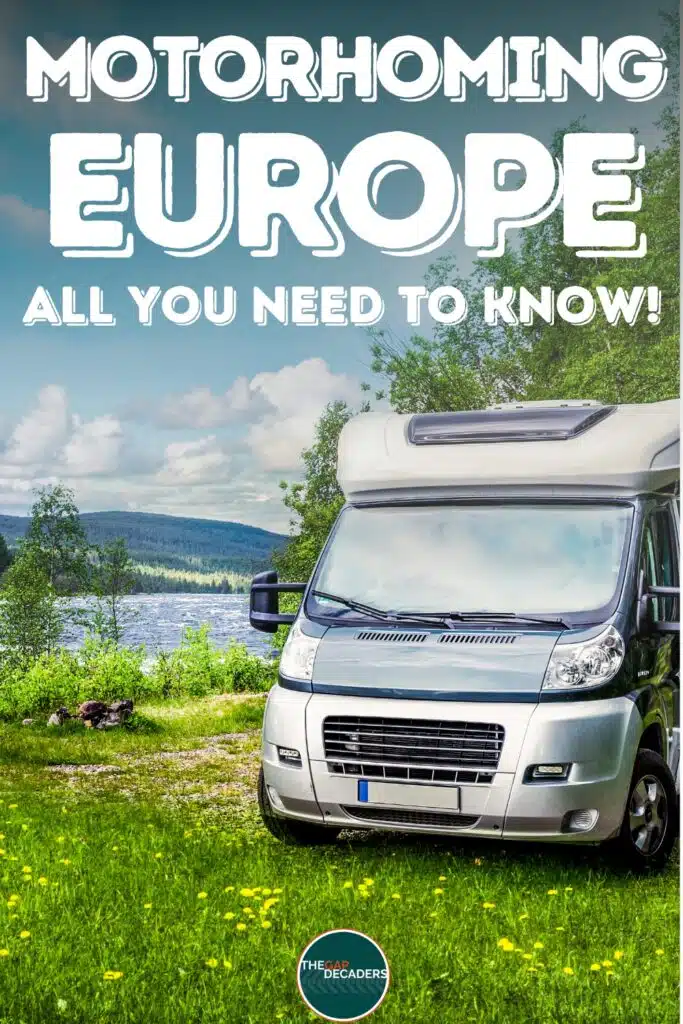
About The Author
Izzy Nicholls
Leave a comment.
Your email address will not be published. Required fields are marked *

Our Two Week Europe Roadtrip Campervan Itinerary – Switzerland, Italy + Slovenia
Two weeks in europe.
This past May/June, we spent two weeks travelling from the UK through Europe with the goal of ending up in Slovenia (before sadly, heading home). I’ve wanted to visit Slovenia for SO long, but to me, it always needed more than just a long weekend trip to the capital, Ljubljana, as there’s so much more to explore in the country. So, we decided to head there in the campervan instead.
We didn’t know if we’d be pushing it to head down there in just a few days, and yes, some of the drives from each place were around 4hrs long, with the average being about 2.5hrs of driving each day. But it was so worth it, and we got to see everything we wanted!
We’ve shared more in depth posts about each place we visited which you can find here , but I thought we’d recap it for anyone just wanting a quick read!
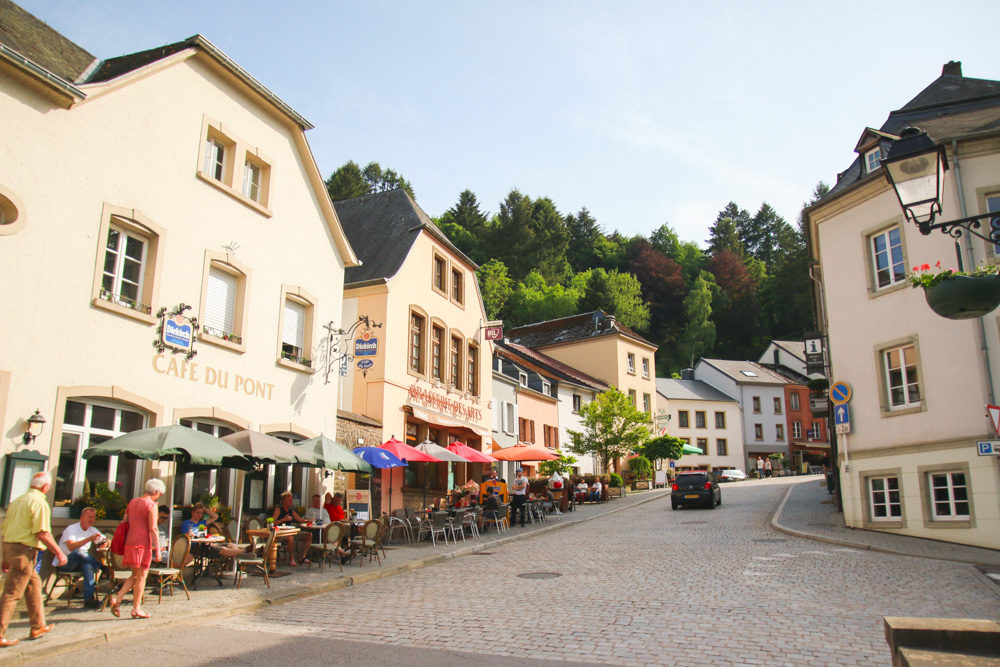
Day 1 – Vianden, Luxembourg
We got a late night ferry from the UK, arrived at 2am to our campsite nearby and woke the next morning with a 4hr drive to Vianden in the north of Luxembourg. We arrived late afternoon after a late start recovering from the tiring day we’d had finishing the van the day before and arriving so late that morning.
The town was filled with quaint, pastel coloured buildings that we wandered the streets for a while exploring, before heading up to the viewpoint on the chairlift. We definitely recommend that, where you can see both views of the town below, and Vianden Castle. If you have time, you can take a walk over to the castle too! We headed back down, had some drinks at a bar by the river while we found a campsite for the night.
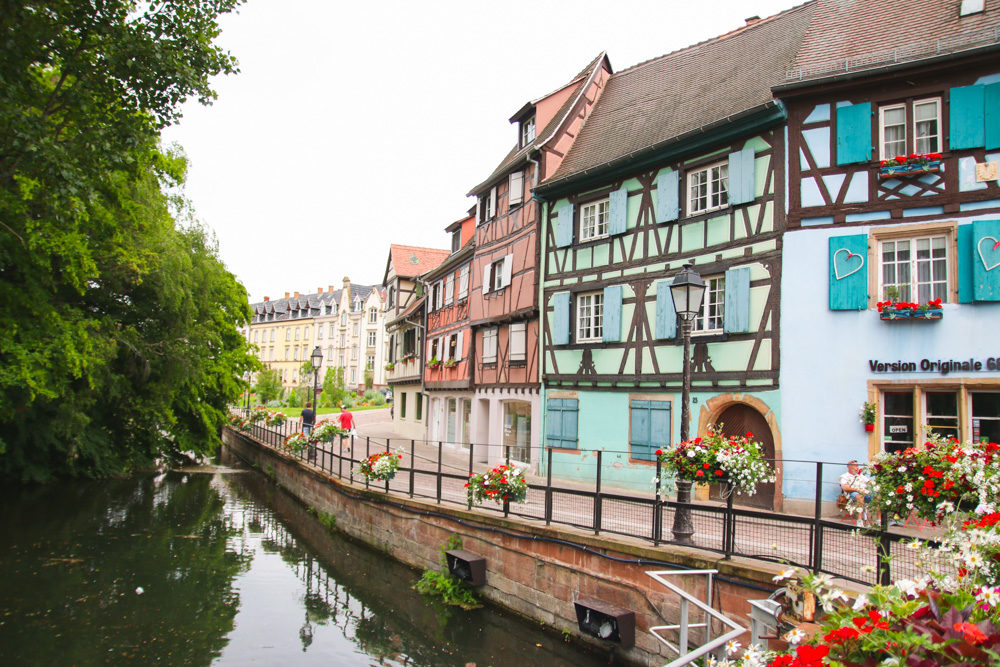
Day 2 – Colmar, France
The second day saw us driving 3.5hrs south into France to visit the old Alsacian towns of Colmar and Eguisheim. We spent the first part of the afternoon exploring Little Venice, before heading to explore more of the Old Town and stopping for some lunch. It’s such a cute little town to explore, lined with the river and definitely worth a stop.
Afterwards, we drove 10 minutes outside of the town to visit the old cobble-stone village of Eguisheim. Built in a circular style, the village was filled with colourful wooden beamed houses, just like Colmar but on a much smaller scale. We definitely preferred it over Colmar, and although it’s not in Provence, reminded us of a real life Beauty and the Beast style village!

Day 3 – Interlaken, Switzerland
The drive from Colmar to Interlaken was one of the easiest and most scenic drives of the trip, passing through hundreds and hundreds of tunnels (don’t Switzerland love their tunnels?!). It was also the most expensive 24hrs of the trip, and although it was so beautiful to explore, we couldn’t wait to leave because we just hadn’t budgeted for that level of spending haha!
We headed straight for Grindelwald, and took the (super expensive) cable car up to First. We hung around for a little while, admiring the views and watching all the activities you could do up there, wishing we had the $ to afford some of them, like the karting down the mountain, but we just stuck to the only free one up there of the cliff walk. The views were nice, but I actually preferred them from below the mountain, filled with ski shacks and greenery, with towering mountains all around!
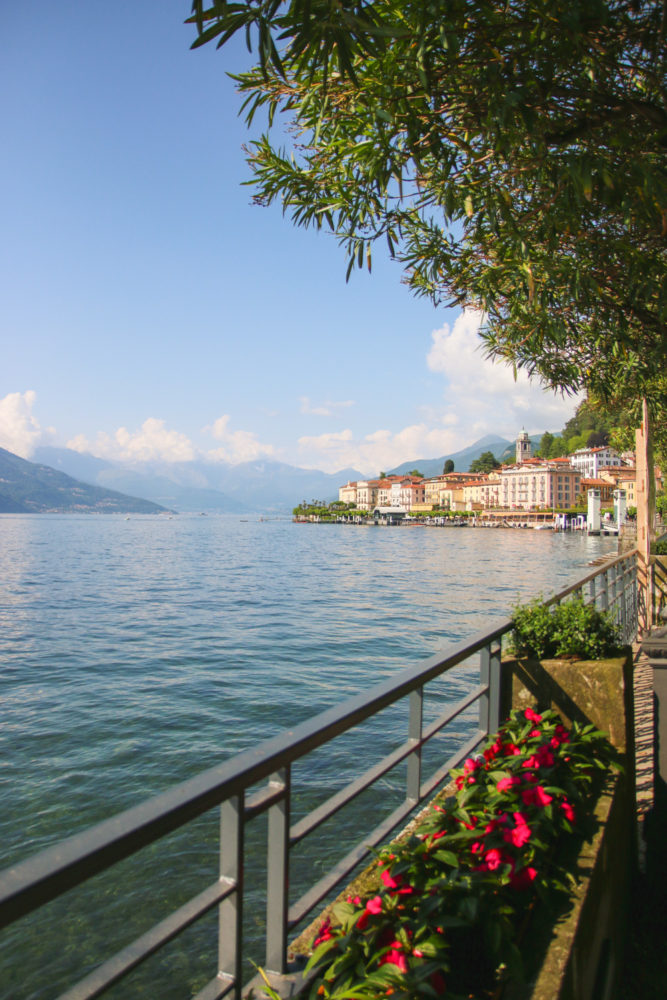
Day 4 – Bellagio, Lake Como
We headed into Italy on the 4th day, and those Italian roads and drivers are insane! We took the winding cliff and lakeside roads from Como to Bellagio, where we explored the town, treated ourselves to some gelato, and found a cute little campsite for the evening with a traditional trattoria with it’s own private beach area at the side of the lake where we settled down for the evening with a freshly baked proper Italian pizza, while we watched the sun set.
We didn’t really do much this day, but the views were amazing, and that campsite and pizza were honestly so good! It was a nice chilled day after all the walking we’d been doing the previous few days.

Day 5 – Sirmione, Lake Garda
This was one of my favourite stops of the trip, and somewhere that I’m dying to head back to at some point to see more of, because we just didn’t have long enough to see all of the things that we wanted to in the day that we spent there. Ideally we’d have spent 2-3 days driving along the lake, but with the two weeks that we had we could only really stop at one town.
So we chose Sirmione, as it’s one of the larger towns with so much history and so much to see. From beaches to swim in the warm lake water (and thermal springs), to old castles and ancient ruins to wander around. We spent a good few hours here, and then had the most chilled evening spent parked up for the night in the carpark right on the shore of the lake!
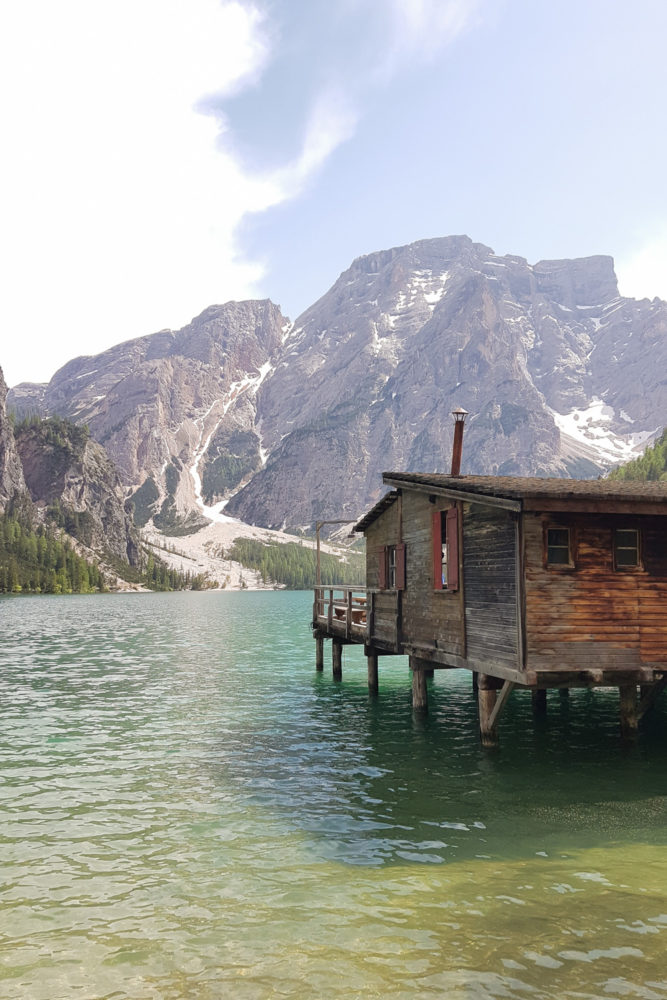
Day 6 – Lago di Braies, The Dolomites, Italy
Day 6 was another chilled day headed north from Lake Garda to Lago di Braies in the Dolomites of Italy. We got stuck in major traffic just outside of Garda because of a huge accident, but we finally arrived in Lago di Braies (also known as Pragser Wildsee) in the afternoon. Sadly, half of the lake was closed off for filming so the famous boathouse wasn’t open and we were quickly shuffled away by security so that filming could start.
By the time we walked to the far end of the lake, which was closed due to safety reasons from landslides, they’d shut off a whole other section of the lake for filming as we were headed back so we didn’t have the best experience here. That along with mega expensive parking for the campervan left us in a pretty bad mood about the whole thing. But, we found a campsite and spent the evening having a good clean up of everything, got all of our clothes washed and just chilled in the van with the rain rolling in.
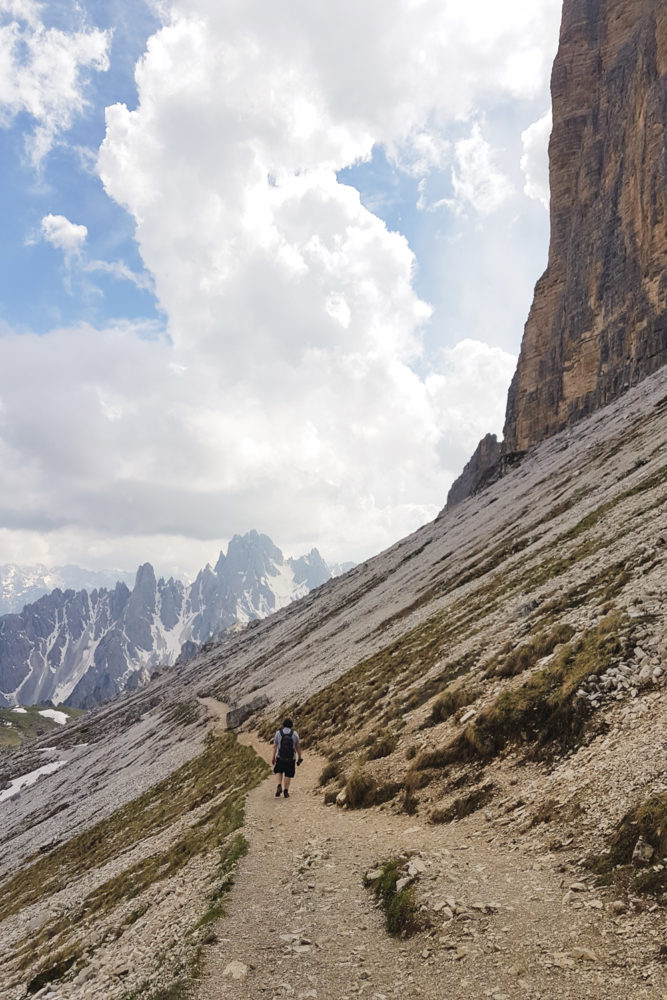
Day 7 – Tre Cime di Lavaredo
So we kind of did a huge detour on the whole trip because I really, really wanted to head to Lago di Braies, and the Tre Cime di Lavaredo, which was a good few hours north of the rest of the journey. But it was SO worth it. Tre Cime di Lavaredo turned out to be our favourite stop of the entire trip, and a night that we’ll never forget. And we *almost* didn’t head up there because we found out that morning while researching about it, that the road to the carpark was a toll road and would cost us €45 for the campervan!
We headed up anyway, and man was that road steep! I hated it, but the views from the top were amazing and I’m so glad we did it. We headed straight out to do the circular walk, which is actually pretty flat for the most part, but as the trail had only opened 5 days before we arrived, the snow hadn’t been cleared on the second part of the trail yet, and so to me, it was too dangerous to traverse the tiny slushy path that everyone else had made to get across, so we turned back. The views were incredible though, and you can stay overnight in the carpark, so we did just that to get our moneys worth! We couldn’t get over those views!
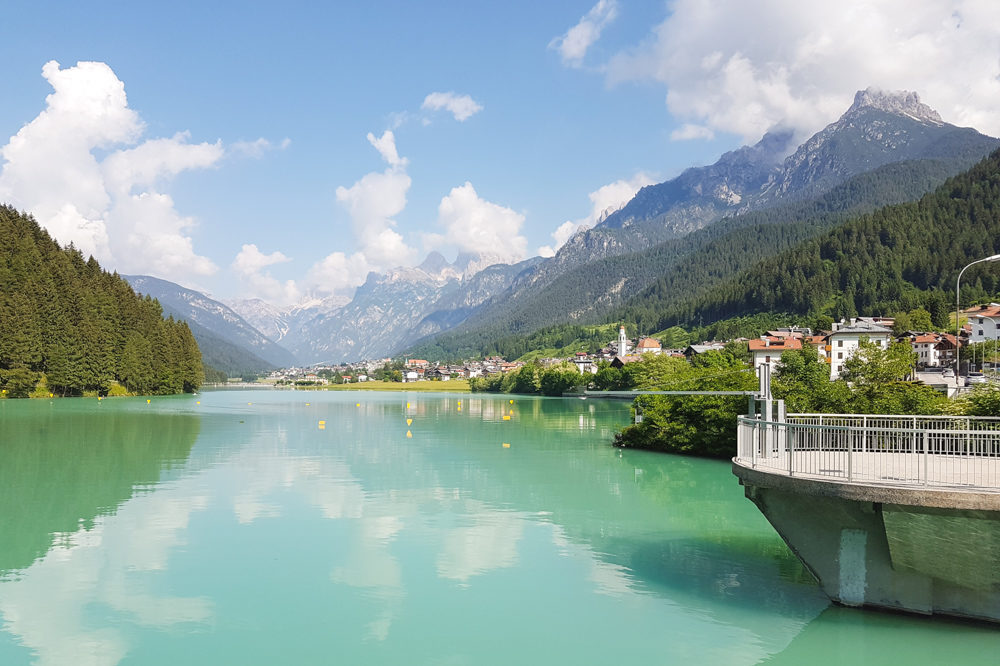
Day 8 – From Italy to Slovenia
Not every day goes to plan while you’re travelling right? Well, our day driving from The Dolomites of Italy to Slovenia didn’t quite go to plan. The roads up there in the Dolomites are insane, so the journey took double the amount of time than Google told us, but we did drive past some amazing views! It was crazy hot and humid and we were so over driving for the day. We headed to the coast of Slovenia, but as we arrived at Koper, they were shutting all the roads off into the main town faster than we could get in, so we scrapped that idea and headed to Piran instead.
Well that was a disaster too, because Slovenia is not very campervan/motorhome friendly, and all the parking was height barriered or full. So we scrapped that and headed to an aire that we found at the Marina. Well, go read the blog post to see how that one turned out haha!
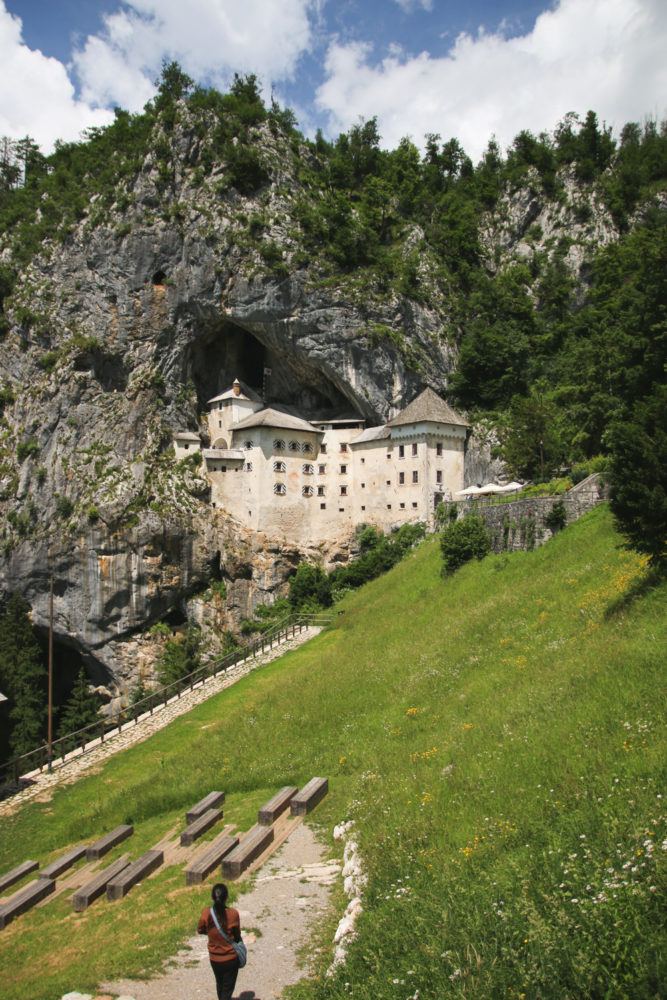
Day 9 – Predjama Castle & The Soca Valley
We headed back inland to explore more of Slovenia, and our first stop was to Predjama Castle. An old castle built into a huge cliff face and cave system. It was definitely worth a stop, and although we were unsure of whether to go inside the castle, because of mixed reviews online, we’re so glad we did (get the audio guide – it’s free)!
We then headed to somewhere I’ve been dying to visit for years! The Soca Valley. Just look at the colour of that river! We found a campsite right by the river, chilled out for a while and then went for a short walk to the Slop Kozjack waterfall, which passes right by the river. Definitely worth stopping by if you get the chance!
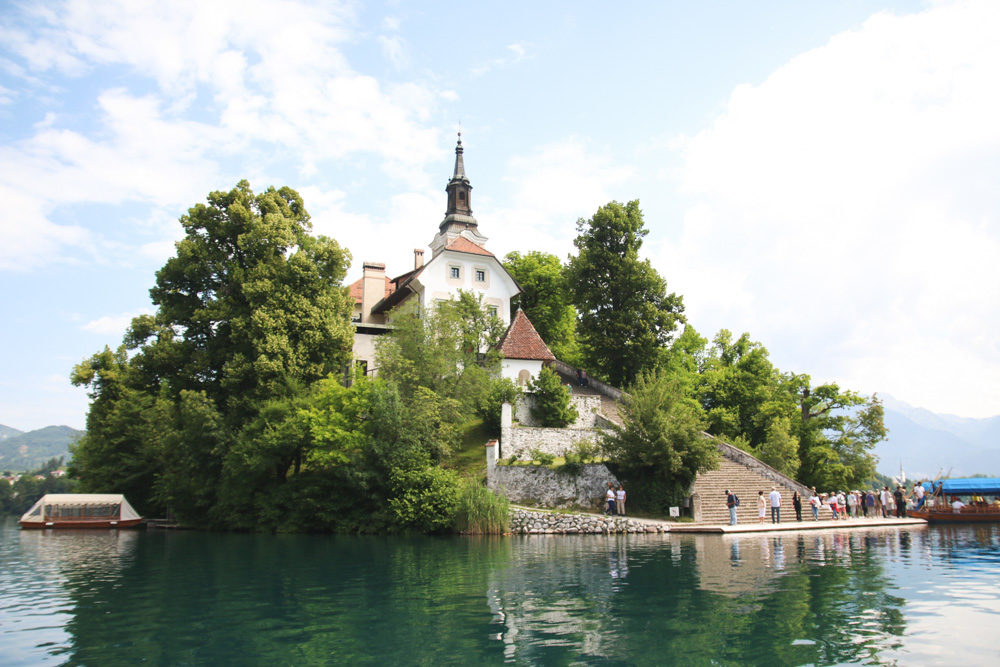
Days 10 + 11 – Lake Bled
This was the main reason we headed to Slovenia on this roadtrip! Ever since I first saw photos of the tiny island sitting in the middle of the lake, I knew we had to go there. It definitely didn’t dissapoint! We spent the afternoon walking around the lake (it’s only 6km) and taking in all of the views, before crashing for the night. It was SO hot and humid that we basically just didn’t want to move!
The next day, we hired a row boat and paddled out to the famous island. What an experience that was haha! There’s not much to do on the island, but it’s well worth a little paddle out and around it if you have time. There’s quite a bit to do at Lake Bled, so you can easily spend a couple days here.
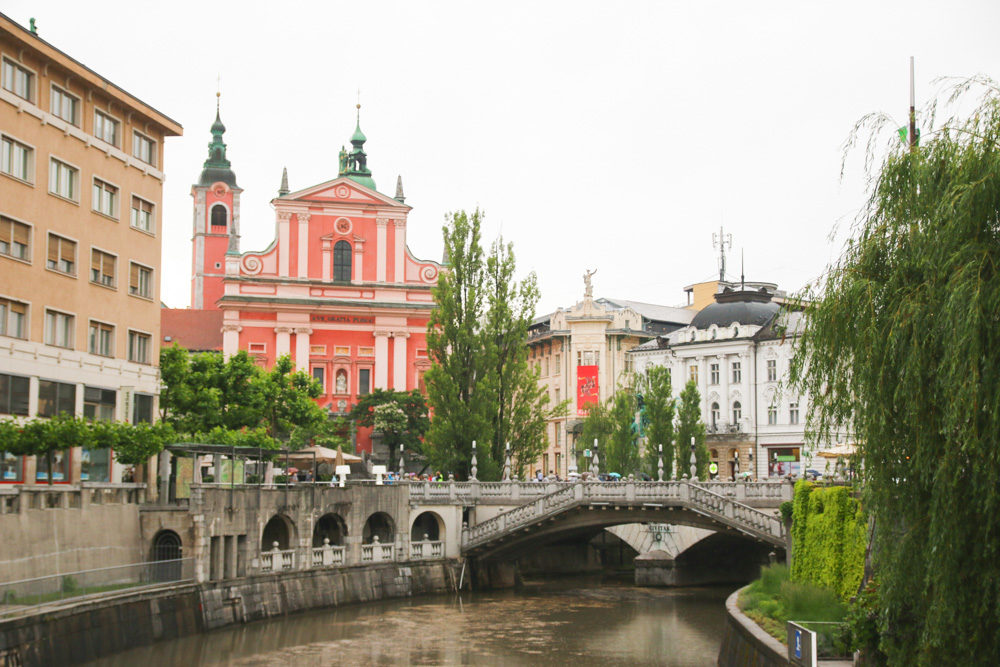
Day 11 – Ljubljana
After hiring a rowboat to paddle out to Bled Island, we hopped in the van and drove to the nearby train station to head to Slovenia’s capital, Ljubljana (pronounded Loo-blee-ah-nah). Being a city, we knew parking the van would be difficult, so we decided the best and easiest option would be to head there on the train. It only took an hour, and Shane got a nice rest from driving (he fell asleep). We arrived to torrential rain and the worst thunderstorm we’d ever seen.
It eased off after a while of hiding under the train platorms, so we headed out in search of food and sights. It’s such a lovely city to explore, and being so small, it really doesn’t feel like you’re in a city centre at all. We didn’t get to see everything we wanted though, as we found our missing cat (she was missing for just over a year), and my mum called to confirm it was her. So we cut our day there short and headed back to the van to make a start on heading home early to see her! So after this point the trip was a bit of a rush, with long, long driving days. But we would have had a few extra days exploring Austria and Germany.
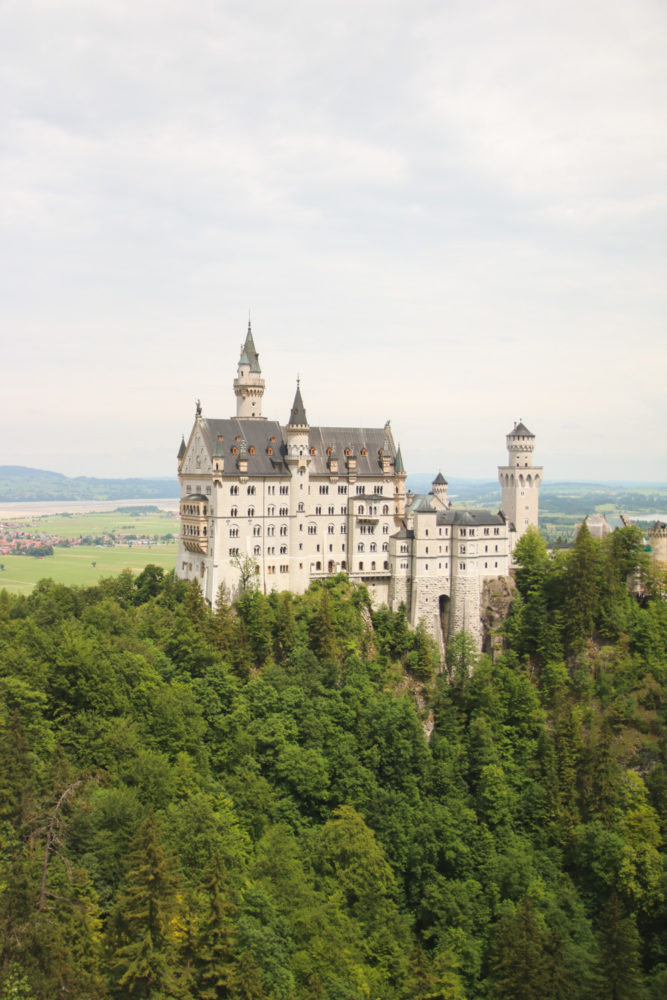
Days 12-14 – Hallstatt, Neuschwanstein + the Journey Home
So ideally, day 12 would have been us driving from Lake Bled to Hallstatt in Austria, exploring the town for a couple hours, heading up the gondola and then taking a slow drive towards a campsite near Neuschwanstein. But instead, we drove to Hallstatt, couldn’t find parking, gave up and headed towards Neuschwanstein and just chilled for the afternoon/evening.
Day 13 was spent at Neuschwanstein Castle and the nearby town of Fussen. We loved the exterior of the castle, but honestly, the inside was a letdown. Save your money and go for a hike in the woods surrounding the castle to get the best views instead, as you can access all of the surrounding area for free (you only need to pay car parking). Fussen was such a lovely little town, filled with pastel buildings! I wish we could have stayed longer, but we had a long 8hr drive back to Luxembourg that evening, ready for our drive back to Calais the next morning for our ferry that afternoon!

So, that’s our entire two week itinerary. You can read the full posts on each day for more detail. We absolutely LOVED the trip, and although we had to cut the trip short (which we were SO ok with), we wished that we had those extra few days to see more of Austria and Germany.
I created a little Google Map below, which you can open to see the trip in more detail, including details of each campsite/parkup we stayed at throughout the trip, all of the places we visited for sightseeing and the entire journey. Just open it up for more details, or you can even save it to your own maps for future reference!
We’ll be doing a full Q&A post soon, answering loads of questions about the trip, like how much it cost us, where we loved the most, which country was the most accomodating for campervans (and which wasn’t). So, if you have any questions you want us to answer, just leave us a comment below and we’ll include it in the post!
Where’s your favourite roadtrip you’ve done in your van so far?
Watch all of the Vlogs!
You Might Also Like...

Europe Roadtrip Day 6: Lake Garda to The Dolomites (Lago Di Braies)
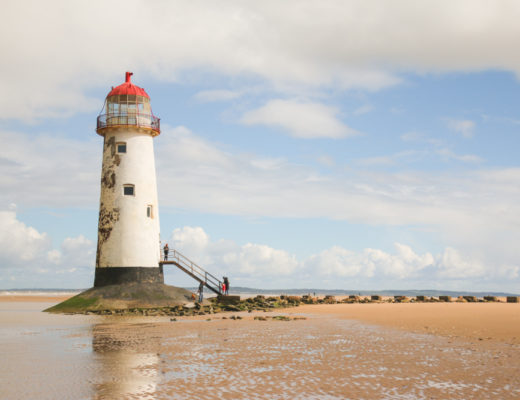
North Wales – Point of Ayr Lighthouse and Pontcysyllte Aqueduct
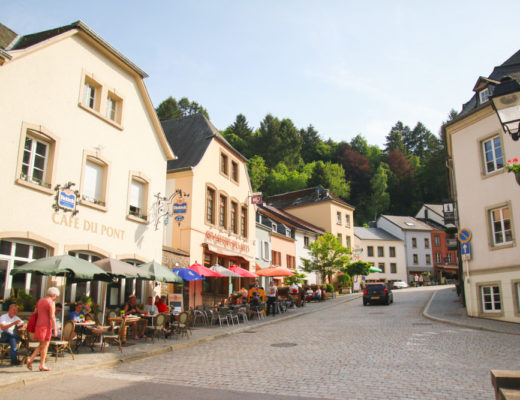
Europe Roadtrip Day 1: UK to Vianden, Luxembourg
No comments, leave a reply cancel reply.
Save my name, email, and website in this browser for the next time I comment.
This site uses Akismet to reduce spam. Learn how your comment data is processed .
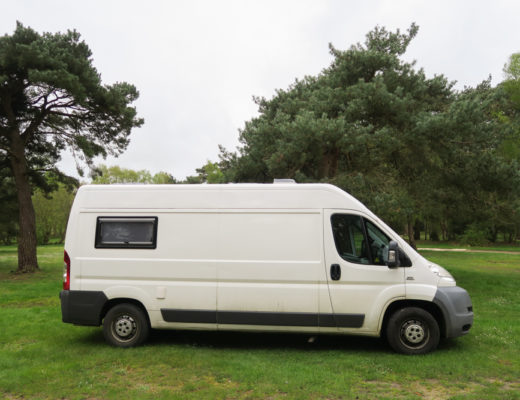
Should I build a Campervan?
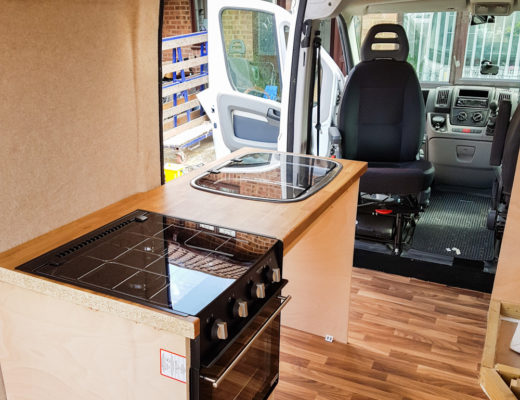
Van Conversion - Building the Kitchen
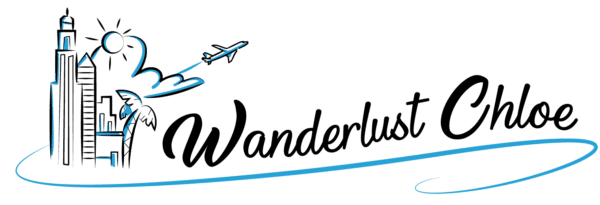
How To Plan Your First Campervan Holiday In Europe
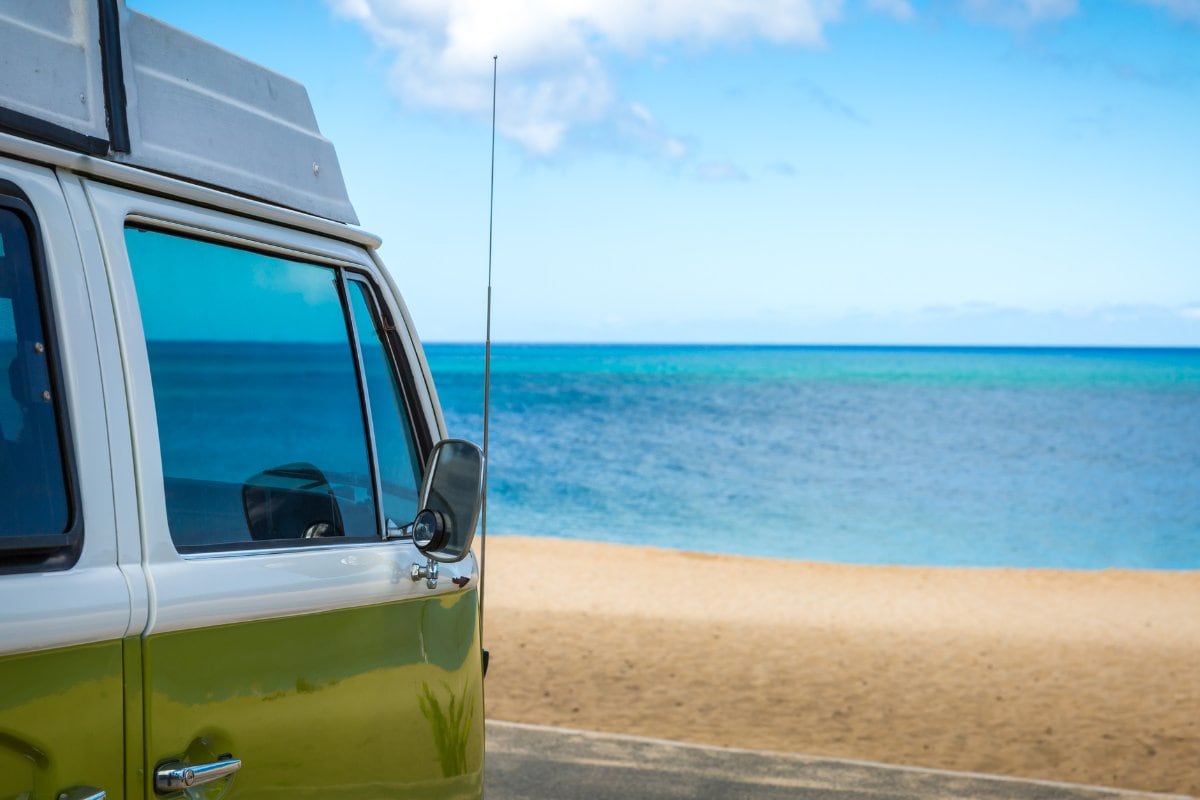
Whether you’ve dreamed of waking up to beach views, or fancy an off the beaten track adventure through the mountains, find out how to plan your first campervan holiday in Europe.
You’d have to have been living under a rock to have missed the #VanLife craze over the last five or so years. Lots of people have been trading bricks and mortar for life on wheels! While this might sound like quite a big step, there are plenty of ways to get a taste of life on the road on a short break.
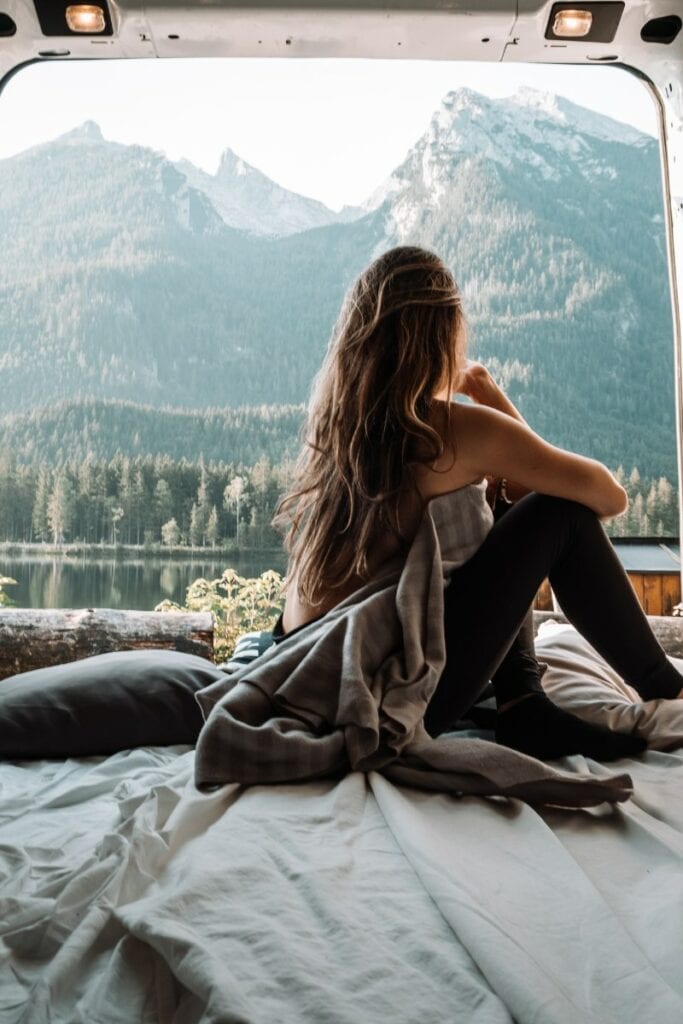
If, like me, you’re thinking about a European adventure this year, how about swapping your regular hotel or apartment stay for a campervan or motorhome? You could tour Portugal’s Algarve, stopping off at beautiful sandy beaches along the way. What about venturing off the beaten track in Albania, exploring a new country with the ultimate of freedoms. Or, how about waking up in Italy’s stunning Dolomites, with snow-capped mountains right outside your windows? The options are endless.
And don’t worry if you’ve never been keen on camping. This is a big step up. It’s a liberating style of travel, but with all the comforts and luxuries you need for a relaxing holiday!
One of the best ways to organise a bucket list adventure like this is using Yescapa . This is a specialist booking platform which connects owners of campervans and motorhomes with travellers. Just as you’d rent an apartment from an owner, now you can rent a vehicle! It’s a really simple process and many of the vehicles are really well kitted out too. We’re even talking plush motorhomes with full kitchens, warm showers and proper mattresses!
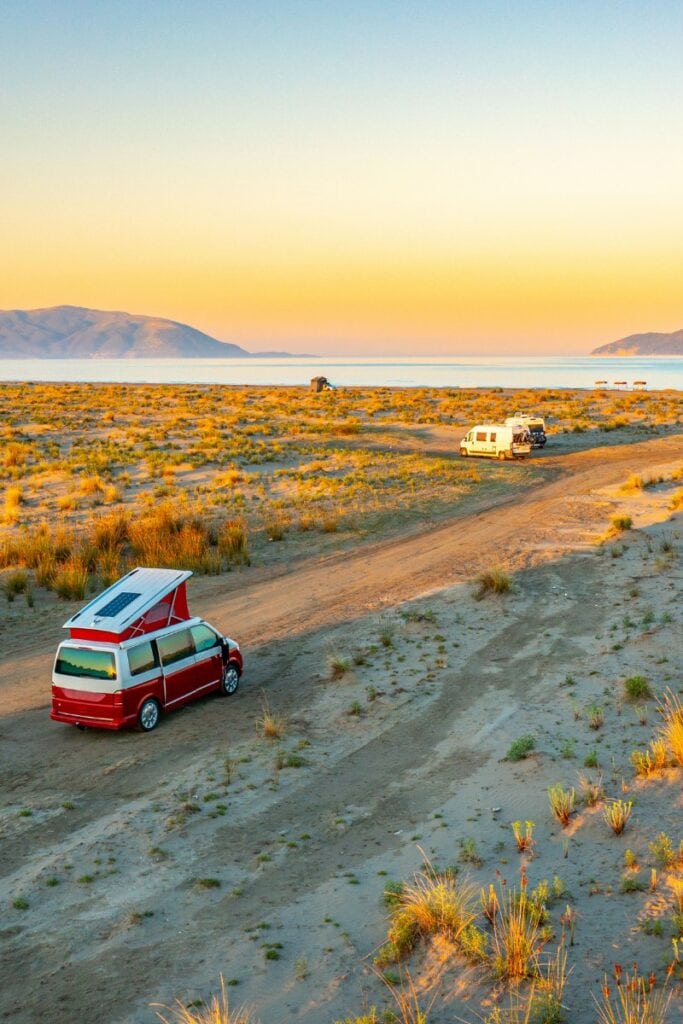
So, if you’re considering a campervan or motorhome holiday this year, it’s time to share more about how to hire a vehicle, where you could visit and how to make the most of this exciting style of travel!
Plus, as a special treat I’ve managed to organise a very special discount for you guys with Yescapa . Just use the code WANDERLUSTCHLOE30 when you checkout and you’ll get £30 off!
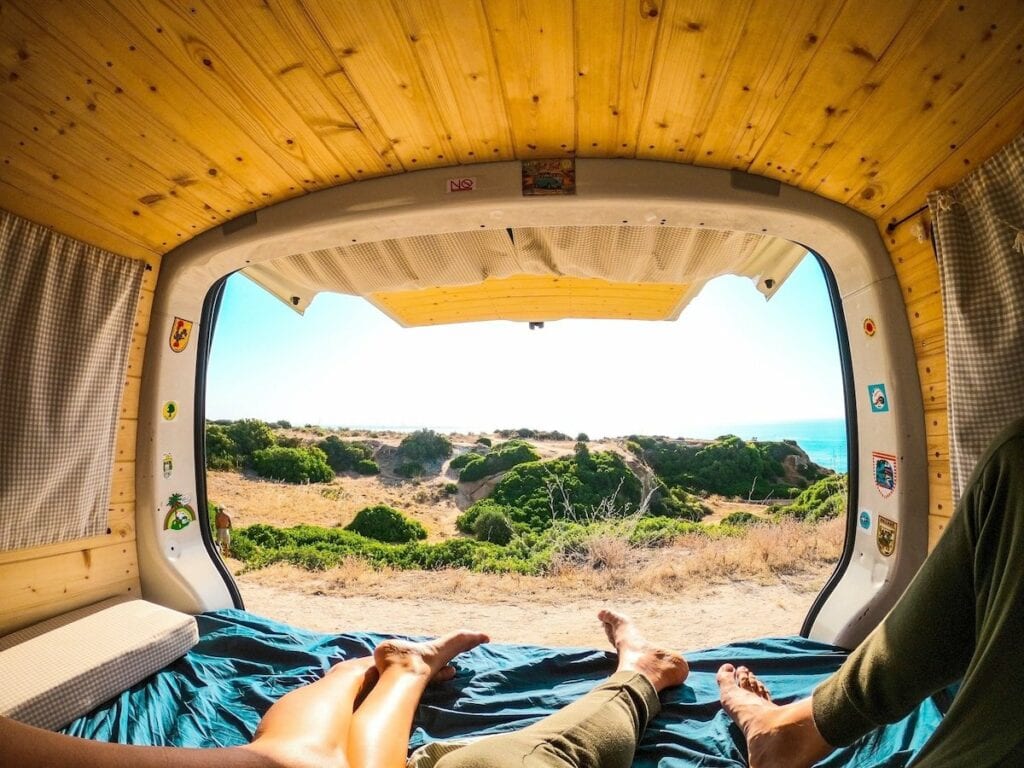
How to plan a European motorhome holiday
Why travel by motorhome.
There are so many great benefits to this unique style of travel!
You have total freedom and flexibility. Not only do you plan your own route and schedule, but you can change it at a second’s notice! Spot somewhere beautiful along your route? Stop off there. Really enjoy one place you get to? Stay an extra night or two.
Everything you need is always with you. You’ll have all your belongings in the vehicle so you never have to think about checking in and out of hotels, leaving bags, or what to take out for the day.
It’s great if you’re on a budget . You’re guaranteed to have a cheaper trip than if you booked hotels for your holiday. Plus, you can save a few pennies by swapping restaurants and cafes, for eating on the road too. Sitting down to breakfast with a view of the ocean definitely beats a hotel buffet!
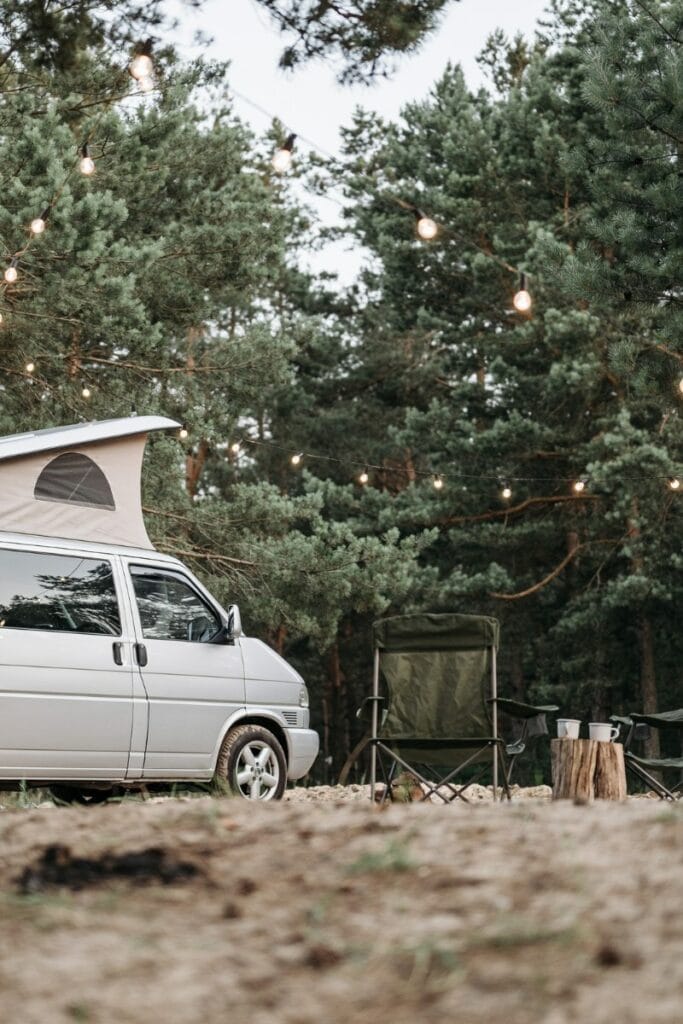
It gets you closer to the action and allows you to visit more remote places. With your own set of wheels, you’ll be free to explore secluded beaches, rugged mountains, lakes and characterful villages.
It’s a rewarding and memorable way to see the world. While any holiday will offer special memories, you’ll feel even more connected to the destination you visit if you travel around by motorhome.
We did our first motorhome holiday a few years ago and I was amazed by how comfortable the vehicle was. We had a huge double bed, en-suite bathroom, kitchen area and dining space. Driving it took a little bit of adjusting to, as we usually drive a small car. But we loved the freedom of being able to travel anywhere in it, as well as the variety of locations we could stay overnight!
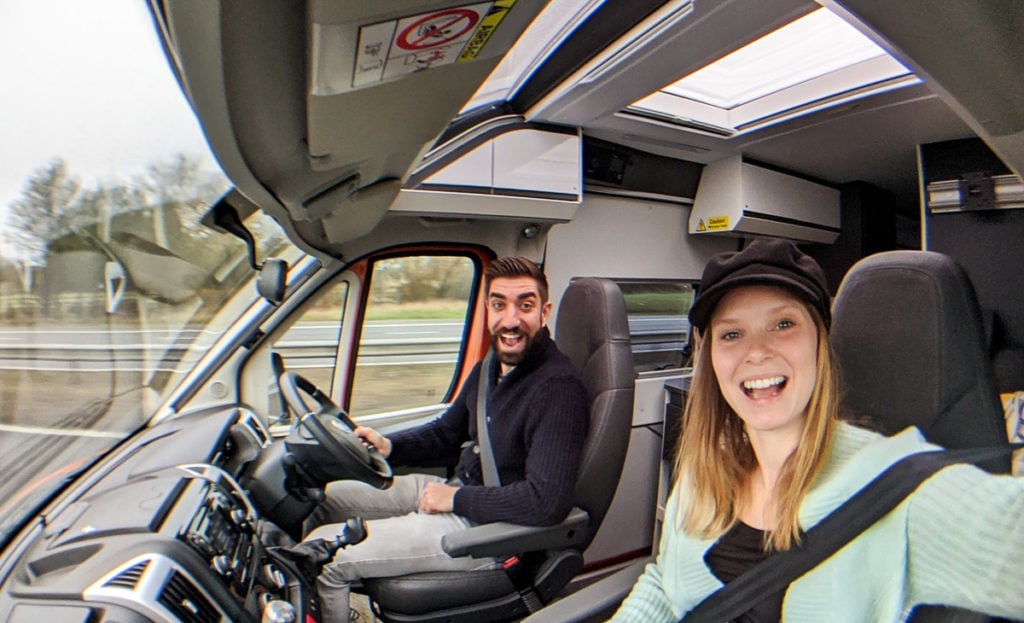
What kind of travellers would enjoy a campervan holiday?
I was debating this with a friend the other day. She’s travelled in a classic VW Camper several times, including to some UK festivals and for a surf holiday in Portugal. She’s definitely the classic campervan type: a free-spirit with a strong sense of adventure.
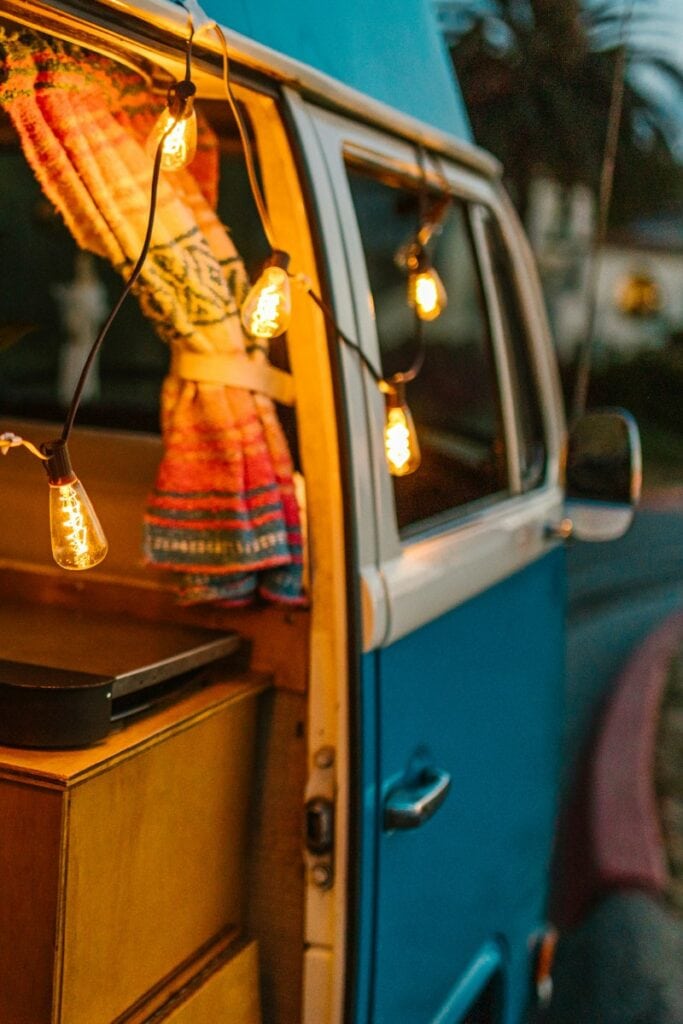
However, times have changed! Forget the 70s hippy vibes! Motorhome and campervan travel is open to all, and it doesn’t exclude! I’d say the types of travellers who would enjoy this style of travel most are:
- Travellers who love being outdoors and immersed in nature. If your favourite days out involve hiking, wildlife and picnics, you’ll love travelling by camper.
- Anyone on a budget, in particular young people and students, looking to have big experiences without a hefty price tag.
- Adventurous couples looking for a romantic way to explore the world.
- Families who want to create some memories together, while also keeping costs down.
- Anyone trying to travel in a more sustainable and eco-conscious manner.
To be honest though, with the high level of luxury available in a well kitted out motorhome, it really is a style of travel that can suit anyone! After all, Yescapa have over 15,000 motorhome and campervans to choose from in the UK and in Europe, so you’re bound to find one you love.
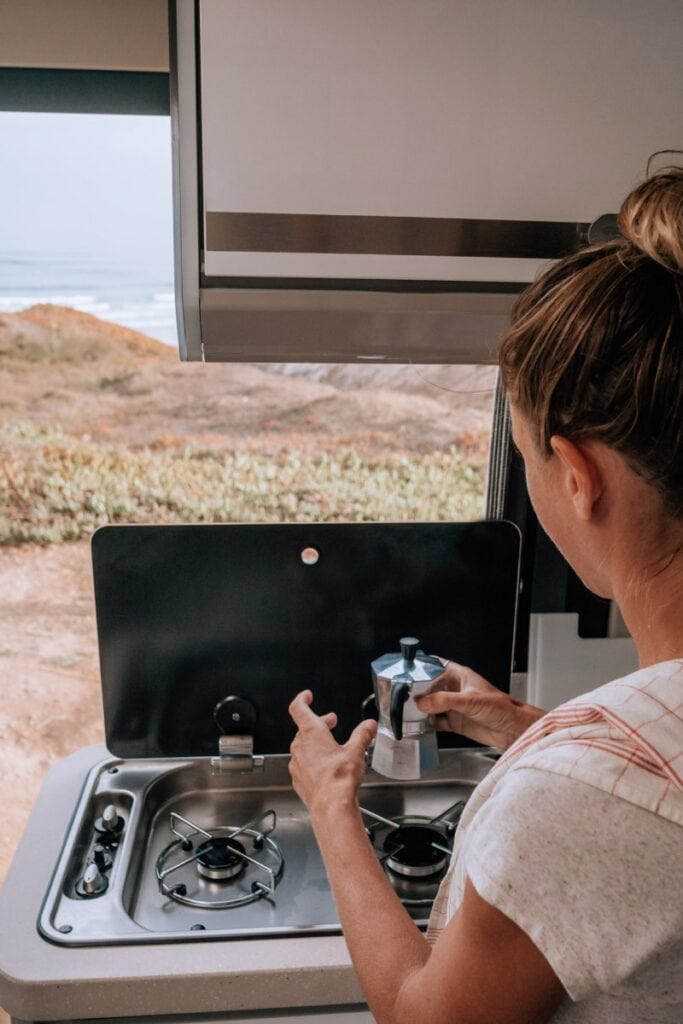
Is a campervan trip a more sustainable way to travel?
A lot of us have been looking at the impact our travels have on the environment. While years ago, we didn’t think twice about getting on flight after flight, many of us have cut down on the bigger trips in favour of smaller, more sustainably-minded adventures. Whether that’s travelling by train, staying in a destination for longer, or contributing to environmental charities, there are plenty of things we can do to improve the global situation.
If you compare a campervan trip side by side with a hotel stay, it can offer a more sustainable type of holiday for a number of reasons.
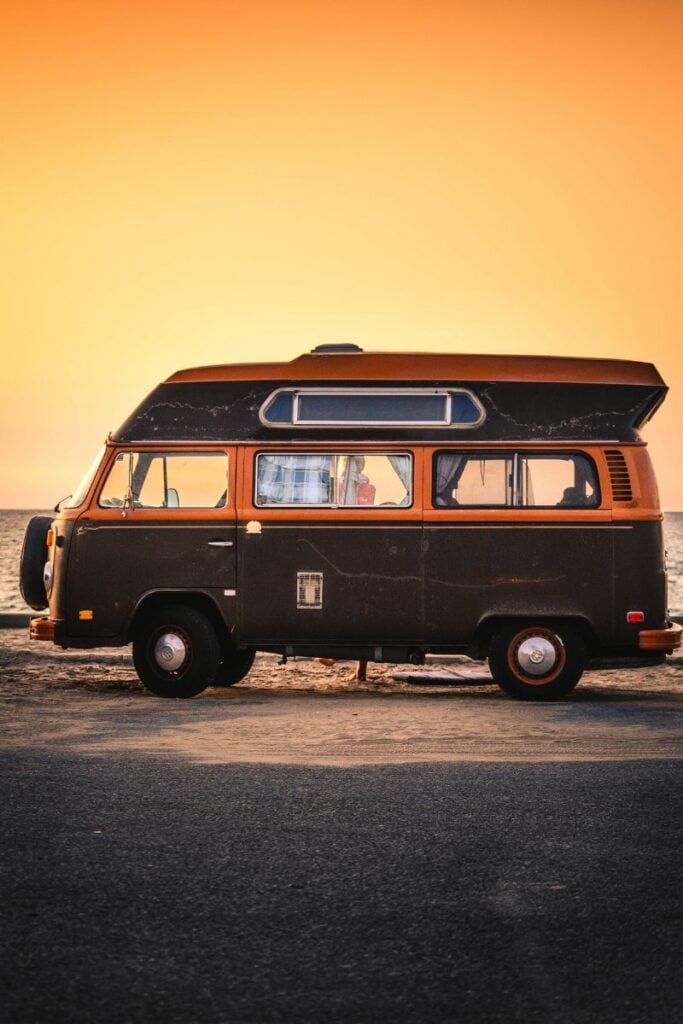
For starters, you may be reducing your campervan emissions if you decide to plan a trip closer to home, rather than flying abroad. Yescapa have plenty of vehicles for hire in the UK, so you could swap a far-flung holiday for a trip exploring the natural beauty of the Lake District or the coastlines of Devon and Cornwall. If there are several of you travelling, you’ll be sharing the emissions more too.
Once you’re on board, you’ll be using a lot less energy in a campervan than you would in a hotel or holiday apartment. Just think of a hotel’s energy costs in terms of lighting, heating etc! You’ll also be using a lot less water.
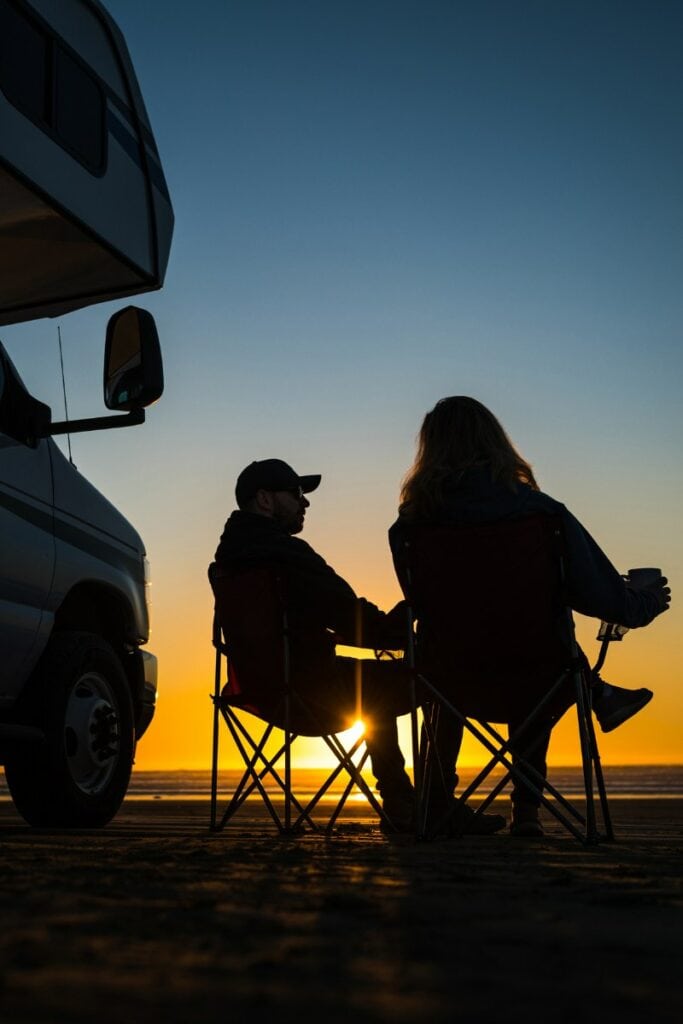
How to hire a campervan or motorhome with Yescapa
Keen to plan a trip? Definitely check out Yescapa , Europe’s largest motorhome rental marketplace. It connects vehicle owners with passionate travellers like you and me. It’s also very easy to use.
All vehicle owners are verified, you’ll have comprehensive insurance and breakdown assistance included, plus a customer service team if you need anything. If this is your first campervan holiday, you’ll definitely want this peace of mind.
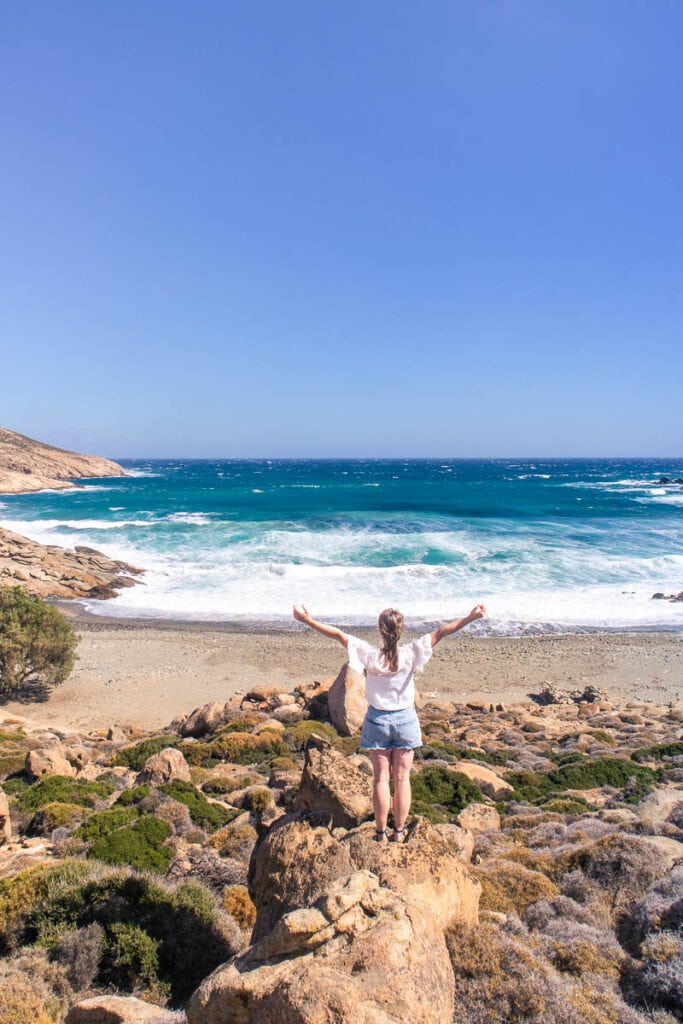
Here’s how to look at available options on Yescapa
Ready to hire a motorhome ? It’s as easy as this!
- Step 1: Pick a location
- Step 2: Put in your dates
- Step 3: Hit search
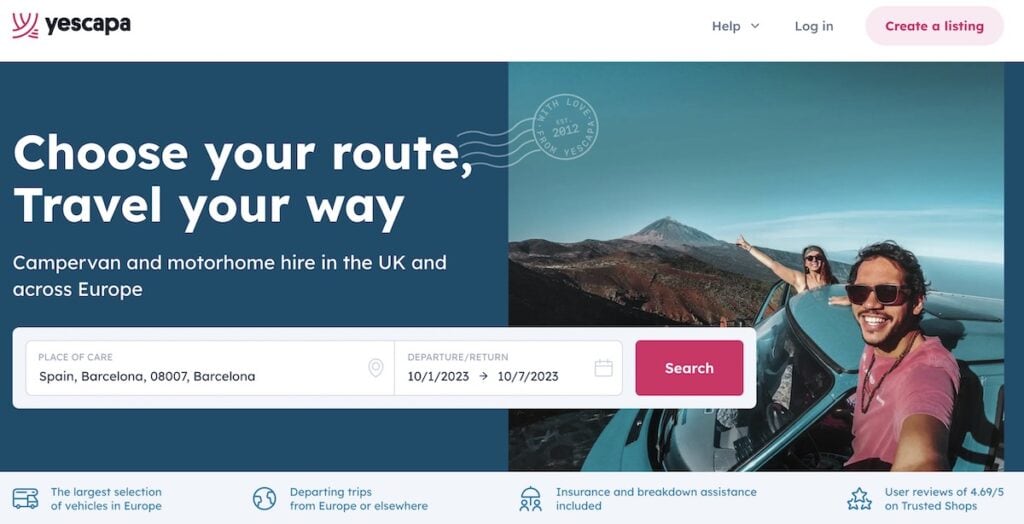
Then you’ll see a list of all available motorhomes and a map of where they’re located. You can filter by number of travellers, price and type of vehicle. There’s even an option to search for vehicles with specific equipment such as bike racks, baby seats, barbecues, or pick one that’s suitable for winter travel or is an automatic.
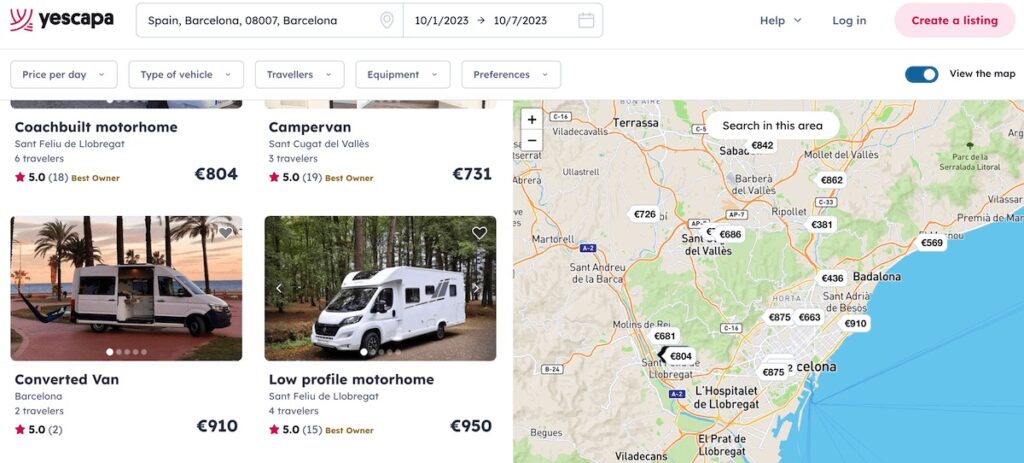
When you find one you like the look of you can look at photos, read reviews and read any extra terms and conditions. Then you can send a booking request to the owner and wait for them to reply to confirm the booking. It’s as simple as that!
With platforms like this one, there’s a really nice feeling of sharing too! Everyone wins; the vehicle owners get their costs covered and we as travellers get to book a fun and unique experience!
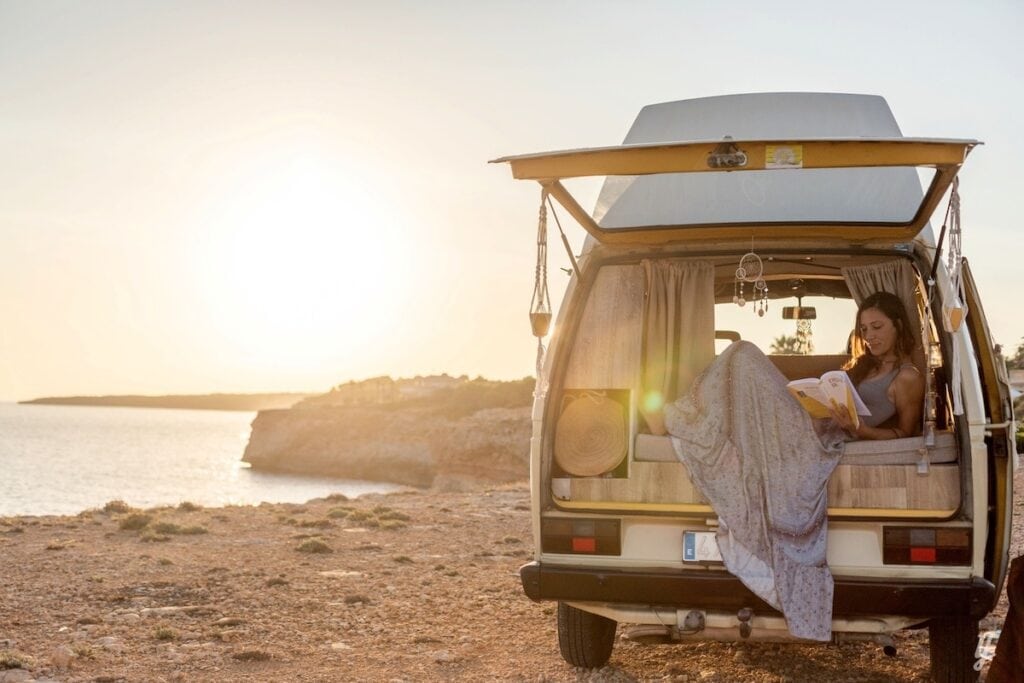
What do you need to know to drive a campervan in Europe?
While it may vary a little depending on the vehicle you’re hiring, usually you just need a standard driving license (often known as category B) which permits you to drive vehicles under 3.5 tonnes. You’ll also need to be over 18 years old. It’s worth noting that the majority of campervans and motorhomes have a manual gearbox, so your license will need to cover that, unless you’re specifically hiring an automatic.
Depending on where your license was issued, some countries may require you to have an international driving licence.
It’ll be a more comfortable ride if you have experience of driving larger vehicles, but you’ll quickly get the hang of it!
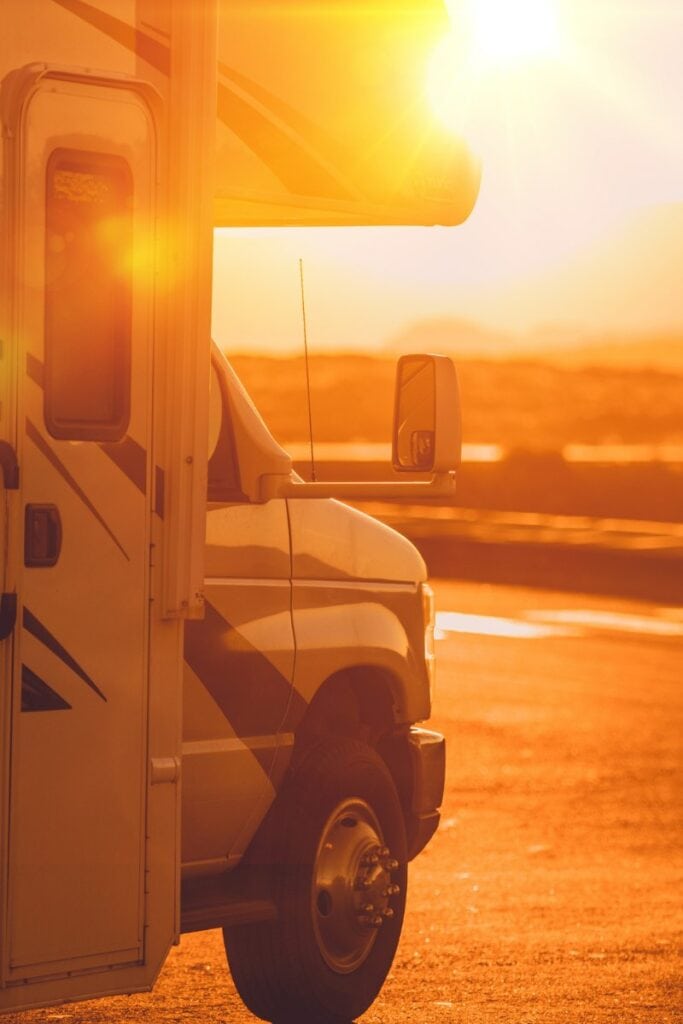
Where are the best places in Europe for a campervan trip?
Now you know how easy it is to book a trip by campervan or motorhome, it’s time for the really exciting part: deciding where to travel to! There are so many picturesque spots, but for a first trip, here are five of my top picks.
Devon and Cornwall, England
For a beautiful UK road trip, I’d recommend driving down to the southwest to enjoy great surf beaches in Croyde and Newquay, the food scene in Padstow and the wild scenery and stargazing of Dartmoor and Exmoor National Parks.
The Scottish Highlands, Scotland
Craving some mountain time? Head to the highlands and enjoy rugged landscapes, serene lakes, beautiful hiking routes and nature at its best.
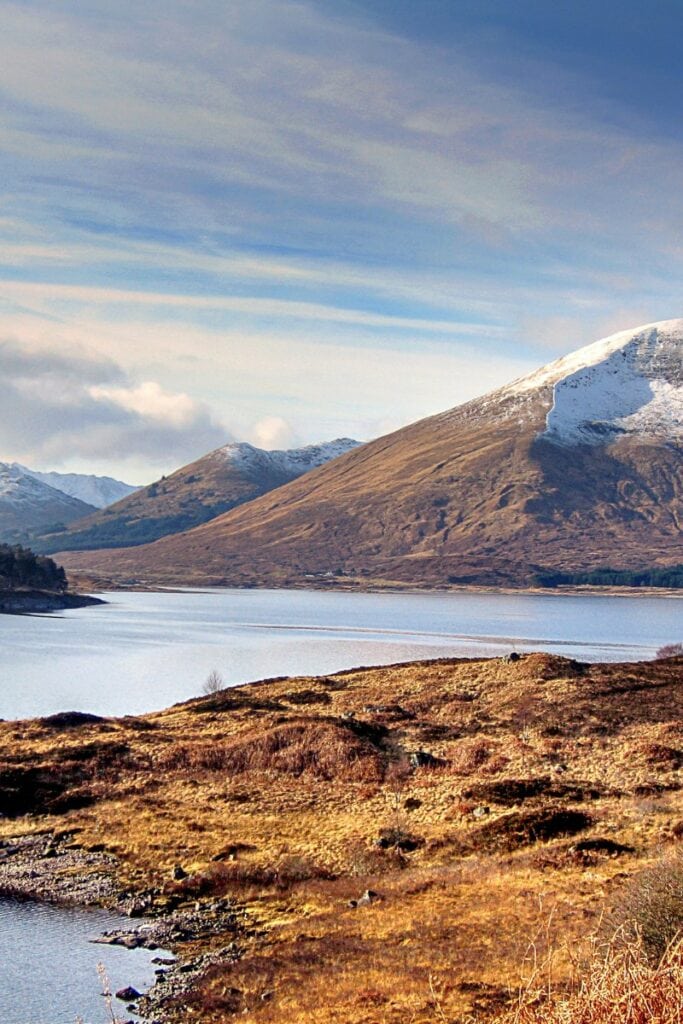
Andalucia, Spain
The south of Spain offers the ultimate mix of beaches, historic cities, classic white towns, tasty food and culture. With over 300 days of sunshine each year and some of the warmest temperatures in Europe in winter, it’s a great option all year round.
The Dolomites, Italy
You might think of Italian adventures involving the coastal towns or historic cities, but these mountains in the north offer some of the country’s most beautiful landscapes. In the summer it’s a paradise for hikers and mountain bikers. Meanwhile, in the winter it’s a great region for skiing and snowboarding.
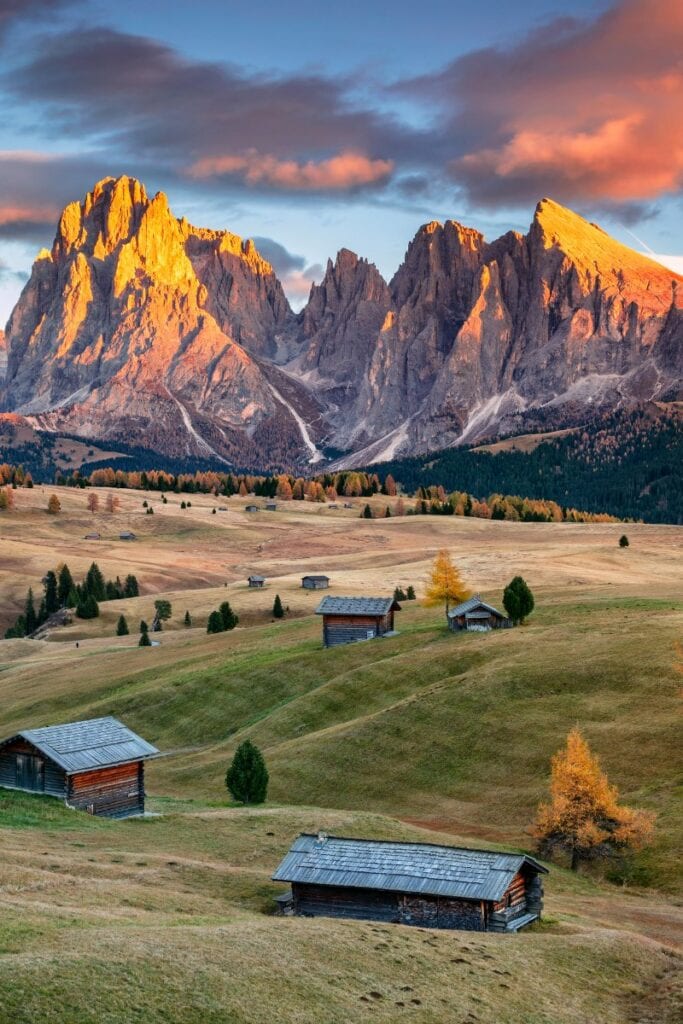
The Algarve, Portugal
This stunning region of Portuguese is famed for its amazing cliffs and beaches, pretty seaside towns and great seafood. It’s also home to some of the best surf beaches in the country.
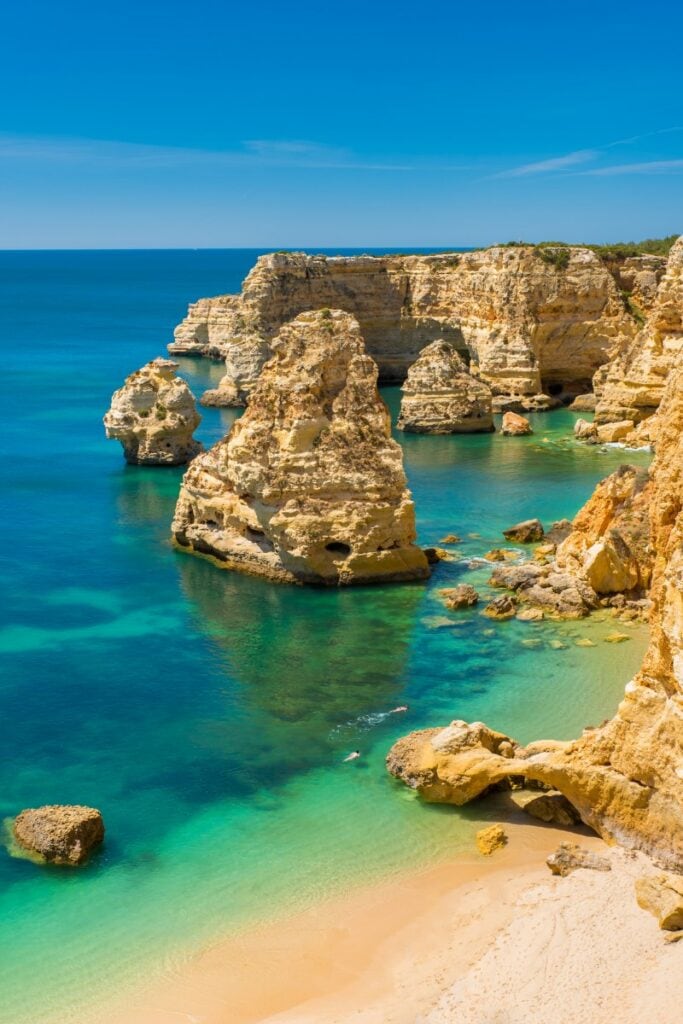
I hope this guide helps inspire you to book your first motorhome or campervan holiday! To claim your £30 Yescapa discount, just use the code WANDERLUSTCHLOE30.
It’s a unique and special type of holiday, and one you’ll never forget.
If you’re looking for more inspiring destinations to visit in Europe, check out my guide to the best hidden gems in Europe .
This post was sponsored by Yescapa but all opinions are my own.
Chloe Gunning
With a passion for food, fun and adventure, Chloe is the content creator behind one of the UK's top travel blogs Wanderlust Chloe. From volcano boarding in Nicaragua, to sailing around Sicily and eating her way around Japan, her travels have taken her to some of the coolest spots on the planet. Named Travel Influencer of the Year in 2022, Chloe regularly works with a number of tourism boards, producing inspirational travel content across multiple platforms. Find out more about Chloe here.
Leave a comment Cancel reply
How to travel Europe in a campervan, motorhome or caravan
Travelling Europe in a campervan, motorhome, RV or caravan is really one of the best ways to see and experience the continent, but the idea can be daunting at first! If you’re feeling overwhelmed and unsure where to start, don’t panic. This article contains everything you need to know to set you in the right direction. We cover everything from organizing your campervan or caravan and finding places to stay, to the practical things like wifi and finding LPG gas. Keep reading and you’ll set out on your trip of Europe in a campervan or caravan with confidence.!
This article contains affiliate links. For more information, please see our affiliate disclaimer here .
Our story of travelling Europe in a campervan AND caravan
I remember flying to Europe in 2019 to begin our campervanning journey through Europe. We had just had an incredible 5 weeks campervanning around New Zealand and had fallen in love with the freedom and practicality of having our own little home on wheels! I loved the fact that we could pick up and drive off to where ever we wanted, whenever we wanted. We could visit cities, and head to tourist attractions without tours or public transport. We could cook our own meals when we wanted and we didn’t have to lug all our belongings around every where. It was liberating for a long term traveller.
We spent some time with Bens family in the Netherlands while we organised a campervan. He was an old Italian model and we named him Luigi. Luigi was fabulous as we crossed Europe and explored Croatia, Romania and Southern Hungary for the summer with our dog, Whiskey. He felt like home. For us however, there were a couple of key things that Luigi couldn’t offer us, and after a lot of investigation, we decided to try a caravan. This decision was purely based on our circumstances at the time. I’ll explain more in the section on campervans below because don’t worry, your circumstances I’m sure, are quite different.
With our new caravan we headed back to Croatia for the winter, and saw some of Bosnia Herzegovina and Montenegro before Covid hit and we had to return to the Netherlands. The end of 2020 and 2021 has sure put a damper on our plans but we’ve managed to (safely) take the caravan around the Netherland. You can’t keep a good couple, their dog and a caravan tied down!
Well, lets begin at the beginning, with the campervan or caravan. This is an exciting stage that requires a little forethought. You’ll need to decide
- Campervan, motorhome or caravan? Which should you choose?
- Buy or rent: Do you want to buy or hire your campervan, motorhome or caravan?
Motorhome, campervan or caravan – What’s the differences?
What is the difference between a motorhome or a camper van in Europe , I hear you ask? Truth be told, they are different, but you’ll often hear the words used interchangeably. I wouldn’t get too caught up in the wording, except that you’ll need to be quite clear about whether you want a motorhome or camper van when you begin looking to buy or rent yours.
General features of motorhomes, campervans and caravans
- Sleeping area – this will either be a permanent bed, or it will be a seating area that converts to a bed at night. Sometimes your vehicle will have both depending on the size.
- Kitchen facilities – The kitchen can be anything from a small sink and single burner cook top to a larger area with an oven, bench space and a decent sized fridge
- A dining area – A table and some seating
- Toilet – Unless you have a particularly small campervan, it will usually have a portable toilet as a minimum. Larger campervans, motorhomes and caravans will have a properly fitted toilet
- Shower – Large models will have space for a shower
- Storage areas – Excess space will be used to house storage areas in which to store your belongings.
Let’s quickly break down the differences between motorhomes campers and caravans and how they relate to the features you’ll have.
By definition, a motorhome is a larger vehicle that contains a sleeping area and storage space, built into larger van style bodies, trucks or buses. They look quite a bit bigger than say, the easily recognizable VW camper. There are positives and negatives to having such a larger vehicle.
Advantages to a motorhome are related to the size and comfort level of having so much space. The bed is a permanent fixture so you don’t have to put it together every night like you would a convertible seating area. Kitchens in motorhomes are often larger, containing an oven and fridge and adequate bench space for cooking.
There will be a larger, and probably more comfortable lounge and dining area with a fixed table and most likely a bathroom with a fixed toilet and shower facilities. It is also more common for motorhomes to have heating and air conditioning. Newer models may also have floor heating, which is useful if you’re travelling in winter. Nothing is worse than cold feet!
Disadvantages to campervanning Europe in a motorhome funnily enough are also related to the size. The larger your motorhome the more difficult it can be to maneuver through small streets. This can be avoided by sticking to main roads. You may still, however have some issues with parking at camping spots as some do not have spaces large enough for very big motorhomes. Standard sized motorhomes shouldn’t have a problem though.
The other issue with motorhomes comes if you want to visit cities. Especially some of the old cities of Europe. You’ll have a hard time parking anywhere. This can be negated by taking bicycles with you, or towing motorbikes on a trailer behind you. Of course, if you’re staying out of the cities then that solves that problem all together.
If you’re thinking a motorhome sounds like something you’re interested in, don’t be discouraged by the issues, there are thousands of people who get by just fine. Just know that you’ll need to do a little extra planning.
As mentioned, many people these days use the terms motorhome and campervan interchangeably, however by definition, a campervan, also known as a camper van, or camper, is essentially a van that has been fitted out in a more conventional van size.
Advantages of travelling Europe in a campervan include the fact that it is smaller, so it is easier to drive. They handle and move more like a big car. Of course there are variations in the size of campers. The smaller they are, the more true the above is. Parking is also much easier in a smaller campervan, both in cities, at tourist sites and at camping places in most countries.
Disadvantages depend on the overall size, they may have a permanent bed, or seating that needs to be converted. The kitchen is often smaller, with a smaller fridge and limited bench space. Seating and table space will also shrink as the size of the campervan gets smaller.
These are not necessarily all bad things, just make sure you choose an option that suits your needs. If you cook for example, a kitchen with a larger kitchen but smaller seating area may be preferred to a larger seating area with a smaller kitchen. The campervan layout is the most important thing.
I don’t think it needs to be explained that a caravan doesn’t have an engine. It needs to be pulled by another vehicle. The advantages and disadvantages of a caravan are the same as those for motorhomes and camper vans in relation to size. The bigger the caravan the more space and the larger the facilities and storage. The smaller the caravan, the easier it is to tow and the less space you’ll find inside.
The main advantage to a caravan over a campervan or motorhome is that you now also have a separate vehicle. You don’t have to pack everything up every time you want to go somewhere, you just lock up the caravan and drive away. You’ll also never have a problem with parking, unless of course you’re dealing with normal city traffic.
If you’re trying to decide between buying a motorhome or a caravan, we’ve had both and have written a complete comparison article to help you choose what’s right for you.
Which is better – campervan, motorhome or caravan for travelling Europe?
This is quite a personal question and I would encourage you to think about the following things
- How long do you intend to travel?
- How confident are you driving a large vehicle or towing?
- What is your daily/weekly/monthly budget?
- Do you want to stay at caravan parks or in the middle of the forest?
- How much space do you need?
- Are you able to buy a caravan and a car in Europe?
- What kind of places do you plan on spending most of your time? For example old European cities, or out in nature?
The reason we swapped our campervan for a caravan
Our campervan to caravan journey was actually a three step process. In New Zealand we had a small camper. We then upgraded to a larger campervan for Europe. Then we decided on a caravan. Our reasons were the answers to the above questions.
We intend to travel long term. For us that means that we want to be comfortable as it is an ongoing situation. We personally had two problems with Luigi, our large campervan. The first, was that we love old cities, and we sometimes had a hard time driving around and parking him. Others get around this issue by taking bicycles or motorcycles. They leave the campervan somewhere and they bicycle to the attraction, or to the supermarket even. This wasn’t an option for us as our dog Whiskey was old at the time when we switched to the caravan. He has since passed.
Based on our needs we felt a car would be useful for us.
We also needed more space and obviously getting an even larger motorhome wasn’t on the cards for the reasons above. If however, you’re travelling for a month or two, or without a dog, then less space is perfectly manageable. We had no issue in New Zealand with our smaller camper for 5 weeks.
Many, many people travel Europe in a campervan with no issues at all and we were very sad to see Luigi go. Just know, however, that a caravan is a genuine option.
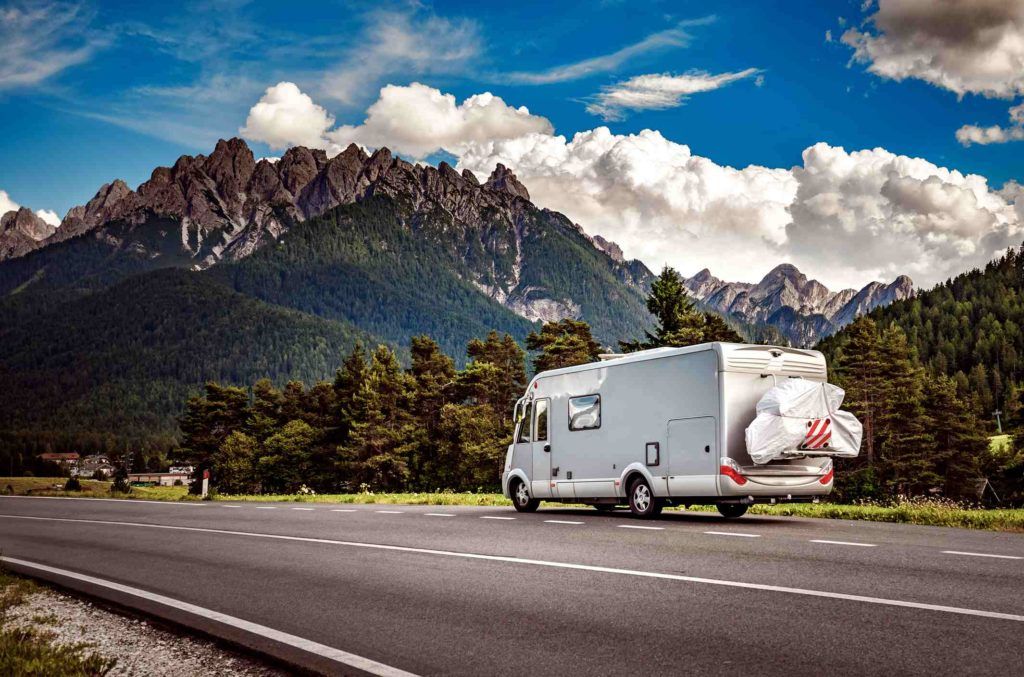
Campervan layouts – some things to consider
Before you begin looking at campers or motorhomes to hire or purchase, it helps to have a bit of an idea about the layouts and what is best for you.
The sleeping situation
Campervan beds can either be fixed beds, or seating that can be made into beds in the evening. Not only that, they can also be high with a ladder, like a bunk bed. For example the bed may be on top of the drivers compartment, as in the photo below. That window is where the bed is.
If you’re young and agile then climbing the ladder into bed is not so difficult. However if you’re not…
The size of the beds is also important. Ben is a big guy. Not only that, he overheats at night. Our beds in Luigi were too narrow for us both to comfortably sleep. Our campervan had a second ‘bunk style’ bed at the back and I slept in that one. When we decided to sell Luigi, we knew that we wanted a bigger bed that we could share.
Cooking in a campervan
So, I cook. I like cooking, we eat pretty healthily, it’s important to me. When we campervanned around New Zealand, our campervan fridge was so small we had to shop every second day. Luigi had a bigger fridge but it still wasn’t ideal. When we upgraded to the caravan, a big fridge was a must.
Cooking in a big campervan or motorhome is much easier than cooking in a small one. That doesn’t mean though, that cooking in a small campervan is impossible. You find your own tips and tricks and ways of making it work. You will however have to get used to going back to basics, as in a smaller campervan there is not a lot of room for a variety of pots and pans and certainly none for different kitchen equipment and things like blenders or slow cookers. Even if you had the bench space, you won’t have anywhere to store them.
Privacy.. what’s privacy?
The smaller your campervan the less privacy you’ll have. Conversely, the larger your campervan or motorhome, the more privacy you’ll be able to niche out. If you’re travelling with friends, go bigger.
In a very small campervan you won’t have any room division. If you have a toilet, it will most likely be a cassette toilet, which is like a small box that has a hole with a seat around it. With no division of the room, peeing becomes a pretty public act.
The larger you go in size, the more likely it is that you’ll have a separate ‘toilet’ room. So that’s something. You may also have a door or divider that breaks the camper into smaller sections. Our caravan now, for example, has the main living space, then a sliding door that closes off the bedroom and bathroom together.
Heating and air conditioning – yes!
If you’re travelling Europe in the shoulder seasons than maybe you can get away without heating or air conditioning, but in the height of either winter or summer, you’re going to want them, trust me.
We were in Croatia in the height of summer with our air conditioning free campervan. There was literally a night that all 3 of us (including our dog Whiskey) slept outside because it was so, so hot. 2 days later we left Croatia for Romania which is a few degree’s cooler during the day, but much cooler overnight.
Our caravan now has both good heading and good electricity. Having done two winters in the caravan I’m confident saying that you won’t survive a European winter without heating.
After campervanning around New Zealand we wrote an article on things to consider when choosing a campervan , have a read and it’ll help you to think about layouts and facilities that are important to you
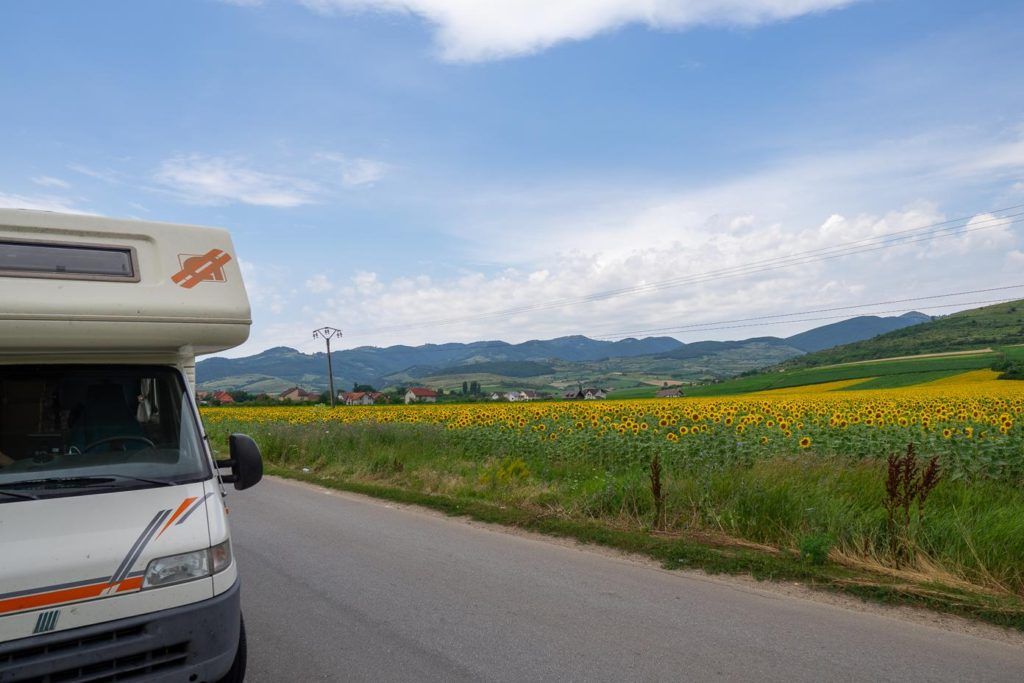
Buying or renting a campervan, motorhome or caravan in Europe
Hiring a campervan in europe.
Advantages of hiring or renting a campervan to travel Europe
- Quick and efficient, faster and easier than buying
- Everything is taken care of for you
- Easily available to non EU citizens
- Comes (almost) fully stocked
- A great way to try different models ‘before you buy’
- If you breakdown or have an accident the company will help you
- More convenient for a short trip
- Renting a more luxury model for a shorter time is cheaper than buying a brand new luxury motorhome
Disadvantages of hiring or renting a camper or motorhome
- The primary disadvantage is the price as it will be more expensive in the long term.
Expert tip : We always use Motorhome Republic to hire our campervans. It’s a great platform listing all the companies and their available vehicles so you can compare and find the perfect motorhome for you.
Buying a campervan in Europe
If you’re a European citizen you should have no problem buying a campervan or caravan in Europe. We’d recommend doing your research and possibly hiring a campervan for a smaller trip before you commit to purchasing one, just so you can really test it out. You may find something is important to you, when you hadn’t thought about it previously.
If you’re not an EU or UK citizen, it can be more difficult to buy a camper van as you’ll need a fixed address somewhere in the EU or UK in order to have the vehicle registered and insured. The good news is that there are ways to do it and we’ve met people on the road who successfully managed it.
I have to confess we’ve never had a problem buying our campervan or caravan in Europe as Ben is from the Netherlands. Obviously then, I haven’t had to use any of these services. I’ve done my best to research this section for you and point you in the right direction but I can’t make any personal recommendations as we haven’t done it or dealt with any companies relating to this.
For a complete guide to buying a motorhome in Europe as a non resident , you can check out our complete guide.
3 ways to buy a campervan in Europe for non-EU or UK residents
- Purchase your campervan in the UK using a relative or friends address.
Apparently the UK is the most relaxed country in Europe when it comes to registering vehicles for non-UK residents. You will need a UK address, however this can be a friend or family member. If you buy a camper direct from a dealer, you may be able to use their address for the registration of the vehicle.
Be aware that if you buy a vehicle in the UK it will be a right hand drive. This is different to the rest of Europe who drive on the left hand side. It’s not only the steering wheel that is different. The door to the campervan or motorhome will also be ‘on the wrong side’. If you stop your right-hand drive car on the side of the road in mainland Europe, you’ll likely be stepping straight out into traffic.
2. Buy your camper in the Netherlands or Germany
Campervanning and motorhoming are HUGE in the Netherlands and Germany, as it is in most of Europe. Both countries have businesses that will act as ‘middle people’ in the sale process. Some of the businesses will sell their own campers. Other businesses operate a sort of ‘fixer’ type situation. If you find a campervan online that you like, for a fee, they’ll go and inspect it for you. They’ll help to handle the sale transaction, the registration and insurance. Of course you pay for all of their services.
3. Buying a campervan in France.
Euro Camping Cars in France have established a unique and perfectly legal system for helping non-Europe residents buy a campervan or motorhome in France. Again, I haven’t done it, but it is legal, and many people have had great success. Their website explains everything you need to know about their services.
Consider looking for companies with buy back schemes
You’ve found a way to legally buy your campervan or motorhome in Europe as a non-resident. You’ve travelled around and loved every minute of your road trip. Now what? What do you do with your camper when it’s time to go home?
Firstly, you will need to sell your camper in the same country from which you purchased it. This will save you a lot of hassle. Secondly, how do you sell it quickly and easily so that you’re not sitting for another few months waiting to get your money back?
A buy back scheme is a great option. It simply guarantees that the place where you purchased your campervan, will buy it back from you at the end. They will obviously pay a reduced price. The longer you drove it, the more kilometers you did, the less money you will likely get back.
In which country should you hire or buy your campervan?
If you intend on buying, then obviously you’ll be restricted to the options and countries in the section above.
When you hire a campervan you’ll have plenty of options and can essentially hire a campervan to be picked up in any country. Consider your road trip itinerary before you make any decisions. You’ll want to know where you intent to start your trip. Also be aware that in most instances, you’ll need to return your camper van to the place where you picked it up. This means your trip will need to be a loop, or a general shape with a last minute dash for the starting place.
Insurance is necessary to travel Europe in a campervan
Insurance is mandatory in all European countries, and it’s the best thing you can pay for and not need. When you hire you campervan you can be assured that the company will offer you proper insurance for the vehicle.
One thing to take note of are the countries that are covered under your insurance. If you get your insurance in a Schengen country, the Schengen area is covered. However not all non-Schengen countries are covered under every policy. You’re best to confirm this when you get insurance otherwise your insurance card will tell you. Most western European countries use insurance cards that look like a credit card with your details on it and these will be valid in all countries except the ones that have a little x through them on the card.
If you try to enter a country outside of the Schengen area that is not covered by your insurance, you’ll simply need to ‘buy’ insurance at the border.
Be mindful that a little dent in a campervan, however unlikely, can quickly result in a very high repair bill. Be sure that you either buy the insurance excess, pay the excess upfront or you have coverage through your travel insurance to avoid huge issues in case of an accident.
Road side assistance
If you’re hiring your campervan, your hire company will usually assist you with any issues such as breakdown or accidents. If however, you have purchased your campervan and it’s insurance, you’ll usually deal with the insurer for damage and road side assistance if you break down. And trust me, road side assistance is helpful.
When we hit an enormous pothole in Romania and Luigi (our campervan) totally shut down on the side of the road, we were grateful for the road side assistance who found the nearest garage for us and organised someone to come and help. When they couldn’t fix him, they loaded Luigi onto the back of a flat bed truck, with us and our dog Whiskey still sitting inside! It was a slightly nerve wracking drive as we swayed and bounced our way into the nearest city on the back of the flatbed truck. An hour after that we were on our way again. Everything was handled by road side assistance.
Make sure you have refillable gas bottles, and enough of them, to get you through a decent period of time. Gas can be difficult to find, especially in some countries, so don’t let your bottles get completely empty before refilling them. If you have a lot of your items running on gas it’ll obviously go faster.
In the summer months, we only use gas for cooking and for our fridge while driving. A bottle can easily last us a few months. However our heating in the caravan runs on gas. Last winter, we sat for a week in -14 degrees. We obviously had the heating on the whole time and a gas bottle would last us 3-4 days! We would change it every 3 and run a full one overnight so we knew that it wouldn’t run out while we were sleeping. In the morning we’d reconnect the almost empty one to use the last of the gas when we were awake and could notice the heating was off.
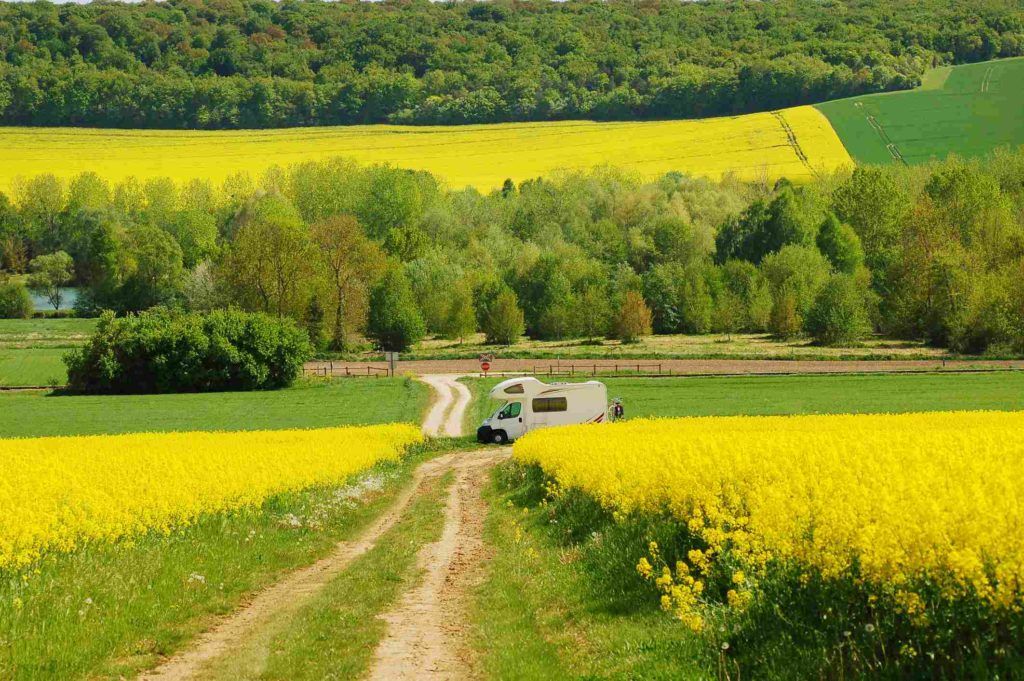
Gadgets and helpful items for Campervanning in Europe
Having a good navigation system is really helpful in getting around. It’ll save you a lot of time and effort in doubling back and getting lost. Not only that, the larger your campervan or motorhome, the more helpful a sat-nav can be. Get one where you can enter the dimensions of your campervan and it will (for the most part) avoid sending you down narrow one way streets.
Of course you’ll still need to use your own judgement and common sense. Look out for sign posts and information and change your direction early if you think you’re heading somewhere where you’re not going to fit!
12V USB Port Adapter
You’ll need to be able to charge your phone and/or sat-nav while driving. This adapter goes in the old cigarette lighter hole and will keep everything charged while you’re navigating. There’s nothing worse than running out of battery half an hour before you’re supposed to arrive at a new destination.
An inverter
If you have electronic devices such as laptops and camera’s you’re going to want an inverter. An inverter takes the energy from the campervans engine and converts it to electricity you can use to power your devices. You’ll especially need this if you want to stay off the grid and wild camp.
Motorhome, campervan or caravan awning
An awning is really useful on a nice day to protect you from the hot sun. Many campervans will come with a built in awning that you roll out. If you hire a campervan it may come as an add on that you’ll need to rent separately. When we bought our caravan there was no awning, so we simply purchased one that slides onto the caravan and can stay there permanently.
A water filter
We had travelled for quite a while without a water filter and it didn’t seem to bother us until we spent a few weeks in Istria, Croatia, and the water tasted horrendous. We have refillable water bottles we take everywhere, rather than buying plastic, and we were really having a hard time drinking the water there. At the time, as a quick solution we bought a cheap small filter which helped… enough.
Bicycles come in handy when you’re campervanning in Europe. It’s much easier to jump on a bicycle and cycle to the shops than it is to pack up the whole camper or motorhome and go. Bicycles are also a great way to get into a city or a green zone. You can park the campervan somewhere safe and easy and ride the bike in. It’s really common to see motorhomes with bicycles on the back for this reason.
The Gross Vehicle Weight of your motorhome or campervan
Aside from the dimensions of your camper, you’ll want to take note of the gross weight of the campervan or motorhome. It will have a maximum weight that you’re allowed to carry. The more ‘stuff’ you load in, the heavier you’ll be. When you’re working out what to pack, try to remember that just because you have some space doesn’t mean you should fill it. Leave some space so you can collect things as you go.
Essential Apps to download to your phone
Apps to find camping places.
Park4Night ( park4night.com ) an app that is fantastic for helping you find free overnight parking near you.
Apps to make life more enjoyable on a road trip
- The Kindle App will allow you to download books so that you’re not having to try and buy them as you travel
- Borrowbox is an app that is used by some libraries, it allows you to borrow E-books for free
- Audible – You pay for books you download on audible but you own them
- Spotify – It’s worth the small monthly investment to have some good road trip music
Connectivity and WIFI throughout Europe
Let’s face it, life is a lot easier if you have internet. Especially when you’re heading into new countries and unknown territory. It’s also helpful if you want to keep in touch with loved ones. I remember solo backpacking in Cambodia and my dad freaking out because I wasn’t replying to his text messages. I was at Angkor Wat at the time and 1000 year old temples don’t often have WIFI. Needless to say, I bought a sim card the next day.
If you stay at camp grounds they will often have internet although how good it is will vary considerably. If you need good internet, I’d recommend getting a dongle and using pay as you go rechargeable data like this. Three is a fantastic company with good reception throughout a lot of Europe.
Campervan and motorhome security – How to keep your belongings safe
Generally speaking, I would say that when you’re travelling in Europe, your at no greater risk for theft or a break in than you are in your home country. That being said, we’ve never had any problems and maybe someone who has experienced a break in might disagree. As everything you presumably want and need is inside the campervan, it’s understandable to be worried.
I was never really worried in camping places, but I was more concerned when we had to park the campervan in an isolated place. This happens say, when you’re going hiking and you drive to a remote car park, or, it happens when you want to see an old city and you can’t get parking so you end up parking down some random backstreet. It’s the only place you’ll fit.
There’s different strategies and tips, and everyone’s opinion differs. Some say leave all your blinds open so everyone can see if someone is in there. Others say leave them closed so the potential robber can’t see whether YOU’RE in there or not.
At the end of the day, I always carry our most valuable items on me. Passports, laptop, camera, phones etc, all go in my day bag if we leave the campervan in a remote place.
The other option is to purchase additional door and window locks.
Driving in Europe
Driving is different in Europe in that you’ll be driving on the right hand side of the road. Other than that, it’s not that dissimilar to driving in countries like America and Australia.
In western Europe in particular, the roads are pretty good and you shouldn’t have any issues, however the further east you move, the worse the roads become, I think I mentioned the pothole in Romania that stopped our camper in it’s tracks.
Do you need an international driving permit?
Anyone who’s drivers license has been issues outside of Europe should get an international driving permit . Although it’s not mandatory in all European countries, some countries do require it, alongside your normal drivers license.
Green Zones
Green zones are environmental zones, usually in cities, that restrict entrance to cars that do not meet emission requirements. Some places ban diesel vehicles all together, others may allow you to drive there provided you have received a green sticker indicating you’ve past an inspection. The reality is that if you’re in a large diesel motorhome, you’re probably not allowed in the green zone, and even if you were, you’d never be able to park in there.
As a general rule, avoid green zones, or park the camper somewhere safe and ride a bicycle or take public transport into the city if you want to go.
Petrol/Gas stations
By far the most expensive place to buy fuel is along the highways. If you need to fill up, go a little further in to a town, away from the motorway and you’ll find it to be a lot cheaper.
I’ve said it a few times already, but trying to park a large motorhome can be stressful. Some tourist sites will have large carparks, catering to the community campervanning Europe, but not all of them will. It is difficult for anyone to park in a city, let along a vehicle that’s twice as long as a normal car.
Reverse parking, or even just reversing a large campervan or motorhome can be difficult and many people find a reversing camera to be of great use.
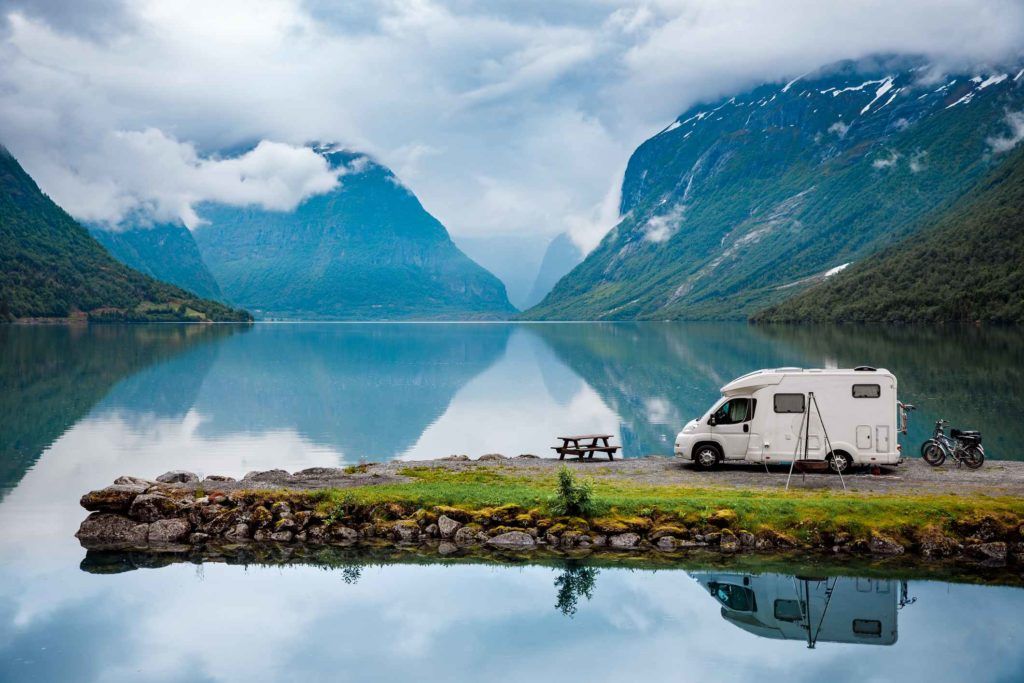
Other factors to consider when travelling Europe by campervan
Road and safety equipment.
Most European countries have mandatory safety equipment that you’ll need to carry on you at all times. If you hire a vehicle, make sure that they supply you with everything you need such as fleurescent orange vest and safety triangles. Winter tires are a legal requirement in most countries during the cold season. You may also need snow chains if you plan on going into the mountainous areas in winter.
If you buy a campervan you may need to source the safety equipment for yourself if you didn’t receive it.
Vignettes and road taxes
Vignettes are stickers that you add to your windscreen in certain countries to show that you have paid for the privilege of using their roads, mainly highways. The countries that use vignettes are
- Czech Republic
- Switzerland
You can usually buy a vignette at border crossings or at petrol stations close to the borders. You must have one or you can be fined.
Road tolls and a toll pass
Many countries have tolls their motorways. If you’re spending a decent amount of time in a country that has tolls, and offers a toll pass, it can be an easy way to avoid the long lines that sometimes occur at the toll way.
Security, Safety and emergencies
To be perfectly honest, we’ve never felt anything other than safe and secure in Europe. The only concern we ever really had was when we couldn’t find anywhere decent to park the campervan. It was sometimes necessary to park in places that we were unsure about. Other than that, most countries in Europe are safe and other people at the campervan sites are just doing what you’re doing and trying to enjoy life.
If however you have an emergency, the emergency number in Europe is 112.
Winter in mountainous regions of Europe
If you plan on driving in the mountains in winter, you’ll probably require snow chains. Make sure you know how to fit them properly. If you’re hiring a campervan, the hire company should show you how to do this.
Blood Alcohol Concentration
It’s important that you know the legal Blood Alcohol Concentration (BAC) for each country that you go through as it varies between them. While some countries have 0.05, others have a legal BAC of 0, meaning you can’t drink at all before driving.
These are really the main things that you’ll need to consider when planning to travel Europe in a campervan but don’t let it stress you out. Make sure you cover the basics and the rest you can deal with as you go. You’ll love the freedom, I promise.
Where to stay with your caravan or campervan in Europe?
Campervan parks.
There are quite a few options for places to stay overnight with your campervan. We stay at campervan parks, also known is holiday or vacation parks. Here you have access to facilities such as showers and toilets, and washing up and laundry rooms. It is possible to find some incredible campervan parks throughout Europe.
Overnight parking places
Many countries have over night parking places where you can stop if you’re just driving through. While some are nicer and designed for tourists, others are essentially truck stops, but will do the job. They’re free if you don’t want to pay. You can find these on the park4night app that I mentioned above.
In France you’ll find Aires de Service, or aire de camping car, which are places that you can stop for the night. They cost anywhere from free to €15. For an extra fee you may be able to dump your grey water and fill up your fresh.
Wild camping
Wild camping, known as freedom camping or free camping in other places, is not so common, but fairly easy to do in Europe. This is where you stop somewhere that is not a designated camp site, for example, in the forest. To do this you’ll need your campervan to be fairly self sufficient. You’ll also need to check the laws of the country you’re in as it is illegal to wild camp in certain countries.
ACSI card for discounted camp grounds
If you’re travelling in Europe in the off season, this card gives motorhomers, campervanners and caravaners great discounts on campsites and is well worth getting. As mentioned, only if you’re travelling in the off season.
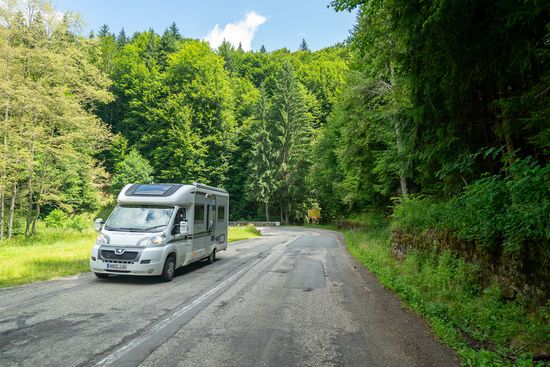
Where can I travel with a campervan in Europe?
Everywhere! In reality, you can travel across most of the continent in a campervan, motorhome or caravan. Europe has open borders so you can freely move throughout the region. Once you’ve crossed the border into one country, you’ll need to abide that it’s rules and regulations. I’ll cover that more below.
Europe by campervan: Travel Routes and Itineraries
Where to begin your road trip, or hire your campervan or motorhome.
Where you begin your trip and collect your camper is up to you. It makes sense to fly in to Europe and collect your camper from the same place. The exciting thing is that the best place to begin depends on your itinerary. Where do YOU want to begin your European adventure?
How to plan a European Campervan Route or Itinerary
Planning a route or itinerary for Europe, or for any road trip is quite a personal experience. You can either plan everything out, from where you plan to stop, what you plan to see and how many days you intend to stay. Or, you can leave it fairly open. I prefer to leave it open and really just plan the main stops. With plenty of space to move in between.
Before you leave home you’ll probably want to have at least a general route or itinerary planned.
European seasons
Europe is huge and the climate varies greatly across the continent, but also across the seasons. You’ll definitely want to factor this in during the preparation phase.
Cooler seasons
November to April are the winter months. These can be difficult for campervanning due to snow and ice on the roads. Not to mention that the temperature can get well into the minuses. It is possible, however you’ll need to be prepared.
If you want to travel in the winter, there are a few countries more suitable. For example, the south of Spain and parts of Croatia, Montenegro and Albania have a milder winter. Whereas central Europe, the Scandenavian Countries and those to the far west have bitterly cold winters. Not ideal for a campervan.
When campervanning in Europe in the winter, you won’t have as many accommodation options as many camp grounds close for the season. Those that remain open will usually have less facilities available.
Warmer seasons
Generally speaking, most people will campervan Europe during the warmer months. May to October are great months, with June, July and August being peak season.
From mid spring to mid autumn, the weather vary’s from balmy to hot, making the summer peak seasons for travellers. The coastline along the bottom of the European continent is buzzing as thousands flock to coastal towns.
Although it’s a great time of year to travel, summer in Europe poses it’s own challenges. The coastal areas of all countries are incredibly busy with both overseas and European travellers alike. Prices are also their highest at this time.
For motorhome or campervan travellers, you’ll need to consider whether you get air conditioning. Our first campervan in Europe did not have air conditioning. At the height of summer, on the Croatian coast, Ben, Whiskey and I all slept outside on the ground. It was just too hot to bare. Two days later we left Croatia for Romania which is a few degree’s cooler over night.
Peak periods
Europe is home to some of the worlds largest events, think Tour De France, the Dutch Keukenhof, or Germany’s Oktoberfest. Thousands of travellers flock to these area’s in the lead up to these events. You’ll need to be prepared if you want to join them. Otherwise you’re probably best to stay away from those areas at those times.
Another issue can be the ‘school holiday’ period, during summer in Europe. Popular campervan parks can book out months in advance.
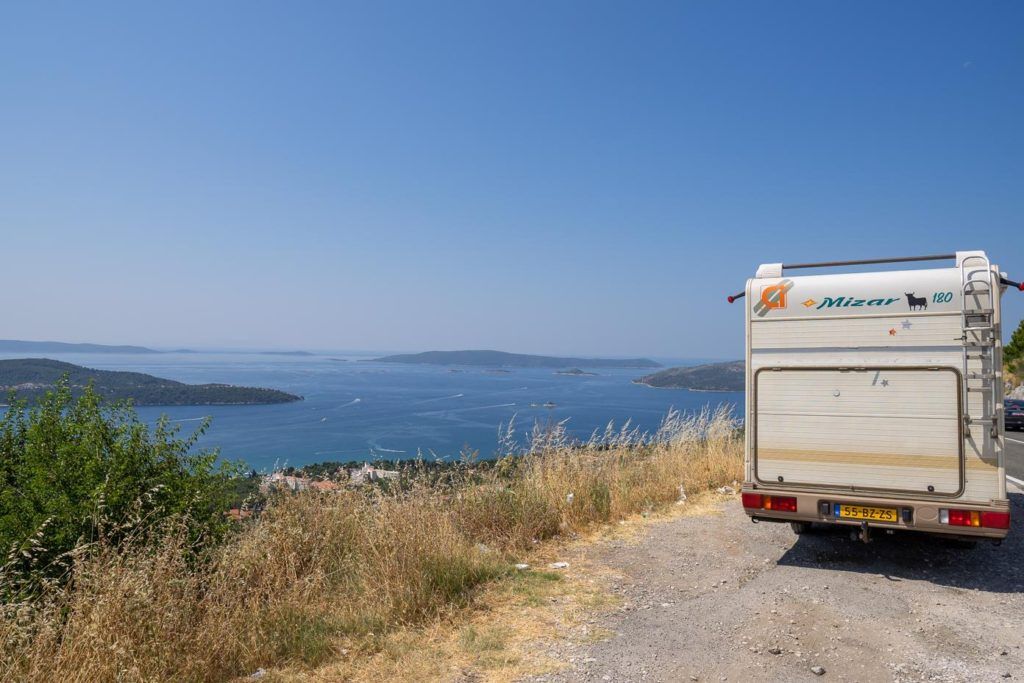
Using ferries on your European road trip
A great way to get from A to B without driving the long way, or simply to get on and off an island, like England, Ferries are part of most peoples campervanning experience in Europe. Connecting countries like the UK with France, Spain and the Netherlands, and Italy with Greece, Turkey or Croatia, it’s a fast and efficient way to travel.
Depending on the size of your motorhome or campervan and the distance you need to travel, you can pay anywhere from a €200 to €1000 euro per trip.
Using google maps to plan your European Campervan adventure
Get comfortable using google maps route planner when you’re planning your trip. I really like it because it gives me distances and times for travel. For example, I might decide to leave one place and drive to the next, The distance always looks so small on the map but google maps says it’s a 9 hour drive! Then I can try to find a place to stop in between for the night or find something that we might want to see or do for the day.
You can also download offline maps which helps if you think you might be going somewhere with no internet access.
It’s a really useful tool.
Costs and budget for travelling Europe in a campervan
Ultimately your budget will reflect your personal travelling style. It is heavily influenced by how many attractions you visit or how often you eat out compared to cooking in the campervan. Accommodation costs will vary from person to person, for example staying in high end campsites every night will be more expensive than wild camping, which is free. Your campervan hire or purchase price will be your most expensive initial outlay.
Some necessary and regular expenses are
- petrol or diesel for the campervan
- campervan site fee’s
- Admission fee’s to tourist attractions
- Gas for gas operated cook top or heating in the campervan
- Laundry facilities (sometimes you have to pay at the camp sites)
- European road tolls
- European Vignettes (see below)
- Public transport if you leave the campervan at the campsite
Apps for tracking your spending
It’s really helpful to keep track of how much money your spending. It disappears so quickly when you’re paying little bits out here and there. Petrol, gas, the camp ground for the night. Keeping track as you go means you’ll make it comfortably to the end of your trip rather than running out half way through.
Two great apps you can download to your iPhone are Trabee Pocket and Trail Wallet. They are both pretty similar and will help you keep track of your spending in each country. You can also track in that countries currency AND your home currency. This is really useful if your mental conversion is not so good, like mine!
Transferring Money
If you’re needing to transfer money around, make sure that you either have your own wifi device, like a dongle, or you use a VPN to protect your banking data.
What do you mean some countries don’t take Euro’s?
Yep, just to confuse things, some countries in Europe don’t take Euro’s. This is easy enough to deal with as simply going to an ATM or taking a small amount of the other currency with you, will solve the problem.
Countries that don’t accept euros are
You’ll need to organise these things before you leave for Europe
Your passport and any necessary visa’s.
Your passport itself is fairly easy. You just need to have one, and it needs to have more than 6 months validity, and enough pages to be stamped.
Visa’s can be a little bit more tricky depending on what citizenship you have, and how long you intend to travel. Make sure you check your visa requirements and organise your visa in advance.
Read : Passports and Visa requirements for campervan travel in Europe
Drivers licence
It seems only logical that you’d take your drivers to Europe if you intend to drive a campervan, doesn’t it? Make sure to check that your license is sufficient though. You may find that you need to obtain an International Drivers License before you go. And if so, you’ll need to have that on you too.
Travel Insurance for travelling Europe in a campervan
Travel insurance is one of the things that we never, ever leave home without. It’s really easy to have the ‘It won’t happen to me’ attitude, but the reality is that ‘it’ can happen to anyone.
Make sure that you book good travel insurance before you leave. We always use World Nomads. We’ve dealt with them personally, when I fell sick in Vietnam and needed treatment in Cambodia and then also in Thailand (very long story there!).
World Nomads were fabulous and we were really impressed with their service and speed. They called a couple of times just to check up on me and make sure we were ok. They also paid out almost all of my medical expenses, despite the fact that we were really delayed in sending them all the information. I mean, we literally sent the bills months after the event. I was convinced at that point that they wouldn’t pay, but voila. We’re very happy with them.
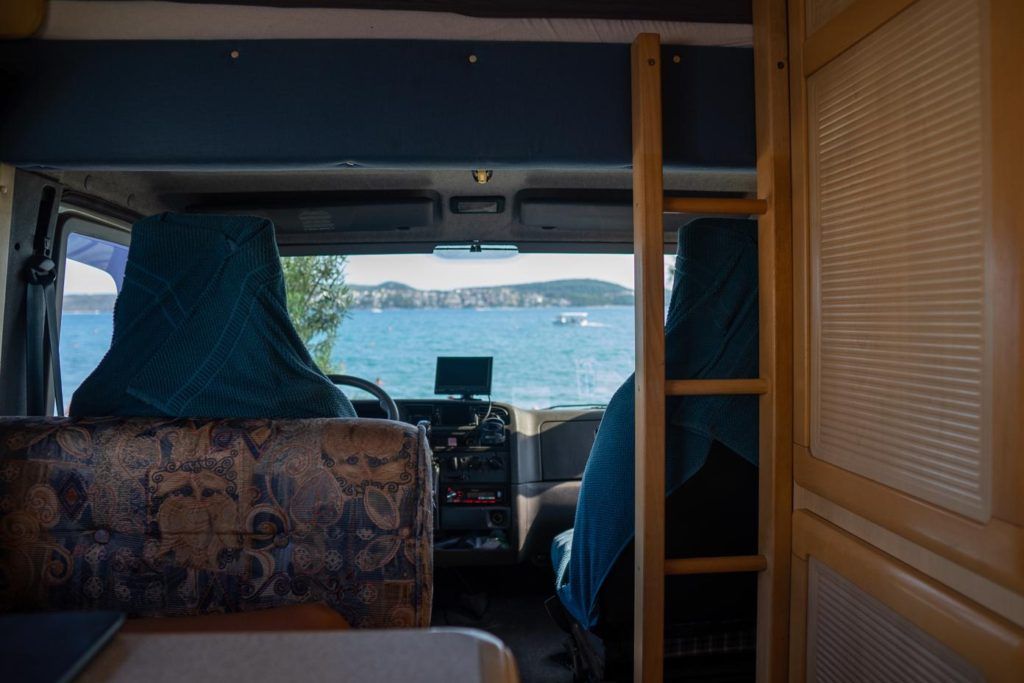
Paperwork that you’ll need to carry with you
Before you set out, you’ll want to make sure you have copies of all necessary paperwork. This includes
- Campervan or caravan and car insurance paperwork. Make sure you have the original, some countries won’t accept copies or photos from your phone.
- A rental contract or purchase contract proving your right to the vehicle
- Your travel or health insurance information
- your original birth certificates and marriage certificate. These are not so easy to get on the fly if you need them
- your drivers licence
- Your pets health check certificates and proof of rabies vaccination. You’ll need this even if you’re from a country that doesn’t have rabies. If you enter a rabies risk zone your pet won’t be allowed back into the rabies free area without one.
- Details of anything you’ve booked in advance including campervan parks, tours, tourist sites or public transport.
Van life – What’s it really like?
We absolutely love the freedom and sense of adventure that comes from living life in a camper. The idea that you can pick up and go anywhere. That you can see something new and different. We’ve been able to see some incredible places and have wonderful experiences. Not to mention adopting our dogs from Croatia. We wouldn’t have been able to do that if we didn’t have our own home on wheels.
The challenges of van life
That being said it’s not always sunshine and rainbows. There are challenges to van life as much as there are to any other lifestyle. Adjustments need to be made to how you life. The smaller the camper, the more adjustments are required to make van life enjoyable.
It involves some downsizing
You need to get used to public toilets, the occasional cold shower and cooking with minimal equipment. Packing everything away every time you move can be a bit annoying but you do get in a good rhythm with it. Forgetting to lock a cupboard door is fun when stuff flies out while you’re driving. Generally, if you’re a minimalist or can get buy without ‘all the stuff’ then you’ll have no problem.
I love our life in our little home and I have absolutely no problem what so every with living in a smaller space. I have everything that I need and the space doesn’t bother me at all.
It can be tiring constantly moving
We sometimes struggle between moving and staying still. If you find a really good camping place it’s really easy to settle down for a while as opposed to keeping moving.
When things go wrong there’s no escape, your camper is your home AND vehicle
There are times when things go wrong with the camper. Like the time our wheel bent, yes, our wheel bent. We were about to leave Romania and head back to the Netherlands. We decided to make a push for it but the vibration got worse and worse. The first night we stopped in Hungary for the first night, then in Germany, and then made it home, but oh wow did we have headaches.
You may have the odd sleepless night
And, as much as we like to think they are, motorhomes and campervans are not sound proof boxes. There’ll be the occasional night you don’t sleep because the people next to you have music playing, or are sitting at their table outside your window talking. We were at a campground just outside Bucharest. Which, unbeknownst to us, was right beside a large venue which was holding a wedding reception. Hardcore dance music blared inside the campervan, it was so loud we couldn’t have heard our own music if we’d put it on and turned it right up. Everyone was in the same boat because we were packing up our campervan at 6 am, and so were all the others. No one had had a wink of sleep.
The other side to this is thunderstorms. Heavy rain or wind on a campervan or caravan roof can sound thunderous. Sleeping during really big storms can be difficult. And if a huge storm hits during the night and your awning is out, watch out!
How do relationships survive van life?
To be honest I think that depends on what the relationship is like to begin with. Ben and I have travelled together for years so we’re used to always being together. We don’t really have any issues with being together all the time. That being said, sometimes it’s nice to have some privacy, or a moment to yourself.
Our main arguments these days are about the toilet. After all this time he still argues every time I tell him that the toilet needs to be emptied. E-V-E-R-Y time. You know in relationships you have your roles. There are certain things one person always does and certain things the other always does. He always does the toilet, its just the way it is. The thing is, I always have to tell him it’s full. He never just notices and empties it. I notice it and I tell him. This is what we argue about!
Other ways van life can affect relationships
As a little side note, it’s important that you factor your relationship in when you choose a campervan. With our first campervan we had to sleep in separate beds because the beds were too narrow for us. We also had a fairly small table that had two bench style seats opposite each other. The seats were not wide enough for us to sit comfortably side by side. I mean, we could, but we were bumping elbows a lot.
Not only were we sleeping separately, we were always sitting opposite each other. It didn’t really do a lot for the romance.
When we bought our caravan we knew we wanted one with a big bed, as well as a larger seating area where we could sit side by side.
In conclusion
So, that’s a lot, right? While there’s a lot to know and certainly to do before you leave on you camper van or motorhome road trip around Europe, once you set off, it gets a lot easier. After a week or so the day to day basics become routine and you’ll find your rhythm.
I want to hear from you
Don’t be shy. If you’ve made it to the end of this guide on campervanning Europe then you’re ready to go. Drop a comment and tell me your plans. Also feel free to ask any questions you might have. You never know, maybe they’ll help someone else too.
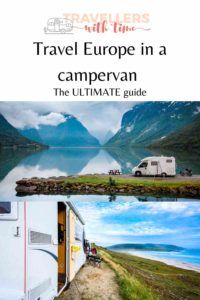
About Christine
Christine and her partner Ben have spent the last few years traveling through New Zealand and then Europe by campervan. They travel with their dog Alisa, who they adopted in Croatia. You'll find them exploring old cities, hiking through National Parks, and taking unforgettable road trips.
2 thoughts on “How to travel Europe in a campervan, motorhome or caravan”
Hi! Can you park for free-boondock with caravan? Im from Croatia and i see motorhomes park in city centar regulary im in Istria,but never see caravan park like that.I see them only in supermarkets parking or shoping centar parking. But can leave caravan somewhere in Forest and leave with you car is this possible? Sorrry abou my English! Thank you!
Hi Daniela, I’ve never tried it in a caravan so I can’t be sure, but I think there would be some problems with boondocking in a caravan. Some of the issues I can think of are – Safety and security – You’d need to make sure that the caravan can’t be stolen – you could use a Hitch lock, which prevents someone else from connecting their car to your caravan and towing it, there are also wheel locks, and then things like extra door locks and alarm systems – Leveling a caravan is more difficult, so if you want to camp in the forest you’d need to find a place that has flatter ground from the start – It will be more difficult to move a caravan if you need to make a quick exit – either for safety reasons or because you’ve been asked to move. – You probably don’t have a waste water tank so you’d need to find a way to collect your waste water so that it doesn’t flow out into the environment.
Those are just a few reasons I can think of. Maybe some of our readers have more experience with boondocking in a caravan?
Leave a comment Cancel reply

What are you looking for?
10 best campervan & motorhome/rv rentals in europe [2024].
Fun fact: we've spent over 6 months exploring Europe by campervan, and it's truly the BEST way to a large number of countries, in a very coinvent way.
Plus, Europe is set up for campervans and RVs in a very positive way!
There really is no better way to explore Europe than by driving a campervan.
Rolling countryside, historical cities, and other natural attractions all await you, meaning you're in for an incredible adventure.
It’s super easy to travel between countries too, with most of them connected by land or just a short ferry ride away.
If you're not planning to convert your own campervan then you don't need to worry!
Luckily, there are lots of large companies offering van rentals for camping, with depots in most or all of Europe.
Below we’ve highlighted the best campervan and motorhome hire options on the continent.
There are also many local independent companies that operate in a specific country. To secure these deals, we recommend using GoSee and narrowing down your search to your chosen city.
Let’s get started!
Travellerspoint
How to book a campervan rental in Europe

One of the simplest ways to hire a campervan in Europe is through GoSee Travel rentals .
With more than 300 thousand motorhome road trips and 3 million car rentals booked, they’re one of the largest motorhome rental agencies in the world.
Europe is a vast continent and campervans often sell out quickly.
GoSee can make it convenient to search the best campers for your dates and location all around Europe, and then you can book it all in the one platform.
Here's why I love recommending GoSee for finding campervan rentals in Europe:
- Price Beat Guarantee - If you manage to secure the same vehicle from the same supplier for the same dates at a lower price, GoSee will match the price.
- 24/7 award-winning customer support - The team is made up of experts on motorhomes who are ready to assist you anytime of the day.
- Excellent vehicles - GoSee offers thousands of vehicles to hire all over Europe and even beyond
For more info, read our in-depth review of GoSee Travel (Motorhome Republic) .
1. McRent - Best overall campervan & motorhome rental in Europe
- Pick up/drop off location/s - Almost all of Europe
- Price range - $-$$$
- Best suited for - Any traveler
- Availability - Check here

McRent is the largest motorhome rental in Europe and our top pick!
It’s a useful platform that combines many reputable rental companies across Europe, making it simple for customers to browse.
They offer long distance driver discounts, have exceptional customer service, insured vehicles, expert maintenance, and much more.
McRent also focuses on sustainability, which includes testing and certifying advertising materials, promoting local clubs, and being environmentally aware.
Additionally, the company cleans every vehicle professionally after each rental. Their high cleaning standards and hygiene ensure that all their vehicles are well-maintained and nice to live in!
If you're looking for to hire a motorhome in Europe then make sure you check this company out.
Vehicles on offer:
One of the best things about McRent is that they have such a huge variety of campers available.
From smaller vans, campervans with a pop-up roof, to fully-integrated vehicles and overcabs, it’s easy to find the right one for you.
There are options for smaller vehicles suitable for a city trip as well as larger motorhomes that include amenities to make a long trip feel more comfortable.
McRent’s motorhomes are all manufactured in Europe and adhere to Erwin Hymer Group brands standards, specifically Dethleffs and Sunlight.
All of their vehicles are also under 2 years old!
2. Outdoorsy - Most comprehensive rental marketplace in Europe
- Price range - $-$$
- Best suited for - Everyone

One of the most comprehensive platforms for renting RVs and motorhomes is Outdoorsy .
It’s a safe marketplace offering full insurance and an excellent selection.
Across Europe and worldwide, the company has more than 5,000 reviews with a 4.87 average rating and 240 thousand trips taken in total.
One unique thing about Outdoorsy is that they offer vehicle delivery. This includes dropping of the vehicle at your house, airport, or other locations, as well as setting it up directly at a campsite or RV park.
Whether you're looking for motorhome rentals in France or Germany , Outdoorsy is a fantastic choice!
They offer a huge variety of vehicles so are often the top pick when it comes to Europe camper hire.
For more information about this platform, check out our in-depth Outdoorsy review !
Outdoorsy’s selection includes everything from Class A, B, and C RVs to vintage Airstreams and garden variety trailers.
From affordable campers to newer, luxury models, there are options for all budgets.
For example, the Korus 720 can sleep up to 5 passengers and has a 100-liter fresh water tank.
You can also see the customer reviews for each vehicle, allowing you to filter the ratings and choose only the best possible one.
Just make sure you check the amenities included for each campervan as they will all be different. Some might feature air conditioning and a generator, while others won't!
3. Apollo - Best motorhome rental company in Germany and the UK
- Pick up/drop off location/s - Paris, Dublin, Hamburg, and several cities in the UK
- Price range - $$
- Best suited for - Families and couples

Apollo has been around since 1985 and is one of the best campervan hire companies in both the UK and Germany.
Their fleet of high-quality campervans and motorhomes are designed to cater for travelers across Europe and beyond.
This brand delivers great service that begins from booking all through to 24-hour roadside assistance and liability reduction.
Their rates are pretty competitive too with special discounts throughout the year.
Moreover, Apollo also strives to minimize their environmental impact by upholding sustainable practices.
All of Apollo’s motorhomes are built by Weinsberg, a leading manufacturer in Germany.
Vehicles range from 2 to 6 berths, making them ideal for couples and families or friend groups.
There’s the flagship Apollo brand, value option Cheapa Campa, and youthful Hippie Camper.
Most of the campers come with heating, shower, and kitchen facilities.
The Voyager , for example, is a 6-berth home away from home that offers fantastic value for road trips on a budget.
It has built-in GPS and reversing camera, a media player, and all the comforts of a mobile home.
4. Spaceships Rentals - Best for campervan hire in Europe and the UK
- Pick up/drop off location/s - London & Edinburgh
- Best suited for - Everyone from couples to groups

Although Spaceships Rentals only has offices in London and Edinburgh, it’s perfect if you want to start off your road trip in the UK and travel elsewhere in Europe.
The 24/7 contactless pick-up process makes it easy to plan your trip for anytime of the day.
All Spaceship vehicles come with unlimited mileage, and you can also have up to 4 drivers per booking without any additional fees.
Not to mention the standardized safety guidelines that cover everything from vehicle cleaning and booking to handover, collection and drop-off.
This company has a lot to offer, making them one of the best rental companies in the United Kingdom .

At Spaceships Rentals, you have camper and RV options from 1 to 7 berths.
Their custom-designed vehicles include features suitable for weekend breaks to long road trips.
There’s also the award-winning high-spec Adria SunLiving S70 SC , perfect for a luxury home on wheels.
It features a separate double bedroom with toilet and shower, full kitchen, and even underfloor heating.
And for those of you traveling with a furry friend, you can add a dog-friendly fee for just £10 per day.
5. Touring Cars - High-quality motorhome services provider in Europe
- Pick up/drop off location/s - Bulgaria, Estonia, Finland, Iceland, Latvia, Norway, Spain, Sweden, UK
- Best suited for - Couples and groups

With 10 stations in 8 countries, Touring Cars is one of the oldest motorhome service providers in Europe.
Since 1982, they’ve adhered to extremely high standards of Finnish quality and reliability.
With Touring Cars, you only have to pay one down payment and the rest later (45 days before pick-up). Booking online has never been easier!
The best thing about renting from Touring Cars is that their fees include taxes and other official charges.
They offer convenient airport transfers and 24/7 road service too, as well as unlimited mileage.
There are also various long-term rental discounts with up to 15% off if you hire a vehicle for 45+ days.
Their fleet consists of leading German vehicles that are well-maintained and sanitized.
The have six motorhome categories when it comes to rentals, including options for 2-5 people.
There are both vans and motorhomes available, so there's something for everyone!
Finally, you’re welcome to travel with your pets if you pay the additional pet cleaning fee.
6. Yescapa - Best peer-to-peer RV rental in Europe
- Pick up/drop off location/s - Almost anywhere in Europe
- Best suited for - All travelers

Yescapa is an excellent alternative to Outdoorsy in that it’s also a peer-to-peer RV marketplace.
It basically connects travelers with local RV owners all over Europe, meaning the options are pretty much endless.
They’ve got an awesome blog filled with guests' campervan photos that might serve as extra travel inspiration.
In addition to 24/7 assistance, you get to enjoy cancellation insurance and the option to reduce excess insurance.
There are lots of discounts for things like longer rentals and early bird bookings too, so make sure to look out for those!
Yescapa has more than 15,000 RVs to choose from, including RVs, campers, and conversion vans.
The pricing starts at €50 for a 3-berth and 5-seater camper, like Jean-Baptiste's Campervan in Switzerland.
But of course, you can find the perfect vehicle at pretty much any budget. That’s the beauty of a marketplace like Yescapa!
Plus, it’s easy to check out the reviews and ratings from previous renters.
7. Bunk Campers - Leading campervan rental in the UK and Ireland
- Pick up/drop off location/s - London, Belfast, Dublin, Edinburgh
- Best suited for - Couples and small groups

If you’re starting your road trip in the UK, or specifically Heathrow airport in London, then Bunk Campers is the perfect campervan hire.
It’s located only 6 minutes from Terminal 5, so it’s very easy to just hop into the camper after arriving by plane.
You’ll get insurance, unlimited mileage, and 24/7 road assistance with each rental.
One of the best things about Bunk Campers is their booking flexibility, which means you can easily change the dates, duration, and even pick-up point of your trip.
With pick-up locations in Edinburgh , Belfast and Dublin too, Bunk Campers is one of the best options for campervan rentals in Scotland and Ireland !

Bunk Campers offers a selection of budget campers and luxury motorhomes from leading European manufacturers.
They’re also fitted with the latest EURO 6 ENGINES.
The Nomad Camper is a compact and functional VW campervan that features a classic and stylish design.
It comes with a pop-top roof, kitchenette, and heating, as well as BlueMotion technology for efficient fueling that allows you to road trip on a budget.
8. JustGo - Best rental in Europe for large motorhomes
- Pick up/drop off location/s - London & Scotland
- Best suited for - Families and groups

Although Just Go has depots only in Greater London and Scotland, you’re allowed to drive the vehicle outside of the country to explore other places in Europe.
They have one of the largest dedicated fleets of motorhomes in the UK , offering competitive prices and excellent road support.
Just Go also has a special 23 nights, 5 countries itinerary, which might be useful when planning your trip.
One thing to note is that they charge £5 per night for each hire as a way to support the British government’s low emission tax. A plus for the environment, but something to keep in mind!
This company has a lot to offer making them one of the best options for motorhome rentals in London !
As a dedicated motorhome hire company, they offer seven types of motorhome, as well as some mystery options.
One of their largest ones is the Adventurer, a 6-berth motorhome popular with families and friends for both camping and festival-going.
It’s got tons of storage, a hot shower and toilet, as well as cooking facilities such as an oven and fridge.
9. Auto Europe - Best affordable motorhome rental in Europe
- Pick up/drop off location/s - Paris, Malaga, London, Dublin, Barcelona, Lisbon, Berlin, Prague, and more

You’ll find some of Europe’s best budget-friendly campers with Auto Europe .
They’re an old name in the car hire industry with history dating back to 1954.
Auto Europe has fantastic deals that are region-specific and will give you the best value for your money!
From one-way journeys to unlimited mileage and no vehicle preparation fees, it’s a great option to help you cut down costs.
And not to mention their award-winning customer service!
Auto Europe’s fleet ranges from compact campers for 2 people to large motorhomes that can sleep up to 7.
The C30 is a great option for large families and groups who want to hit the countryside road together.
With plenty of storage and slideouts, the Class C motorhome is a great example of the RVs they offer!
10. Anywhere Campers - Most convenient campervan hire in Europe without a specific pick up/ drop off location
- Pick up/drop off location/s - Anywhere in Europe
- Best suited for - Cross-country travelers

True to its name, Anywhere Campers lets you pick up and drop off its rental campervan nearly anywhere in Europe.
It’s a great choice for anyone who wants to start and end their road trip in different countries.
The delivery service means that someone from the company will deliver your vehicle wherever you are. And the return is just as easy!
They offer roadside assistance, all-inclusive rates, and unlimited mileage.
Campers' vehicles are typically a year old, so there’s no need to doubt the quality.
You can choose between manual or auto transmission, and most of the options are bigger to accommodate longer road trips and larger groups.
Most of the campers also include accessories to make your trip more comfortable.
From BBQ grills and camping equipment to a shower, mountain bikes, and even a basic toolbox. Not to mention the detachable awning!
FAQs about Campervan & Motorhome Hire in Europe
Can you park a motorhome anywhere in europe.
It’s generally easy to find overnight parking on this continent as people are pretty tolerant of motorhomes and campers. But specific countries will have their own laws and regulations, so be sure to do some research beforehand when renting a motorhome in Europe.
Can you sleep in a van in Europe?
Yes, it’s legal to sleep in your car or van in Europe as long as you park in an area that allows overnight parking.
Are campsites free in Europe?
Some European countries like France, Lithuania, Turkey, and Finland allow wild camping , which means you can park almost anywhere without paying anything. However, other countries have laws that forbid that.
This means that you should only park in designated spots and campsites where you often have to pay some kind of parking fee.
How old do you have to be to rent a campervan in Europe?
Most campervan rental companies in Europe will accept drivers who are at least 25 years old. But if you’re between 21 and 24 years old, you can also opt for a young driver surcharge to rent and drive the camper.
Which campervan rental will you choose?
Europe is honestly one of the best places to go on a campervan adventure.
After picking and booking your vehicle, it’s time to plan your trip !
Although this continent is generally known for its high prices, you'll find plenty of affordable countries in Europe to visit too.
If you’re traveling on a budget, then be sure to check out the Baltic countries , as well as Albania , North Macedonia , Romania , and Montenegro . Of course, there are plenty of ways to keep your costs low wherever you travel, and having a campervan is just one of them.
Wherever you decide to visit, you're in for the experience of a lifetime!
All we can say, is don’t forget to explore the quintessential spots in Europe, experiencing the rich cultures, histories, cuisines, and architecture of the continent.
Feel free to drop a comment below with any questions!
If you've enjoyed this rental guide then here are some others that you may find helpful:
- The Best Campervan & Motorhome Rentals in Portugal
- The Best Campervan & Motorhome Rentals in Norway
- The Best Campervan & Motorhome Rentals in Italy

Leave a comment
Let us know what you think.

5 million people can't be wrong
Join our Adventure: Get all my insider tips for motorhoming & road trips
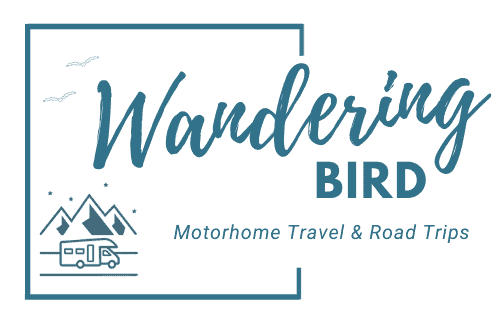
Vanlife Europe- Essential tips to travel Europe by campervan
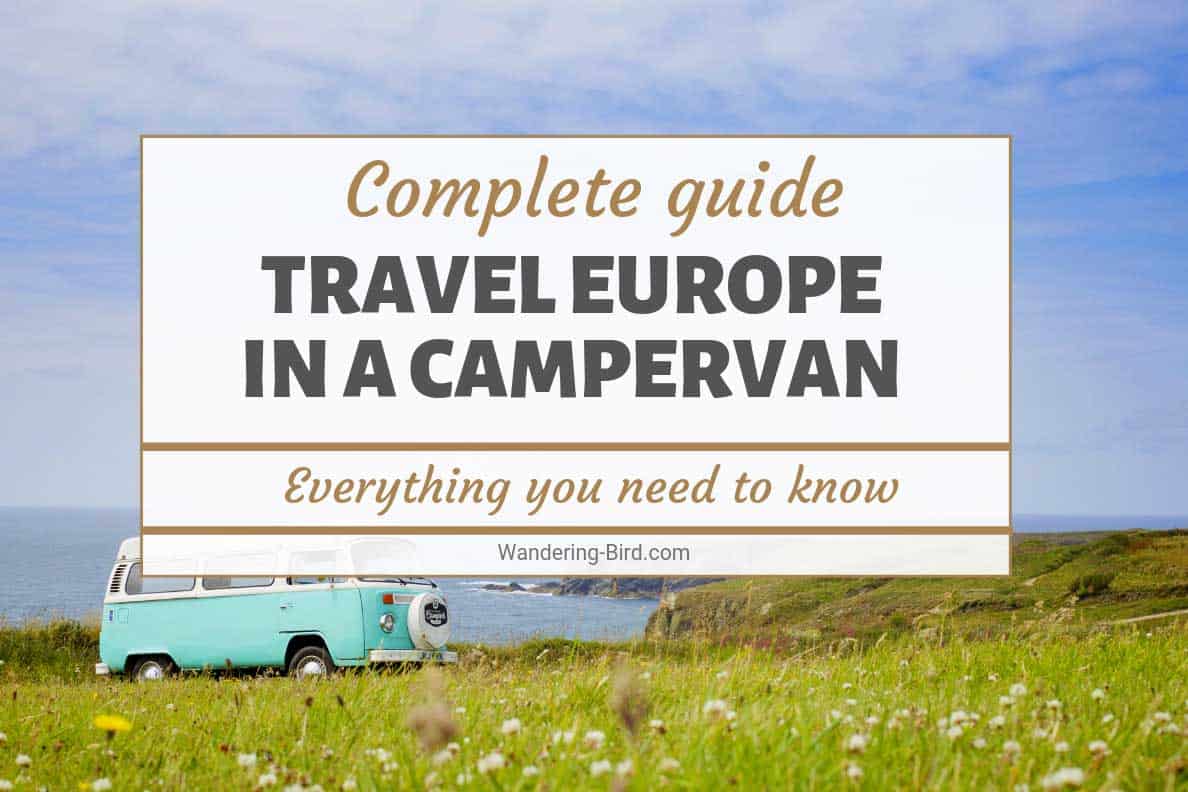
Planning to travel Europe in a Campervan? Feeling a bit overwhelmed and daunted by vanlife in Europe? Want to make sure you don’t forget anything for your trip?
*We work hard to make this the best motorhome travel blog and road trip website possible, full of helpful content for you. The website is supported by our readers, so if you buy through links on this site we may earn a commission- at no extra cost to you. All opinions remain our own .
If you find this post useful, you can also treat us to a coffee – we promise to enjoy it while creating more useful content like this- we might even indulge in a biscuit (or two!)
Don’t worry- we know exactly how you feel. Before we set off for Europe for the first time, we felt slightly terrified (in an over-excited kinda way) . And it all worked out fine. (Except for forgetting to bring any gas . And losing all our fresh water. And burning out our brakes coming down a mountain . You know, little things like that…!)
But we’re still travelling Europe by van two years later- so it can’t be that hard!! 🙂
I promise you, a little bit of preparation will make all the difference. That’s what this guide will help you with- preparing for Vanlife in Europe!
JUMP AHEAD TO...
How to travel Europe in a campervan
So, you’ve bought your camper van. You’ve packed, adjusted and repacked your campervan. You’ve made list after list after list. You might have even spent a few nights away in your van. You feel ready to set out and take on the world. (Or, you know, Europe.)
If you’d like some more guidance on road trips and van travel, we have some fantastic guides and checklists to help you get started in our FREE RESOURCE LIBRARY- click here to check them out!
And don’t worry if you’re renting a camper and haven’t even seen it yet- you’ll be just fine if you follow the advice below. It’s perfectly possible to pick up a van and take it straight on an epic road trip adventure .
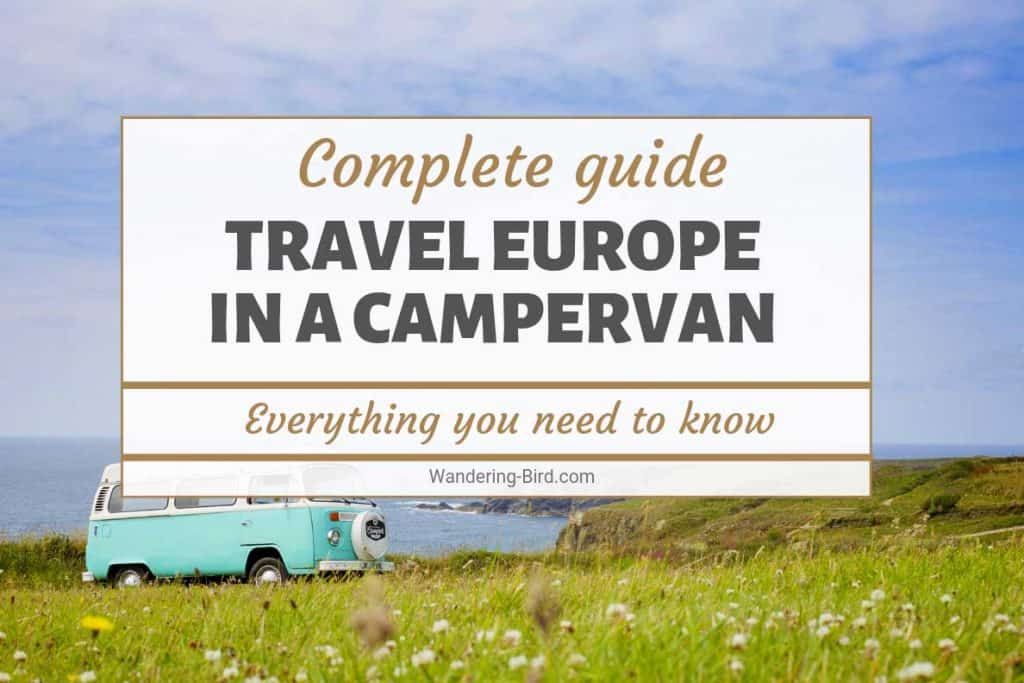
Vanlife Europe – the boring, but oh so essential paperwork
Sorry, but this paperwork stuff really is essential. I promise it gets more exciting later on!
We’ve been stopped twice, both times near the ferry at Caen, France. I love travelling in France in our van , but the French police near the UK border do seem to love to pounce on campervanners who may have forgotten some essential paperwork. Or who break the speed limit. Don’t let that be you!
Fines must be paid in cash there and then; no- they don’t provide any evidence if you’ve been caught speeding. It’s their word against yours. If you don’t have cash, you’ll be escorted to the nearest cash point and asked to withdraw the correct amount.
Also, don’t expect them to have change. Our fine was for 90€, and we only had 20€ notes… luckily another person who was stopped happened to have 2 x €10 notes, otherwise we’d have been going to the cashpoint 15 miles away in the back of a police car!
To the police’s credit, we offered to give them the extra 10€ just so we could be on our way, but they wouldn’t take it.
On-the-spot fines are common in all countries, except Ireland where the Police are not authorised to collect fines. Some places, like Croatia , give you 8 days to pay. Other places, like if you go campervanning in Portugal , give their police officers an ATM to make sure fines are paid immediately!!
Click here for a complete (printable) list of all paperwork you need to carry in your camper
The most important bits of paperwork are:
- V5 Logbook (yep, the original)
- If it’s a hire vehicle, proof that you are allowed to drive and cross borders
- Driver licence (pink part only)
- International Driver Permit (if required- read the post if you’re not sure)
Other items you need to carry for Vanlife Europe
- UK sticker attached to the back of vehicle or reg plates (and trailer if you have one)
- First aid kit – did you know it is illegal to NOT stop at an accident in France and many other places in Europe?
- Warning Triangle
- Hi-vis jacket which must be easily reached without leaving the vehicle (or getting off a motorbike!) We recommend carrying at least 2, ideally one per person.
- Motorhome speed stickers for some vans
- Spare light bulbs- tricky if you have LEDS but we carry a couple of random old bulbs just for show
- Headlight deflectors as our UK headlamps are pointing the ‘wrong way’ for European roads-
- Radar detectors are forbidden EVERYWHERE in Europe.
- You might also need a red/ white striped reflective board if you have bicycles or a motorhome storage box.

FOR ALL FULL LIST OF ESSENTIAL KIT, CLICK HERE
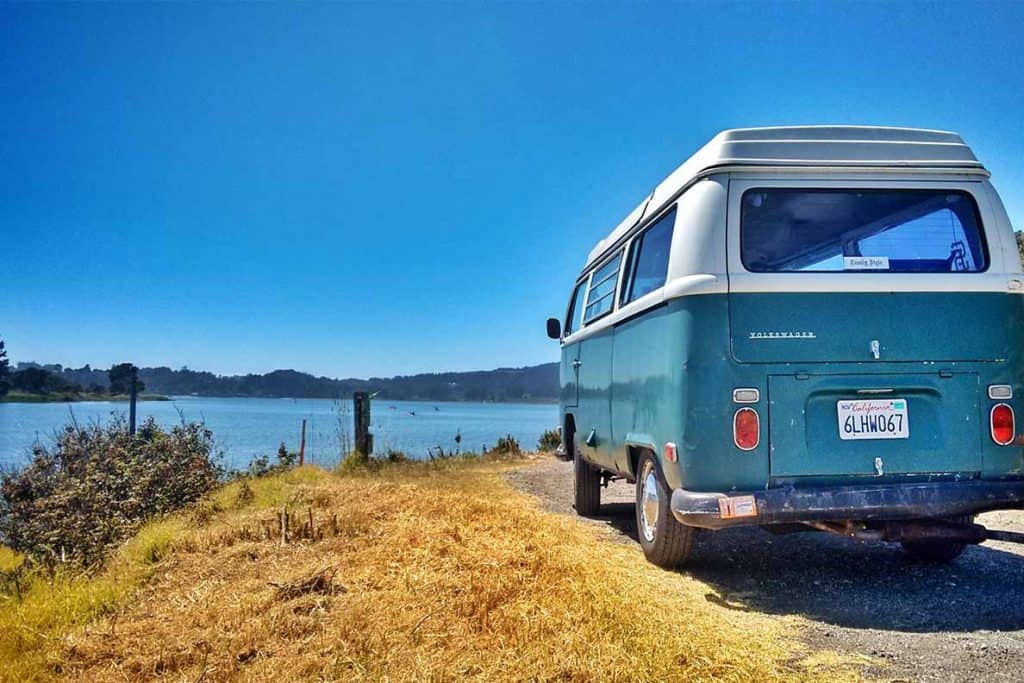
Campervan route planner- Planning a route around Europe
Europe is awesome to explore by camper, but it can also be daunting. We suggest planning a loose route, so you know where you’re headed but leave time to explore places you find along the way.
We like to keep a note of places we find or hear about on Google maps and use those points to plan our next adventure . But you can keep a simple list on your phone which you refer back to whenever you need inspiration!
Want some awesome Europe Itinerary ideas for your Campervan Travel?
>> click here <<, touring europe in a campervan – finding places to stay.
Most people travelling Europe in a camper are doing so on a budget. Therefore, you need to find cheap, or preferably FREE places to stay. That’s called wild or free camping.
You’ll be pleased to know that Europe is MUCH better at providing places for vans to stop for the night, at least compared to the UK (although Brit Stops is helping.)
Here are our favourite ways to find places to stay for the night:
This free app is what we mainly use when touring in Europe in our van. There are LOADS of places marked suitable for campers, vans or motorhomes to park for the night. Some are paid (and marked as such), some have facilities and others are totally wild camping spots in the middle of nowhere.
Most places have reviews and photos so you can see where you’re staying- we avoid anywhere that doesn’t.
Word of warning- some sites/ aires have rules against unmarked/ unconverted vans. If this is you, read the reviews carefully so that you’re not asked to move on when you arrive. Or use the places marked ‘Nature’ on the app- there shouldn’t be anyone there who cares.
>> Learn more about French Aires for campervans <<
France passion.
France Passion is a collection of local businesses across France, which offer free overnight parking for vans, in return for a meal/ purchase some wine at their shop. It’s supposed to be completely without obligation, but we’ve heard stories of a hard sell. It works great if you’re planning to eat out anyway, but if you’re trying to save money, Park4night might be a better option for you.
If you want more information on how we pick our places, here’s a video we did explaining our process:

How to find cheap or free campsites in Europe - Plan a Motorhome Road Trip Pt 2 - Wild camping
Is wild camping legal for campervans in europe.
Sometimes. There are different rules in different countries. For example, wild camping is illegal in Italy. Yet you’ll still find places on Park4night where it’s tolerated. Also, the approved places (Sostas in Italy) cost from as little as 2€/night.
Wild camping is also illegal in Switzerland- until you reach the Alps and people are merrily parking for free in any layby they can find. My favourite night ever traveling in the van was spent in the Swiss Alps, looking up at the Milky Way, with nothing but the wolves for company. And it cost us absolutely NOTHING!! You can also enjoy wild camping with a campervan in France.
My advice is to check out the legalities in the country you are heading for. If you’re not sure and not happy, move on to an approved stop point. You can find more advice on wild camping in Europe here.
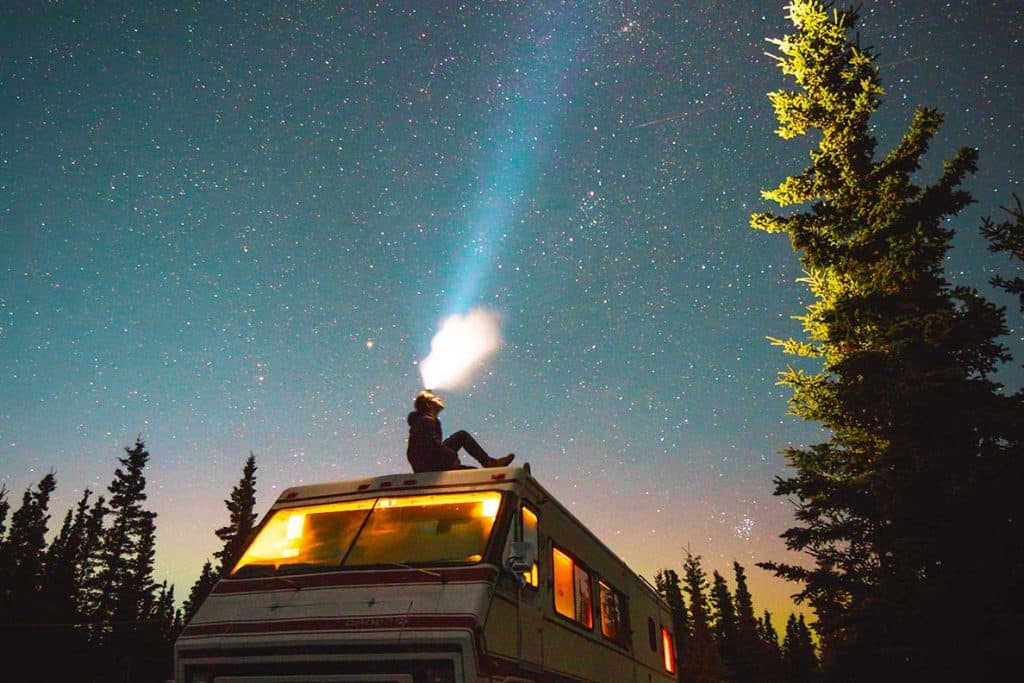
Aires- Approved Places for Campervans, perfect for vanlife in Europe
Europe is NOT like the UK and Motorhomers/ campervanners are not treated like a nuisance- most towns make excellent provision for them and you can stay in clean, pretty locations within easy walking distance of town centres or attractions.
These places are called Aires (France and Belgium) / Sostas (Italy)/ Stellplatz (Germany) For the sake of ease, let’s call them all aires for now.
You cannot pre-book Aires- they operate on a first come basis. A campervan will fit well into all of them unless you have a trailer- some of the spaces can be pretty tight. Some aires have rules against unconverted vans/ vans with signage staying- be sure to read the reviews carefully (you can find reviews on Park4night.
Campervan Travel tips- some essential kit to help make life easier.
Is Wifi an essential? For me it is.
I have a wifi dongle in the van and it’s BRILLIANT. I regularly have multiple devices connected to it at once without problem. Yes, occasionally it’s a slow connection, but for convenience and power-saving I haven’t found anything to beat it. I charge it using a 12v charger while driving and it easily lasts a couple of days when wild camping.

We use an old, second-hand iPad with Co-Pilot navigation app installed onto it. It’s been great and we love the offline map feature.
If you don’t want an app, these campervan sat navs are awesome and very useful- particularly if you have a bigger, taller van.
Also, be careful where you mount your sat nav. Many countries now say it’s illegal to have the satnav mounted on the windscreen or blocking the driver’s view. We use a mount on our dashboard, where it’s low enough to not cause any problems. Here are some options you may like:

Check out the other ESSENTIAL road trip apps we use
Travel europe in a campervan- power requirements.
One of the joys of touring Europe in a campervan is the freedom. We love being able to park in remote locations for days on end. Having to find a campsite every night so we had electricity would really ruin that! (Not to mention blow our vanlife budget!)
The solution is an inverter (and possibly a power pack depending on how power hungry you are.
We charge whilst we’re driving by running the inverter as we drive, which charges the laptops. We charge phones/ iPads using USB sockets in the cab.

Solar Panel
We do have a solar panel onboard, which really helps when we’re wild/ free camping with a camper. It helps top up our batteries and allows us to stay off-grid in the van longer.
We use Gaslow refillable bottles , which are so useful and make getting gas as we travel so much easier. There are plenty of places across Europe to buy refillable gas and you use it just like a petrol station; some petrol stations even sell LPG gas.
If that isn’t an option for your campervan, make sure you get a kit with various nozzles, so you can easily switch between the different types of bottles available.
For a full rundown on the different options for gas available, read this
Europe in a campervan- tips on safety, emergencies.
112 can be dialled anywhere in Europe in an emergency, accident or distress situation.
Thieves & Security
Vanlife security is mainly about common sense (and always leaving an area if you are uncertain.) We’ve stayed put twice, even when we had doubts and both times we’ve ended up regretting our decision.
We don’t travel in our van with any jewellery, very little money and very few items of value. We try to minimise the risk as much as possible, but at the same time you have to get out and enjoy the places you visit; otherwise, what’s the point. Install a really good lock on your camper, both for outside and for inside. We also like to use a steering lock as a visible deterrent.
Essential Tips for Traveling in a van in Europe
Where to get water and waste while travelling europe by campervan.
If you’re not planning to use campsites (and you don’t need to!) there are several options for getting fresh water and getting rid of waste. PLEASE don’t just dump your black waste if you have a toilet onboard- there are plenty of places to dispose of it hygienically.
Many service stations (also called aires, confusingly!), provide a motorhome service point. Often this costs 1-2€ to get everything you need. We find these using the Park4Night app- there are loads throughout Europe. Some aires also have disposal points- again, you normally need to pay for them.
Sidelights whilst driving your camper
Sidelights must be switched on in the following countries at ALL times:
- Switzerland
Low Emission Zones in Europe
Be careful of low-emission zones and areas which require a congestion charge or similar, like Paris and London. These places are often clearly signed but it can be easy to be caught out. We try to Google each city before we visit, or park well outside and catch a train in.
Vignettes in Europe
Also, you need a Vignette for Motorways/ toll roads in Switzerland and Austria.
Driving on the wrong side of the road!
Driving on the right-hand side is not as scary as it seems! Promise.
Don’t forget some (VERY few) roundabouts in France still give priority to people coming ON to the roundabout- so if you’re already going around you have to stop and let them on! (Don’t ask- it’s a French thing!!)
In all our years of driving in France with a car and a camper, we have NEVER found one of these roundabouts, but we have been caught out on occasion by a member of the… older… generation driving onto a roundabout without right of way, forgetting he has to stop! (I hate to say it- but it does seem to be the men who do this!!)
Just be careful and pay attention if you’re not sure- always expect the unexpected!!
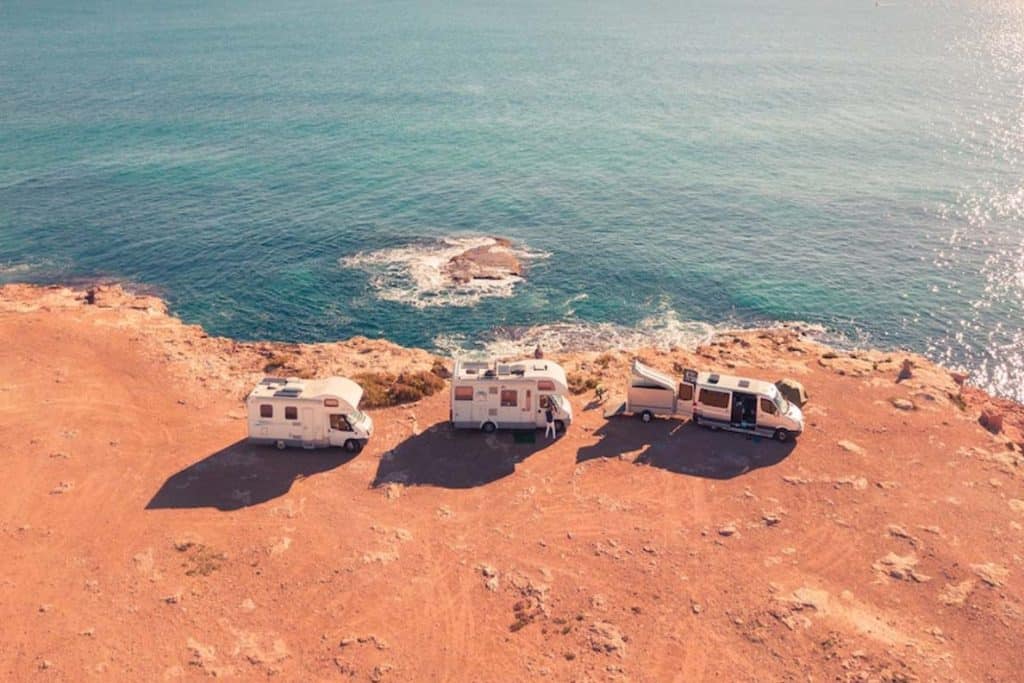
Traveling in a van in Europe- essential tips for camper van life
Try and buy your Euros in advance as you’ll get a better rate. You can use cash machines in Europe but there are often high charges for that.
Also, don’t forget that not every country in Europe uses Euros . Here are some popular ones which don’t!
- Bulgaria – Lev
- Czech Republic – Kurona
- Denmark – Krone
- Hungary – Forint
- Norway- Krone
- Poland – Zloty
- Romania – Leu
- Switzerland – Swiss Franc
There are others in East European as well- make sure you check in advance.
This pass is awesome for being able to skip the queues if you are traveling Europe during Summer. We love not needing to find change as we travel- it just sends us a bill at the end of the month. We use Emovis-tag.
Make sure you’re have enough medication for you and any pets. Be prepared to explain your medication and prove what it is with a doctor’s note or something similar- just in case customs search the van and ask you.
Actually, on that note, EXPECT to be searched at customs/ borders. They do search campers and vans a lot!
Tyres & Snow chains
If you’re travelling Europe by campervan during the winter, you might need snow chains and all-weather tyres. You can get these fitted in Europe without problem.
How to travel Europe in a camper van- Final thoughts
I know the idea of travelling in a foreign country in a van can be daunting- especially if they don’t speak the same language! However, none of this is difficult; you just need to be organised, which can take some time. Here are some final tips and inspiration for your campervan travels:
- Learn a little of the local language. English is widely spoken around much of Europe, but they love it if you make an effort. After all, you are in their country and a little respect to them means a much friendlier welcome!
- Accept you are a tourist- you will make mistakes and probably look like an idiot. Don’t let it put your off your camper van adventure!
- Try to ‘slow travel’- travelling by van is about the journey as much as the destination . This can be hard when you’re on a schedule, but try not to cram so much in you can’t have a day by the beach or at a vineyard if you fancy it.
- Having said that, do a little research as you travel so you don’t miss some amazing places. We like to pick an area and then Google it to see what great adventures are waiting for us! Then we plot a rough itinerary on Google Maps.
- You don’t want to spend your time with a broken down camper. Make sure you do these essential vehicle checks before you go!
How else can I help you today??
– how much does travelling europe by camper cost, – what are the best road trip planner apps i need before i go, – what’s the best van for vanlife, – how do i increase clothes storage in my campervan.
I know you will LOVE being able to travel Europe by campervan. Let me know where you end up- I’d love to see your pictures. Safe travels.
Want to download this post as a FREE PDF guide? Click HERE
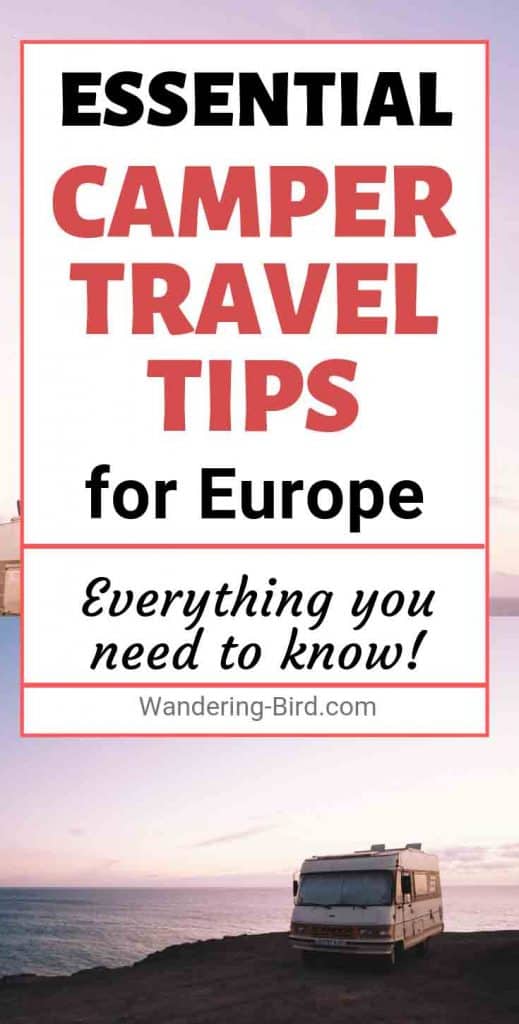
Kat never planned to buy a motorhome. She also never planned to quit her job as an air traffic controller, go touring around Europe in said motorhome, start one of the UK’s largest motorhome travel websites… or get a cocker spaniel.
Find out how she went from stuck in the rat race to being a digital nomad and inspiring thousands of people to have their own epic adventures here.
If you’d like to connect with Kat, send her an email or follow her adventures on social media.
Last update on 2024-08-16 / Affiliate links / Images from Amazon Product Advertising API
Sharing is caring!
Similar Posts
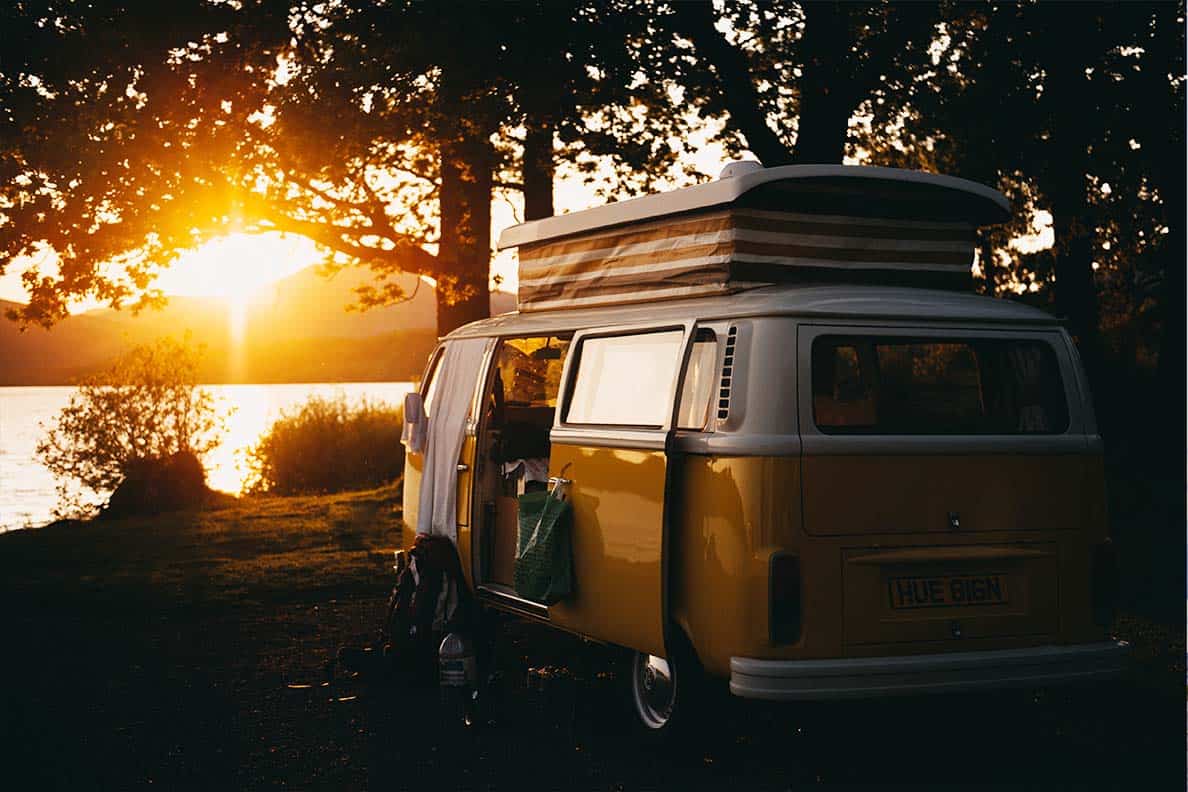
Campervan Hire UK and Europe- Essential things you Need to Know!
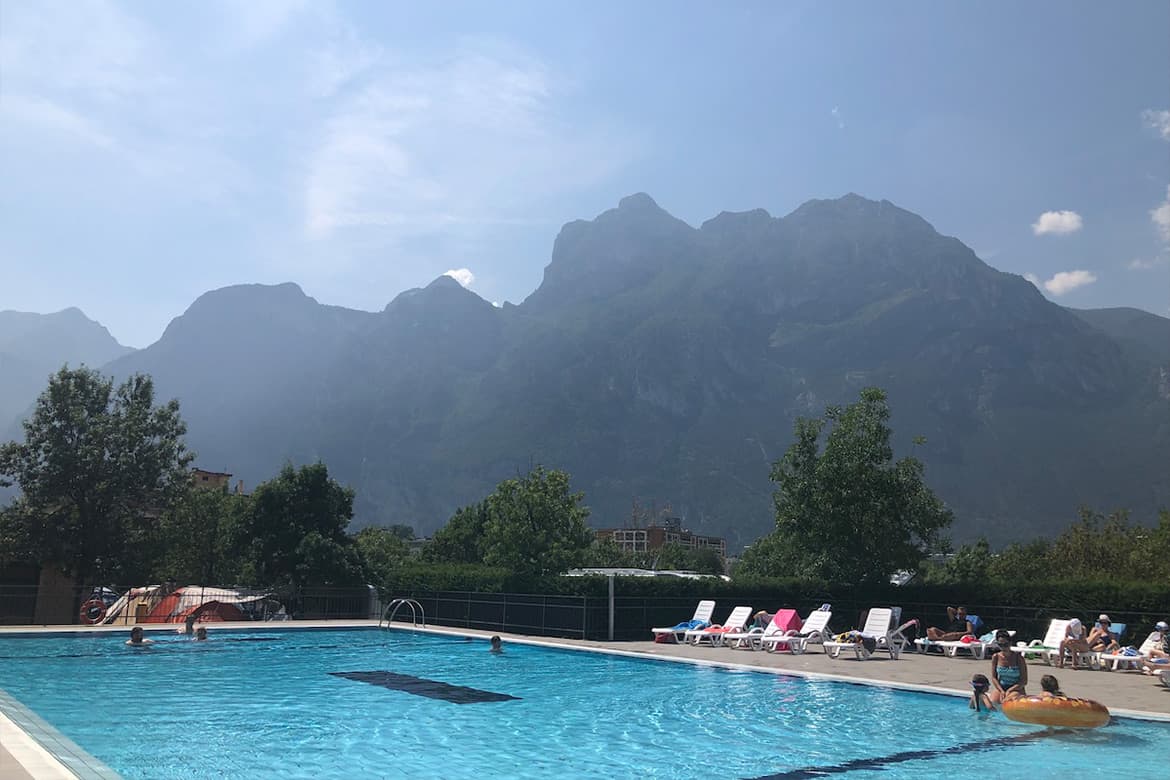
5 best motorhome campsites in Northern italy

Motorhoming & Campervanning in Norway- your Complete Guide
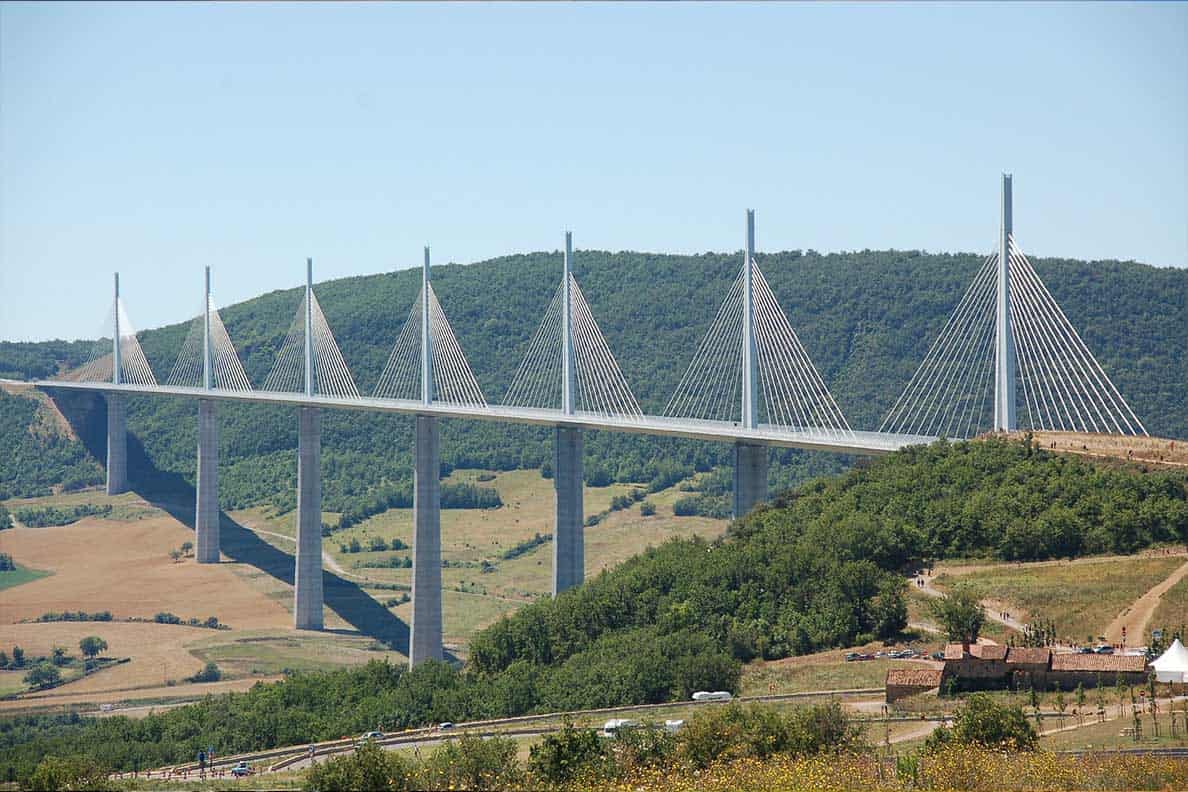
Crossing the Millau Viaduct in a Motorhome
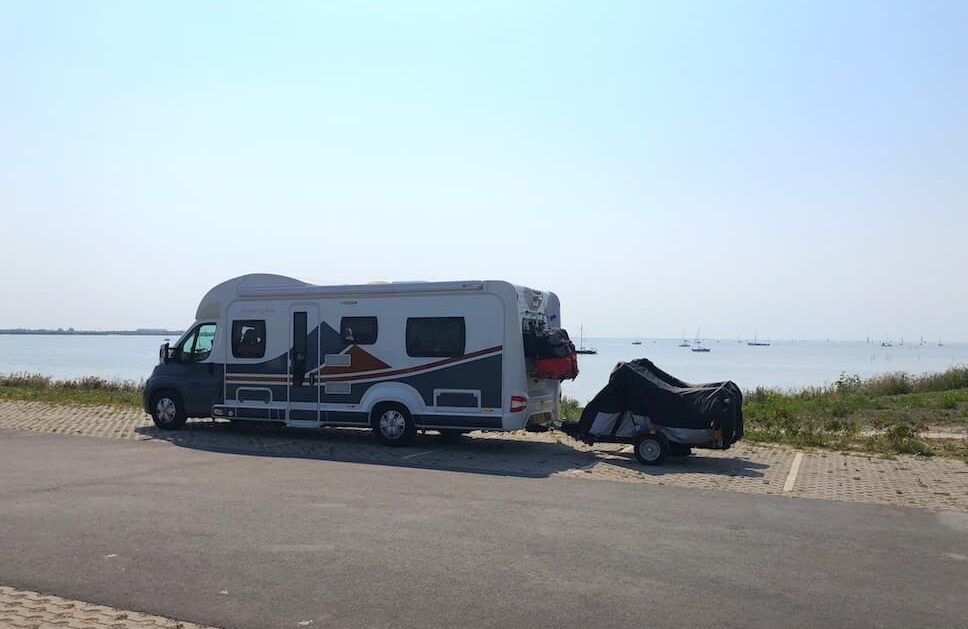
Motorhoming & Campervanning in the Netherlands- The Ultimate Guide
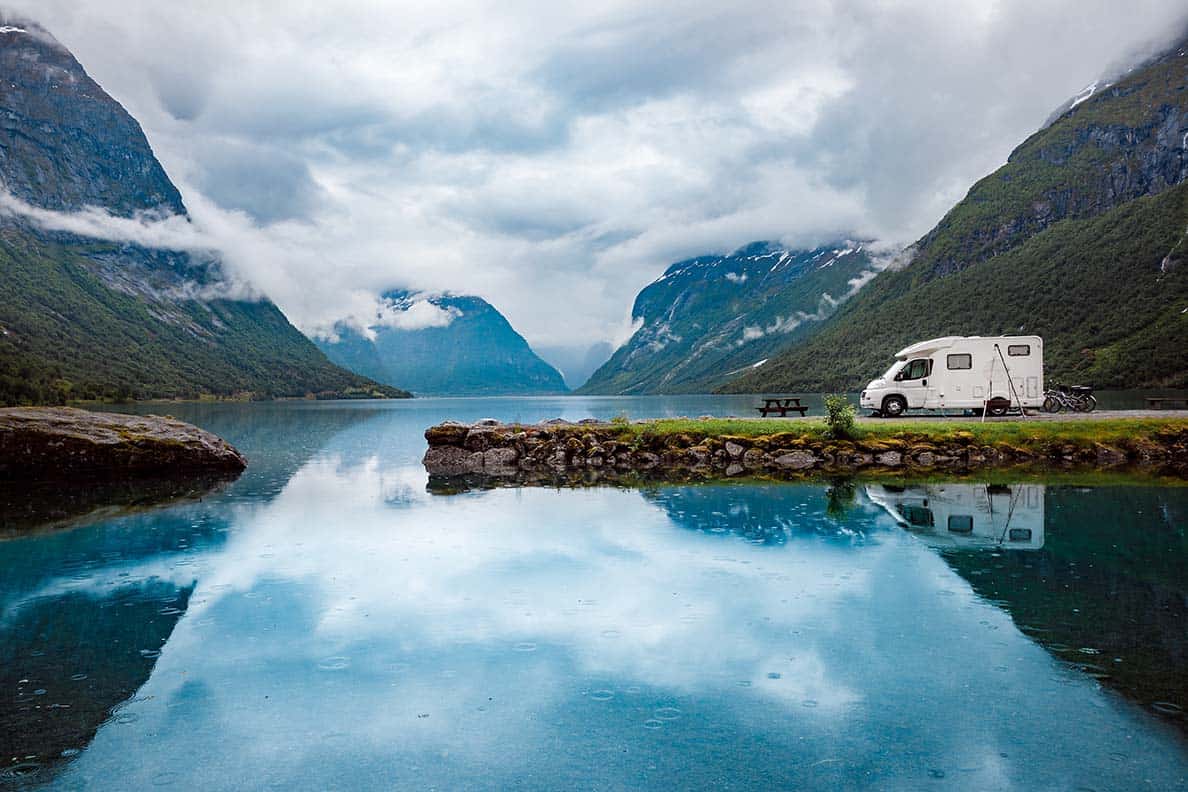
Is Norway expensive to visit? Here’s everything you need to know
Oh wow! Thank you so much for sharing with us such a great tips. I remember your tips at the time of my trip.
Amazing tips. We are planning on doing this in a few years. However we have 4 kids. Wondering if we would be able to put 2 of the kids/us in a small tent outside so we don’t have to get a massive motor home!
Great article- thank you See you on the road,
Very informative and some great tips ⭐️⭐️⭐️????
Leave a Reply Cancel reply
Your email address will not be published. Required fields are marked *
Save my name, email, and website in this browser for the next time I comment.
- YouTube Channel
- Travel Resources

Traveling Europe by Campervan: Our Tips for “Van Life Europe”
by Drifter Planet | Dec 6, 2019 | Road Trips , Most Popular Blog Posts

It has been a few years since we bought a campervan. In that time, we have driven around Europe in our van from east to west and covered many countries.
We drove to 11 different countries on our campervan, that included three national parks, mountains, and beaches as well as two music festivals .
With very little knowledge at the start of our first trip, we made a few rookie mistakes. Nothing serious but we laughed a lot at our stupidity and eventually learned how to explore Europe in our campervan-like pros.
A lot of information that we needed about traveling Europe in a campervan wasn’t really available online because most of the website focused on living in a van, versus traveling in one.
Table of Contents
Anyway, before we share our essential tips for exploring Europe by camper van, we’d like to discuss a few things to help you decide if van life is really for you, and if it is – then what kind of van you really need.
Why Should You Consider Traveling Europe by Campervan?

I’m sure you know what a typical first-timer’s Euro Trip looks like. A little bit of Paris, Amsterdam , Rome, Venice, Copenhagen , London, Berlin , Vienna, Zurich, Porto , Lisbon , Budapest, and Prague – usually all on trains and buses.
Guess what, these are really the most expensive European destinations. Moreover, the train transportation is expensive in Europe, especially in Western Europe.
If you’re on this page already, then I’m sure you’re looking for something different. Maybe you’re looking to explore the less visited and under-the-radar places in Europe that you can’t easily reach by train or bus .
The best part about traveling around Europe by campervan is that you can go literally anywhere you want.
You don’t have to worry about high internal transportation costs, schedules, and connections. It makes your itinerary super flexible and as a result, an entire layer of possibility opens up for you.

Europe is one of the best continents for road trips because of super easy border crossing.
For instance, if you start driving in Belgium, you can be in Germany, France or Luxembourg, or even the Netherlands in just a matter of 2-3 hours, and you won’t even realize that you’ve crossed the border because there aren’t any checkpoints.
Just to recap, the below points summarize why exploring Europe by campervan is awesome.
- Public transport cost,
- Super easy border crossing,
- Flexible itinerary
- Access to smaller towns, natural sites, and offbeat areas
Camper van vs Normal Van vs Caravan

Many people interchange these terms but they aren’t the same. We all know what a van is, but let me define a camper van for you.
A campervan is a van that’s specifically made for camping with a sleeping space inside. Or, a normal van converted into a campervan.
Apart from a place for sleeping, ideally, a campervan also has a place for cooking. Some camper vans also have toilets inside.

A caravan also has all of this inside or even more, but it isn’t a camper van. Just for clarification – a caravan is a wagon what you attach onto your car and drive. You can’t drive a caravan without a car that tows it.
What Kind of Van do You Need?
If you’re a couple on a budget that loves adventure, then get yourself a small campervan. A smaller vehicle will give you the advantage of letting you enter smaller lanes. Moreover, the cost of camping, toll, and parking is much lower for smaller vans.
On the other hand, if you’re a family with more than one kid, then it makes more sense to get a bigger campervan so that you have the space and comfort you need. These are the typical RVs (Recreational Vehicles) that you see in American movies.
These are further divided into Class A Motorhome (looks like a big bus), Class B Motorhome (looks like a cargo van, bigger than a truck), and Class C Motorhome (looks like a moving truck house). Normally the Class C Motorhomes are the most common campers that you see on European roads.
If you’re enjoying your retired life with your partner and driving around Europe, then get yourself all the comforts you need. Get a spacious campervan that has a nice bed, kitchen, and sitting area.

Renting a Van in Europe vs Buying
Should you buy a camper van for the purpose of exploring Europe in it, or should you just rent one? The answer depends on many factors.
If you’re visiting Europe for a few weeks or a few months, then obviously you will rent a camper van and not buy one.
However, if you’re going to travel in the van for a longer period of time (say 6 months or a year), then renting can end up being expensive. In that case, buying makes more sense. You can find vans to rent on this car rental search engine .
Buying a campervan isn’t as easy as renting one. Below are the points you need to consider before deciding whether you should rent a camper van or buy one.
- First, you need to have enough money. Campervans aren’t cheap and even if you look for a used one that’s very old, be prepared to spend at least ten to fifteen thousand euros.
- Second, buying a van comes with the hassle of paperwork.
- Third, buying makes sense as long as you’re sure you will actually end up using it enough and as long as you can sell it back when you’re done.
- Four, buying comes with the expense of insurance and repair costs – keep all of that in your mind.
If you’re a total van newbie and would like to just get a glimpse of VanLife to determine if it is really your thing, then just rent one. This will also give you an idea about what kind of van you actually need.
VAN LIFE TIPS SECTION 1: Sleeping in the Van

The best part of “VanLife” is actually sleeping in your own little home on the road and waking up to an amazing view. In reality, you won’t have an amazing view everyday, but you can at least try.
Van Life Sleeping Essentials
There are many van life aspects where you can be cheap, but your mattress shouldn’t be one of them. Invest in a comfortable mattress otherwise, you will hate your van.
If you’re not able to find a compact mattress that is easy to travel with for the size of your van bed, then just look for just a mattress topper.

Carry your pillow as per your sleeping habits. Make sure you’re carrying thin as well as thick blankets so that you are good to go for different weather conditions. European summers can be strangely hot and suddenly very cold in a matter of hours or days.
You will also need to get insulated covers to stop the condensation on the windows when it is cold, and also to keep the insides of the van cool during summer.
A silver thermal insulated window screen will also act as a black-out curtain so that you can peacefully sleep after sunrise. [Btw, the sunrise occurs around 4:30 am in most of Europe during summer.]
Don’t have an air conditioner in your van? Neither do we. We do however have a battery-operated Makita fan that works for 10 hours after a full charge.
I highly recommend this fan to you if you want to sleep comfortably during Europe’s summer heat. Summer means mosquitos, and Citronella mosquito repellant stickers will keep you safe. Plus they’re natural!
- Mattress or Mattress topper
- Pillows, blankets, bedsheets.
- Insulated window covers / Silver thermal window screen
- Citronella mosquito repellant stickers
VAN LIFE TIPS SECTION 2: Cooking in a Campervan

Apart from sleeping in it, another amazing aspect of traveling on a camper van is cooking your own meals on the road.
No, you won’t cook while you’re driving but at parking places or camping spots. We have a lot of information to share about cooking on a road trip outside and inside the camper van, so we decided to create an entire section about it.
Do You Really Need a Kitchen Inside the Van?
Not Really. If you have a travel stove and a small cylinder, you can cook outside. We have both – a stove inside the van and a smaller portable stove but we cook most of our meals outside.
Why? Well, because baby K was usually sleeping inside when we cooked our dinner and it made more sense to cook outside. It was generally more convenient to cook outside after spending most of our day inside the van.
Van Life Kitchen Essentials
If you’re building your van and converting it yourself into a campervan, then here are a few things we have in ours that are essential for any motorhome kitchen.

You will need a small countertop stove, a slot for the cylinder that’s preferably built into one of the kitchen cabinets, a sink, a small refrigerator, and multiple kitchen cabinets to store things.
It will make your life simple if you have one drawer that’s just for the cutlery, a hanging bag for plates, a cutting board, cooking oil, a kitchen tissue roll fitting, and small hooks where you can hang things.
Don’t carry a lot of kitchen dishes but only the basic stuff. Carry at the most two pots – one small and one medium-ish.
A small hand-sized nonstick pan is also a good to carry cookware. A cutting board, a big spatula (or two) for the nonstick pan and pots, soup bowls, plates, and cutlery and you’re good to go.
I haven’t seen a campervan that doesn’t have a refrigerator inside. In case yours is a van converted into a campervan, then it maybe doesn’t have a place for a fridge.
You can buy a small cooling box to store your food and use it as a makeshift refrigerator.
Your van also needs to have a small exhaust window on the top if you’re planning on cooking inside. If you don’t have a sink, then you can carry a bucket where you can keep your dirty dishes and wash them outside when you’re done.
Campervan Cooking Equipment
The stove inside your van can be a propane cooktop or even an electric cooktop. If your van doesn’t have one, then get yourself a portable stove and gas. A camping stove with 2 burners doesn’t cost double but is is surely useful so that you can boil rice or pasta on one and make sauce or curry on the other one.
If you have electricity in your van then get an electric kettle, it will make your life much simpler. An outside camping grill won’t cost much and it is surely a good to have item.
Campervan Food Essentials + Camping Meals
Simple rule – keep it short, fast, and efficient.
We ended up buying a lot of useless cooking stuff before our first trip but we realised much later that we don’t need it all. We just need enough of the basic stuff when we’re on the road. Some of the easiest meals to make on the road are pasta and rice with daal.

Buy premade pesto, sauces, and a lot of pasta to shorten your cooking time. Visit local markets and grocery stores to buy fresh vegetables to put in your pasta.
You can make a really good pasta sauce using avocados and you don’t need to cook it. Just mash avocado pulp with olive oil, garlic, lime juice, salt, and chili. Add this to your hot pot of newly boiled pasta and your epic camping meal is ready.
Cook daal and rice together with salt and a few spices – it is called khichari in India. It is a “one-pot meal ” that’s perfect for camping and it always tastes good. Instead of daal, you can also add vegetables to make fried rice. In that case, you will just have to roast garlic, ginger, and veggies for a few minutes in the pot and then add water and rice.
Just a recap, here are some awesome camping meals that you can cook in a jiffy. Most of them are vegetarian options but you can un-veganize them by adding smoked salmon or eggs or chicken.
- Pasta (raw avocado pesto, pre-made sauces, or just with veggies)
- Daal and Rice cooked together ( Khichari )
- Stuffed wraps or Burritos (Get tortilla wraps and stuff them with kidney beans, garlic, peppers, corn, jalapeños, avocado, salmon – try everything)
- Toast with bananas / eggs / avocados / cheese
- Bratkartoffeln (as called in Germany) or Aloo ki sabzi (as called in India) – potatoes sautéed in oil, garlic, chili, onions and herbs. You can add spring onion greens on top for the extra oomph. Or, meat eaters can add bacon.
- Sautéed veggies. Buy or pick fresh veggies and sauté them in a pan with oil and herbs.
VAN LIFE TIPS SECTION 3: How to Make Your Life Simpler on the Road

Alright, so you have your van, your kitchen is all set and you’re ready to go. What’s next? Most likely you have your destination picked out already. But hey, road trips are more about the journey and not much about the destination.
You will end up spending most of your time driving your van, so it makes total sense to consider the apps and tools to make your life simpler on the road.
Invest in a decent GPS Navigation system
Get one that covers all the countries in Europe – at least most of them. You will be surprised to know how some of them don’t. With a decent navigation system like TomTom , you won’t need to depend on your smartphone all the time.
Apps for Planning the Road Trip Itinerary and Route
You may have a rough idea of the route already, but you can modify it while you’re on the road using Google Maps , we discuss this in detail in the next point.
We also use an app called CamperContact , it has a database of almost every camping spot in Europe and they’re geotagged so it is easy to open the app and find a spot near you. If you upgrade the app to buy a full version, you will be able to view more details about the camping spots.
The biggest headache of driving a van in Europe is parking it. There’s an app called ParkMe , that will sort your life out by helping you find parking spots near you and how much they cost.

Getting the Most Out of Google Maps on your Road Trip
It is the most obvious app to use for road trips but not many people use all the awesome features to maximize their experience. If you know how to use Google Maps really well, you don’t need any other app. Really!
Google Maps will help you find anything around you, not just restaurants or gas stations but also camping spots.
Although there are many dedicated apps for finding campgrounds in Europe, we end up using Google Maps more than anything. Just type “camp” or “camping” in the search box and you will get a list of suggestions. You will also be able to usually see pictures, read reviews and see the prices of the camping spots.
Do you know you can search for waterfalls on your way to your destination so that you can make an epic stop? Try it. Just put “waterfall” in the search box and you will be amazed to see the result. Similarly, you can just find anything anywhere.
Want to save money and avoid toll? Set your Google Map’s navigation setting to avoid tolls and highways. It is as simple as that. As a result, your route may end up being a bit longer but will be cheaper and more scenic.
ADAC Membership Will Save Your Life
ADAC is the largest automotive club in Europe and it was founded in Germany. They have a massive fleet of mechanics on the move that help motorists. They also provide air ambulances in urgent needs.
I do not know of any single camper van or a caravan owner here in Europe who doesn’t have an ADAC membership. Not just for vans, but is for any kind of automobile as the organization helps the members in case of needs and emergencies on the road. If you sign up for a “plus membership” (ADAC Plus-Mitgliedschaft), you get services all over the world.
I am not affiliated with ADAC in any way, but I’d just like to share their details with my readers because I truly see value in this membership. You can check more details here on their website .
2021 Update : Our ADAC membership saved us. In 2021, we did a road trip to Italy and towards the end of the trip, my husband had a cliff jumping accident in Puglia . It was a very difficult time but thankfully ADAC coordinated everything for us.
They arranged for my husband’s surgery in Italy, flew our family of 3 back to Germany for free, sent a car for us to reach the airport, and also got our car back from Puglia and delivered it right to our doorstep with all the luggage inside.
VAN LIFE TIPS SECTION 4: Finding Camping Spots

While traveling in Europe on a campervan, there are three kinds of camping spots that you will find:
Paid Camping Spots
An awesome thing about traveling in Europe on a campervan is that there is no shortage of decent camping areas.
Almost every town or village has a paid camping area that’s specifically designed for motorhomes and tents and includes shared toilets, a kitchen, a bar, restaurant , a small supermarket, toilet disposal unit for vans.
Free Camping Spots
Yes, it is possible to find free camping spots too. Keep in mind that these “free” camping spots aren’t exactly beautiful. These are usually in gas station parking spots or in rare cases, even supermarkets.
As you drive along the highway in most of the countries in Europe, you will see many resting spots along the way. Usually, there is a sign that says what you can expect in that resting spot. Some of them have a fast food restaurant, a paid toilet, an overpriced gas station shop, or even a children’s play area.
Finding these resting spots that you can use for parking is very easy because they’re well-marked on the road. In any case, you can use Google Maps and park4night app to find them.
On all our road trips in Europe, we did not find much of free camping spots that were picturesque. We mostly spent a little money to park in a scenic spot and enjoy our evening in a proper camping area with all the amenities. Only the times when we had to drive till the night was when we slept in our van in the fuel station parking.
Wild Camping in Nature in Europe – Is it Possible?

Wild camping isn’t allowed in most of the countries in Europe and most likely you won’t end up doing this. You can get arrested for this in most of the instances.
So, as opposed to what it appears in a typical “VanLife Europe” Instagram post, you can’t just stop at any random scenic spot and camp in a majority of countries.
Out of all the European countries, there are just a few countries where wild camping is allowed on land that’s owned by the state. These are Spain, Norway, Sweden, Ireland, Estonia and Latvia. Even so, it is not easy to find land that’s not privately owned. We don’t encourage this because you can get into trouble for this.
How to Find the Best Camping Spots

The best part about traveling on a campervan is being outdoors. It is about finding a scenic spot, setting up the camp and enjoying being outside instead of the comfort of a hotel room. This is why I make an effort to find the best spots in the area while traveling on our campervan.
I use a combination of Google Maps, CamperContact, and Booking.com apps. Yes, booking.com also has camping spots.
I prefer Google Maps because I can zero down on an area, search for something that’s next to the river or lake (based on the satellite image), read reviews, and see pictures.
Many Campgrounds in Europe are Closed During the Low Season
How to save money while traveling Europe? Travel off-season . Ironically it doesn’t quite work out like this because most of the places are closed during the low season.
Many campgrounds close operations towards the end of September and at the beginning of October. We got a big shock while we were driving in Spain, Portugal and France in October.
We knew some places would be closed during the low season but we didn’t know everything would be. There were days when every campground that we drove to was closed for the season. That’s when we decided to just park our van in the parking area of a fast food place on the highway.
If you’re traveling in Europe with your campervan during the low season, then be sure to call your camping spot in advance to see if they’re open.
VAN LIFE TIPS SECTION 5: Avoiding Costs – How to Make Your Van Life Affordable
How to avoid toll in europe.
I had no idea how expensive the toll fee could end up being while road-tripping in Europe. There are some countries where the toll is super high (like France), and others where it is nonexistent (like Germany, Belgium, and the Netherlands).
There was one particular day as we drove from Normandy (France) to Bordeaux (France), we paid a total toll of close to 100 Euros.
It is easy to avoid the toll most of the time – just change the setting of your car’s navigation system. You can set up your navigation settings on the Google Maps app to avoid tolls and highways.
Lower Fuel Costs

A little effort and a few good driving habits can help you save a lot of money on a road trip. Not just with campervans but in general you should pay attention to how you drive and make an effort to lower your fuel costs.
Too much accelerating and pushing breaks is not good for the fuel efficiency. Drive at 60 as often as you can and on the right gear. Keep checking the air in your tyres frequently. A little drop in the air pressure can significantly increase your fuel costs.
Whenever possible, hunt for a cheaper gas station along your way and fill up the tank to 90% before it gets close to empty. GasBuddy app is great for finding current fuel costs as per your location and can help you find cheaper gas stations.
Avoid Gas Stations Along the Highways
Gas stations along the highways are way costlier than the others. A few cents make a difference and can add up to 8 – 10 Euros when you’re filling up your tank.
Most of the Western Europe is Expensive
Road tripping in France, Switzerland, and Austria is expensive because of the toll, fuel prices and camping costs. If you’re on a budget, then you may want to spend less time here or skip these countries entirely.
The Balkans are Beautiful and Affordable

I have said this before and I will say this over and over again. The Balkan countries are beautiful and affordable. The difference in costs is significant and should be enough for you to pick where to go.
I did write a very detailed Balkan road trip itinerary , and our favorite country for a road trip in that area is Bosnia-Herzegovina . If you are lucky, you may just find a beautiful camping area here like we did, and it was for free.
I also like the ease of road tripping in Croatia , as well as Montenegro . For me, the most interesting was Serbia because it is so offbeat, pretty and mysterious.
Big Cities = Parking Problem
Skip the likes of Paris, Amsterdam , Rome, Belgrade, and all the big cities.
First, parking will be difficult to find and expensive. Second, most likely there will be traffic and it will kill your mood. Third, everything is usually expensive in the big cities.
Save Money on Camping when You Can

Camping costs can be very high if you’re traveling with a big van during the peak travel period – the summer. San and I paid normally 20 Euros per night at most of the places with a small van.
The cost goes up if you have a bigger van and if you need an electricity recharging point.
Some of the most beautiful parking locations in Europe are on land that’s owned by farmers or the government. Not many of them will let you park there – unless you’re very lucky.
While I agree that camping at a scenic spot and waking up to an amazing view is the best part of van life, it can turn out to be expensive.
If you want to be smart with your money, you shouldn’t aim to find a beautiful camping spot every night. Parking your van near such scenic spots is never cheap!
From time to time, try to find free camping spots such as gas station parking areas along the highway in countries that allow like Germany and Belgium, or supermarket parking in other countries. Of course, you can only do this if none of the travelers need to put up a tent to sleep.
Save Money on Eating
If you have read this article thoroughly, then you probably know what I’m about to say, but I reiterate here: Cook your own meals to save money.
Buy fresh local produce and cook some epic camping meals to make your road trip memorable. Scroll up to the cooking sections to read about easy camping meal recipes.
Quick Country Specific Tips for Road Trips

Germany’s highways are free but most of the toilets along the road are not. If you stop at Sanifair or Serways, the toilets will be extremely clean and will cost from 50 to 70 cents.
The parking and resting stops along the highway are really big. You can normally park your van in these spots for the night to sleep.
While driving in Germany, be very careful about the traffic rules and road signs. You can stopped at many random spots for an alcohol or drug test. Even if you have not consumed drugs on the same day but consumed a week before, you can be in trouble.
Apart from Liefkenshoektunnel in Antwerp, Belgium’s roads are all toll-free. The signs are mostly in local language. Did you know 60% of Belgium is Dutch and 40% French? So expect to see the road signs in either French or Dutch but not both of them together often.
The Netherlands
The roads are very good in the Netherlands but expect congestion in summer near beach destinations such as Zandvoort. When driving in towns and cities on smaller roads, always give priority to the cyclists.
For affordable parking near cities in the Netherlands, look for “P + R” (Park and Ride) signs. You can park your van here and use the public transport to enter the city.
Of course, if you’re including a busy city like Amsterdam in your itinerary then this is where you can park and get inside Amsterdam using public transport.
Out of all the countries that we have road tripped in, France has the most expensive toll. There are really good resting stops along the highway with free toilets.
France is one of the few countries where the toilets also featured a super tiny WC for the toddlers. It was adorable and thoughtful. The only other one I saw was in Belgrade, Sebia.
When entering the highway, you will get an entry ticket at the toll station which you will have to present later at the exit toll station and make a payment. If you lose your entrance ticket, then you will be charged for the longest length – so keep it safe.
The expressway class S roads, national roads and motorway class A roads are very well maintained in Poland. However, the same can’t be said about the smaller provincial level roads. Certain A level roads are tolled.
Poland is infamous for reckless and aggressive driving behavior, so watch out when you’re there.

Many travel guides mentioned that driving in Spain can be nerve wrecking and many roads are “one-way”, but we did not face any challenge ever.
With the help of our GPS and Google Maps, we thoroughly enjoyed driving in Spain. Not just along the coast but the landscape was spectacular even in the middle of the country.
Spain completely lifted our spirits up when we arrived here form dull France. The weather was petter, people had massive smiles on their faces, the food was more flavorful, and things were affordable.
While in Spain, we loved stopping in small Spanish towns and visiting the coffeeshops / bars for a quick snack and drink. Eating and drinking in Spain was generally affordable for us as compared to France and Germany.
We were warned by many about watching out for erratic driving behavior in Portugal but we did not encounter any. The experience of driving through small Portuguese towns, from the mountains to the coast was beautiful.

When in Portugal, make sure you stop at smaller road side bakeries and try the famous custard tarts / egg tarts (pastel de nata). I talk about the egg tarts in almost all of my blog posts from Portugal.
Driving in Slovenia was a good experience for us because of the road condition and landscape. Be sure to get a vignette as soon as you enter Slovenia. You can get is from a gas station and it comes out to around 15 euros per week (2019).
Croatia has highways that connect the major cities and they are not free. Upon entering the roll road, you will get a ticket. You will need to present this ticket at the time of exiting the toll road. The toll fee isn’t expensive in Croatia. The Croatian highways have frequent rest stops and some of them also have play areas for children.
When in Austria, you need to get a vignette – failing which, it can get very expensive. The vignettes can be bought in gas stations in Austria as “Vignetten” for 10 days €8.90. If you’re just driving through Austria and not staying, then get a Korridor-Vignette instead. It is valid for a single trip for €2 or a round trip for €4.
If you’re caught driving in Austria without a vignette, it will end up being very expensive for you. It starts with a little over €100 and can go up to €300 on the second day if the fine is unpaid. Post that, valuables can be seized from your car.
The vignette needs to be stuck on the windshield to be valid, preferably in the top centre or the driver side corner. Do not share the vignette with anyone otherwise you will have to pay a very high fine.
Switzerland
Switzerland has some of the most beautiful roads for driving in Europe. Just like Austria, you need to buy a vignette to drive on them, failing which can end up being very expensive for you.
Watch your speed while driving in Switzerland because there are many areas that have speed cameras after every 2 kilometers. Believe it or not, you can be literally thrown into the jail for speeding. Your driver’s permit can be revoked if you’re caught driving 20 KMs per hour more than the allowed speed limit.
Bosnia & Herzegovina
We have driven twice in Bosnia & Herzegovina (B&H) and it was a memorable experience. While driving in B&H, we have been warned not to leave the paved road for even a toilet break because of the threats of landmines.
The country is beautiful and affordable but don’t expect the very good roads. Our best driving experience in B&H was along the river Drina.
Europe by Campervan itinerary ideas – Some of Our Favorite Routes

Nature trail in the Balkans
This is our favorite road trip itinerary for road tripping in Europe and is mostly around the Balkans. This itinerary starts in Croatia where you can start in Zagreb or Pula or Plitvice Lakes . From there, this itinerary goes from one natural paradise to another in Bosnia & Herzegovina , Serbia , Montenegro , Albania, Bulgaria, Romania and the Balkan countries. This trip also includes many national parks. You can find more details here in my post about this epic Balkans road trip itinerary .
Germany’s themed routes
Germany has many themed routs that road trippers will love. There’s the famous “romantic road” that most of us have heard of but do you know there’s also the fairy tale route, a castle road and a wine route? We have a post about Germany’s themed road trips on our website, check it out.
Portugal and Spain
Our second visit to Portugal and Spain was in 2019 with our new camper van. We actually started from Germany and crossed Belgium and France but the best part of our road trip was in Spain and Portugal. We suggest you start in Zumaia (Spain), and from there drive along the coast the Galicia area. Make sure you include Valdovino and Playa del Silenco in your itinerary.
From A Guarda in Spain, you can drive to Portugal’s coast starting from Afife, Porto, Vagos and Figueira da Foz. From there, you have an option to continue along the Portuguese coast to Lisbon, or you can drive to the middle of the country to see the mountains in Serra da Estrela Natural Park. From here, you can enter Spain and spend some time in the Salamanca area.
Check my blog over the next few weeks because I aim to publish an epic Spain – Portugal road trip post.
The Best of the Netherlands
The Netherlands is an amazing country to cover on a road trip, especially if you don’t have a lot of time in your hands. The Netherlands is small as compared to many other European countries. We have a post about amazing places to visit in the Netherlands with an itinerary suggestion that starts from Belgium or France. We have another post with a suggested road trip itinerary for Netherlands that includes a few offbeat places.
Northern France Coast – Normandy to Bordeaux
The route from Normandy to Bordeaux in France is lovely and you will get to see some amazing natural and architectural attractions. You don’t necessarily need to stop at the starting and ending big cities. Instead, make a stop at Etretat, Honfleur, Mont Saint-Michel, and a few other small towns of your choice along the way.
Ireland’s Wild Atlantic Way
Driving along Ireland’s Wild Atlantic Way is surely the best route in the country for a road trip. The best part is that it can be modified in many different ways. We did a road trip that started in Kerry, then went on to Westport , Achill Island and Ballina in Mayo County.
East Bohemia in the Czech Republic
Prague isn’t the only destination in the Czech Republic but there are many other picturesque smaller towns, castles, and natural attractions that are worth a visit. Start at Pardubice , then head to Sec to relax in the nature and enjoy the viewpoints, next – head to Litomysl and explore the art scene and end your trip in the magical Svojanov where you can get a break from camping and sleep in a castle.
Tuscany to Selento (Italy)
Drive from Central Italy to South Italy’s beaches. Start in the Tuscany region, which is known for picturesque landscapes and historical art scene. It is where the Italian Renaissance art scene began and spread all over. From here, you have an option to drive to Rome or head to Monti Sibillini National Park and move towards the coast. We recommend the latter because the more you drive, the more you would want to avoid entering big cities.
From the Sibillini mountains, you can make your way to Selento by making stops at small fishing villages on the way such as Termoli, Trani – or find your own new destination.
The Dolomites in Northern Italy
Drive around Northern Italy’s little villages up in the Dolomites. You can start this trip in Verona and make your way up to Trento, Alpe Cimbra , Val di Non . This area looks really beautiful in spring because of apple flowers. You can also stop at the lovely Lago di Tovel – a stunning clear lake that’s surrounded by the mountains.
Many Italians say that North of Italy isn’t the “real Italy”, but this trip is about nature. To enjoy the best of Italy’s culture, make a trip to South of Italy.
Austria & Slovenia
Explore the Alps and spectacular alpine lakes. Start in Austria’s Salzburg from where you can go to Mondsee or Ebensee lakes. Next, visit Hallstatt, then Slovenia’s Lake Jasna, Lake Bled and finally Lake Bohinj. Lake Bohinj is spectacular and you can camp right next to it in Camp Zlatorog Bohinj.
Final Thoughts about Travelling Europe in a Van
Living in Europe, we have tried multiple ways of exploring this continent. We have used buses, trains, hopped on to budget flights and also backpacked across Europe, but nothing compares to road tripping.
The experience of t ravelling around Europe by campervan opens up a lot of possibilities in terms of accessing destinations that are not served by public transport.
Greg Anderson said that one should focus on the journey and not the destination. This quote applies really well to the Van Life experience. It is truly about the journey.
So, are you interested in driving around Europe in a van too?
Did follow our campervan travel tips or are you living the Van Life?
Tag @drifterplanet on Instagram and hashtag it #drifterplanet . We will be happy to share your journey with our audience.
PS: Drifter Planet contains affiliate links. If you make a purchase through these links, we will earn a little commission at no extra cost to you. We are a participant in the Amazon Services LLC Associates Program, an affiliate advertising program designed to provide a means for us to earn fees by linking to Amazon.com and affiliated sites.
Related Posts:
![30 Amsterdam Travel Tips that are Ridiculously Helpful [Tried and Tested] Amsterdam travel tips - things you need to know before traveling to Amsterdam](https://drifterplanet.com/wp-content/uploads/2017/07/Amsterdam-travel-tips-things-you-need-to-know-before-traveling-to-Amsterdam-150x150.jpg)
13 Comments
I found your website very helpful as I plan my family’s summer camper van getaway. I do have a question about stickers that I may need for the vehicle as I enter different countries. We are planning on Poland, Latvia, Lithuania and Estonia. Any info for where to find that out would be great! Thanks, S
Great ! I have a future plan of visiting Europe by campervan. I’m Eduard from Romania, I saw that you haven’t been here and I tell you it’s a pity ! You should visit sometime also Romania, you won’t regret it !
I have been to Romania in 2018 and I have quite a lot of blog posts about it on my website. 🙂 You can find them under “destinations”
Hi there! I am in love with this article! I do have a question. I want to live on the road. So literally ten years or so be vanlife 100%. How do I as an American, buy a vehicle that I can KEEP.? Everyone does the buyback in 2 years thing but we don’t want to return it we want to keep it and keep traveling. Every country with requirements says you must have residency.
hi there! we will be traveling to germany, austria, swiss , france and netherlands via a RV.
any suggested route u think we should be going ?
Excellent stuff, I am also planning to retire in Europe and will need a Campervan
Great post for europe traveling. Thank you so much for sharing.
Glad you liked it. Yes, the best way to travel within Europe is by van or a camper van.
Really appreciate your elaborate details, which I found to be very useful.
We are relatively new to camping and traveling in campervans. My family includes myself, wife and toddler son of 2 years. Our only camper van experience have been in last July when we made a 12 days ring road trip in Iceland in a motorhome. Now we are planning a 15 days trip in Europe starting end of April. Vienna-Prague-Salzburg-Munich-Luxembourg-Paris. My question is, in your opinion, is this route safe for family travelers? Can I find camping spots (paid ones) easily in this route? or is it far away from each other? What’s your advice when we approach cities? Shall we opt for a parking spot on the outskirts of the city and travel by rent a car in the city? Any other things that we needs to take care of? please advice.
Hi Jithu, wow a road trip with a camper van in Iceland sounds really good. I do like your 15-day itinerary but in my experience driving in those big cities that you just mentioned, isn’t so easy with a van. You will have to find paid camping spots that are a little outside. We did drive through some big cities like Paris but the experience was horrible because of the traffic and lack of parking spots to even get out to eat in a restaurant. Of course, things are different if you have a small car but not with a camper van. So, with that experience, I’d suggest you park outside the bigger cities and use public transport or a bicycle with a child carrier to explore the cities. Or, just avoid the cities and pick smaller towns or national parks.
Thanks a lot for your valuable comments dear 🙂
Hello Drifter Planet,
This article is very useful. We are a couple planning their first 2-weeks rented camper van trip starting in Munich, to Berlin, Prague, Budapest and Vienna, returning to Munich towards the end of October. Would it be worth getting the insurance you mentioned?
Also, you say that many camping sites may be closed, so the alternative could be Gas stations in Germany or supermakets elsewhere. The question is if it is safe to spend the night in those parking lots, and also what to do about the electricity and also the waste disposal… Please let us know your thoughts. Thanks for your advice (we may have other questions as we get closer to the date).
There should be an pate to this excellent information. These days there are many Low Emission Zones, Congestion Charging & Urban Traffic Restrictions in Place within Europe. For example in France every vehicle has to have a Crit’Air. Both Spain and France cities/towns with relatively small populations will be implementing low emission zones. Rules are confusing and there is no single standard. In Europe vans that are registered as commercial vehicles often have lower speed limits imposed on them over vehicles registered as Camper Vans.
Submit a Comment Cancel reply
Your email address will not be published. Required fields are marked *
Pin It on Pinterest
Last Updated on May 30, 2024 by Drifter Planet
Select your country preferences
Camper Van Rental Europe
Roadsurfer camper van rentals in europe.
Camper vans are the smallest, most compact RV type – perfect for vacations that include city trips. They’re easy to drive and park, which makes them very popular among beginners as well as camping experts. Even small, winding country roads and old European cities with narrow streets are easy to navigate with our camper vans. Ready to plan your European adventure? Book your camper van in Europe today!
Meet Our Camper Van Fleet
Enjoy both maneuverability and comfort with a camper van rental from roadsurfer. Thanks to its compact size, you can go on your European adventure with maximum flexibility. Here’s an overview of our camper van models:
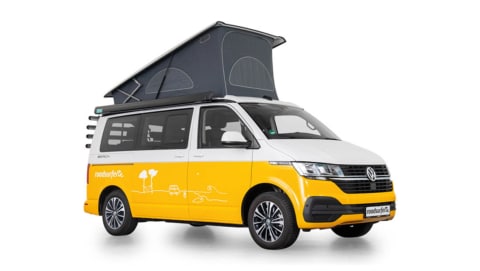
Beach Hostel Class B RV | VW T6.1 California Beach
- 150 hp diesel engine
- Big bed (whole vehicle width)
- Slide-out kitchen
- Manual pop-up roof
- Rear parking sensors with camera
- Cruise and distance control ACC, GPS
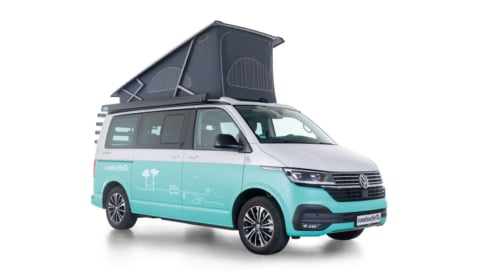
Surfer Suite Class B RV | VW T6.1 California Ocean
- Integrated kitchen
- Outdoor shower (cold water)
- Automatic pop-up roof
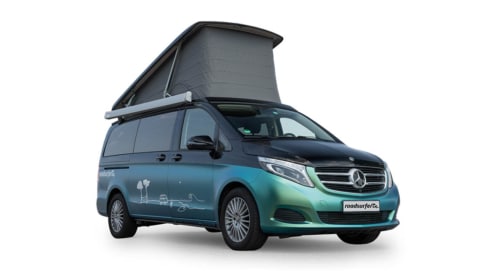
Travel Home Class B RV | Mercedes Marco Polo
- 163 hp diesel engine
- RV trailer hitch
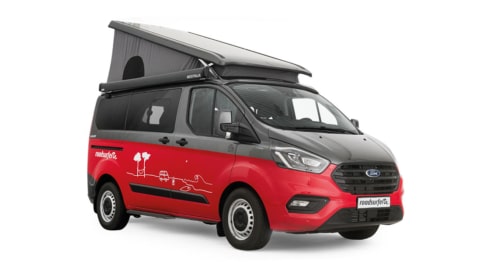
Camper Cabin Class B RV | Ford Nugget
- 170 hp diesel engine
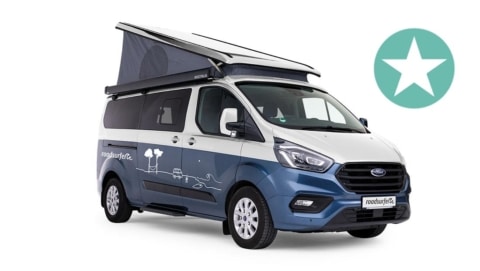
Camper Cabin Deluxe Class B RV | Ford Nugget Plus
- Tow hitch & Rear parking sensors with camera
Your roadsurfer Benefits
Rent a fully equipped roadsurfer camper van or RV and enjoy the ride with exclusive benefits. Your freedom on the road starts the moment you pick up the keys!
Brand new, fully equipped camper vans & RVs
Unlimited mileage & free 2nd driver
Rebook or cancel with the Flex option up to 48 hours before departure
Camping equipment & kitchen utensils included
Roadside assistance
Trending Destinations
Rent your camper van at one of these trending destinations in Europe today. Your next adventure awaits! Here’s an overview of the most popular countries with roadsurfer camper rentals:
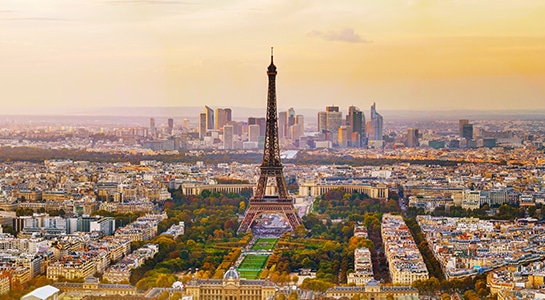
Camper Van Rental France
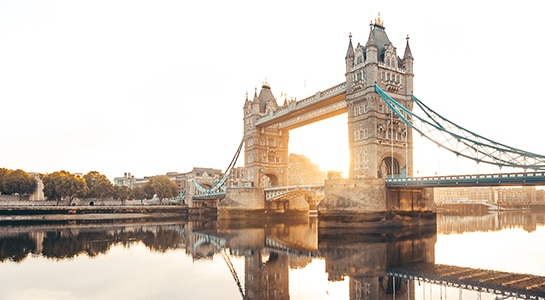
Camper Van Rental UK
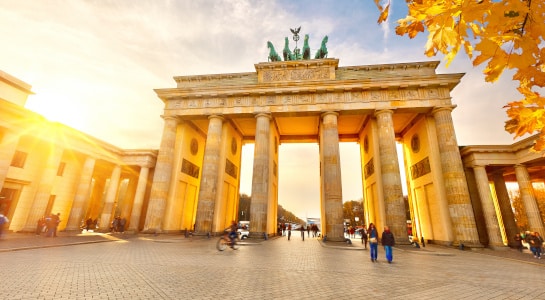
Camper Van Rental Germany
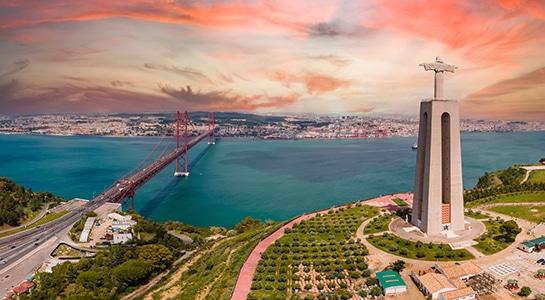
Camper Van Rental Portugal
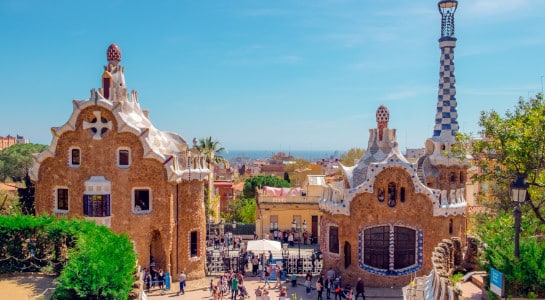
Camper Van Rental Spain
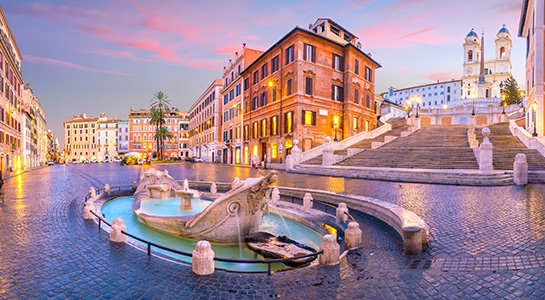
Camper Van Rental Italy
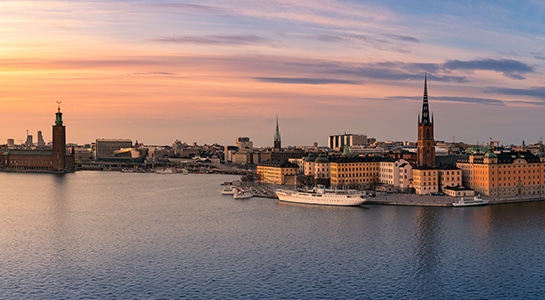
Camper Van Rental Sweden
Camper Van Rental FAQs
Our camper van rentals start at 65 euros / per night.
Please note that prices shown are subject to change and may vary depending on the time of travel, booking period, and pick-up location. Typically, the earlier you book, the more money you’ll save.
Please note that the minimum rental age requirements vary depending on the rental country. Here’s an overview:
Europe (not including Ireland): Drivers must be at least 18 years old and have one year of licensed driving experience (driving license class 3 or class B)
United Kingdom: Drivers must be at least 25 years old and have two years of licensed driving experience (driving license class 3 or class B)
USA, Canada, and Ireland: Drivers must be at least 21 years old and have one year of licensed driving experience (driving license class 3 or class B)
Bookable Extras

Our included RV camping package will make sure you have the perfect foundation for your next trip. For everything else, there’s bookable extras. You need extra camping chairs, a bike rack, or a portable camping toilet? We’ve got you covered:
Rent your camper van in Europe today!
Roadsurfer camper & rv rental.
- Popular RV Rental Destinations
- roadsurfer Camper & RV Fleet
- RV Rental California
- RV Rental Nevada
- RV Rental Canada
- RV Rental England
- RV Rental France
- RV Rental Germany
- RV Rental Ireland
- RV Rental Italy
- RV Rental Netherlands
- RV Rental Norway
- RV Rental Portugal
- RV Rental Scotland
- RV Rental Spain
- RV Rental Sweden
- RV Rental UK
- RV Rental USA
- RV Rental Europe
- Liberty Lodge Class B RV Rental
- Couple Condo Class B RV Rental
- Horizon Hopper 4x4 Class B RV Rental
- Family Freedom Class C RV Rental
- Surfer Suite VW Camper Van Rental
- Beach Hostel VW Camper Van Rental
- Travel Home Mercedes Camper Van Rental
- Camper Cabin Ford Camper Van Rental
- Road House Sprinter Van RV Rental
- Family Finca Sprinter Van RV Rental
- Couple Cottage Sprinter Van RV Rental
- Camper Castle RV Rental
- RV Rental FAQs
- Vehicle Instructions & Explanatory Videos
- RV Camping Equipment
Sign up now and get a special discount
Receive exclusive tips on routes, camping spots, and much more!
For information on how roadsurfer handles your data, please refer to our Privacy Policy . You can unsubscribe at any time free of charge.
Hi, how can we help you?
- I want to change my booking
- I need information about the vehicles and/or equipment
- I need help operating my camper van or RV
Help & Support
Kontaktformular
Mo-Fr von 9:00 bis 18:00 Uhr: +49 (0)89 2154 1673
Language & Currency
Change language
Change Currency
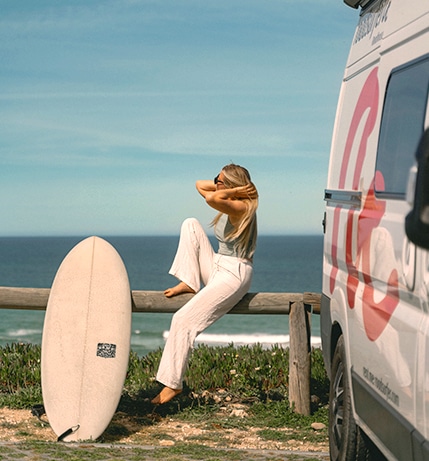
Late summer deal
Extend that summer feeling:
Chase the sunshine and experience unforgettable outdoor camping adventures! Sign up for our newsletter now to get 5% off your late summer getaway.
- Country of residence * Select United States of America Austria Canada Denmark France Germany Italy Ireland Netherlands Spain Sweden Switzerland United Kingdom Other

The Holiday Road Network
The top 20 motorhome routes.
Here you will find the 20 most beautiful and most travelled routes and their best sights. No matter whether you want to be on the road for just a weekend or several weeks.
Would you like some more inspiration? You will find many more routes in the country selection.

Brittany Road Trip by Motorhome
Discover one of the best-organised areas for travelling by campervan or motorhome in France. Let yourself be surprised by a varied landscape and numerous charming seaside villages where you can enjoy the culinary specialities of the region.

Harry Potter Filming Locations Scotland
Explore the iconic filming locations in Scotland on this motorhome tour. From various lochs and locations in the Scottish Highlands to the famous Glenfinnan Viaduct and many places in Edinburgh, you will always feel the Magic of Harry Potter.

Harry Potter Filming Locations England and London
Following the story from one of the most notable and popular series of books and films enjoyed across many generations, this tour will take you through many of the iconic filming locations within England that paved the way to creating the magical world of Harry Potter.

Ireland’s Wild Atlantic Way Route
One of the most striking coastlines to travel, Ireland’s Wild Atlantic Way stretches over 2,500 kilometres from the tip of County Donegal down to County Cork. Discover breathtaking landscapes and cultural highlights by motorhome and stay at the most beautiful campsites.

German Alpine Road
The German Alpine Road runs for 484 kilometers from Lindau on Lake Constance to Schönau am Königssee. The oldest holiday route in Germany offers driving pleasure, grandiose views and connects the most famous sights of Bavaria with each other: This makes it one of the most popular travel destinations in Germany.

The Peak District Circular Route
Located at the heart of England the Peak District countryside runs across the borders of 4 counties: Derbyshire, Yorkshire, Staffordshire, and Cheshire.

Romantic Road
A triad of nature, culture and hospitality has been the hallmark of the Romantic Road since 1950. It is the best known and most popular German holiday route and runs from the river Main to the Alps.

Lake District Highlights
A beautiful National Park in the northern region of Cumbria, England. A popular holiday destiniation that draws visitors with its scenic lakes, tarns and dramatic fells.

Camino del Cid
Exciting battles, medieval knights, epic songs and much more. On this route you will explore the same path travelled by the legendary Cid, mythical character of the Reconquest, only you will probably be comfortable in your motorhome, enjoying the music and not getting lost with the help of a navigation system. Explore the old Islamic kingdoms, the cultural and natural heritage in the ancient no man's land, conquer Valencia and defend the south from a beautiful campsite overlooking the sea.

Cotswolds & Surrounding Area
At almost 800 M 2 the breath-taking Cotswold countryside runs across the borders of 5 counties: Gloucestershire, Oxfordshire, Warwickshire, Wiltshire and Worcestershire.

Route of Rhine Romanticism
The Rhine Valley, one of the most beautiful landscapes in Europe, has over 2,000 years of history and countless legendary stories.

Loire Valley Castles
Embark on an enchanting journey to the castles of the Loire Valley in your motorhome. From shining Orléans to charming Nantes, each stop is a chapter in the history of French monarchy. Discover the majestic cathedral of Orléans, explore the Renaissance in Amboise, be enchanted by the narrow streets of Tours and marvel at the splendour of the castles of Huismes, Saumur and Angers.

Marguerite Route
Whether it's the wild North Sea or the peaceful Baltic Sea, with 7,300 km of coastline and almost 500 certified, dreamy campsites, Denmark offers the best conditions for a successful holiday.

Grand Tour of Switzerland
Switzerland offers an enormous variety of experiences and a breathtaking landscape: Admire the mirroring of the unique Alpine panorama in turquoise lakes.

Moselle Slate Road
The Moselle Slate Road leads through a varied and charming landscape. Through vineyards on the lovely Moselle, across the volcanic landscape with the connected volcano park to the heights of the Eifel.

German Fairy Tale Route
„Take me with you to your bed," says the spooky frog. The fact that it is kissed is probably the greatest mistake in Grimm's fairy tale history.

German Wine Route
Gentle wine country, lush orchards, the Palatinate Forest with quiet valleys and murmuring brooks and a Mediterranean climate - that is the German Wine Route.

Green Road/Route Verte
The Green Route encompasses three regions in two countries and offers travellers thematic offers that are attractive without borders: the winegrowing in Alsace and Baden, the culinary "stars" and "étoiles" of the region on both sides of the Rhine and the scenic beauties and differences.

German Half-Timbered House Road
The German Half-Timbered House Road - one of the most important holiday and cultural routes. This was established in 1990 when the establishment of the first regional route “Von Hann. Münden to Alsfeld ”was launched.

Austrian Romantic Road
14 enchanting towns and villages have joined together to form the Austrian Romantic Road. Away from the motorway between Salzburg and Vienna, castles, palaces, museums, monasteries, mountains and lakes are waiting to be discovered.

German Volcano Route
Mighty volcanoes and magical maars - experience the fascination of geological history in the Vulkaneifel.

UNESCO World Heritage Routes Germany
Only the best among the outstanding testimonies to human and natural history are allowed to bear the title of UNESCO World Heritage. And you will find many of the best in Germany.

Baden Wine Route
There are many ways to cross "Germany's most beautiful corner of pleasure" - but hardly any more enjoyable than by car, motorhome, bicycle or on foot along the Baden Wine Route.
Routes by Countries

United Kingdom

Switzerland

- Legal Notice
- Privacy Policy
- Terms of use

Motorhome owners are being penalised for the actions of an anti-social few
“Home is where you park it”, is a popular phrase among the often obsessive motorhome and campervan community . For my husband and I, who have enjoyed exploring Britain and Europe by road for many years, that’s the beauty of owning our beloved Fiat Auto-Trail. With a bit of planning, we’re able to park up in new places, whenever and wherever we choose, with everything we need contained within our home on wheels. While it appears idyllic – and often is – the reality is not always as straight forward, especially in England and Wales.
Wild camping and free-to-use Aires – official designated areas set aside for motorhome and campervan stopovers – are commonplace in Europe and widely accepted by locals, but very few exist in Britain.
On top of that, and with numbers on the road rising, motorhome and campervan owners have suffered from a less than glowing reputation in recent years.
The majority of us motorhome owners are considerate and adopt a “leave no trace” policy at the places we park up. We also try to contribute to the local economy, by eating and drinking in local pubs and restaurants, and happily paying parking fees. Not everyone is so thoughtful.
Anti-social behaviour among the minority is an issue that has seen a crackdown on motorhoming in Britain. In 2020, Pembrokeshire Council started carrying out patrols and issuing fines to illegally-parked vehicles, with other councils considering similar steps. More recently, in March this year, Lancashire County Council approved new rules banning motorhomes from overnight parking along the promenades at the coastal towns of Lytham and St Annes after “years of complaints” about the visual impact and the space vans occupied. Any motorhome user flaunting the law risks a Penalty Charge Notice and a fine of £70.
For an obliging motorhome owner, it can feel unfair that we’re being penalised for the actions of a few. I’ve never emptied my toilet down a road drain, nor driven off leaving rubbish behind. And I’m not alone. Marie Ellis has been motorhoming for six years, travelling in Europe and Britain. “One of my greatest annoyances is the, ‘You paid £70,000 for a motorhome and now you won’t pay to park’ attitude,” she says. “Many folks like us didn’t pay anywhere near that and are 100 per cent happy to pay for what we need. But most of the time that doesn’t mean an expensive campsite.”
Christine Walker, 58, from west Wales, also flinches at the disdain motorhome owners face. She and her partner spend six months a year in Europe, splitting their time between official Aires and places they’re welcome to camp, always trying to give local businesses their custom. “I hate the term ‘freeloaders’, which is frequently used in Britain,” she says. “It would be fascinating to see some robust research into the impact of motorhomes on the rural economy in Britain. We definitely have a strange attitude [in Britain] – particularly the expectation that we all should be happy to be herded into campsites.”
Despite their defence of the law-abiding motorhome community, both Ellis and Walker admit they’ve witnessed the kind of behaviour that gives vanners a bad name. “I live in an area where people wild camp,” says Walker. “The majority behave, but a friend posted a photo recently of toilet paper left all along a footpath next to where the vans park. If we had to put up with that sort of thing on a regular basis I would vote to ban [motorhomes] from parking here.”
With the trend for owning a touring vehicle showing no sign of slowing down, frustrations and tensions are only likely to grow. Statistics vary on the number of motorhomes and campervans on British soil. However, figures from 2022 suggest that there were an estimated 755,000 touring caravans and motorhomes regularly in use in Britain. This figure is forecast to grow to 889,466 by 2030 – an increase of 18 per cent.
The rising cost of campsites is cited as a reason for the growth in motorhomers “wild camping” in British town centres and car parks – an issue that’s less of a problem in Europe where Aires are more common and are, typically, free to use (with the occasional nominal fee for services).
“In other European countries you don’t really need to wild camp,” says Ellis. “There are so many free and low-cost places to stay. We don’t feel the need to park in a layby.”
“Sadly, Britain seems to have a strong anti-motorhome attitude, and fails to see the benefits that Aire-style facilities can bring” adds Walker. “Campsites have their place but are not for everyone. We can choose between hotels and B&Bs, so why can’t campsites and Aires exist harmoniously side by side?”
Increasing the number of Aires in Britain is the goal of Campaign for Real Aires UK (CAMpRA). For president Donald Macdonald it’s an easy and ideal solution for all involved. “People have different aspirations for a holiday,” he says. “This is a group of people that should be welcomed – we want accredited, properly worked out, accessible Aires, where people can park their vans and shop locally, be entertained locally, and eat locally, rather than being isolated four or five miles out with no facilities.”
Some parts of Britain are already embracing the idea. In the Scottish Highlands , a new voluntary scheme allows motorhome and campervan owners to buy a £40 weekly pass to contribute towards the cost of tourist infrastructure. On my travels I’ve discovered other smart ideas put into practice, from car parks with dedicated spaces and payment rates for overnight stays. Canterbury’s Park and Ride is one place that gets a big thumbs-up from motorhomers, offering basic facilities for £7 overnight, with a free bus into town.
“I think we’re at the cusp of people – landowners, car park owners – realising there’s an opportunity here for local businesses to actually make money,” says Macdonald. “This is a problem that has a solution – and it’s very simple and achievable.”
For further inspiration, read our guide to pubs with car parks that are open to motorhomes and campervans
Sign up to the Front Page newsletter for free: Your essential guide to the day's agenda from The Telegraph - direct to your inbox seven days a week.

Disappointing photos show what it's really like to backpack across Europe
- I spent two weeks backpacking through Europe for the first time in October 2022.
- I found that it wasn't the glamorous, romantic adventure that it often looks like on Instagram.
- While backpacking, I was disappointed by overnight train rides and crowds of tourists in each city.

With a passion for fashion, traveling with just a backpack never appealed to me before 2022. There were always too many things I wanted to pack.
But since I began traveling more as a travel reporter for Business Insider three years ago, I've realized I needed to lighten my load to make it easier to hit the road for longer periods of time.
I made the minimalist travel style a priority in August 2022, when I spent a week backpacking for the first time through Eastern Canada. It turned out to be a lot easier — and more efficient — than I'd originally thought.
So when I planned a two-week train trip through four European countries two months later, I decided to push myself to fit everything I needed into my backpack again.
Over the course of two weeks, I backpacked across Germany, Austria, Italy, and Switzerland while exploring the cities of Berlin, Vienna, Venice, Rome, Milan, and Zürich. It was my first time visiting each country and backpacking in Europe .
As part of my travels, I slept in shared train cabins and budget Airbnbs , and initially, I felt like I was living the life of young adults on a gap year, or post-college students on a big adventure.
But I quickly realized it wasn't as glamorous as I expected it to be based on stories I'd heard from other people, or more commonly, pictures I saw on social media.
On Instagram, I've often seen epic photos of an empty nature scene save for the backpackers with a caption about life being an adventure.
But after backpacking Europe myself, I found that the travel style was full of hardships I rarely see posts about.
First, I found that my biggest backpack couldn't squeeze in all the clothes I wanted to bring.
I picked the largest bag I own — a 32-liter backpack — for my trip to Europe.
I wasn't sure how well this bag would work for a two-week trip, so I practiced packing as lightly as possible to ensure I could fit everything.
I started with my work gear, which included a laptop, cameras, lenses, and a notebook. Then I packed chargers, toiletries, and snacks before realizing my work gear and other essentials were taking priority over clothes.
I was hoping to bring two packing cubes full of clothing, but I could only fit one in my bag. This cut my proposed wardrobe in half. I ended up only having room for two polos, one T-shirt, one long-sleeve T-shirt, three pairs of pants, a sweater, a blazer, a dress, and two light jackets.
Although I impressed myself by packing lighter than I ever had while still having everything I needed for the longest trip I'd ever taken, I couldn't help but feel disappointed in my limited outfit choices.
Because I could only bring a few garments, I had to do laundry at nearly every accommodation.
I've never seen a backpacking social media post about doing laundry, but I found myself washing my clothes at nearly every Airbnb I stayed in.
I stayed in each accommodation for just one or two nights, so to ensure my clothes would be dry before checking out, I had to prioritize doing laundry as soon as I checked in.
I brought my own laundry soap and used sinks and bathtubs to wash each garment before hanging them up to dry.
This was a bummer since I often arrived at each accommodation feeling exhausted from travel, and washing my clothes was the last thing I felt like doing.
Coming home to tiny Airbnbs with wet clothes everywhere stressed me out after a day of exploring.
From a converted wine barrel outside Zürich to an Airstream trailer in Vienna , most of my Airbnbs were tiny homes with less than 100 square feet in size. So even a little bit of clutter made them look messy to me.
I also thought having my clothes hanging to dry made the spaces feel even more chaotic.
Each time I returned to my accommodations, I was greeted with a disheveled space that made me feel stressed out. Since I work hard to keep my apartment looking spotless at home, I wasn't used to living in a cluttered space. I found it hard to relax in these rooms after tiring days of exploring.
I thought a sleeper train would be a smart way to arrive in new cities and maximize my time, but these shared cabins felt cramped and uncomfortable.
I booked two overnight trains during my trip. I thought this would be the best way to travel through Europe so I could explore more during the day.
But the small, uncomfortable spaces I had to travel in for long periods of time made it hard to sleep.
To get from Vienna to Venice, I booked a bunk in a shared cabin on an overnight train run by Nightjet, a rail line that operates overnight routes between Austria, Italy, France, and the Netherlands.
Since I booked a shared room with up to five other people, I expected to feel a little cramped, but I anticipated being able to move around the room freely.
However, I found that the 74-square-foot cabin didn't feel like enough space for myself and the other travelers, especially with everyone's luggage. Our cabin only had four people in it, and I thought it would have been even more uncomfortable had it been fully booked with six people.
There was space for bags above the beds, but not enough for everyone. I couldn't do much more than sit in my bunk and quickly became disappointed by my choice to travel in this way.
I was also surprised by the lack of privacy inside the shared bunk cabin on the train.
Before my trip, I imagined that each bunk in the shared cabin on the sleeper train would have a curtain for privacy. However, the beds were completely exposed, so I had to go to the bathroom to change into my pajamas privately.
I also had to wake up another traveler using the top bunk in the middle of the night to use the bathroom since the room's lock was only accessible from their bunk.
After this experience, I don't think I'll ever bunk with strangers on an overnight train again, especially since some Nightjet routes have private cabins.
"Offering our passengers a high level of travel comfort is an important concern for us," a representative for ÖBB Nightjet told BI. "We are constantly working on improvements to our product and also take into account the requirements of our customers."
But I thought my experience was even worse on the other overnight train I took where I booked a regular seat and didn't sleep at all.
On my other overnight train from Berlin to Vienna, I had an even harder time sleeping. I sat in a seating carriage room with six seats facing each other, which is Nightjet's version of standard coach seating.
During my leg of the journey, three travelers were already there when I boarded, and two others arrived within the first few hours. Right away, I thought the room was cramped and lacked enough legroom for each traveler.
The seat appeared slightly wider than a typical train coach seat, with two cushions, and reclined far enough to almost lay flat, but not fully. I reclined mine all the way, but I thought the gap between the seat back and the bottom of the seat made it tough to get comfortable.
When I tried to sleep, I found it impossible with the constant bumps on the ride and so many people around. I ended up staying up until the morning and regretted traveling overnight.
"The quality of travel depends not only on the carriages, but also on the route," OBB Nightjet wrote in a statement to BI. "We recommend the sleeper or couchette car for night travel. There is enough space to stretch out. Seated carriages are recommended for shorter journeys."
While some influencers might like this type of travel, next time, I'll stick to daytime routes if I can't sleep flat on a bed in a private room.
I often arrived in each country feeling exhausted from lack of sleep, which made it harder to enjoy my time in each place.
Because I had so much trouble sleeping on both overnight train rides, I often arrived in a new city feeling tired and depleted instead of excited and ready to start exploring.
When I got to Vienna at 7 a.m. after a sleepless night in the seating carriage, I was so exhausted that I looked for any hotel that would take me in so early in the morning. I thought this made the overnight ride ultimately not worth the time saved since I didn't do anything when I arrived other than sleep.
And when I got off the train in Venice, while I had enough energy to explore since I got some sleep in the bunk, I still felt fatigued, and it took away from how much I was able to enjoy that first day.
As a result, my first day in both cities felt disappointing, and that my plan to save time and energy backfired. I couldn't help but think I wasted two days that could have been spent feeling more appreciative of the city surrounding me, had I gotten enough rest.
In fact, a lot of my trip was more physically draining than I anticipated because carrying my backpack each day made my body sore.
On travel days, I had to carry my backpack for long periods of time. I wore it on the go to catch my train. When I arrived in a new city, I had to keep it on my back until I was able to check into my accommodation. And then I'd repeat the entire process when I checked out before catching a train to my next destination.
I've certainly never seen any Instagram posts about these bags being comfortable. Each day, after wearing my backpack while walking for extended periods, all of my muscles felt incredibly sore.
In these moments, I was surprised to find myself questioning if a backpack really is more convenient than a carry-on suitcase . Sure, a carry-on suitcase is larger and often needs to be wheeled around, but after lugging around my backpack all day, I felt like it could be easier to roll a suitcase around, and it would have been better for my body. Plus, I'd be able to pack more.
Large crowds made having a backpack even harder. I thought traveling in October — the end of shoulder season — would help me avoid this, but I was wrong.
In most photos of backpackers I see on Instagram, it looks like they're completely alone in a dramatic scene, whether it's a scenic landscape or a major tourist attraction.
But I found that even during the shoulder season, which is when I was in Europe, this was never the case. From Rome to Zurich, I trudged through places that were overrun with tourists.
Throughout my trip, I stood on tippy toes to see popular historic sites above rows of heads obscuring my view. I found that even getting just one photo of myself at tourist hot spots, like the Colosseum in Rome , felt nearly impossible. And since I'm 5'3, I found it hard to see these sights over the heads and smartphones of the people around me.
I also wasn't used to the weight and size of my backpack, which made it challenging to get around. In crowded spaces, I kept forgetting that the backpack made me about a third larger than I typically am. In busy streets and train stations, I found myself bumping into people with my pack before realizing that I needed to reconsider how I was taking up space.
Next time I plan a trip to Europe, I'll visit in the offseason for fewer crowds.
While it wasn't a picture-perfect adventure, backpacking through Europe made me realize that you can't plan out every second, and maybe that's a good thing.
While there were a handful of hardships, I found that backpacking in Europe was full of good surprises, too.
For example, I initially thought seeing so many new places in a short time would make them blend together in my mind, but each city felt genuinely unique and left me with distinct memories. And without my backpack, I probably wouldn't have been able to travel to as many places in one trip.
I'll never forget how alive Berlin felt with its lush pockets of greenery, dramatic murals, and street performers, or how Vienna's garden mazes and fairy tale architecture made me feel like royalty — even with a turtle shell on my back.
Ultimately, I thought the good surprises outweighed the bad, so I would definitely backpack in Europe again. But next time, I'll avoid shared accommodations, overnight rides, and the busy season.
- Main content
- Share full article
Advertisement
Supported by
Frugal Traveler
From Nova Scotia to Montreal: Driving Solo (and on a Budget) in a ‘Relocation’ R.V. Rental
When rental companies need to move their vehicles, they frequently offer one-way trips at a steep discount. Our Frugal Traveler snapped up a deal that took her through eastern Canada.

By Elaine Glusac
Elaine Glusac is the Frugal Traveler columnist, focusing on budget-friendly tips and journeys.
Quebec City was designed to be imposing. On a steep hill above the St. Lawrence Seaway, behind 17th-century ramparts, the city’s streets are narrow and cobbled — no place for a road-hogging, 21st-century recreational vehicle.
Or so I thought, as I planned an ambitious solo R.V. road trip across eastern Canada — from Halifax, Nova Scotia, to Montreal — that would take me through one of the oldest European cities in North America.
Colonial streets weren’t my only mental roadblock when I set out in May to take advantage of a six-night “relocation” deal on an R.V. rental for 39 Canadian dollars a night (about $28) from the Canadian company CanaDream ; its trips normally start at 136 dollars nightly.
When R.V. companies need to move their vehicles to satisfy seasonal demand, they frequently offer relocation or one-way trips at discounted prices. The R.V. rental company Cruise America calls them “one way specials,” which recently included 75 percent off a trip in July from Las Vegas to Orlando. One-way sales from El Monte RV recently listed departures from 30 to 90 percent off.
Based in Calgary, CanaDream shuffles its fleet among seven locations across Canada. With relocation itineraries, the company stipulates the vehicle and departure and arrival dates. Renters pay for gas, food and campsite access in addition to the discounted vehicle.
Travel by R.V. took off during the pandemic as North Americans discovered the convenience and privacy of taking a home on the road. As someone who makes a living traveling light, I considered that style of travel freighted, sluggish and spontaneity-sapping.
What I got over six nights and nearly 800 miles on my maiden R.V. journey was an adventure in driving, a test of self-sufficiency and an introduction to slow-lane travel.
Driver’s ed
Before setting foot in Halifax, I had watched a video about my vehicle — the 22-foot-long Deluxe Van Camper — introducing the many indicators that monitor electricity, waste and water. My sense of responsibility only grew when I got the keys and set out on my journey.
While small for an R.V., the two-person Deluxe Van Camper was taller, longer and less nimble than camper vans I’d driven in the past, which you might expect from a vehicle that you can comfortably stand upright in (its interior height was 6 feet, 3 inches).
The apartment on wheels contained a bathroom with a hose extension on the faucet that doubled as a shower head; a galley kitchen with a microwave, stove and small refrigerator; and a sofa in the back that converted into a firm queen bed. Storage areas, cabinets and drawers contained removable window shades and amenities that seemed essential to me — namely bedding, towels and kitchenware, which cost 175 dollars. A roof hatch and ceiling fan kept air circulating overnight.
Setting out after stops for food and drinking water (the water on board is not potable), I was immediately met by what I came to consider the “R.V. Symphony,” a soundtrack of clattering dishes and tinkling utensils punctuated by the squeak of wood cabinets.
Aware of the extra space needed to brake in an R.V., I drove like an A student fresh out of driver’s training, distant from vehicles ahead, going under the speed limit and, when it was time to park, picking remote, traffic-free spots.
Though I would become more comfortable driving with each passing day, my pace was deliberate as I stuck by my instinct to never drive more than 90 minutes straight. Sightseeing breaks relieved the concentration required of driving.
Tidal adventures
Over the first two days, I skirted the Bay of Fundy, where the highest tides in the world vary up to 53 feet. A few hours from Halifax, I followed the signs to Joggins Fossil Cliffs (free), a UNESCO World Heritage Site where tides have exposed the fossil remains of a 300-million-year-old forest along cliffs roughly 100 feet high.
Crossing into New Brunswick, I continued along the north shore of the bay to a campsite at Ponderosa Pines Campground (70 dollars). It neighbors Hopewell Rocks Provincial Park , one of the province’s biggest attractions, with its tide-carved sea stacks.
My quiet lakeside campsite, like all the R.V. parks I visited, included power and water hookups, a fire ring and picnic table.
In the morning, awakened by honking Canada geese, I took a mile-long forest trail from the campground to Hopewell Rocks (admission 15.85 dollars).
High tide peaked just before the park opened at 9 a.m., surrounding the park’s more than 20 free-standing sea stacks — monoliths that had eroded from the mainland cliffs — in water. As the tide rapidly receded, a park interpreter pointed out the resemblance of the rock profiles to humans.
“There are a lot of native legends of people turned to stone,” he said, echoing the Indigenous Mi’kmaq legend in which an angry whale transforms runaway slaves into rock.
From Hopewell Rocks, a rural half-hour drive passed barns and fields in route to shoreside Alma just outside of Fundy National Park . Tiny Alma has a string of restaurants near its working marina. At Alma Lobster Shop , I savored a briny lobster roll and seafood chowder combo (29 dollars) from a bayside picnic table near sun-bleached whale bones.
With about three hours to visit Fundy National Park (admission 9 dollars), I stopped at the ranger station for advice on a speed tour. The staff seemed accustomed to the question, sending me first to Dickson Falls Trail to hike a nearly mile-long loop through a lush, fern-filled gully split by the stone-carving cascade. Farther down the shore, I followed the pine-shaded Shiphaven Trail along an estuary where shipwrights once built schooners on a gravel bar.
Back in the R.V., I settled in for a two-hour drive — punctuated by a few bird-watching stops — to my next campsite in the provincial capital of Fredericton . On the St. John River, Hartt Island R.V. Resort was quiet in spring, its water park still awaiting warmer weather (60 dollars). Several riverside sites away, my closest neighbors were a pair of backpacking cyclists from England.
I stoked a campfire with dried leaves and watched diving ospreys, soaring eagles and paddling loons as the temperatures dropped with the sunset.
Local encounters
A former British garrison, Fredericton is filled with intriguing 19th-century buildings that made me long for a ride that was a bit more agile on city streets. But I braved them the next morning to hit the city’s renowned Fredericton Boyce Farmers Market at 7 a.m. when parking was available.
The weekly Saturday event draws more than 200 vendors of everything from local produce to food-truck samosas. The best provisioning of the trip turned up aged Cheddar from neighboring Prince Edward Island (10 dollars), a loaf of sourdough (8 dollars) and spinach pies (2 dollars each) from a Lebanese vendor.
Before leaving town, I arranged to meet Cecelia Brooks and Anthony Brooks, a mother-and-son team who guide forest walks with an Indigenous point of view through their company, Wabanaki Tree Spirit Tours (60 dollars). We met at Odell Park , a 400-acre swath of old-growth forest just minutes from downtown and began by burning small amounts of sweetgrass in homage to the giant hemlocks, some of which are over 400 years old.
We meandered through the forest for more than two hours, stopping to discuss plants and fungi that were used by First Nations people as medicine or food and to sample the balsam fir tea and homemade acorn cookies that Ms. Brooks, who is Mohawk and Wolastoqiyik, toted along in a basket.
“The elders say the Creator gave us everything we need,” she said.
Quebec, plugged and unplugged
In Rivière-du-Loup , on the south shore of the St. Lawrence, a seasonal Christmas castle and its giant Santa sculpture came between my site at Camping du Quai (39 dollars) and the water.
In search of better views, I joined locals in camp chairs awaiting sunset at Parc de la Pointe , a boulder-filled beach park a 30-minute walk down the shore.
The next morning, I topped off the water tank and made the drive in a little over two hours (with a short rest break) to Quebec City and Bassin Louise RV Parking . I reached the public lot in Old Port near the city walls by skirting the traffic-knotted center of town.
Bassin Louise offers “ boondocking ,” or R.V. camping, without services like electricity and water. As a woman sleeping in her vehicle in a city, I closed the window shades for the duration. So did the occupants of dozens of R.V.s and vans around me. The lot seemed quiet, but having met the French Canadian couple in a truck camper next door, I knew that — if needed — help was a honk away (overnight parking costs 75 dollars, according to the lot’s website, but the on-site kiosk only asked for 16 dollars).
Short of spending 10 times more for a hotel within the walls, I couldn’t imagine a better location, just five minutes on foot from the tourism office where I joined a two-hour walking tour I booked through GetYourGuide ($26).
“I love my city,” said Hélène Lemieux, the guide who ushered our group of 12, most of them from the United States, among landmark buildings while relating the city’s history as of 1608 when the French explorer Samuel du Champlain arrived to set up a trading post.
The British took over after a pivotal battle in 1759 and Ms. Lemieux helped us distinguish French buildings — with small windows, rough stone facades and dormered roofs — from English ones, made with rectangular stones. She seemed to delight in leading us where other groups weren’t, including the rear of the 17th-century Quebec Seminary .
She ended the tour in a deserted alley, saying, “If you see a little passage, go inside!”
City traffic
The final frontier was getting the R.V. safely to Montreal, a roughly three-hour trip — with a break worked in — through rush hour. It was the last, stomach-churning challenge.
I didn’t miss the R.V. Symphony as I rode toward the airport in an Uber. But I missed my mobile home in the way you miss a great campsite. Taking all the conveniences of home — including a bed, bathroom and kitchen — on the road seemed indulgent. And it was; gas, which came to about $285, cost nearly as much as the vehicle, $290.
In total, the relocation offer saved more than $400 and the R.V. itself forced me to slow down, stop frequently and, possibly, see more.
Follow New York Times Travel on Instagram and sign up for our weekly Travel Dispatch newsletter to get expert tips on traveling smarter and inspiration for your next vacation. Dreaming up a future getaway or just armchair traveling? Check out our 52 Places to Go in 2024 .
Open Up Your World
Considering a trip, or just some armchair traveling here are some ideas..
52 Places: Why do we travel? For food, culture, adventure, natural beauty? Our 2024 list has all those elements, and more .
Lake Como, Italy: Stars like George Clooney frequent this scenic corner of northern Italy, but you might be surprised by how affordable it can be. Here’s an insider’s guide .
South of France: Horses, bulls and birds of all types live among the pink marshes of the Camargue, a rugged landscape shaped by the relentless push and pull of sea and river.
Disney Theme Parks: As Disney has raised the cost of tickets and hotel rooms at its theme parks, and added pricey, difficult-to-navigate tools, even its most loyal fans are asking themselves if they should rethink their vacations.
Helsinki, Finland: Explore the stunning architecture of the new central library, browse treasure-filled shops in the Design District, sweat in a wood-burning sauna, sip cocktails on a schooner and trek across islands in the surrounding archipelago.
Salzburg, Austria: The compact Austrian city of medieval alleys, majestic Alpine views and just 150,000 residents bursts to life in the summer .

IMAGES
COMMENTS
Road tripping through Europe with a campervan in 2024 (Itinerary) By Elliot Clennam August 27, 2022. With another eventful year behind us, where our trips were less wild and our adventures less spontaneous than they used to be. A year where we were constantly inspired by the beautiful pictures and crazy videos that our social media algorithms ...
If you are planning to go motorhome skiing or tour Europe in a motorhome in the Winter, think about your tyres and snow chains. It's compulsory in most countries with Mountains (France, Germany etc) to have winter tyres fitted and to carry snow chains which will fit onto your tyres. This is usually enforced between 01 November and 15 April.
An adaptor, inverter and bikes are our top three campervan products for motorhome travel to Europe. For more of our favorite travel accessories see our list of 14 Travel Essentials here. Read next: Best gifts for Motorhome owners. Essentials Apps for Campervan Life. It is easy to stay connected on a campervan trip around Europe.
Route: Milan - Genoa - Cinque Terre - Pisa - Florence - Siena - Rome - Naples - Amalfi. Suggested duration: 3 weeks. Overall length: 1000 km (14 hours of driving) Budget: €€€. Italy is one of the best destinations to enjoy the European summer and one of my favorite European campervan routes.
The cost of hiring a motorhome in Europe varies depending on the size of the motorhome, rental duration, and season. On average, prices can range from €100 to over €200 per day. It is advisable to shop around for the best deals and consider off-peak season rentals for lower prices. 16.
Travelers looking for a budget-friendly campervan trip in Western Europe can skip Italy's coast and head to the South of Portugal instead. Most international travelers will arrive in Lisbon, where it's easy to pick up a rental van from the airport. Then, drive south on the E1 to Lagos, which takes between 2.5 and 3 hours.
These are dedicated campervan parking spaces with varying facilities. Run by the town municipalities or privately owned they are often free or cost a couple of Euros per night. Some of the privately owned ones can have more facilities and will charge more (Up to £20 depending on where they are located.) Campsites.
Prioritising slow travel. Staying at Aires or free parking. If you plan on hiring out a campervan from Quirky Campers, your insurance and breakdown cover is included in the cost - all you need to pay for is the EU Travel Pack (£30.00) plus fuel, travel insurance and the cost of the ferry/train over to Europe.
With one of the best winter climates in Europe and friendly locals, Spain is a perfect country for a motorhome road trip. We've spent over 18 months travelling in a motorhome in Spain, and in this campervanning and motorhoming guide you'll find lots of practical and helpful information.
Two Weeks in Europe. ... but to me, it always needed more than just a long weekend trip to the capital, Ljubljana, as there's so much more to explore in the country. So, we decided to head there in the campervan instead. We didn't know if we'd be pushing it to head down there in just a few days, and yes, some of the drives from each place ...
Camper van vs. Normal Van vs. Caravan. These terms are often used interchangeably, but they don't always mean the same thing. Although we all know what a van looks like, let me explain what a camper van looks like. Campervans are vans that are specifically designed for camping and have a sleeping area inside. A van can be converted into a ...
The first step to touring Europe in a motorhome is to prepare your van. It's essential to ensure your vehicle is in tip-top condition and adequately prepared. Here's a comprehensive guide to getting your van road-ready for the big adventure: 1. Mechanical Check-Up.
The Algarve in Portugal is a popular place for campervan travel. I hope this guide helps inspire you to book your first motorhome or campervan holiday! To claim your £30 Yescapa discount, just use the code WANDERLUSTCHLOE30. It's a unique and special type of holiday, and one you'll never forget.
Europe by campervan: Travel Routes and Itineraries Where to begin your road trip, or hire your campervan or motorhome . Where you begin your trip and collect your camper is up to you. It makes sense to fly in to Europe and collect your camper from the same place. The exciting thing is that the best place to begin depends on your itinerary.
5. Touring Cars - High-quality motorhome services provider in Europe. 6. Yescapa - Best peer-to-peer RV rental in Europe. 7. Bunk Campers - Leading campervan rental in the UK and Ireland. 8. JustGo - Best rental in Europe for large motorhomes. 9.
This post has ESSENTIAL camper tips for traveling in Europe, including how to find places to stay in your van, where to sort waste/ water and gas and tips to save money as you travel. This guide is essential for road trips in Europe with a camper van- have an awesome adventure! #campervan #travel #Europe #roadtriptips.
VAN LIFE TIPS SECTION 2: Cooking in a Campervan. Outdoor camping cooking set up - Van Life Europe. Apart from sleeping in it, another amazing aspect of traveling on a camper van is cooking your own meals on the road. No, you won't cook while you're driving but at parking places or camping spots.
Meet Our Camper Van Fleet. Enjoy both maneuverability and comfort with a camper van rental from roadsurfer. Thanks to its compact size, you can go on your European adventure with maximum flexibility. Here's an overview of our camper van models: 5. 4+1. Beach Hostel Class B RV | VW T6.1 California Beach. 150 hp diesel engine.
A campervan road trip across Europe is a thrilling adventure, promising unforgettable experiences. But whether you're planning a leisurely drive through the French countryside, navigating bustling city streets in Italy or slowly winding your way around Scandinavia, it's essential to be well-prepared.
Road Surfer have multiple locations across Western Europe. McRent - McRent claim to be the biggest motorhome rental company in Europe, offering small vans, medium campervans, semi and fully-integrated RVs, and coach-built motorhomes. All vehicles are no older than 2 years old.
German Half-Timbered House Road. The German Half-Timbered House Road - one of the most important holiday and cultural routes. This was established in 1990 when the establishment of the first regional route "Von Hann. Münden to Alsfeld "was launched. Austrian Romantic Road.
Here are the five best places to take your campervan around Europe! 1. La Route des Grande Alpes. This route, officially known as D902, is definitely a must-visit! Stretching from Lake Geneva to the Mediterranean Sea, this road trip would grant you the chance to compare and contrast lifestyles in the mountains and the Mediterranean.
By Rick Steves. Camping in Europe is more a social experience than a chance to retreat to nature. There, it's the middle-class family way to travel, and it's cheap. Relatively few Americans take advantage of the thousands of available campgrounds, but those who do give rave reviews. A tent, pillow, and sleeping bag are all you need.
In our roundup of travel stories this week: a life-changing DNA test, a Georgia to Mongolia road trip with unexpected challenges, plus a new report reveals Europe's cleanest places to swim.
Wild camping and free-to-use Aires - official designated areas set aside for motorhome and campervan stopovers - are commonplace in Europe and widely accepted by locals, but very few exist in ...
Next time I plan a trip to Europe, I'll visit in the offseason for fewer crowds. Advertisement. While it wasn't a picture-perfect adventure, backpacking through Europe made me realize that you can ...
Explore must-have travel essentials for studying abroad in Europe, including practical items like compression packing cubes, versatile clothing and tech gear.
Or so I thought, as I planned an ambitious solo R.V. road trip across eastern Canada — from Halifax, Nova Scotia, to Montreal — that would take me through one of the oldest European cities in ...